Billion Electric BIL-7404VGOXC 3G / VoIP/ 802.11g ADSL2+ VPN Firewall Router User Manual BiPAC 7404V G OX
Billion Electric Co., Ltd. 3G / VoIP/ 802.11g ADSL2+ VPN Firewall Router BiPAC 7404V G OX
user manual

BiPAC 7404V(G)PX
3G/VoIP/(802.11g)
ADSL2+ (VPN) Firewall Router
User Manual
Version release:1.09(5.53.s6.b1.dg8)
Last Revised Date: 03-02-2010
Table of Contents
Chapter 1: Introduction ............................................................................................ 1
Chapter 2: Installing the Router ............................................................................... 5
Package Contents .............................................................................................. 5
The Front LEDs............................................................................................. 6
The Rear Ports.............................................................................................. 7
Cabling ............................................................................................................... 8
Chapter 3: Basic Installation .................................................................................... 9
Connecting Your Router ................................................................................... 10
Network Configuration.......................................................................................11
Configuring PC in windows 7 .......................................................................11
Configuring PC in Windows Vista ............................................................... 13
Configuring PC in Windows XP................................................................... 15
Configuring PC in Windows 2000 ............................................................... 16
Configuring PC in Windows 95/98/Me ........................................................ 17
Configuring PC in Windows NT4.0.............................................................. 18
Factory Default Settings ................................................................................... 19
Information from your ISP................................................................................. 20
Configuring with your Web Browser ................................................................. 21
Chapter 4: Configuration........................................................................................ 22
Status ............................................................................................................... 23
ADSL Status................................................................................................ 23
3G Status .................................................................................................... 23
EWAN Status .............................................................................................. 24
iBurst Status................................................................................................ 25
ARP Table ................................................................................................... 25
DHCP Table ................................................................................................ 26
Routing Table .............................................................................................. 28
NAT Sessions.............................................................................................. 29
UPnP Portmap ............................................................................................ 29
PPTP Status................................................................................................ 30
IPSec Status ............................................................................................... 31
L2TP Status ................................................................................................ 31
VoIP Status.................................................................................................. 32
VoIP Call Log............................................................................................... 32
Event Log.................................................................................................... 33
Error Log ..................................................................................................... 34
Diagnostic ................................................................................................... 34
Quick Start........................................................................................................ 35
Configuration .................................................................................................... 40
LAN - Local Area Network........................................................................... 41
Bridge Interface ..................................................................................... 41
Ethernet ................................................................................................. 42
IP Alias................................................................................................... 42
Ethernet Client Filter .............................................................................. 43
Wireless................................................................................................. 45
Wireless Security................................................................................... 47
Wireless Client / MAC Address Filter..................................................... 50
WPS ...................................................................................................... 51
Port Setting............................................................................................ 60
DHCP Server ......................................................................................... 61
WAN - Wide Area Network .......................................................................... 62
WAN Interface........................................................................................ 62
WAN Profile ........................................................................................... 65
ADSL Mode ........................................................................................... 81
System ........................................................................................................ 82
Time Zone.............................................................................................. 82
Remote Access...................................................................................... 83
Firmware Upgrade................................................................................. 83
Backup / Restore ................................................................................... 84
Restart Router ....................................................................................... 85
User Management ................................................................................. 86
Mail Alert................................................................................................ 88
Firewall and Access Control........................................................................ 90
General Settings.................................................................................... 91
Packet Filter........................................................................................... 92
Intrusion Detection............................................................................... 100
URL Filter............................................................................................. 103
IM / P2P Blocking ................................................................................ 106
Firewall Log ......................................................................................... 107
VPN - Virtual Private Networks ................................................................. 108
PPTP (Point-to-Point Tunneling Protocol)............................................ 108
IPSec (IP Security Protocol) .................................................................117
L2TP (Layer Two Tunneling Protocol).................................................. 127
VoIP - Voice over Internet Protocol............................................................ 139
SIP Device Parameters ....................................................................... 140
SIP Accounts ....................................................................................... 143
Phone Port........................................................................................... 144
PSTN Dial Plan (Router with LINE port only) ...................................... 146
VoIP Dial Plan...................................................................................... 150
Call Feature ......................................................................................... 153
Speed Dial ........................................................................................... 153
Ring & Tone ......................................................................................... 154
QoS - Quality of Service............................................................................ 156
Prioritization......................................................................................... 156
Outbound IP Throttling (LAN to WAN) ................................................. 157
Inbound IP Throttling (WAN to LAN).................................................... 159
Virtual Server (known as Port Forwarding) ............................................... 165
Porting Forwarding .............................................................................. 166
Edit DMZ Host ..................................................................................... 168
Edit One-to-One NAT (Network Address Translation).......................... 169
Wake on LAN............................................................................................ 172
Time Schedule .......................................................................................... 173
Advanced .................................................................................................. 176
Static Route ......................................................................................... 176
Static ARP ........................................................................................... 177
Dynamic DNS ...................................................................................... 178
Device Management............................................................................ 179
IGMP ................................................................................................... 183
VLAN Bridge........................................................................................ 183
Logout ............................................................................................................ 184
Chapter 5: Troubleshooting.................................................................................. 185
Appendix: Product Support & Contact ................................................................. 187

1
Chapter 1: Introduction
Introduction to your Router
Welcome to the 3G/VoIP/ (802.11g) ADSL2+(VPN) Firewall Router. The router is an “all-in-one”
ADSL router, combining an ADSL modem, ADSL router and Ethernet network switch functionalities,
providing everything you need to get the machines on your network connected to the Internet over
your ADSL broadband connection. With features such as an ADSL Quick-Start wizard and DHCP
Server, you can be online in no time at all and with a minimum of fuss and configuration, catering for
first-time users to the guru requiring advanced features and control over their Internet connection
and network.
Features
Express Internet Access
The router complies with ADSL worldwide standards. It supports downstream rate up to 12/24
Mbps with ADSL2/2+, 8Mbps with ADSL. Users enjoy not only high-speed ADSL services but also
broadband multimedia applications such as interactive gaming, video streaming and real-time
audio much easier and faster than ever. It is compliant with Multi-Mode standard (ANSI T1.413,
Issue 2; G.dmt (ITU G.992.1); G.lite (ITU G.992.2); G.hs (ITU G994.1); G.dmt.bis (ITU G.992.3);
G.dmt.bis.plus (ITU G.992.5)).
3G
3G-based Internet connection (requires an additional 3G USB modem), with automatic fail-over
to ensure an always-on Internet connection in the event that one of your Internet services fails.
Secure WLAN setup is simplified by the web browser-based configuration for easy access to the
Internet wherever a 3G connection is available - whether you're seated at your desk or taking a
cross-country train trip.
EWAN
Besides using 3G/ADSL to get connected to the Internet, the router offers its Ethernet port 1 as a
WAN port to be used to connect to Cable Modems and fiber optic lines. This alternative, yet faster
method to connect to the internet will provide users more flexibility to get online.
Dual WAN
Dual WAN is a new way of getting connected to the internet which is to use each two of the
3G/ADSL/EWAN to deal with the unexpected case and balance traffic load. That is a way of
improving greatly the robustness.
802.11g Wireless AP with WPA Support (Wireless Router only)
With integrated 802.11g Wireless Access Point in the router, the device offers a quick and easy
access among wired network, wireless network and broadband connection (ADSL) with single
device simplicity, and as a result, mobility to the users. In addition to 54 Mbps 802.11g data rate,
it also interoperates backward with existing 802.11b equipment. The Wi-Fi Protected Access

2
(WPA-PSK and WPA2-PSK) and Wired Equivalent Privacy (WEP) supported features enhance the
security level of data protection and access control via Wireless LAN.
Fast Ethernet Switch
A 4-port 10/100Mbps fast Ethernet switch is built in with automatic switching between MDI and
MDI-X for 10Base-T and 100Base-TX ports. An Ethernet straight or crossover cable can be used
directly for auto detection.
Multi-Protocol to Establish a Connection
It supports PPPoA (RFC 2364 - PPP over ATM Adaptation Layer 5), RFC 1483 encapsulation
overATM (bridged or routed), PPP over Ethernet (RFC 2516), and IPoA (RFC1577) to establish a
connection with the ISP. The product also supports VC-based and LLC-based multiplexing.
Quick Installation Wizard
It supports a WEB GUI page to install this device quickly. With this wizard, end users can enter the
information easily which they get from their ISP, then surf the Internet immediately.
Universal Plug and Play (UPnP) and UPnP NAT Traversal
This protocol is used to enable simple and robust connectivity among stand-alone devices and
PCs from many different vendors. It makes network simple and affordable for users. UPnP
architecture leverages TCP/IP and the Web to enable seamless proximity networking in addition
to control and data transfer among networked devices. With this feature enabled, users can now
connect to Net meeting or MSN Messenger seamlessly.
Network Address Translation (NAT)
Allows multi-users to access outside resources such as the Internet simultaneously with one IP
address/one Internet access account. Many application layer gateway (ALG) are supported such
as web browser, ICQ, FTP, Telnet, E-mail, News, Net2phone, Ping, NetMeeting, IP phone and
others.
SOHO Firewall Security with DoS and SPI
Along with the built-in NAT natural firewall feature, the router also provides advanced hacker
pattern-filtering protection. It can automatically detect and block Denial of Service (DoS) attacks.
The router is built with Stateful Packet Inspection (SPI) to determine if a data packet is allowed
through the firewall to the private LAN.
Domain Name System (DNS) Relay
It provides an easy way to map the domain name (a friendly name for users such as www.yahoo.
com) and IP address. When a local machine sets its DNS server with this router’s IP address,
every DNS conversion request packet from the PC to this router will be forwarded to the real DNS
in the outside network.
Dynamic Domain Name System (DDNS)

3
The Dynamic DNS service allows you to alias a dynamic IP address to a static hostname. This
dynamic IP address is the WAN IP address. For example, to use the service, you must first apply
for an account from a DDNS service like http://www.dyndns.org/. More than 5 DDNS servers are
supported
Quality of Service (QoS)
QoS gives you full control over which types of outgoing data traffic should be given priority by the
router, ensuring important data like gaming packets, customer information, or management
information move through the router ay lightning speed, even under heavy load. The QoS features
are configurable by source IP address, destination IP address, protocol, and port. You can throttle
the speed at which different types of outgoing data pass through the router, to ensure P2P users
don’t saturate upload bandwidth, or office browsing doesn’t bring client web serving to a halt. In
addition, or alternatively, you can simply change the priority of different types of upload data and
let the router sort out the actual speeds.
Virtual Server (“port forwarding”)
Users can specify some services to be visible from outside users. The router can detect incoming
service requests and forward either a single port or a range of ports to the specific local computer
to handle it. For example, a user can assign a PC in the LAN acting as a WEB server inside and
expose it to the outside network. Outside users can browse inside web servers directly while it is
protected by NAT. A DMZ host setting is also provided to a local computer exposed to the outside
network, Internet.
Rich Packet Filtering
Not only filters the packet based on IP address, but also based on Port numbers. It will filter
packets from and to the Internet, and also provides a higher level of security control.
Dynamic Host Configuration Protocol (DHCP) Client and Server
In the WAN site, the DHCP client can get an IP address from the Internet Service Provider (ISP)
automatically. In the LAN site, the DHCP server can allocate a range of client IP addresses and
distribute them including IP address, subnet mask as well as DNS IP address to local computers.
It provides an easy way to manage the local IP network.
Static and RIP1/2 Routing
It has routing capability and supports easy static routing table or RIP1/2 routing protocol.
Simple Network Management Protocol (SNMP)
It is an easy way to remotely manage the router via SNMP.
Web based GUI
It supports web based GUI for configuration and management. It is user-friendly and comes with
on-line help. It also supports remote management capability for remote users to configure and
manage this product.

4
Firmware Upgradeable
Device can be upgraded to the latest firmware through the WEB based GUI.
Rich Management Interfaces
It supports flexible management interfaces with local console port, LAN port, and WAN port. Users
can use terminal applications through the console port to configure and manage the device, or
Telnet, WEB GUI, and SNMP through LAN or WAN ports to configure and manage the device.
Virtual Private Network (VPN) (BiPAC 7404V(G)OX only)
It allows user to make a tunnel with a remote site directly to secure the data transmission among
the connection. User can use embedded PPTP and L2TP client/server, IKE and IPSec which are
supported by this router to make a VPN connection or users can run the PPTP client in PC and the
router already provides IPSec and PPTP pass through function to establish a VPN connection if
the user likes to run the PPTP client in his local computer.
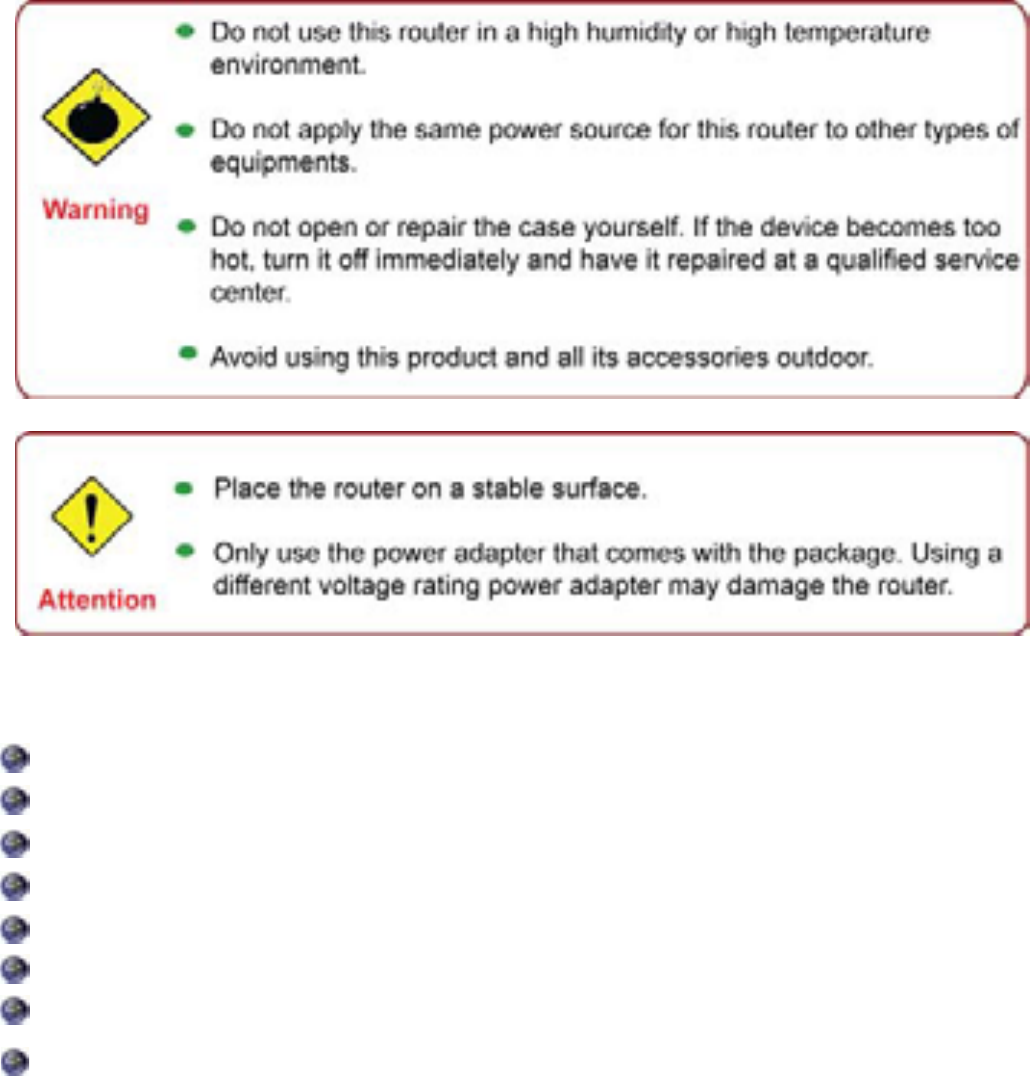
5
Chapter 2: Installing the Router
Important note for using this router
Package Contents
3G/VoIP/(802.11g) ADSL2+ (VPN) Firewall Router
CD-ROM containing the online manual
RJ-11 ADSL/telephone Cable
Ethernet (CAT-5) Cable
Console kit
Power adapter
A detachable antenna
Quick Start Guide

6
The Front LEDs.
LED Meaning
1 Power Lit when power is ON. Lit red means system failure. Restart the device
or contact Billion for support.
2
Ethernet Port
1X — 4X
(RJ-45 connector)
Lit when one of LAN ports is connected to an Ethernet device.
Lit green when the speed of transmission hits 100Mbps; Lit orange
when the speed of transmission hits 10Mbps.
Blink when data is being Transmitted / Received.
3 USB Lit when the router is connected to a USB device.
Flash when data is received / transmitted.
4 Wireless
Lit green when a wireless connection is established.
Flash when the device is sending/receiving data.
Flash once per second while Wi-Fi protected setup is in progress.
5Phone 1x-2x
(RJ-11 connector) Lit green when phone is off hook.
6
Line
(Router with LINE
port only)
Lit when the inbound and outbound calls are transmitted through
PSTN.
7VoIP 1x-2x
(RJ-11 connector)
After SIP registration is OK, the LED will lit green whenever phone 1
is off hook but will lit orange for phone 2.
Note: Orange light also means when both Phone 1 and 2 are
registered OK at the same time.
8 DSL Lit Green when the device is successfully connected to an ADSL
DSLAM. (“line sync”).
9 Internet Lit red when WAN port fails to get IP address.
Lit green when WAN port gets IP address successfully.
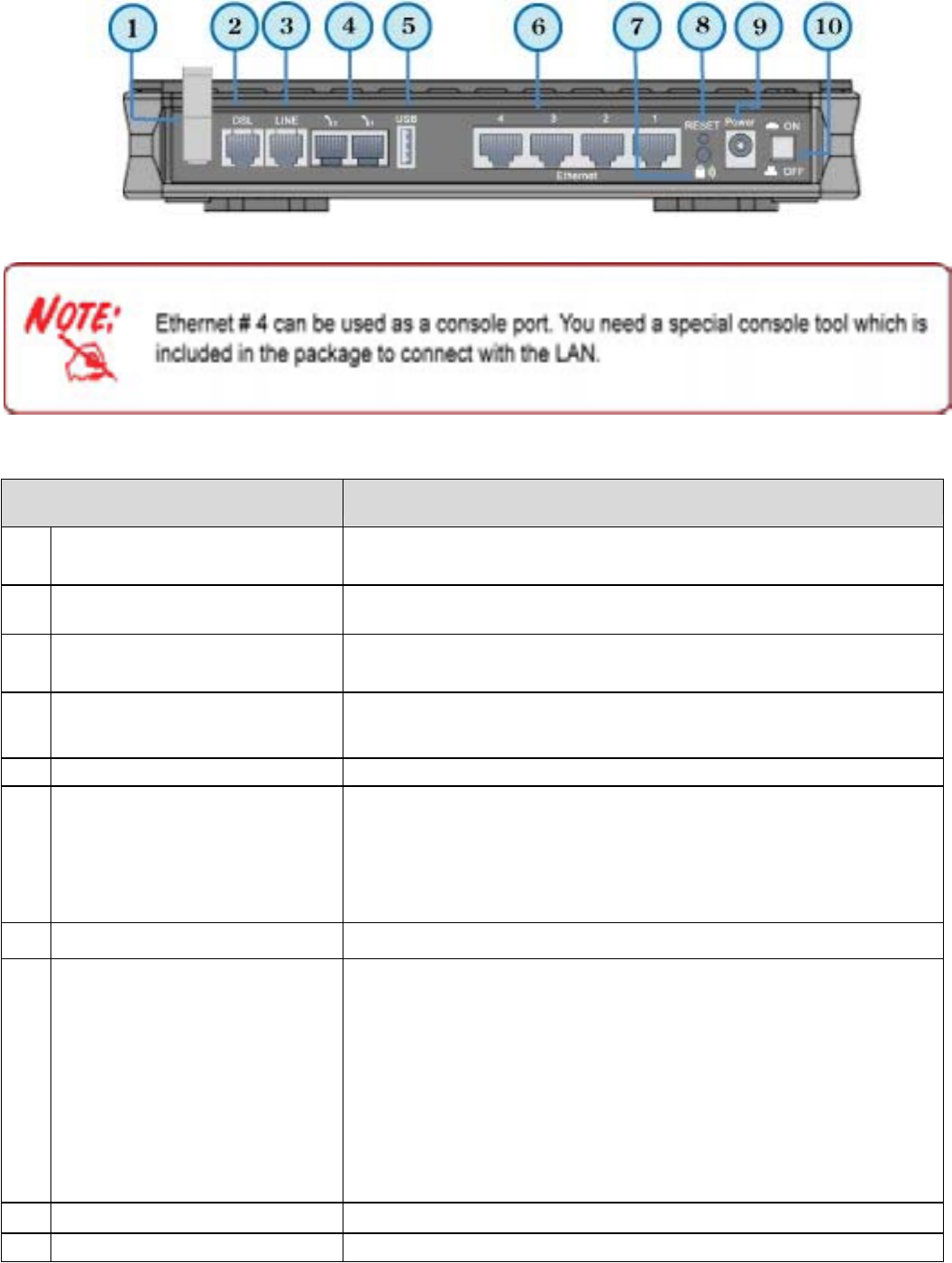
7
The Rear Ports
Port Meaning
1Antenna
(Wireless Router only) Connect the detachable antenna to this port.
2 DSL Connect this port to the ADSL/telephone network with the RJ-
11 cable (telephone) provided.
3Line
(Router with LINE port only)
Connect this port to the telephone jack on the wall with RJ-11
cable.
4Phone
1X-2X (RJ-11 connector) Connect this port to an analog phone set with RJ-11 cable.
5 USB Connect the USB cable to this port.
6
Ethernet
1X — 4X
(RJ-45 connector)
Connect a UTP Ethernet cable (Cat-5 or Cat-5e) to one of
the LAN ports when connecting to a PC or an office/home
network of 10Mbps or 100Mbps.
Caution: Port 4 can be either a LAN or Console port at a
time but not both.
7 WPS Push WPS button to trigger Wi-Fi Protected Setup function.
8 RESET
To be sure the device is being turned on press RESET button
for:
1-3 seconds: quick reset the device.
6 seconds and above, power off, power on the device: restore
to factory default settings. (Cannot login to the router or forgot
your Username/Password. Press the button for more than 6
seconds).
Caution: After pressing the RESET button for more than
6 seconds, to be sure you power cycle the device again.
9 Power Connect it with the supplied power adapter.
10 Power Switch Power ON/OFF switch
8
Cabling
One of the most common causes of problem is bad cabling or ADSL line(s). Make sure that all
connected devices are turned on. On the front panel of your router is a bank of LEDs. Verify that the
LAN Link and ADSL line LEDs are lit. If they are not, verify if you are using the proper cables.
Make sure that all devices (e.g. telephones, fax machines, analogue modems) connected to the same
telephone line as your router have a line filter connected between them and the wall outlet (unless
you are using a Central Splitter or Central Filter installed by a qualified and licensed electrician),
and that all line filters are correctly installed in a right way. If line filter is not installed and connected
properly, it may cause problem to your ADSL connection or may result in frequent disconnections.

9
Chapter 3: Basic Installation
The router can be configured through your web browser. A web browser is included as a standard
application in the following operating systems: Linux, Mac OS, Windows 98/NT/2000/XP/Me/Vista,
etc. The product provides an easy and user-friendly interface for configuration.
Please check your PC network components. The TCP/IP protocol stack and Ethernet network
adapter must be installed. If not, please refer to your Windows-related or other operating system
manuals.
There are ways to connect the router, either through an external repeater hub or connect directly
to your PCs. However, make sure that your PCs have an Ethernet interface installed properly prior
to connecting the router device. You ought to configure your PCs to obtain an IP address through
a DHCP server or a fixed IP address that must be in the same subnet as the router. The default IP
address of the router is 192.168.1.254 and the subnet mask is 255.255.255.0 (i.e. any attached PC
must be in the same subnet, and have an IP address in the range of 192.168.1.1 to 192.168.1.253).
The best and easiest way is to configure the PC to get an IP address automatically from the router
using DHCP. If you encounter any problem accessing the router web interface it is advisable to
uninstall your firewall program on your PCs, as they can cause problems accessing the IP address
of the router. Users should make their own decisions on what is best to protect their network.
Please follow the following steps to configure your PC network environment.
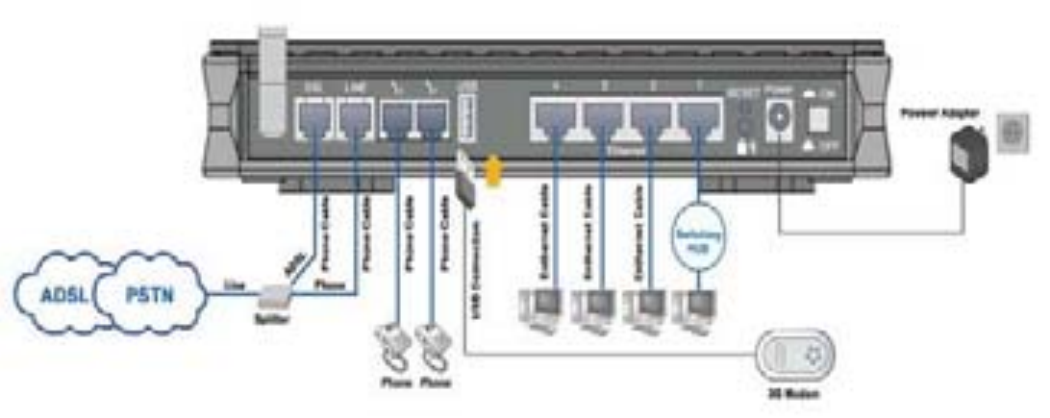
10
Connecting Your Router
1. Connect this router to a LAN (Local Area Network) and the ADSL/telephone (ADSL) net
work.
2. Power on the device.
3. Make sure the Power LED lit steadily and that the LAN LED is lit.
4. Connect your router to the telephone jack on the wall with RJ-11 cable.
5. Connect the USB 2.0 cable.
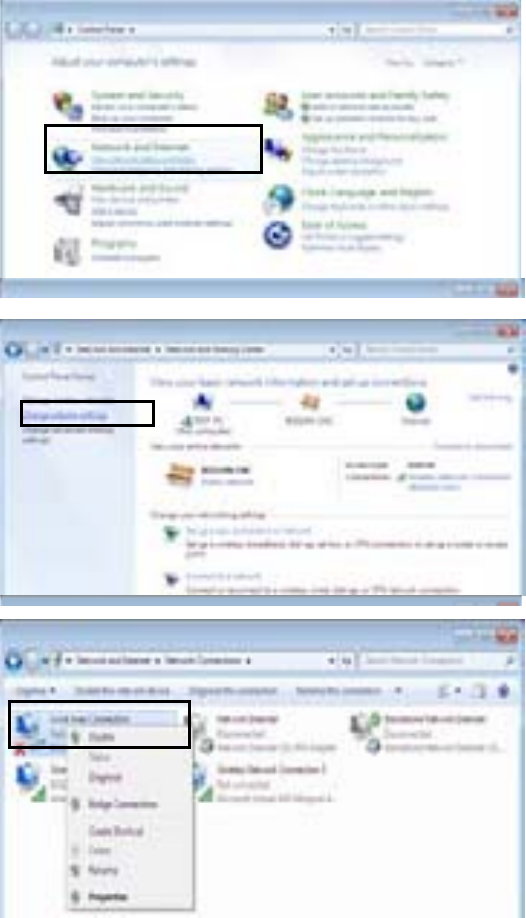
11
Network Configuration
Configuring PC in windows 7
Then click on Network and Internet.
2. When the Network and Sharing Center
window pops up, select and click on
Change adapter settings on the left
window panel.
3. Select the Local Area Connection,
and right click the icon to select Properties.
1. Go to Start. Click on Control Panel.
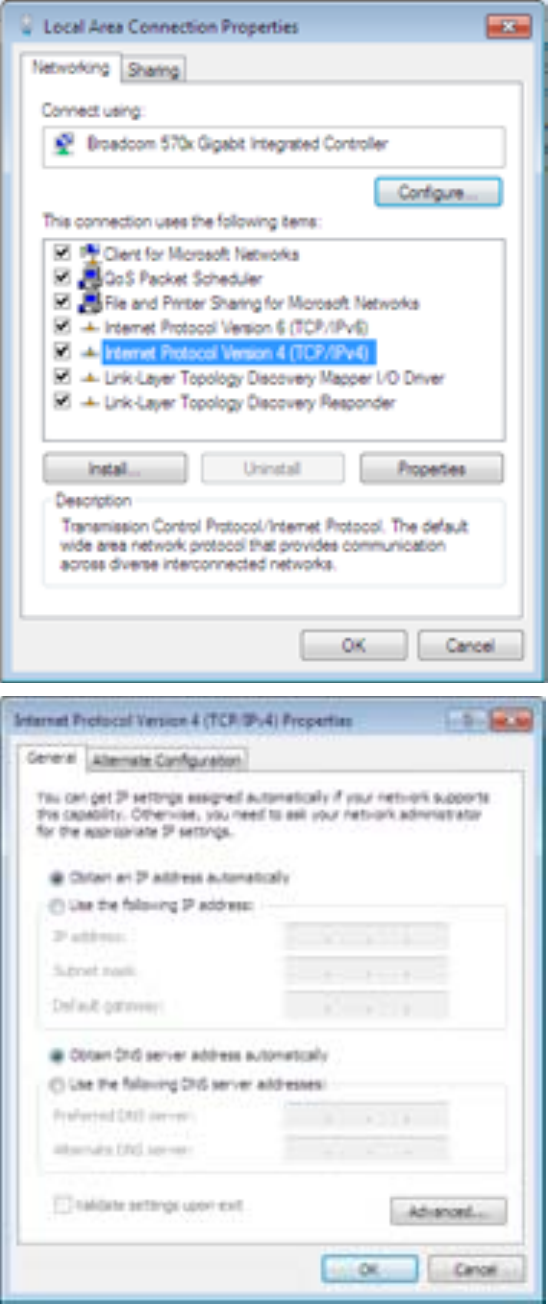
12
4. Select Internet Protocol Version 4
(TCP/IPv4) then click Properties.
5. In the TCP/IPv4 properties window,
select the Obtain an IP address automatically
and Obtain DNS Server address automatically
radio buttons. Then click OK to exit the setting.
6. Click OK again in the
Local Area Connection Properties window
to apply the new configuration.
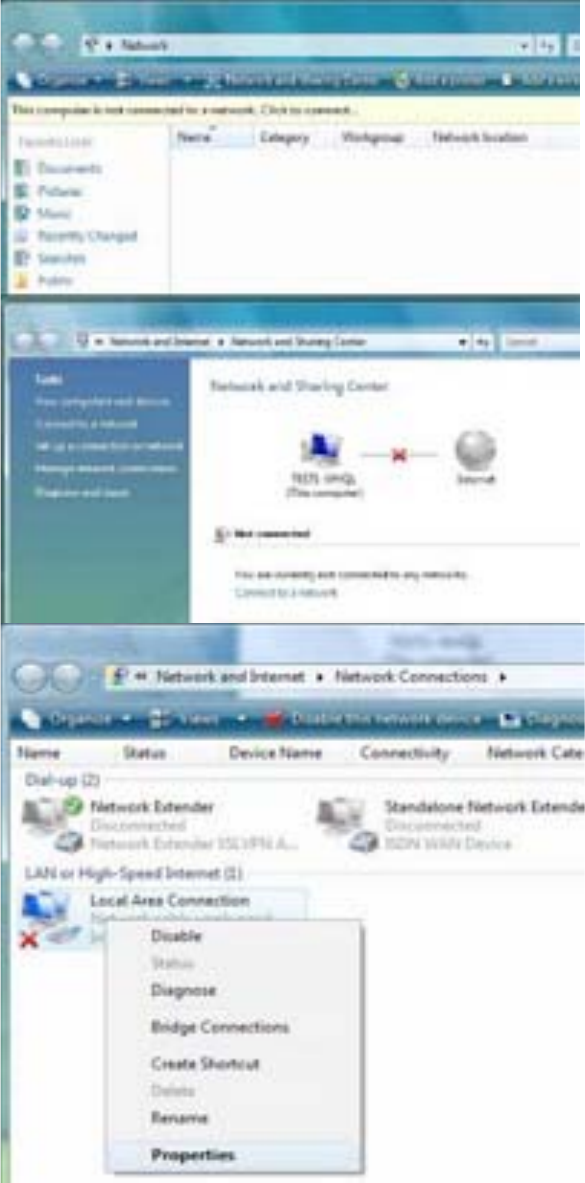
13
Configuring PC in Windows Vista
1. Go to Start. Click on Network.
2. Then click on Network and Sharing
Center at the top bar.
3. When the Network and Sharing
Center window pops up, select and
click on Manage network connec-
tions on the left window column.
4. Select the Local Area Connection,
and right click the icon to select
Properties.
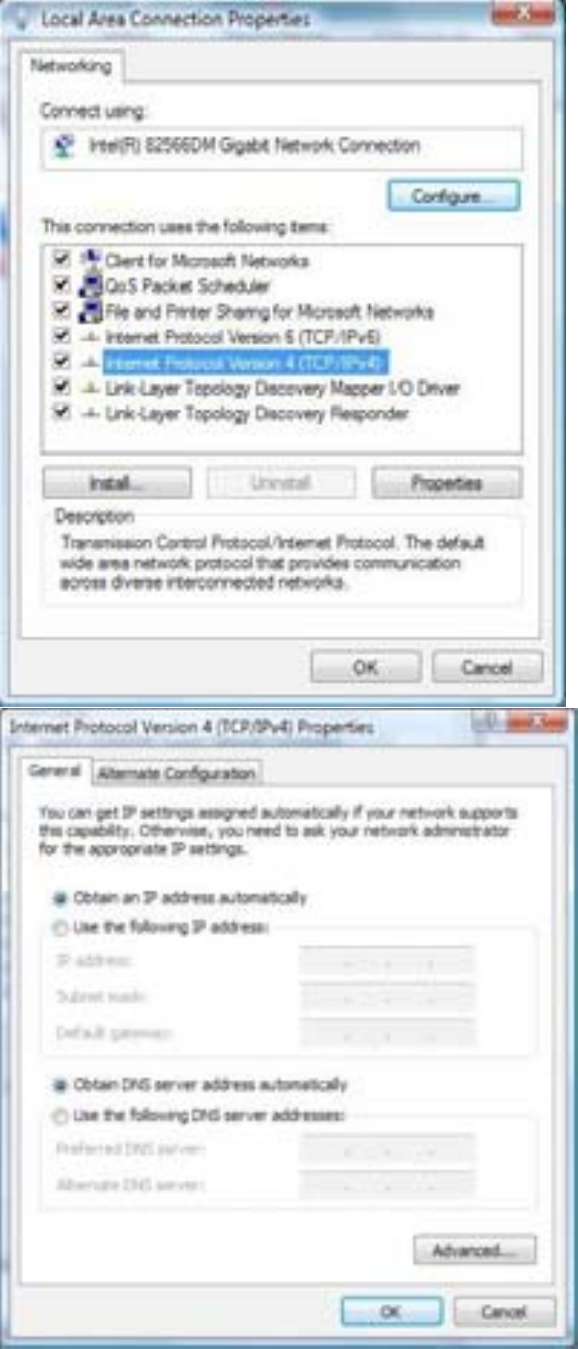
14
5. Select Internet Protocol Version 4
(TCP/IPv4) then click Properties.
6. In the TCP/IPv4 properties window,
select the Obtain an IP address au-
tomatically and Obtain DNS Server
address automatically radio but-
tons. Then click OK to exit the set-
ting.
7. Click OK again in the Local Area
Connection Properties window to
apply the new configuration.
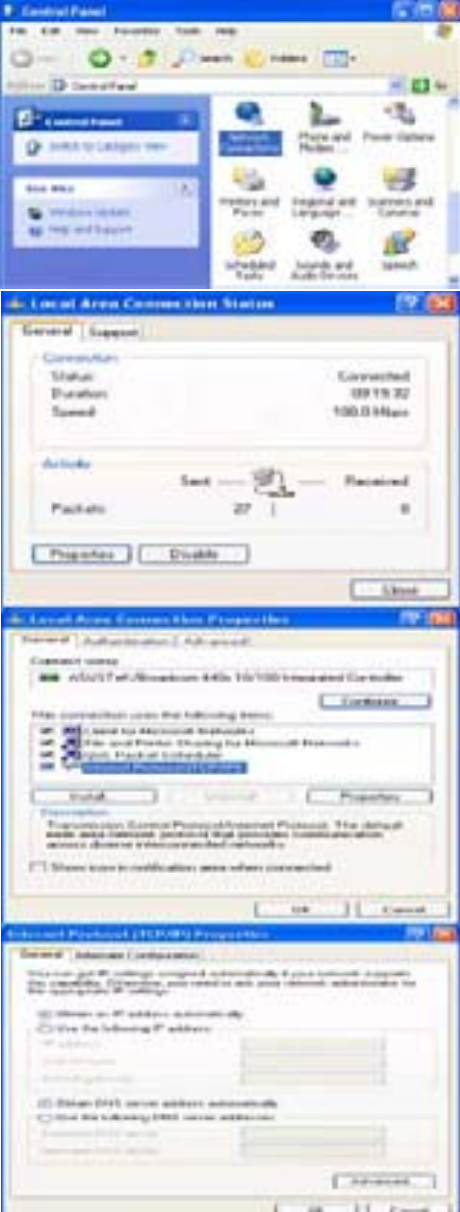
15
Configuring PC in Windows XP
1. Go to Start > Control Panel (in Classic
View). In the Control Panel, double-click
on Network Connections
2. Double-click Local Area Connection.
3. In the Local Area Connection Status
window, click Properties.
4. Select Internet Protocol (TCP/IP) and
click Properties.
5. Select the Obtain an IP address auto-
matically and the Obtain DNS server
address automatically radio buttons.
6. Click OK to finish the configuration.
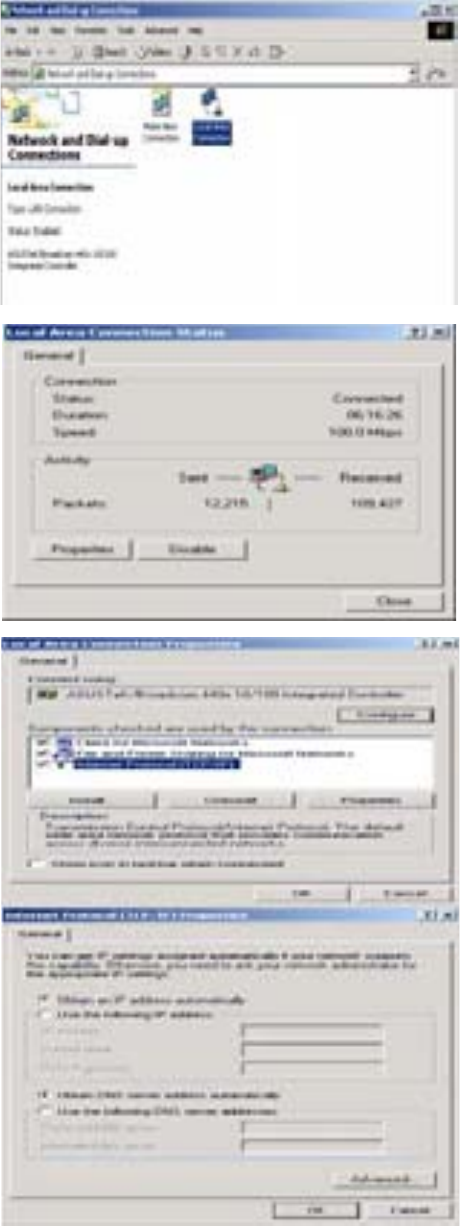
16
Configuring PC in Windows 2000
1. Go to Start > Settings > Control Panel.
In the Control Panel, double-click on
Network and Dial-up Connections.
2. Double-click Local Area Connection.
3. In the Local Area Connection Status
window click Properties.
4. Select Internet Protocol (TCP/IP) and
click Properties.
5. Select the Obtain an IP address auto-
matically and the Obtain DNS server
address automatically radio buttons.
6. Click OK to finish the configuration.
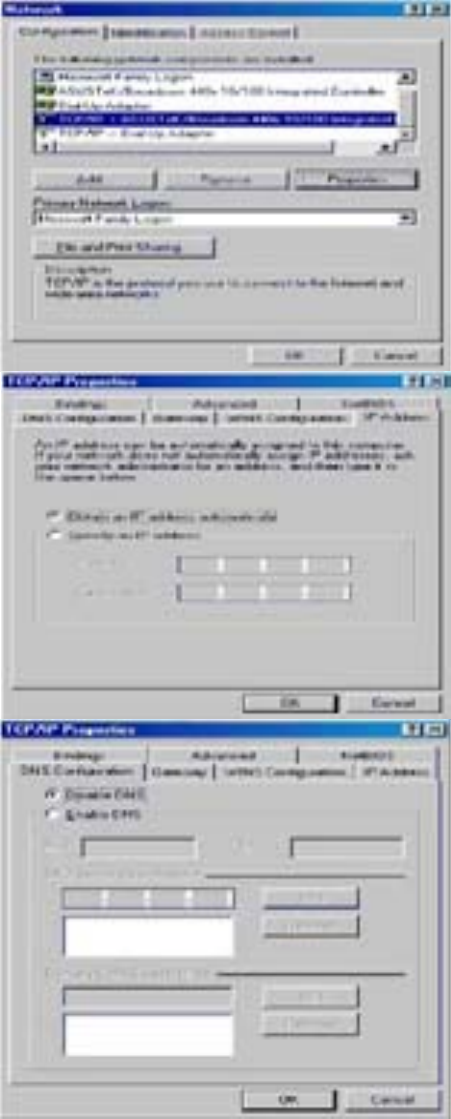
17
Configuring PC in Windows 95/98/Me
1. Go to Start > Settings > Control Panel.
In the Control Panel, double-click on
Network and choose the Configuration
tab.
2. Select TCP/IP > NE2000 Compatible,
or the name of your Network Interface
Card (NIC) in your PC.
3. Select the Obtain an IP address auto-
matically radio button.
4. Then select the DNS Configurationtab.
5. Select the Disable DNS radio button
and click OK to finish the configuration.
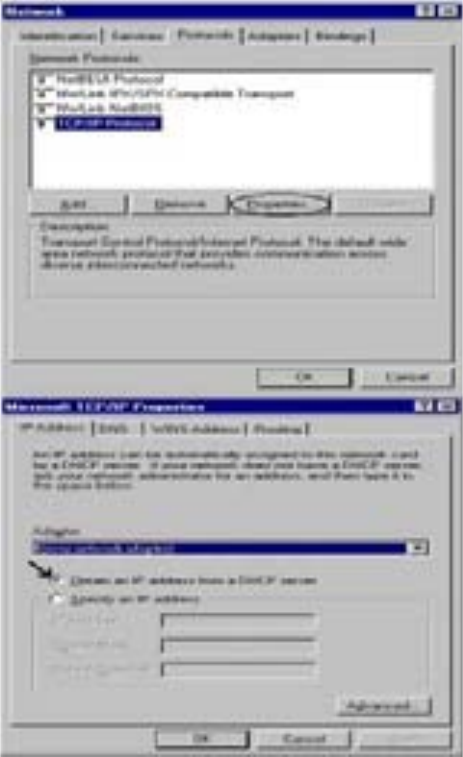
18
Configuring PC in Windows NT4.0
1. Go to Start > Settings > Control Panel.
In the Control Panel, double-click on
Network and choose the Protocols tab.
2. Select TCP/IP Protocol and click Prop-
erties.
3. Select the Obtain an IP address from
a DHCP server radio button and click
OK.
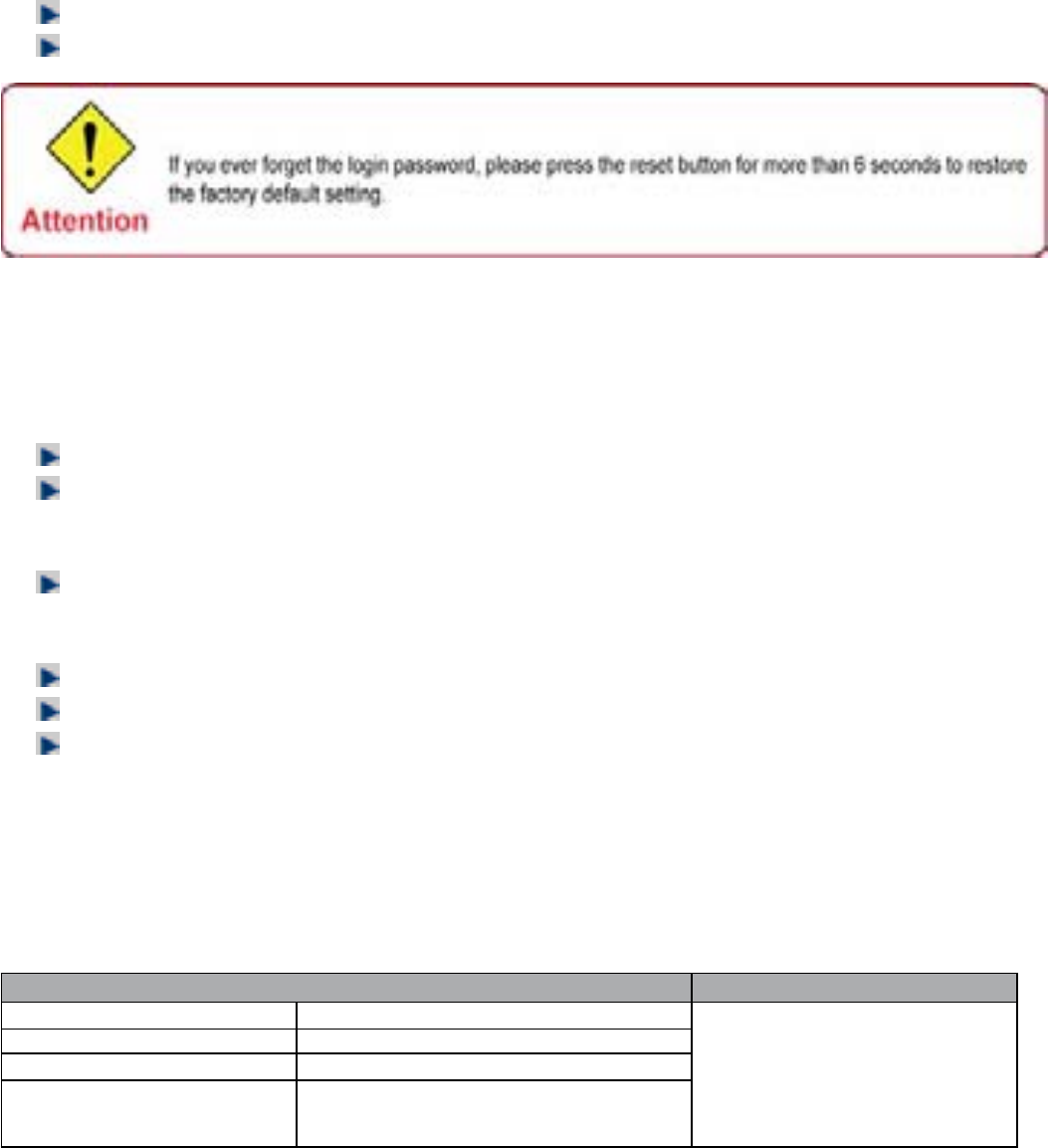
19
Factory Default Settings
Before configuring your router, you need to know the following default settings.
Web Interface (Username and Password)
Username: admin
Password: admin
The default username and password are “admin” and “admin” respectively.
Device LAN IP settings
IP Address: 192.168.1.254
Subnet Mask: 255.255.255.0
ISP setting in WAN site
PPPoE
DHCP server
DHCP server is enabled.
Start IP Address: 192.168.1.100
IP pool counts: 100
LAN and WAN Port Addresses
The parameters of LAN and WAN ports are pre-set in the factory. The default values are shown in
the tale.
LAN Port WAN Port
IP address 192.168.1.254
Subnet Mask 255.255.255.0
DHCP server function Enabled
IP addresses for
distribution to PCs
100 IP addresses continuing
from 192.168.1.100 through
192.168.1.199
The PPPoE function is
enabled to automatically get
the WAN port configuration
from the ISP.

20
Information from your ISP
Before configuring this device, you have to check with your ISP (Internet Service Provider) to find
out what kind of service is provided such as DHCP (Obtain an IP Address Automatically, Static IP
(Fixed IP Address) or PPPoE.
Gather the information as illustrated in the following table and keep it for reference.
PPPoE(RFC2516)
VPI/VCI, VC / LLC-based multiplexing, Username, Password, Service
Name, and Domain Name System (DNS) IP address (it can be
automatically assigned by your ISP when you connect or be set manually).
PPPoA(RFC2364)
VPI/VCI, VC / LLC-based multiplexing, Username, Password and
Domain Name System (DNS) IP address (it can be automatically
assigned by your ISP when you connect or be set manually).
MPoA(RFC1483/
RFC2684)
VPI/VCI, VC / LLC-based multiplexing, IP address, Subnet mask,
Gateway address, and Domain Name System (DNS) IP address (it is a
fixed IP address).
IPoA(RFC1577)
VPI/VCI, VC / LLC-based multiplexing, IP address, Subnet mask,
Gateway address, and Domain Name System (DNS) IP address (it is a
fixed IP address).
Pure Bridge VPI/VCI, VC / LLC-based multiplexing to use Bridged Mode.
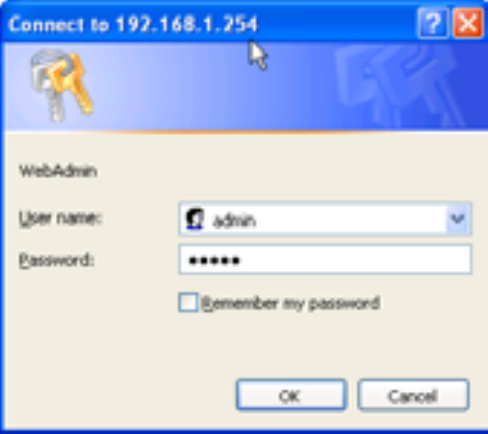
21
Configuring with your Web Browser
Open your web browser, enter the IP address of your router, which by default is 192.168.1.254,
and click “Go”, a user name and password window prompt will appear. The default username and
password are “admin” and “admin” respectively. (See Figure 3.14)
Figure 3.14: User name & Password Prompt Window
Congratulations! You are now successfully logon to the 3G/VoIP/(802.11g) ADSL2+ (VPN)
Firewall Router!

22
Chapter 4: Configuration
At the configuration homepage, the left navigation column provides you the link to each configuration
page. The category of each configuration page is listed as below.
Status
ADSL Table
3G Status
EWAN Status
iBurst Status
ARP Table
DHCP Table
Routing Table
NAT Sessions
UPnP Pormap
PPTP Status
IPSec Status
L2TP Status
VoIP Status
VoIP Call Log
Event Log
Error Log
Diagnostic
Quick Start
LAN
WAN
Configuration
System
Firewall
VPN
VoIP
QoS
Virtual Server
Wake on LAN
Time Schedule
Advanced
Language (provides user interface in English and French languages)
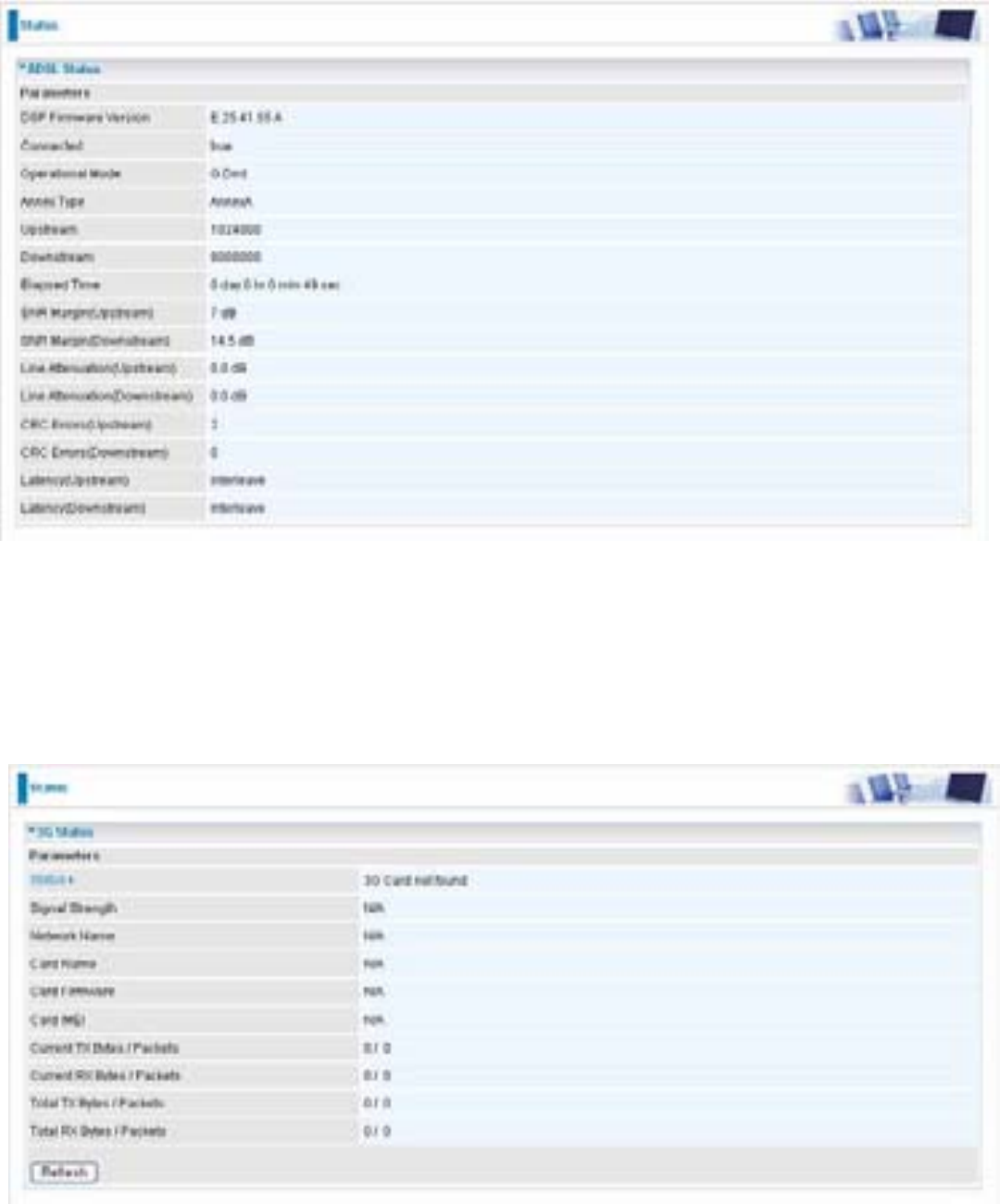
23
Status
ADSL Status
This section displays the ADSL overall status, which shows a number of helpful information such
as DSP firmware version.
3G Status
This section displays the 3G Card’s overall status, which shows you a number of helpful
information such as the current signal strength and statistics on current and total bytes transferred
and received.
Status: The current status of the 3G card.

24
Signal Strength: The signal strength bar indicates current 3G signal strength.
Network Name: The network name that the device is connected to.
Card Name: The name of the 3G card.
Card Firmware: The current firmware for the 3G card.
Card IMEI: the IMEI( International Mobile Equipment Identity) of the 3G card.
Current TX Bytes / Packets: The statistics of transmission, count for this call.
Current RX Bytes / Packets: The statistics of receive, count for this call.
Total TX Bytes / Packets: The statistics of transmission, count from system ready
Total RX Bytes / Packets: The statistics of receive, count from system ready
EWAN Status
Besides using 3G/ADSL to get connected to the Internet, the router offers its Ethernet port 1 as a
WAN port to be used to connect to Cable Modems and fiber optic lines. This alternative, yet faster
method to connect to the internet will provide users more flexibility to get online.
Total TX Bytes / Packets: The statistics of total data transmission in bytes / packets since
system ready.
Total RX Bytes / Packets: The statistics of total data received in bytes / packets since system
ready.
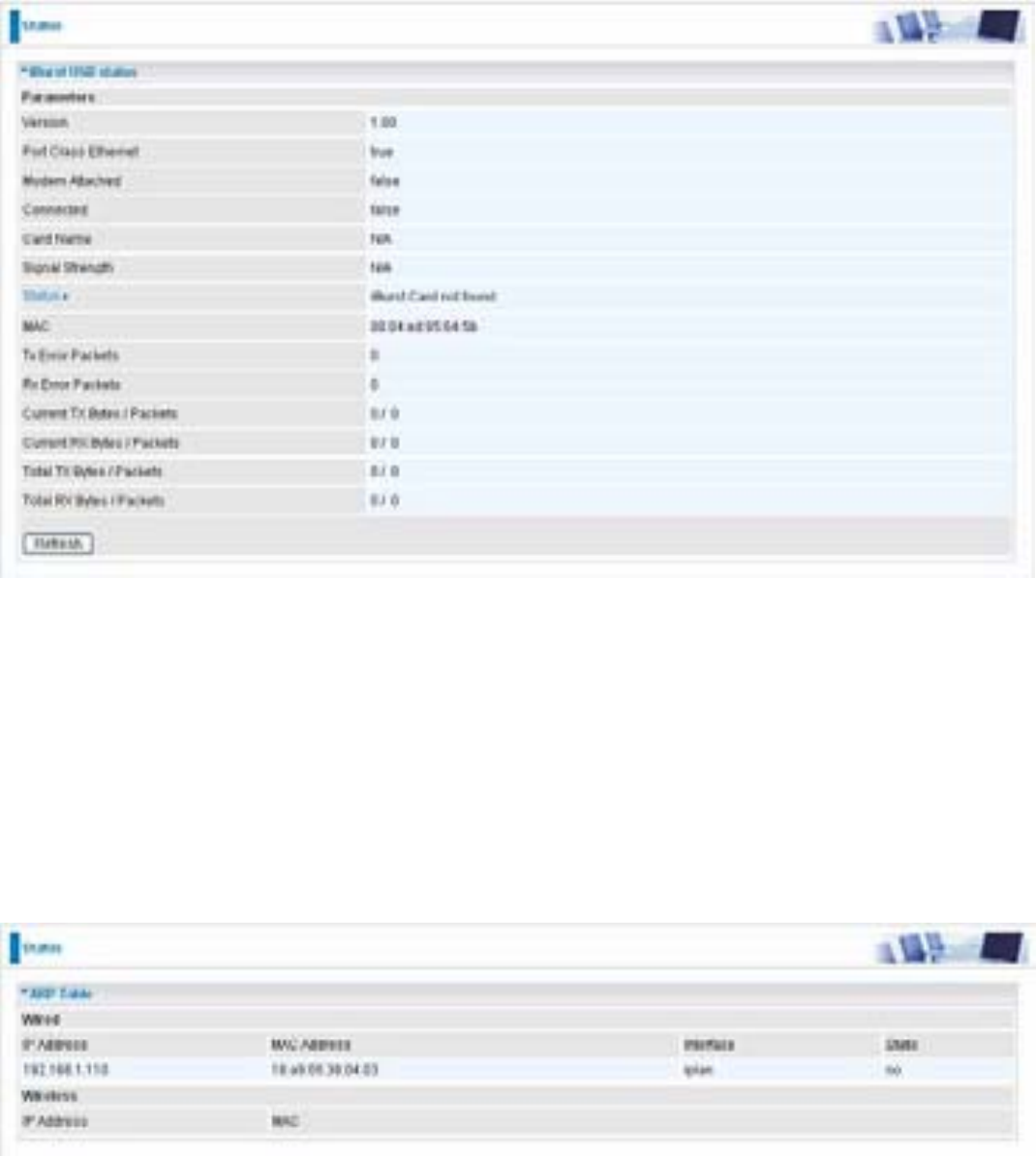
25
iBurst Status
Displays additional information of the 3G status when iBurst function is enabled in the 3G
configuration such as its signal strength, card name, connection status and port class Ethernet.
ARP Table
This section displays the router’s ARP (Address Resolution Protocol) Table, which shows the
mapping of Internet (IP) addresses to Ethernet (MAC) addresses. This is useful as a quick way of
determining the MAC address of the network interface of your PCs to use with the router’s Firewall
– MAC Address Filter function. See the Firewall section of this manual for more information on this
feature.
IP Address: A list of IP addresses of devices on your LAN (Local Area Network).
MAC Address: The MAC (Media Access Control) addresses for each device on your LAN.
Interface: The interface name (on the router) that this IP Address connects to.

26
Static: Static status of the ARP table entry:
“no” for dynamically-generated ARP table entries.
“yes” for static ARP table entries added by the user.
DHCP Table
Leased: The DHCP assigned IP addresses information.
Expired: The expired IP addresses information.
Permanent: The fixed host mapping information.

27
Leased Table
IP Address: The IP address that assigned to client.
MAC Address: The MAC address of client.
Client Host Name: The Host Name (Computer Name) of client.
Expiry: The current lease time of client.
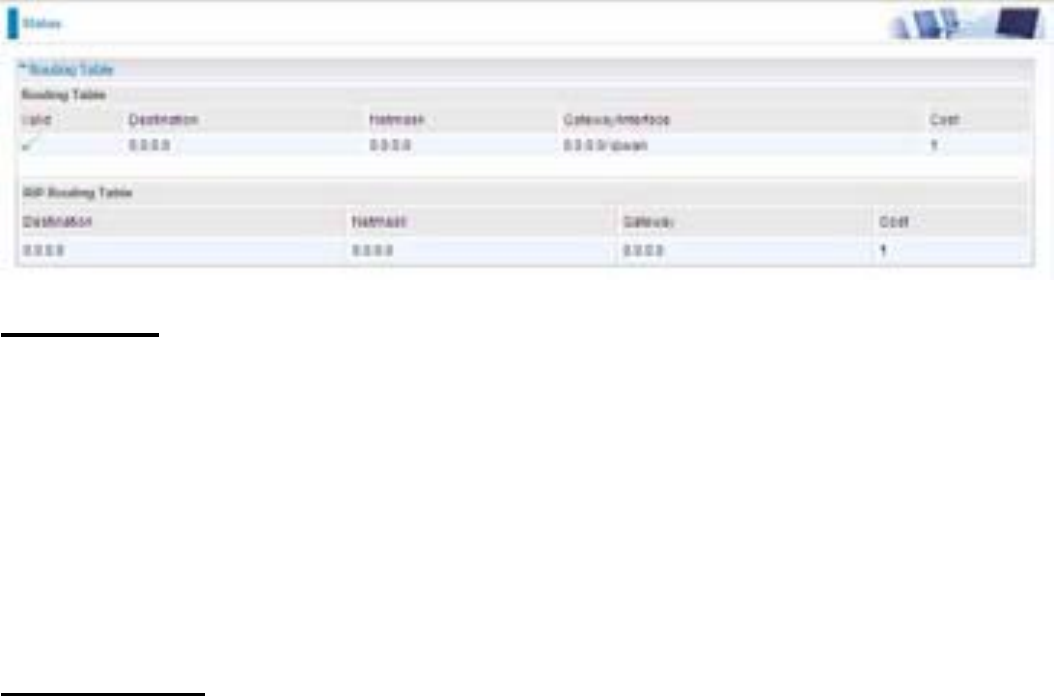
28
Routing Table
Routing Table
Valid: It indicates a successful routing status.
Destination: The IP address of the destination network.
Netmask: The destination Netmask address.
Gateway/Interface: The IP address of the gateway or existing interface that this route will use.
Cost: The number of hops counted as the cost of the route.
RIP Routing Table
Destination: The IP address of the destination network.
Netmask: The destination Netmask address.
Gateway: The IP address of the gateway that this route will use.
Cost: The number of hops counted as the cost of the route.
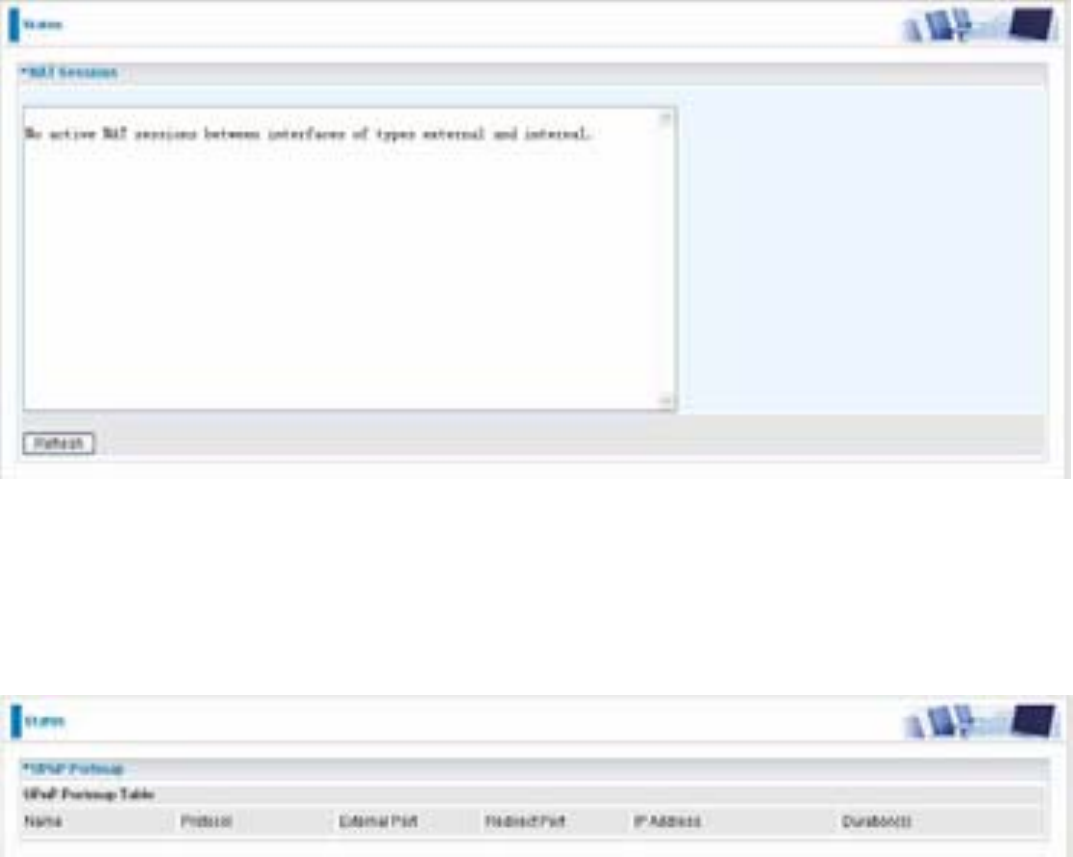
29
NAT Sessions
This section lists all current NAT sessions between interface of types external (WAN) and internal
(LAN).
UPnP Portmap
The section lists all port-mapping established using UPnP (Universal Plug and Play. See Advanced
section of this manual for more details on UPnP and the router’s UPnP configuration options.

30
PPTP Status
This shows details of your configured PPTP VPN Connections.
Name: The name you assigned to the particular PPTP connection in your VPN configuration.
Type: The type of connection (dial-in/dial-out).
Enable: Whether the connection is currently enabled.
Active: Whether the connection is currently active.
Tunnel Connected: Whether the VPN Tunnel is currently connected.
Call Connected: If the Call for this VPN entry is currently connected.
Encryption: The encryption type used for this VPN connection.
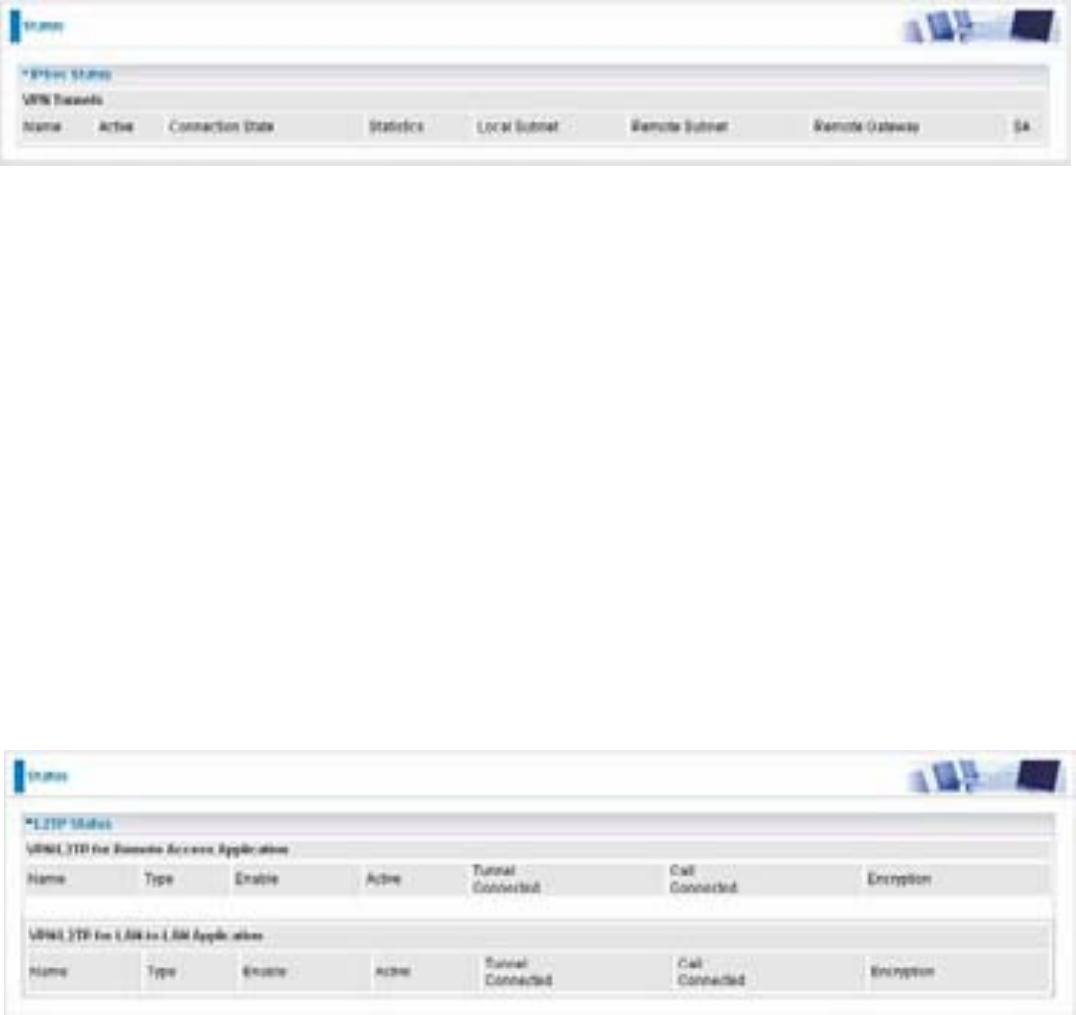
31
IPSec Status
This shows details of your configured IPSec VPN Connections.
Name: The name you assigned to the particular VPN entry.
Active: Whether the VPN Connection is currently Active.
Connection State: Whether the VPN is Connected or Disconnected.
Statistics: Statistics for this VPN Connection.
Local Subnet: The local IP Address or Subnet used.
Remote Subnet: The Subnet of the remote site.
Remote Gateway: The Remote Gateway IP address.
SA: The Security Association for this VPN entry.
L2TP Status
This shows details of your configured L2TP VPN Connections.
Name: The name you assigned to the particular L2TP connection in your VPN configuration.
Type: The type of connection (dial-in/dial-out).
Enable: Whether the connection is currently enabled.
Active: Whether the connection is currently active.
Tunnel Connected: Whether the VPN Tunnel is currently connected.
Call Connected: If the Call for this VPN entry is currently connected.
Encryption: The encryption type used for this VPN connection.
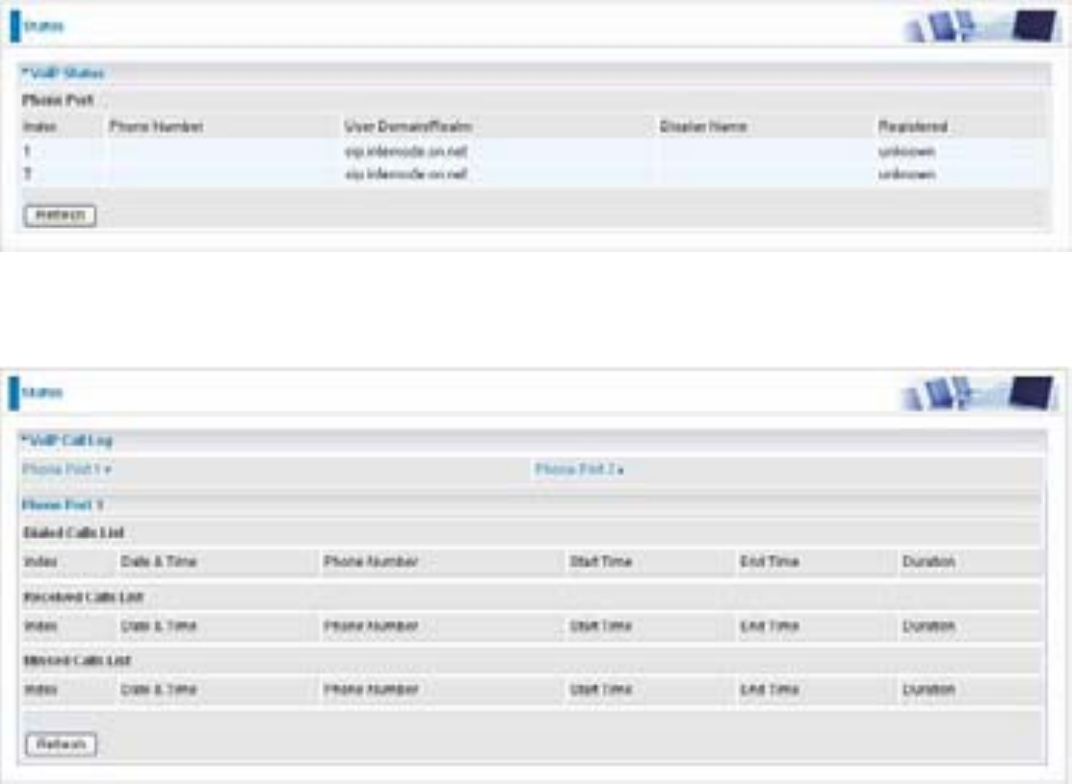
32
VoIP Status
This table shows the status of the phone ports after they are being used for the VoIP feature. It
will display some information such as domain name, display name & phone number of the VoIP
device.
VoIP Call Log
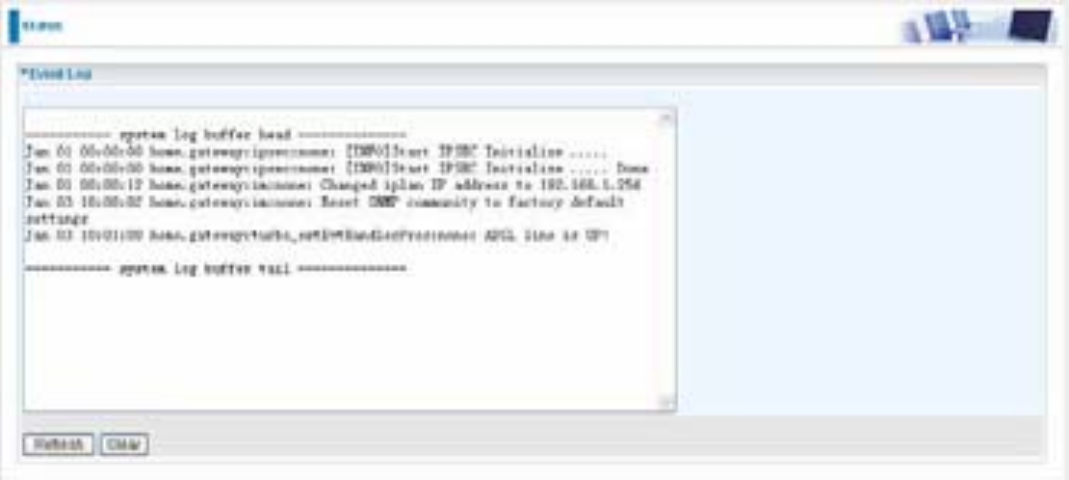
33
Event Log
This page displays the router’s Event Log entries. Major events are logged to this window, such
as when the router’s ADSL connection is disconnected, as well as Firewall events when you have
enabled Intrusion or Blocking Logging in the Configuration – Firewall section of the interface.
Please see the Firewall section of this manual for more details on how to enable Firewall logging.
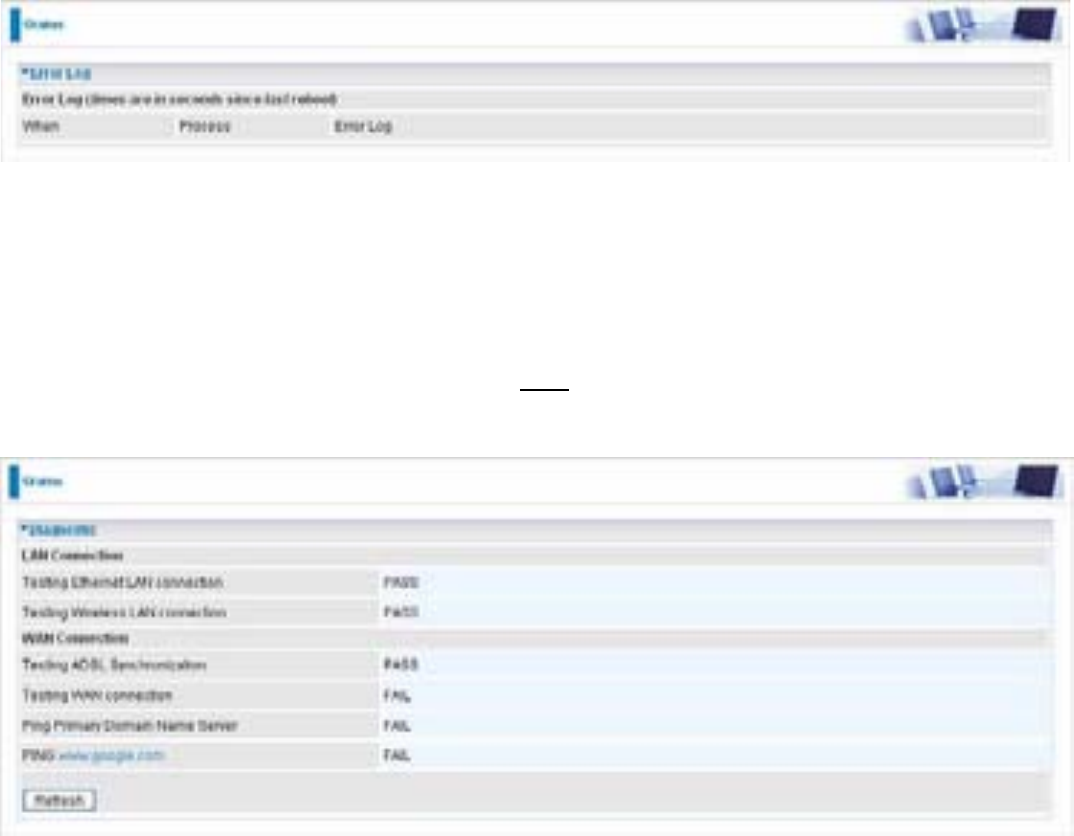
34
Error Log
Any errors encountered by the router (e.g. invalid names given to entries) are logged to this
window.
Diagnostic
It tests the connection to computer(s) which is connected to the LAN ports and also the WAN Internet
connection. If PING www.google.com is shown FAIL and the rest is PASS, you ought to check your
PC’s DNS setting is correct.
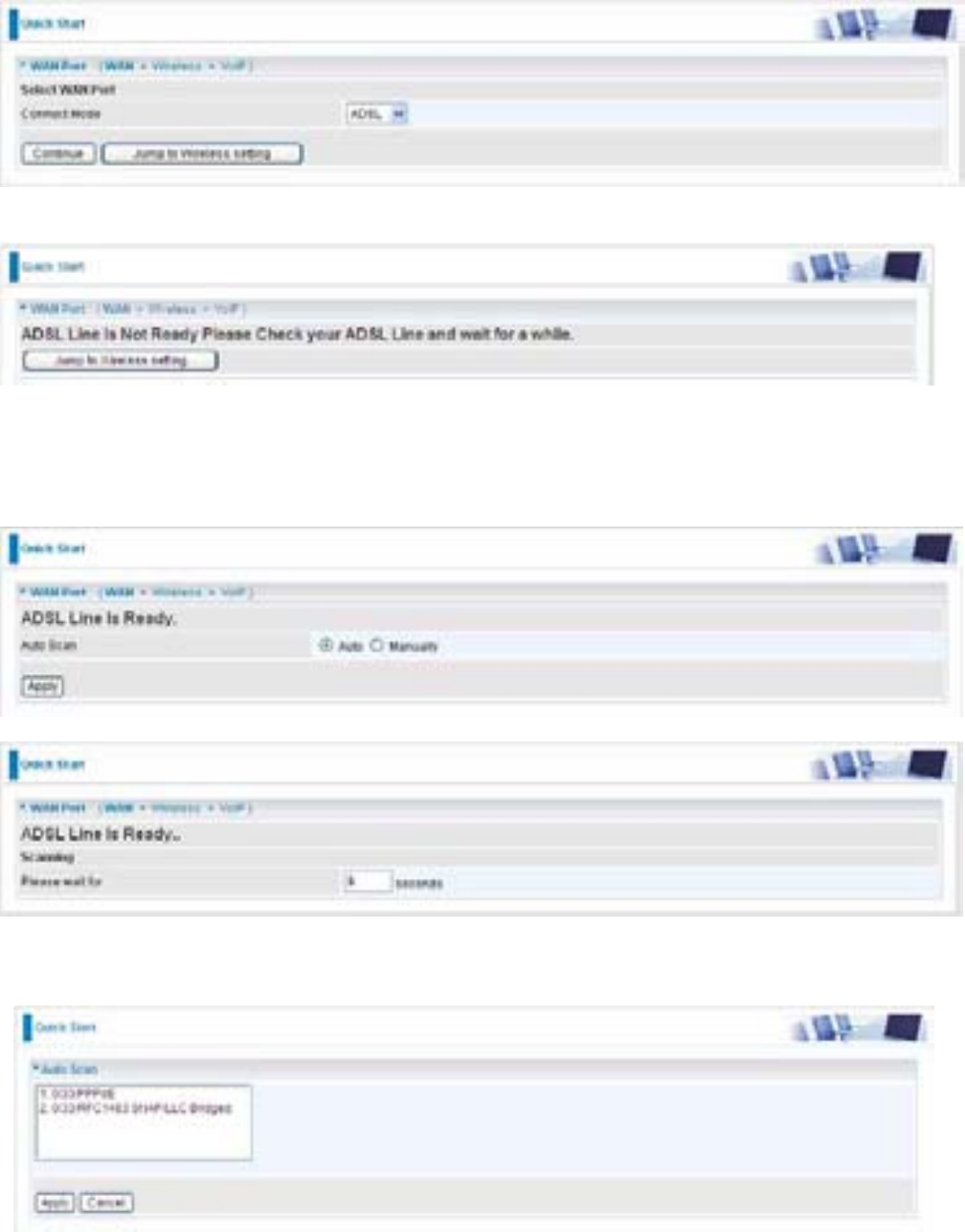
35
Quick Start
1. Click Quick Start. Select the connect mode you want. There are 2 options to choose from: ADSL
or 3G. Select ADSL mode from the drop down menu and click Continue.
2. If your ADSL line is not ready, you need to check your ADSL line has been set or not.
3. If your ADSL line is ready, the screen appears ADSL Line is Ready. Choose Auto radio button
and click Apply. It will automatically scan the recommended mode for you. Manually mode
makes you to set the ADSL line by manual. (If you choose Manually, you will directly go to step
5.)
4. The list below has different mode applied for your choice. Choose 0/33/PPPoE(Recommended)
and click Apply.
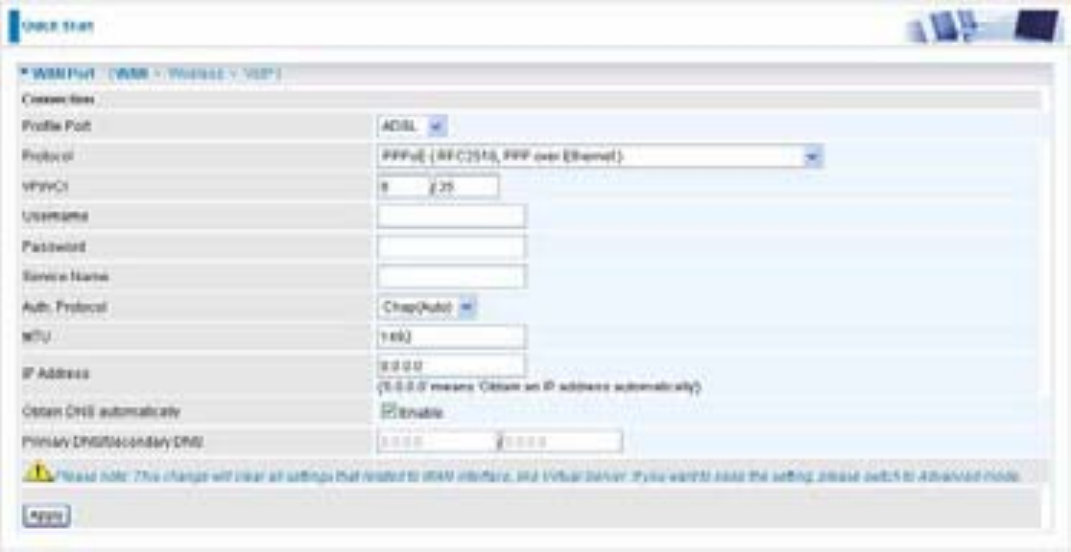
36
5. Please enter “Username” and “Password” as supplied by your ISP(Internet Service Provider)
and click Apply to continue.
Profile Port: Select the connection mode. There is ADSL.
Protocol: Select the protocol mode. The default mode is PPPoE.
VPI/VCI: Enter the VPI and VCI information provided by your ISP.
Username: Enter the username provided by your ISP.
Password: Enter the password provided by your ISP.
Service Name: This item is for identification purposes. If it is required, your ISP provides you the
information.
Authentication Protocol: Default is Auto. Your ISP advises on using Chap or Pap.
MTU: Maximum Transmission Unit. The size of the largest datagram (excluding media-specific
headers) that IP will attempt to send through the interface.
IP Address: Your WAN IP address. Leave this at 0.0.0.0 to obtain automatically an IP address
from your ISP.
Obtain DNS automatically: Click to activate DNS and to enable the system to automatically
detect DNS.
Primary DNS / Secondary DNS: Enter the IP addresses of the DNS servers. The DNS servers
are passed to the DHCP clients along with the IP address and the netmask.
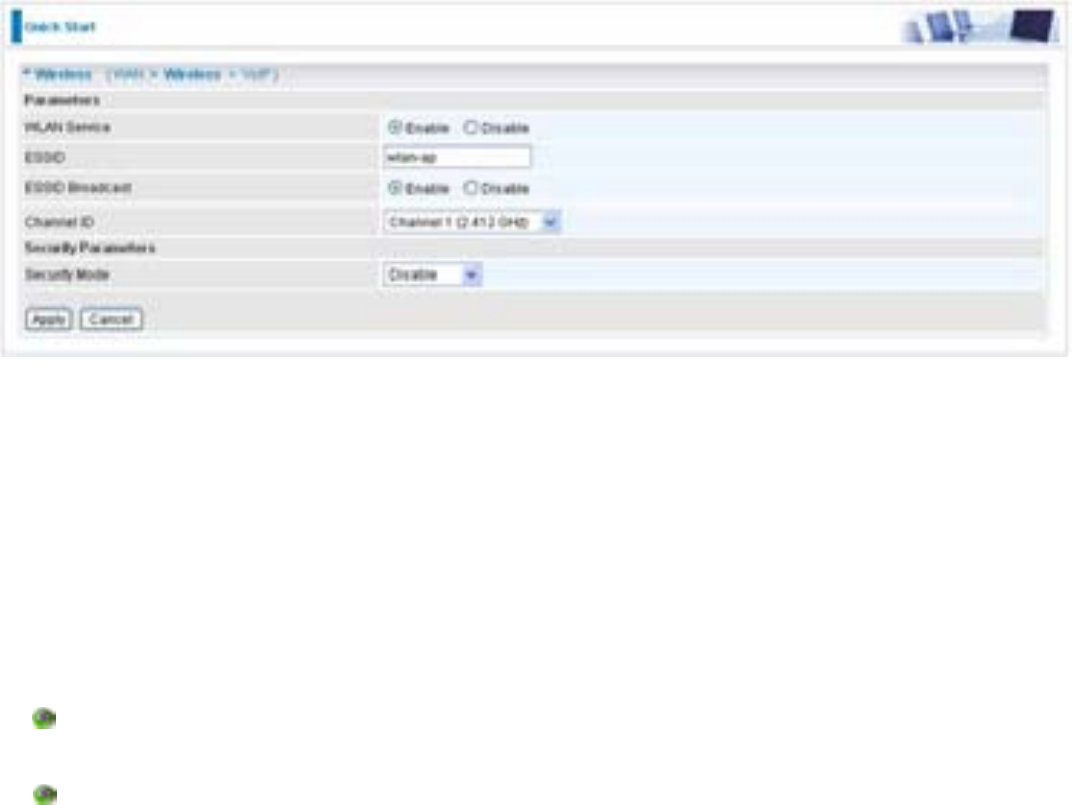
37
6. Configure the Wireless LAN setting.
WLAN Service: Default setting is set to Enable. If you want to use wireless, both 802.11g and
802.11b device in your network, you can select Enable.
ESSID: The ESSID is the unique name of a wireless access point (AP) to be distinguished from
another. For security propose, change to a unique ID name to the AP which is already built-in to
the router’s wireless interface. It is case sensitive and must not excess 32 characters. Make sure
your wireless clients have exactly the ESSID as the device, in order to get connected to your
network.
ESSID Broadcast: It is function in which transmits its ESSID to the air so that when wireless client
searches for a network, router can then be discovered and recognized. Default setting is Enable.
Enable: When Enable is selected, you can allow anybody with a wireless client to be able to
locate the Access Point (AP) of your router.
Disable: Select Disable if you do not want broadcast your ESSID. When select Disable, no
one will be able to locate the Access Point (AP) of your router.
Channel ID: Select the ID channel that you would like to use.
Security Mode: You can disable or enable with WPA or WEP for protecting wireless network. The
default mode of wireless security is Disable.
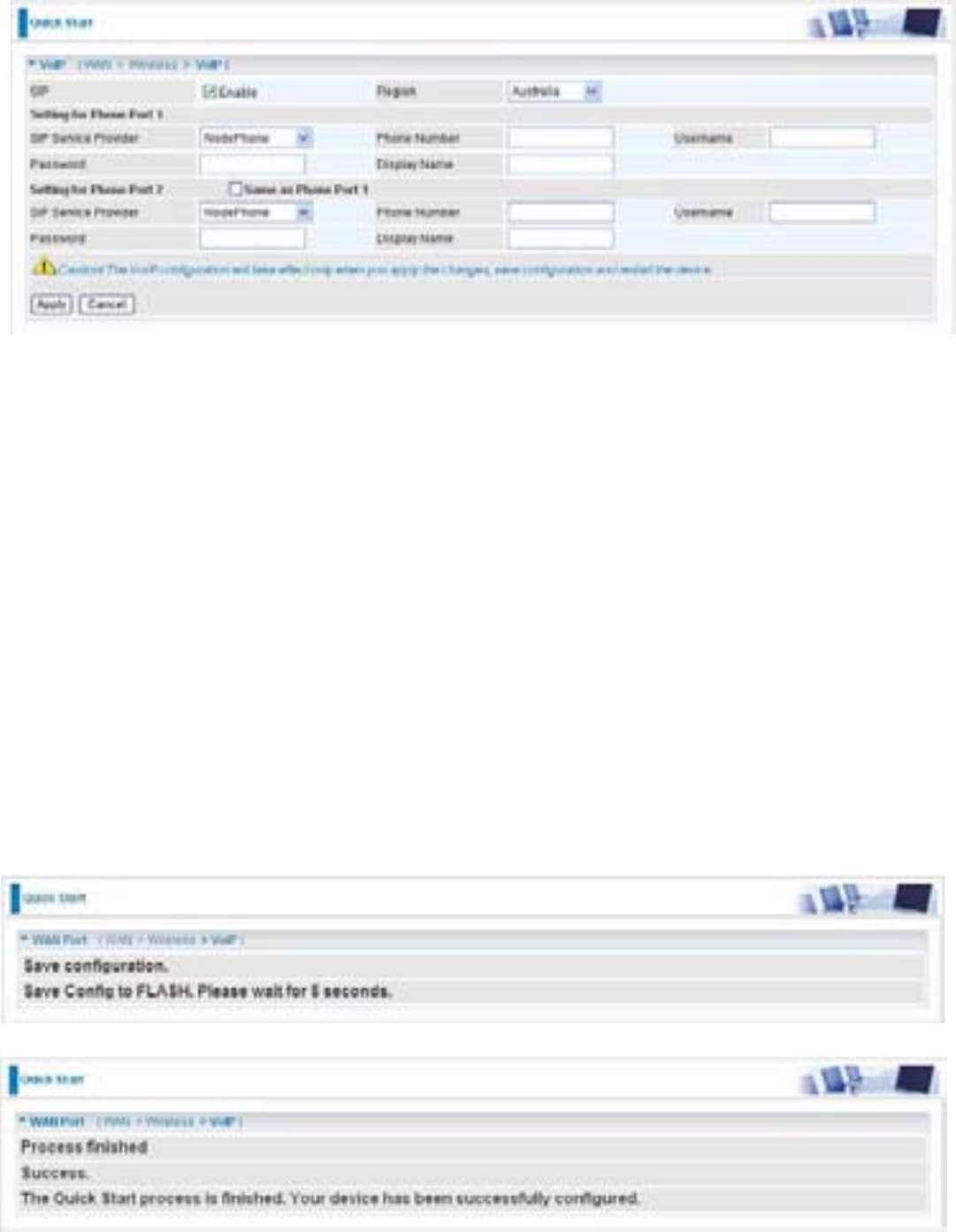
38
7. Set up VoIP.
SIP: To use VoIP SIP as VoIP call signaling protocol. Default is set to Disable.
Region: This selection is a drop-down box, which allows user to select the country for which the
VoIP device must work. When a country is selected, the country parameters are automatically
loaded.
SIP Service Provider: This section allows you to select the service provider. When the selection
is done, respective parameters below are automatically displayed.
Phone Number: This parameter holds the registration ID of the user within the VoIP SIP registrar.
Username: If the username is same as the Phone Number, leave it blank. Otherwise, fill in the
space with your username given by your VoIP provider.
Password: This parameter holds the password used for authentication within VoIP SIP registrar.
Display Name: This parameter will be appeared on the Caller ID.
8. Wait for the configuration.
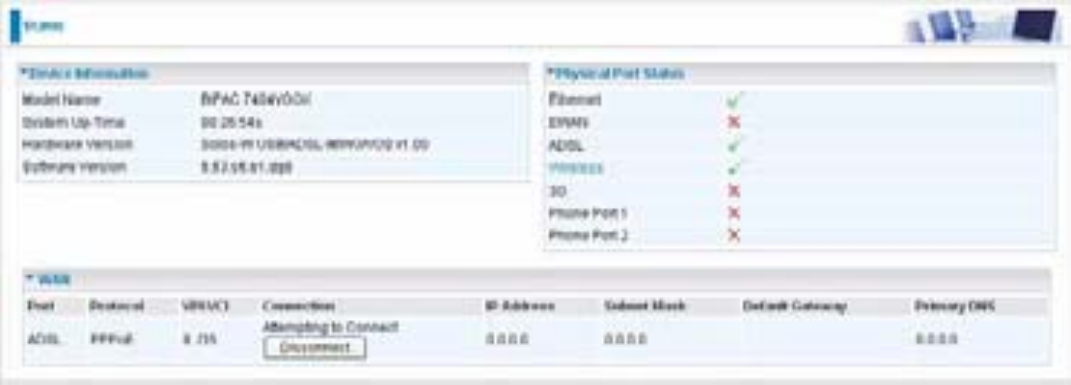
39
9. When ADSL is synchronic, it will appear “check”.
40
Configuration
When you click this item, the column will expand to display the sub-items that will allow you to further
configure your ADSL router.
LAN, WAN, System, Firewall, VPN, VoIP, QoS, Virtual Server, Wake on LAN, Time Schedule
and Advanced
The function of each configuration sub-item is described in the following sections.
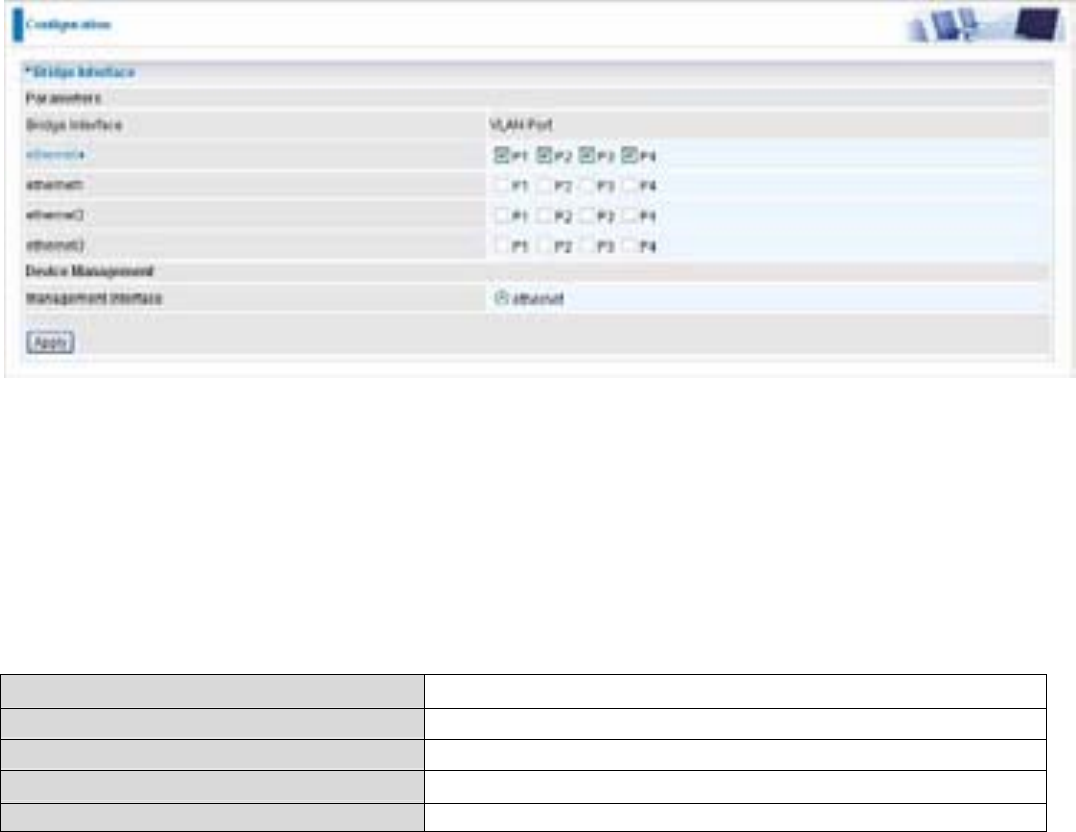
41
LAN - Local Area Network
Here are the items within the LAN section: Bridge Interface, Ethernet, IP Alias, Ethernet Client
Filter, Wireless, Wireless Security, Wireless Client Filter, WPS, Port Setting and DHCP
Server.
Bridge Interface
You can setup member ports for each VLAN group under Bridge Interface section. From the example,
two VLAN groups need to be created.
Ethernet: P1 (Port 1)
Ethernet1: P2, P3 and P4 (Port 2, 3, 4). Uncheck P2, P3, P4 from Ethernet VLAN port first.
Note: You should setup each VLAN group with caution. Each Bridge Interface is arranged in
this order.
Bridge Interface VLAN Port (Always starts with)
ethernet P1 / P2 / P3 / P4
ethernet1 P2 / P3 / P4
ethernet2 P3 / P4
ethernet3 P4
Management Interface: To specify which VLAN group has possibility to do device management,
like doing web management.
Note: NAT/NAPT can be applied to management interface only.
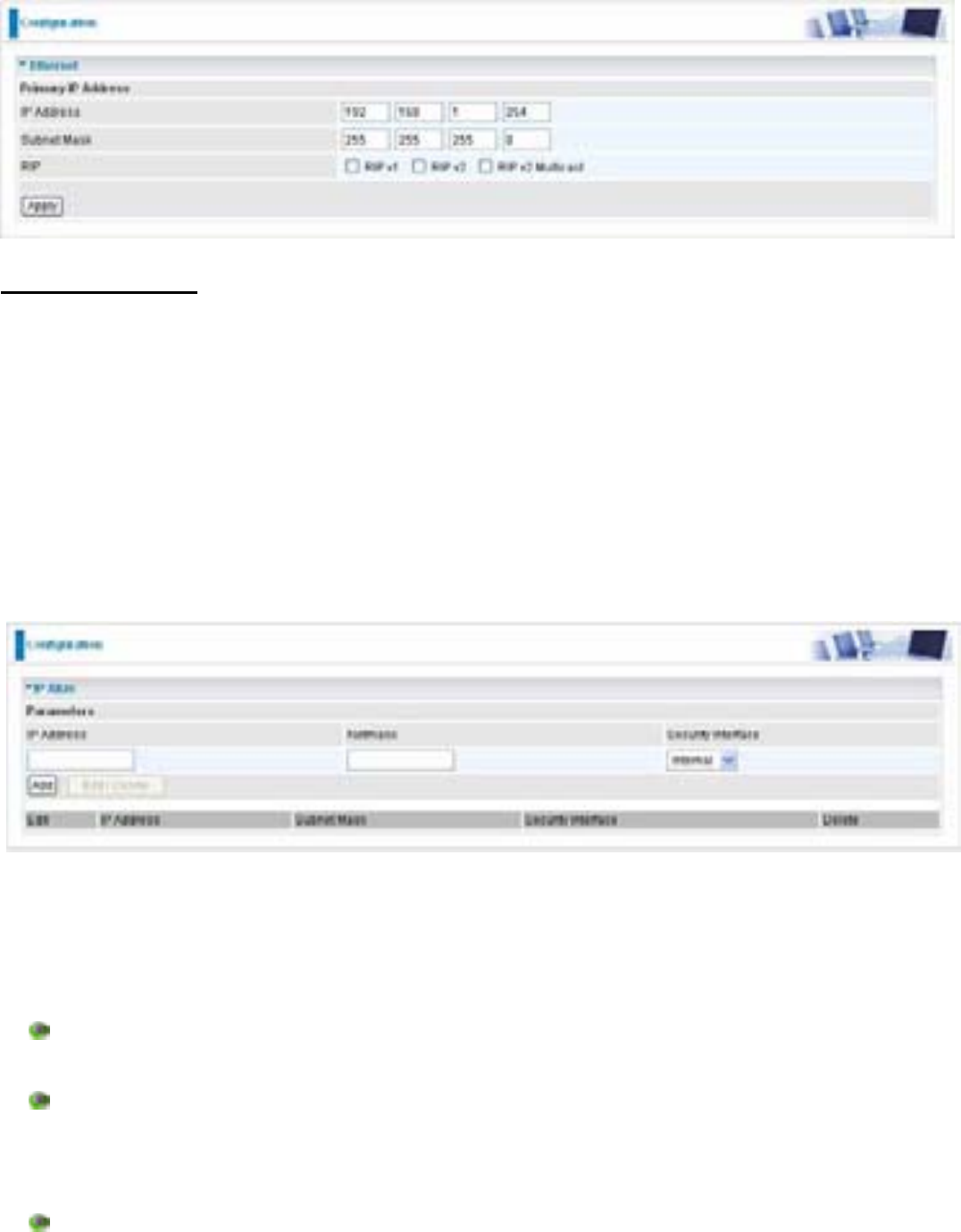
42
Ethernet
Primary IP Address
IP Address: The default IP on this router.
Subnet Mask: The default subnet mask on this router.
RIP: RIP v1, RIP v2, and RIP v2 Multicast. Check to enable RIP function.
IP Alias
This function creates multiple virtual IP interfaces on this router. It helps to connect two or more local
networks to the ISP or remote node. In this case, an internal router is not required.
IP Address: Specify an IP address on this virtual interface.
SubNetmask: Specify a subnet mask on this virtual interface.
Security Interface: Specify the firewall setting on this virtual interface.
Internal: The network is behind NAT. All traffic will do network address translation when
sending out to Internet if NAT is enabled.
External: There is no NAT on this IP interface and connected to the Internet directly. Mostly
it will be used when providing multiple public IP addresses by ISP. In this case, you can use
public IP address in local network which gateway IP address point to the IP address on this
interface.
DMZ: Specify this network to DMZ area. There is no NAT on this interface.
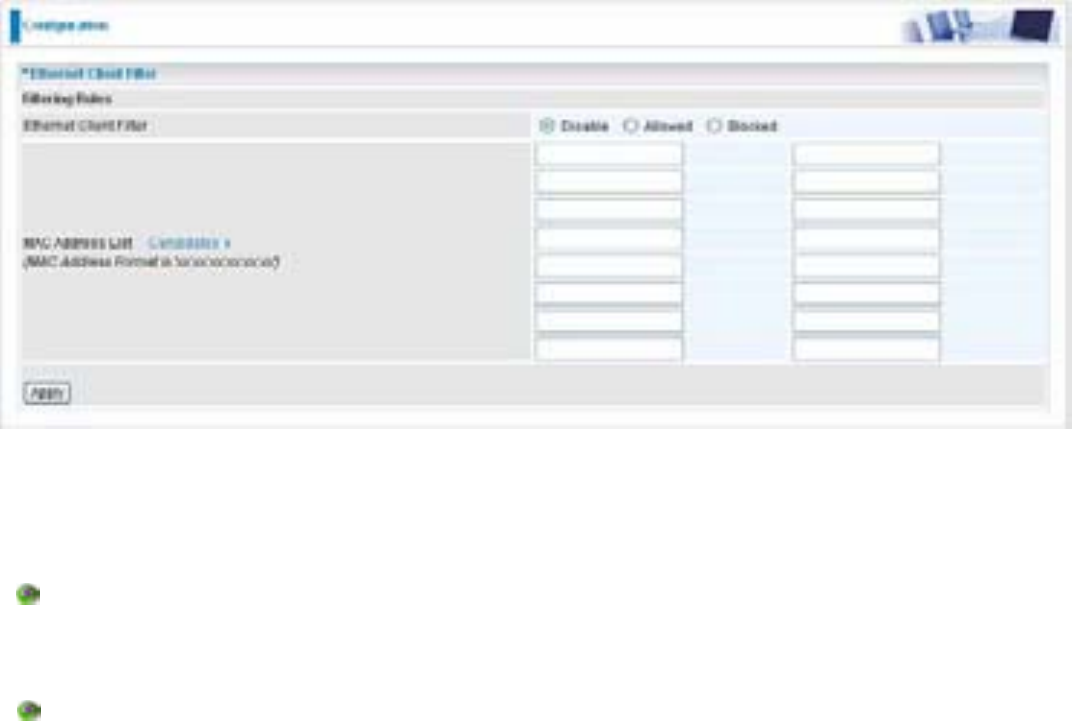
43
Ethernet Client Filter
The Ethernet Client Filter supports up to 16 Ethernet network machines that helps you to
manage your network control to accept traffic from specific authorized machines or can restrict
unwanted machine(s) to access your LAN.
There are no pre-define Ethernet MAC address filter rules; you can add the filter rules to meet
your requirements.
Ethernet Client Filter: Default setting is set
Disable.
Allowed: check to authorize specific device accessing your LAN by insert the MAC
Address in the space provided or click the Candidate button. Make sure your PC’s MAC
is listed.
Blocked: check to prevent unwanted device accessing your LAN by insert the MAC
Address in the space provided or click the Candidate button. Make sure your PC’s MAC is
not listed.
The maximum client is 16. The MAC addresses are 6 bytes long; they are presented only
in
hexadecimal characters. The number 0 - 9 and letters a - f are
acceptable.
Note: Follow the MAC Address Format xx:xx:xx:xx:xx:xx. Semicolon ( : ) must be
included.
Candidates: automatically detects devices connected to the router through the
Ethernet. . Click the Candidate button to access the Active PC in LAN window.
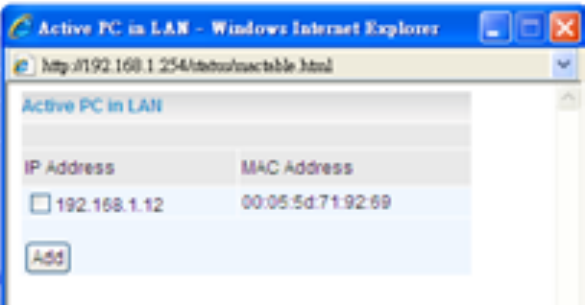
44
Active PC in LAN: Active PC in LAN displays a list of individual Ethernet device’s IP Address
&MAC Address which connecting to the router.
You can easily by checking the box next to the IP address to be blocked or allowed. Then, Add to
insert to the Ethernet Client Filter table. The maximum Ethernet client is 16.
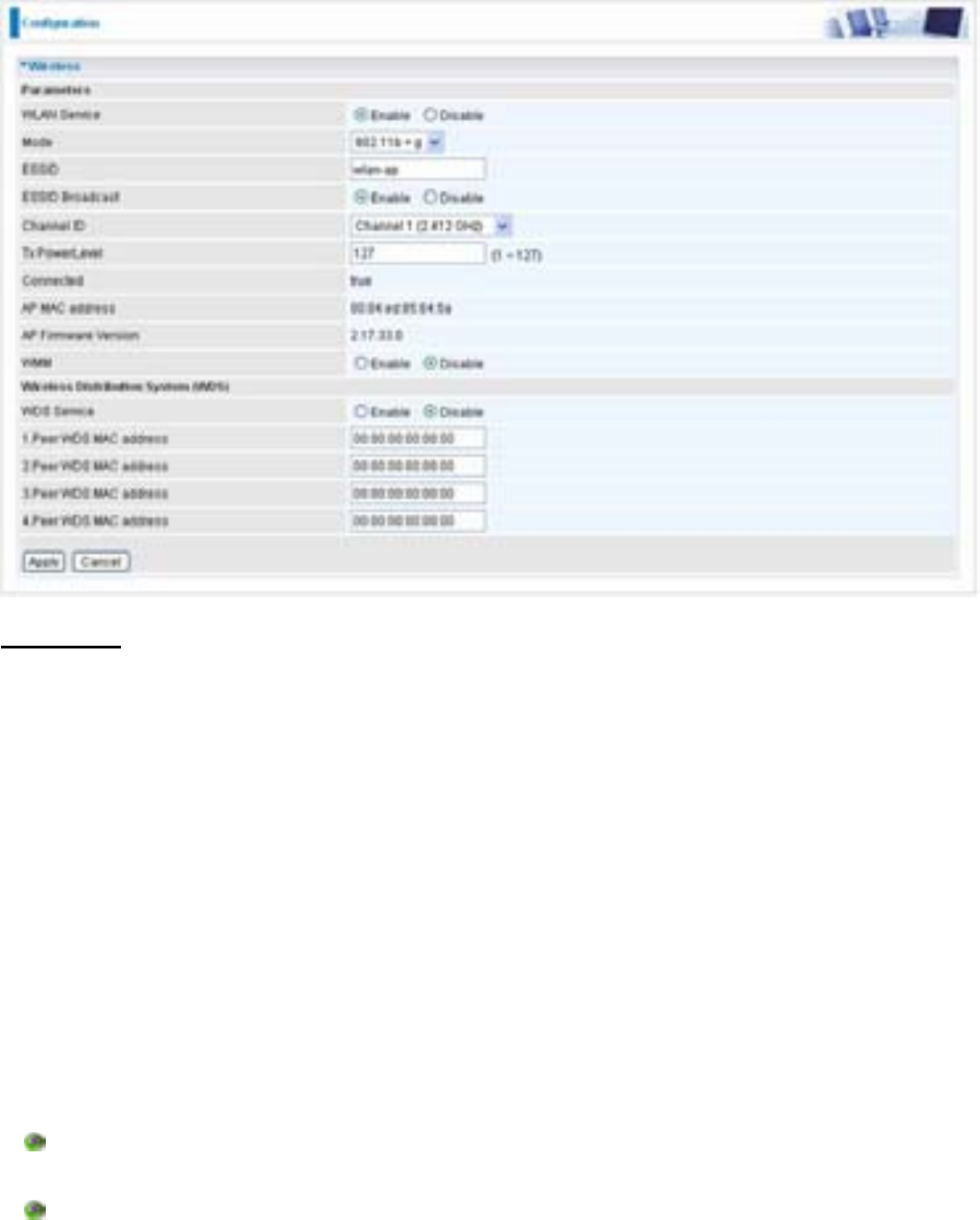
45
Wireless
Parameters
WLAN Service: Default setting is set to Enable. If you do not have any wireless, both 802.11g
and 802.11b, device in your network, select Disable.
Mode: The default setting is 802.11b+g (Mixed mode). If you do not know or have both 11g and
11b devices in your network, then keep the default in mixed mode. From the drop-down manual,
you can select 802.11g if you have only 11g card. If you have only 11b card, then select 802.11b.
ESSID: The ESSID is the unique name of a wireless access point (AP) to be distinguished from
another. For security purpose, change the default wlan-ap to a unique ID name to the AP already
built-in to the router’s wireless interface. It is case sensitive and must not excess 32 characters.
Make sure your wireless clients have exactly the ESSID as the device, in order to get connected to
your network.
Note: It is case sensitive and must not excess 32 characters.
ESSID Broadcast: It is function in which transmits its ESSID to the air so that when wireless
client searches for a network, router can then be discovered and recognized. Default setting is
Enabled.
Disable: If you do not want broadcast your ESSID. Any client uses “any” wireless setting
cannot discover the Access Point (AP) of your router.
Enable: Any client that using the “any” setting can discover the Access Point (AP).
Channel ID: Select the wireless connection ID channel that you would like to use.
Note: Wireless performance may degrade if select ID channel is already being occupied by

46
other AP(s).
TX PowerLevel: It is a function that enhances the wireless transmitting signal strength. User
may adjust this power level from minimum 1 up to maximum 127.
Note: The Power Level maybe different in each access network user premises environment
and choose the most suitable level for your network.
Connected: Representing in true or false. That it is the connection status between the system
and the build-in wireless card.
AP MAC Address: It is a unique hardware address of the Access Point.
AP Firmware Version: The Access Point firmware version.
WMM: This feature works concurrently with QoS that enables the system to prioritize the flow of
data packets according to 4 categories: Voice, Video, Best Efforts and Background.
Enable: Click to activate WMM feature.
Disable: Click to deactivate WMM feature
Wireless Distribution System (WDS)
It is a wireless access point mode that enables wireless link and communication with other access
point. It is easy to be installed simply to define peer’s MAC address of the connected AP. WDS takes
advantages of cost saving and flexibility which no extra wireless client device is required to bridge
between two access points and extending an existing wired or wireless infrastructure network to
create a larger network. It can connect up to 4 wireless APs for extending cover range at the same
time.
In addition, WDS enhances its link connection security in WEP mode, WEP key encryption must be
the same for both access points.
WDS Service: The default setting is Disabled. Check Enable radio button to activate this
function.
1. Peer WDS MAC Address: It is the associated AP’s MAC Address. It is important that your
peer’s AP must include your MAC address in order to acknowledge and communicate with
each other.
2. Peer WDS MAC Address: It is the second associated AP’s MAC Address.
3. Peer WDS MAC Address: It is the third associated AP’s MAC Address.
4. Peer WDS MAC Address: It is the fourth associated AP’s MAC Address.
Note: For MAC Address, Semicolon ( : ) must be included.

47
Wireless Security
You can disable or enable with WPA or WEP for protecting wireless network.
The default mode of wireless security is disabled.
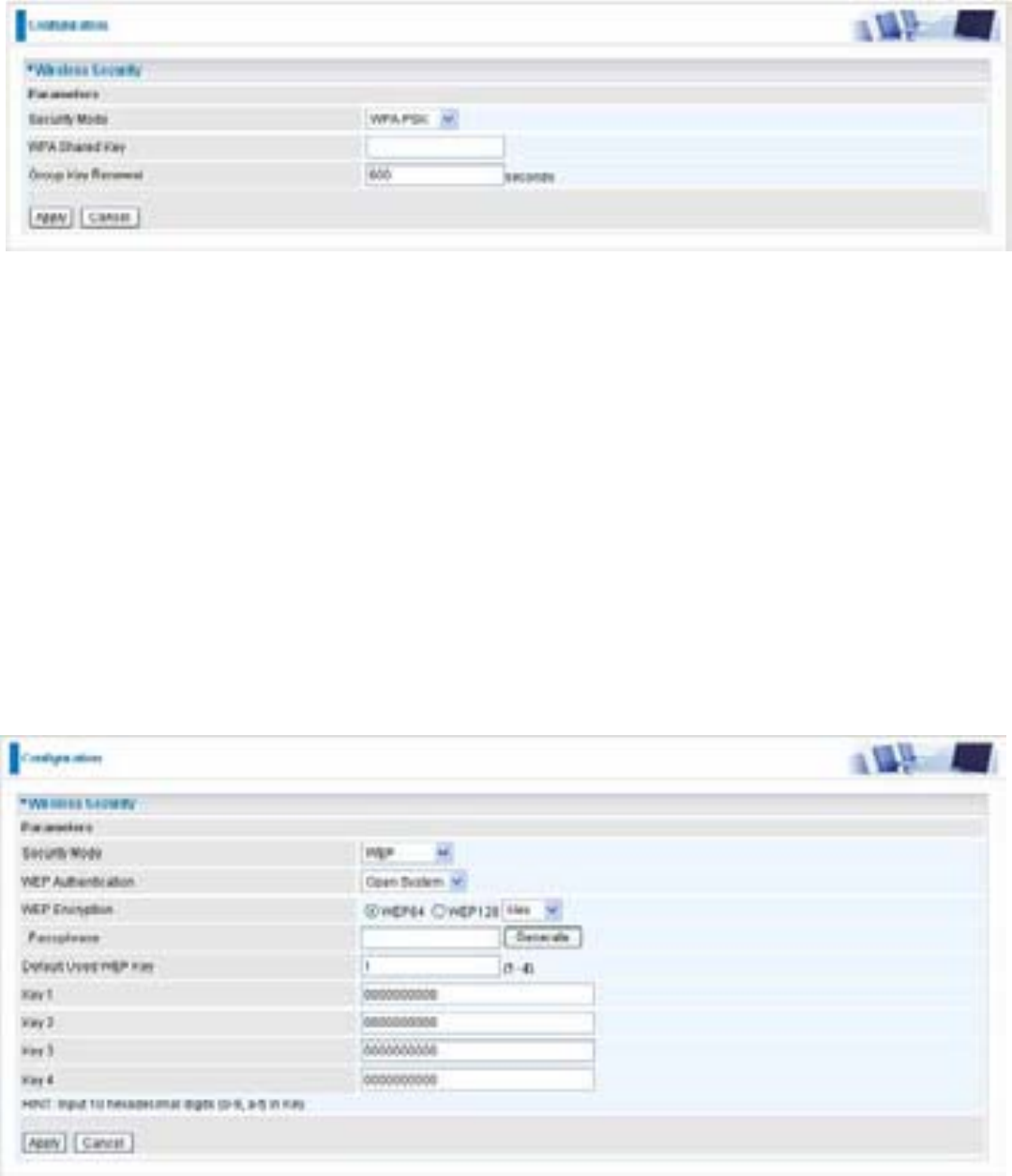
48
WPA-PSK / WPA2-PSK
Security Mode: You can disable or enable with WPA or WEP for protecting wireless network. The
default mode of wireless security is Disable.
WPA Algorithms: There are two types of the WPA-PSK, WPA-PSK and WPA2-PSK. The WPA-
PSK adapts the TKIP (Temporal Key Integrity Protocol) encrypted algorithms, which incorporates
Message Integrity Code (MIC) to provide protection against hackers. The WPA2-PSK adapts
CCMP (Cipher Block Chaining Message Authentication Code Protocol) of the AES (Advanced
Encryption Security) algorithms.
WPA Shared Key: The key for network authentication. The input format is in character style and
key size should be in the range between 8 and 63 characters.
Group Key Renewal: The period of renewal time for changing the security key automatically
between wireless client and Access Point (AP). Default value is 600 seconds.
WEP
WEP Authentication: To prevent unauthorized wireless stations from accessing data transmitted
over the network, the router offers secure data encryption, known as WEP. If you require high
security for transmissions, there are two options to select from: Open System, Share key.
WEP Encryption: To prevent unauthorized wireless stations from accessing data transmitted over
the network, the router offers highly secure data encryption, known as WEP. If you require high
security for transmissions, there are two alternatives to select from: WEP 64 and WEP 128. WEP
49
128 will offer increased security over WEP 64.
Passphrase: This is used to generate WEP keys automatically based upon the input string and a
pre-defined algorithm in WEP64 or WEP128.
Default Used WEP Key: Select the encryption key ID; please refer to Key (1~4) below.
Key (1-4): Enter the key to encrypt wireless data. To allow encrypted data transmission, the WEP
Encryption Key values on all wireless stations must be the same as the router. There are four keys
for your selection. The input format is in HEX style, 10 and 26 HEX codes are required for WEP64
and WEP128 respectively.
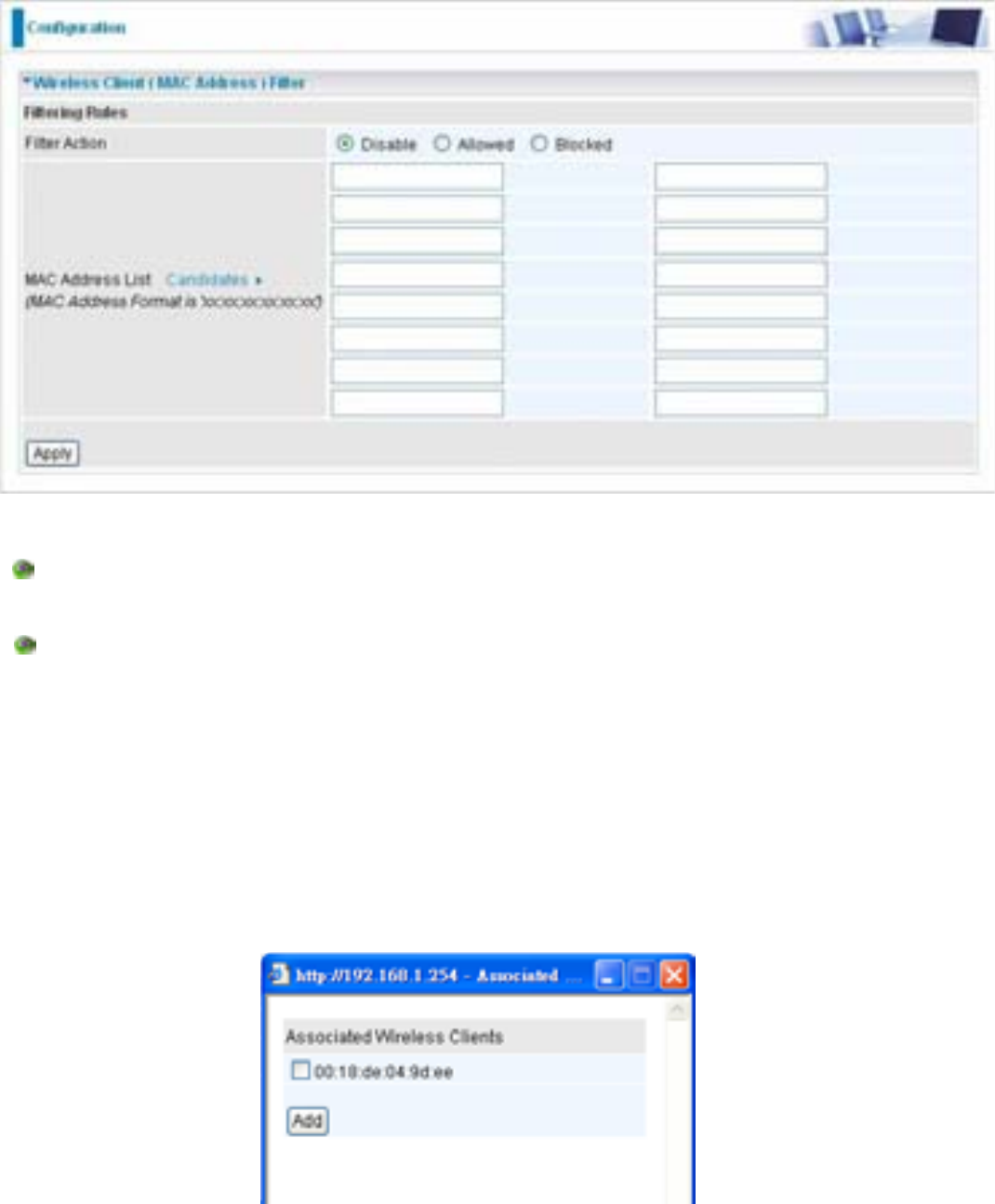
50
Wireless Client / MAC Address Filter
The MAC Address supports up to 16 wireless network machines and helps you manage your network
control to accept traffic from specific authorized machines or to restrict unwanted machine(s) to
access your LAN.
There are no pre-define MAC Address filter rules; you can add the filter rules to meet your
requirements.
Wireless Client Filter: Default setting is set to Disable.
Allowed: To authorize specific device accessing your LAN by insert the MAC Address in the
space provided or click the Candidate button. Make sure your PC’s MAC is listed.
Blocked: To prevent unwanted device accessing the LAN by insert the MAC Address in the
space provided or click the Candidate button. Make sure your PC’s MAC is not listed.
The maximum client is 16. The MAC addresses are 6 bytes long; they are presented only in
hexadecimal characters. The number 0-9and letters a-fare acceptable.
Note: Follow the MAC Address Format xx:xx:xx:xx:xx:xx. Semicolon ( : ) must be included.
Candidates: It automatically detects devices connected to the router through the Wireless feature.
Click the Candidate button to access the Associated Wireless Client window.
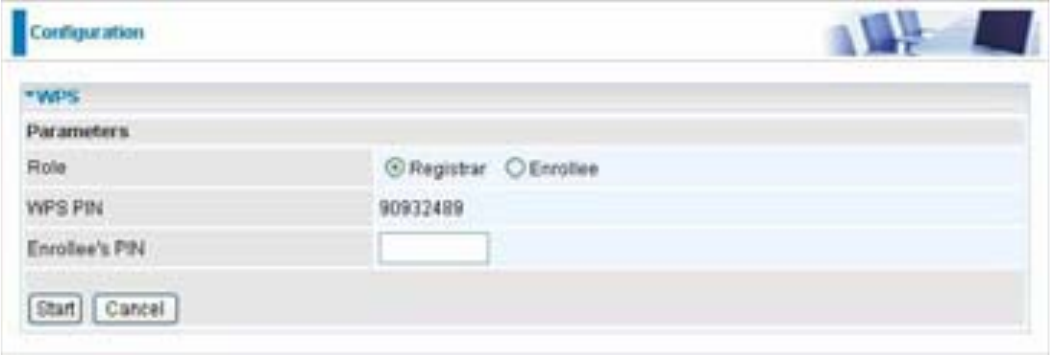
51
Associate Wireless Client: Displays a list of individual wireless device’s MAC Address that currently
connects to the router.
You can easily by checking the box next to the MAC address to be blocked or allowed. Then, Add to
insert to the Wireless Client (MAC Address) Filter table. The maximum Wireless client is 16.
WPS
WPS feature is follow Wi-Fi Alliance WPS standard and it easily set up security-enabled Wi- Fi
networks in the home and small office environment. It is reduced by half the user steps to
configure a network and supports two methods that are familiar to most consumers to configure a
network and enable security.
Set up of security-enabled Wi-Fi network
Step 1: Note down the AP’s PIN from Web (Ex: 90932489).
Step 2: Open wireless client’s WPS utility (Ex: Atheros Jumpstart WPS utility), select
“Configure a wireless network” and apply “next” button.
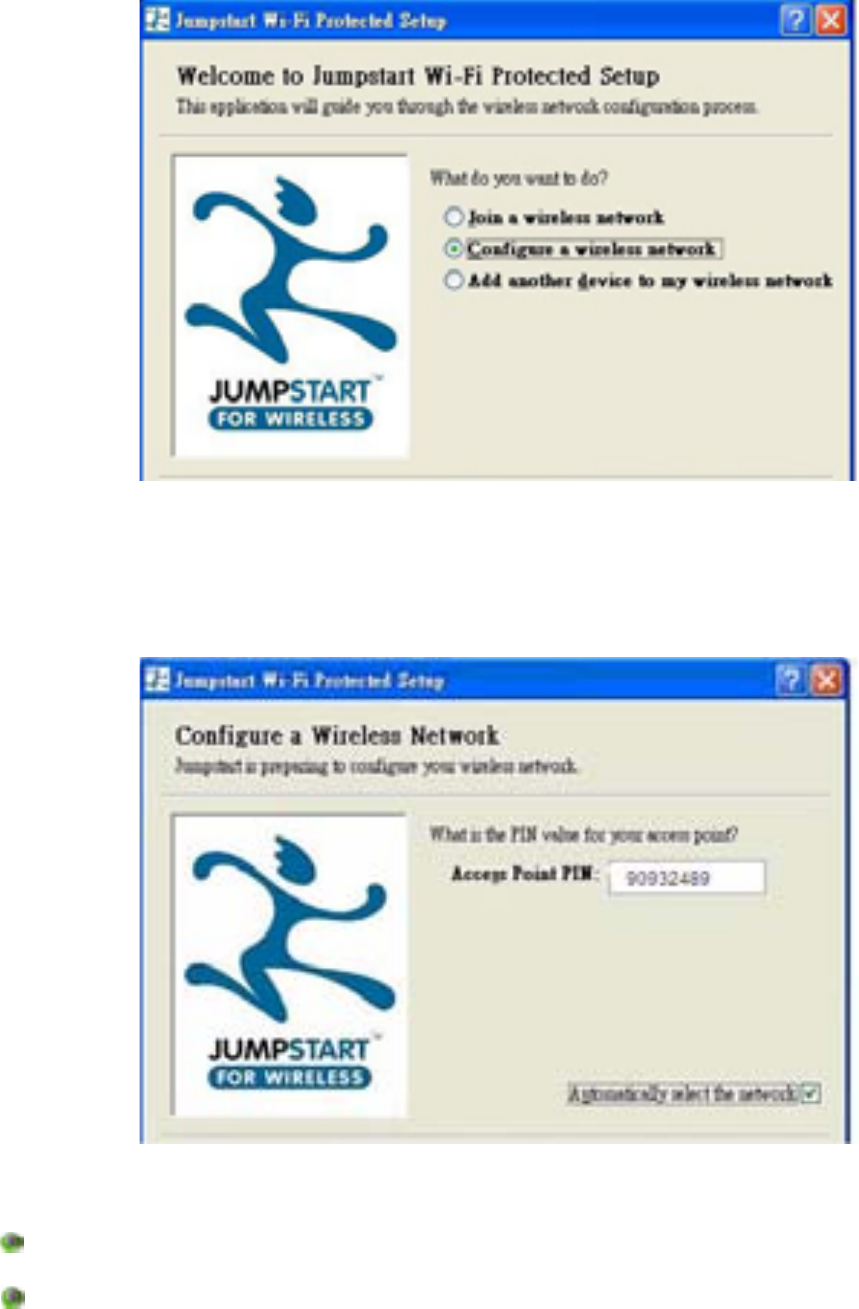
52
Step 3: Enter AP’s PIN into the utility and click on the “next” button.
Step 4: These are two ways to trigger AP as Enrollee role, you can choose one to do it.
Push AP’s WPS button 1 second and release it. Or
In the AP’s WPS configuration page, change Role to “Enrollee” and apply “Start” button.
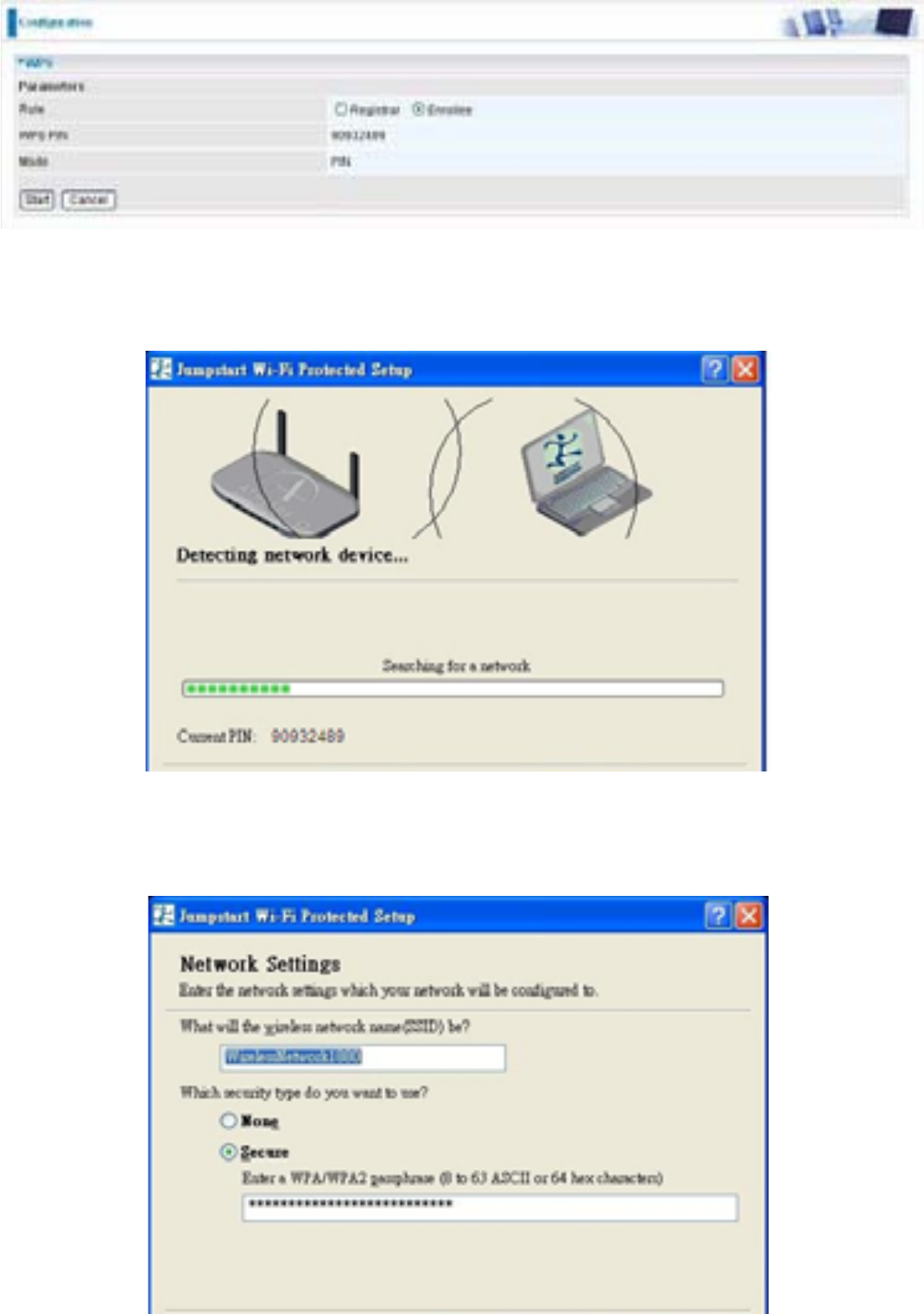
53
Step 5: Jump start WPS utility search WPS AP.
Step 6: SSID and security will be generated automatically (You can change it) and apply
“next” button.
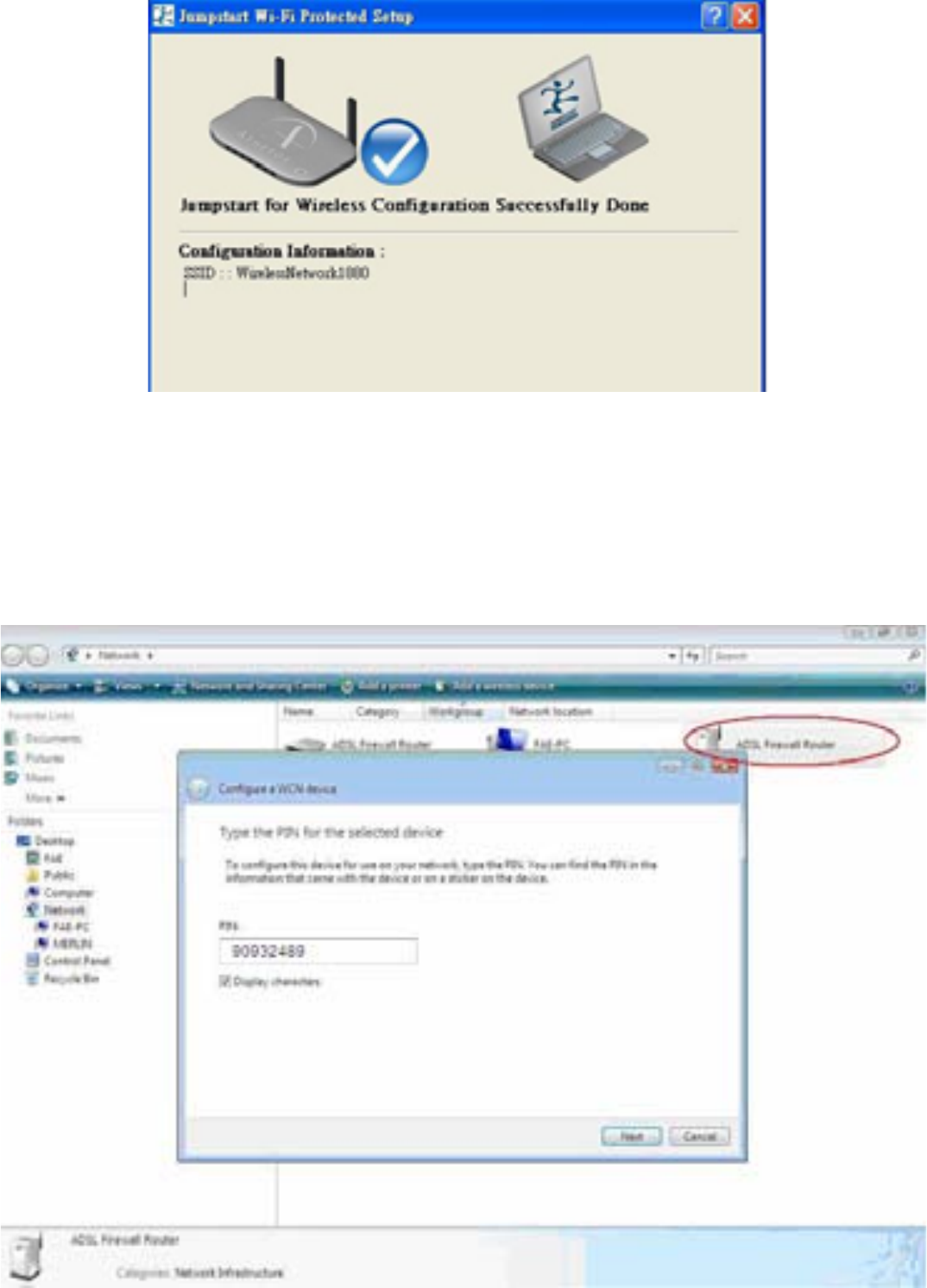
54
Step 7: WPS set up complete. And you have set up security-enabled Wi-Fi networks.
Set up of security-enabled Wi-Fi network using WCN in Vista
Step 1: Note down the AP’s PIN from Web (Ex: 90932489).
Step 2: In Vista`s Control Panel, select Network and Internet and choose View network
computers and devices. Double click the “ADSL Firewall Router” icon and enter the AP’s PIN code
then click “Next”.
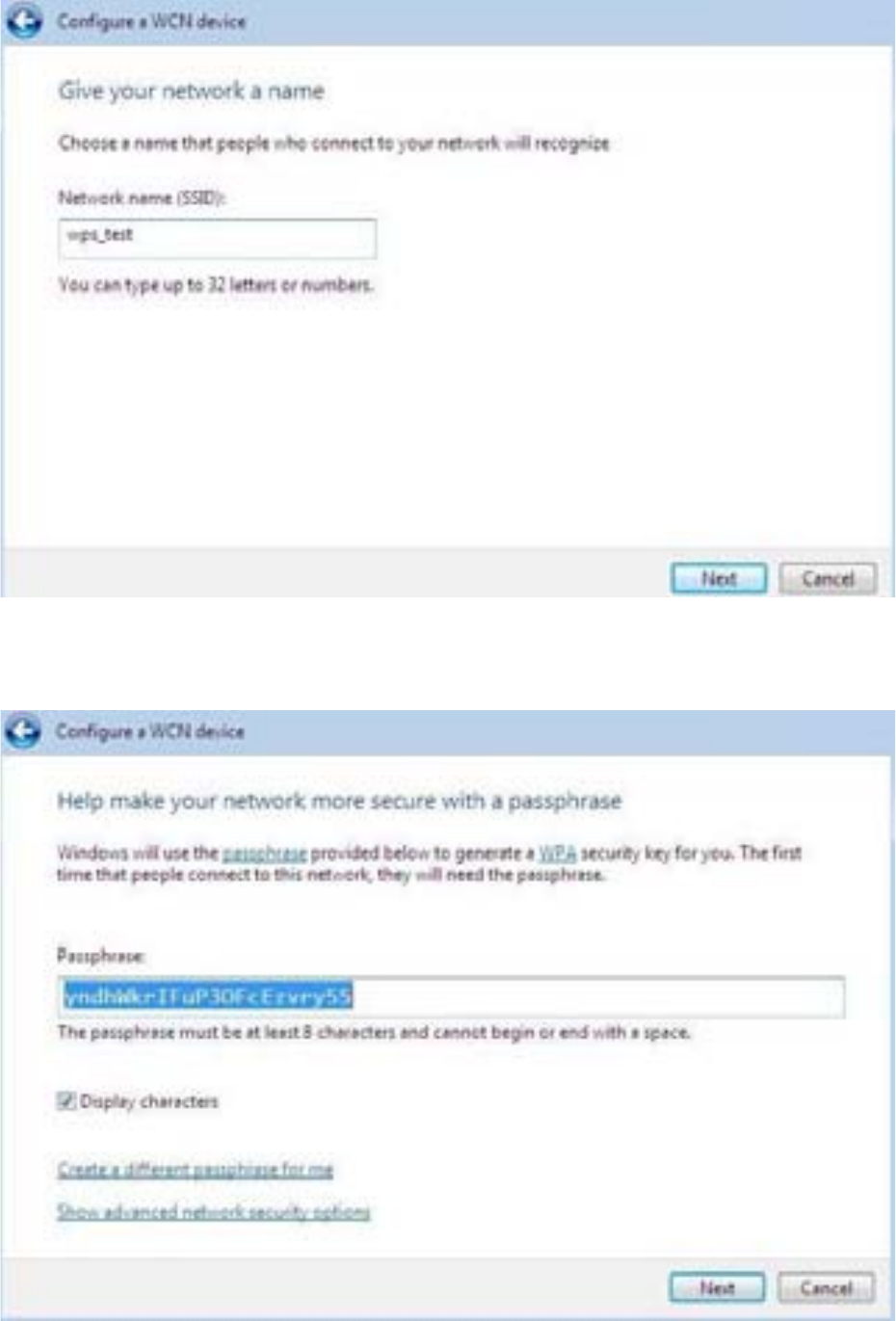
55
Step 3: Enter the AP SSID and apply “Next” button.
Step 4: Enter the Passphrase and apply “Next” button.
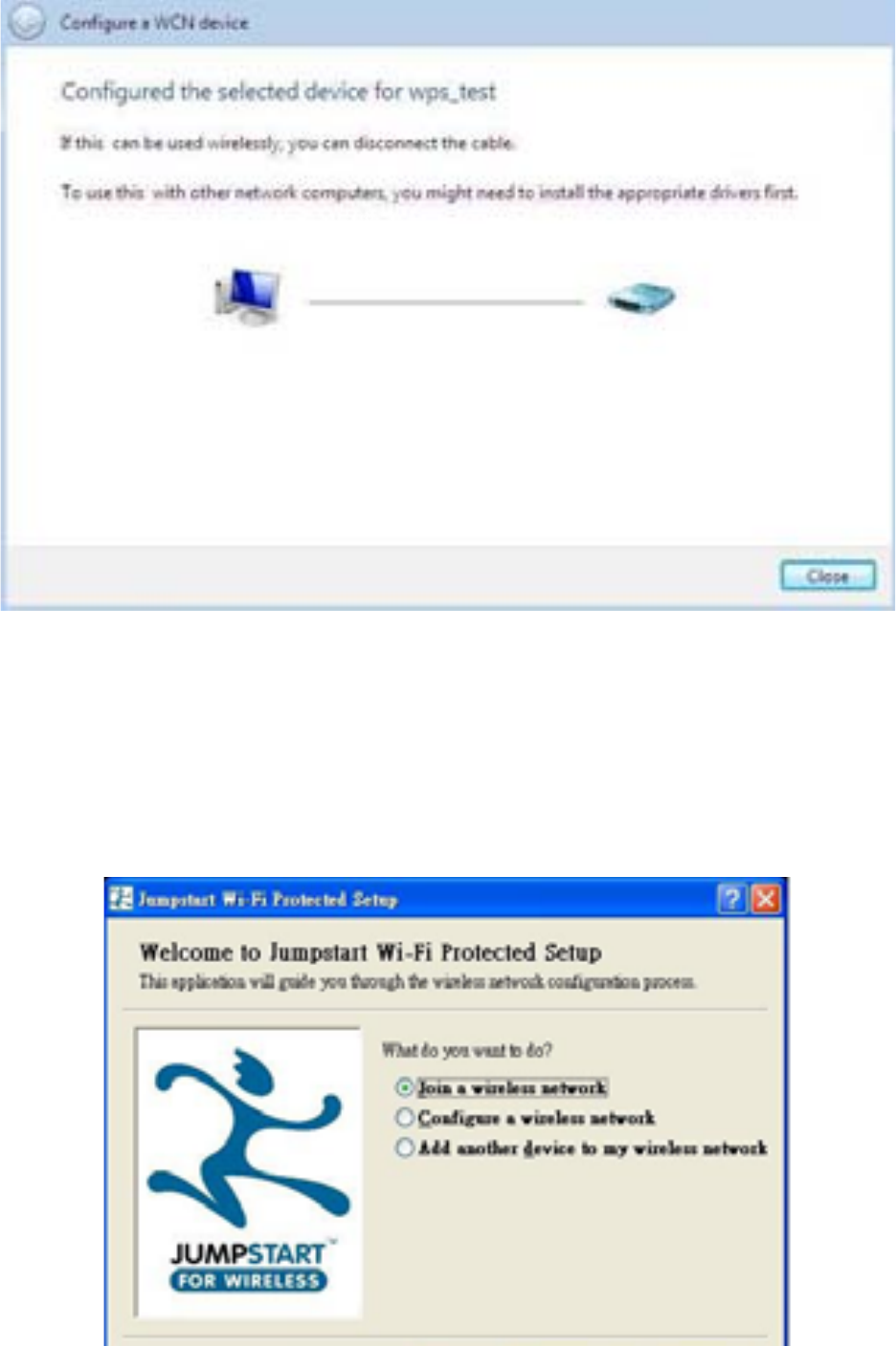
56
Step 5: WCN set up complete. And you have set up security-enabled Wi-Fi networks.
Adding a new WPS device (wireless client) to a network - Use PBC Method
Step 1: Push AP’s WPS button more than one second and you will see AP’s WLAN led will flashing
per second.
Step 2: Open wireless client’s WPS utility, select “Join a wireless network” and apply “next” button.
Note: After you push AP’s WPS button, below steps should be completed between 2 minutes.
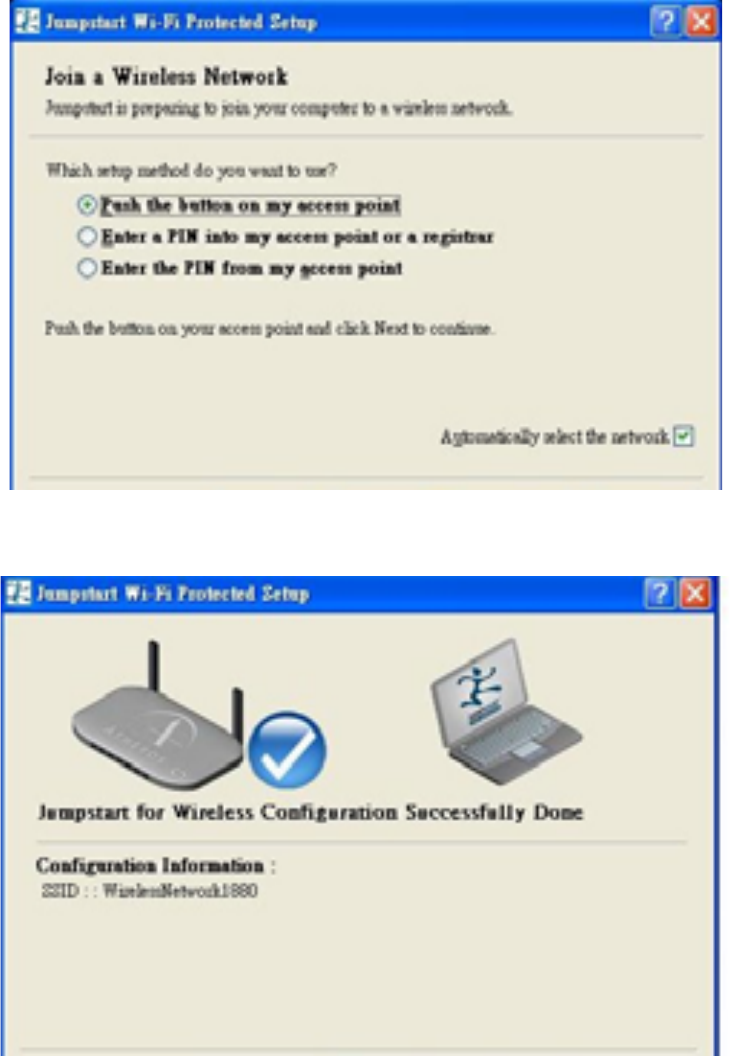
57
Step 3: Select “Push the button on my access point” and apply “next” button.
Step 4: New WPS device have join into the wireless network.
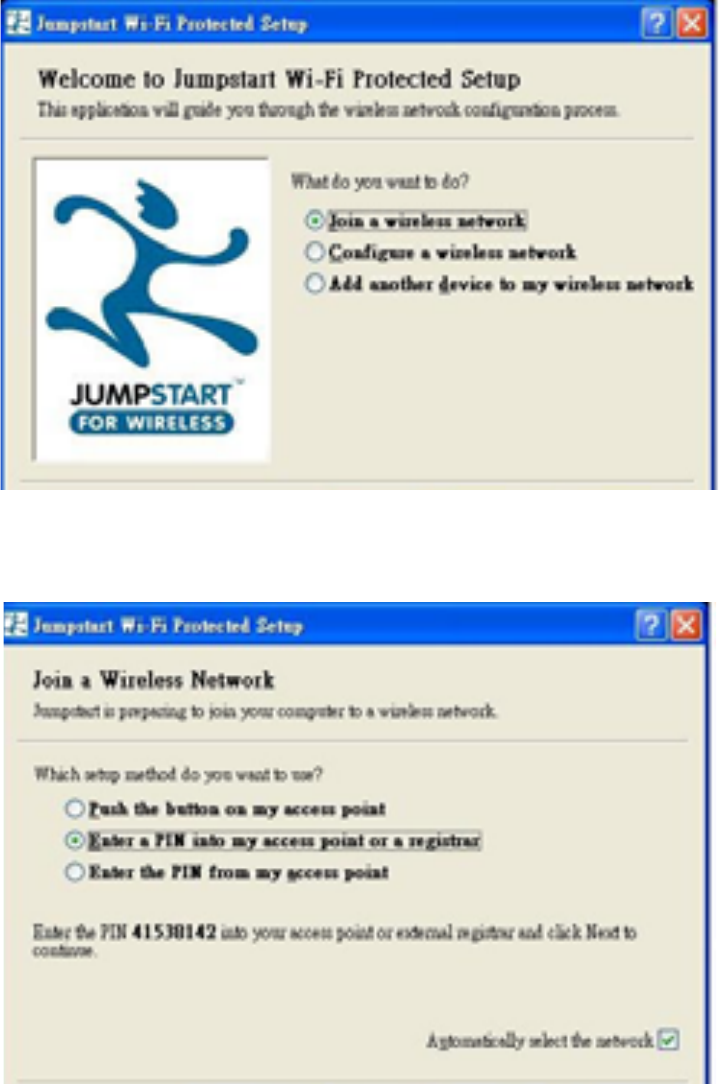
58
Adding a new WPS device (wireless client) to a network - Use PIN Method
Step 1: Open wireless client’s WPS utility, select “Join a wireless network” and apply “next” button
Step 2: Note down the wireless client’s PIN (Ex: 41538142) and apply “Start” button for active
wireless client WPS PIN method.
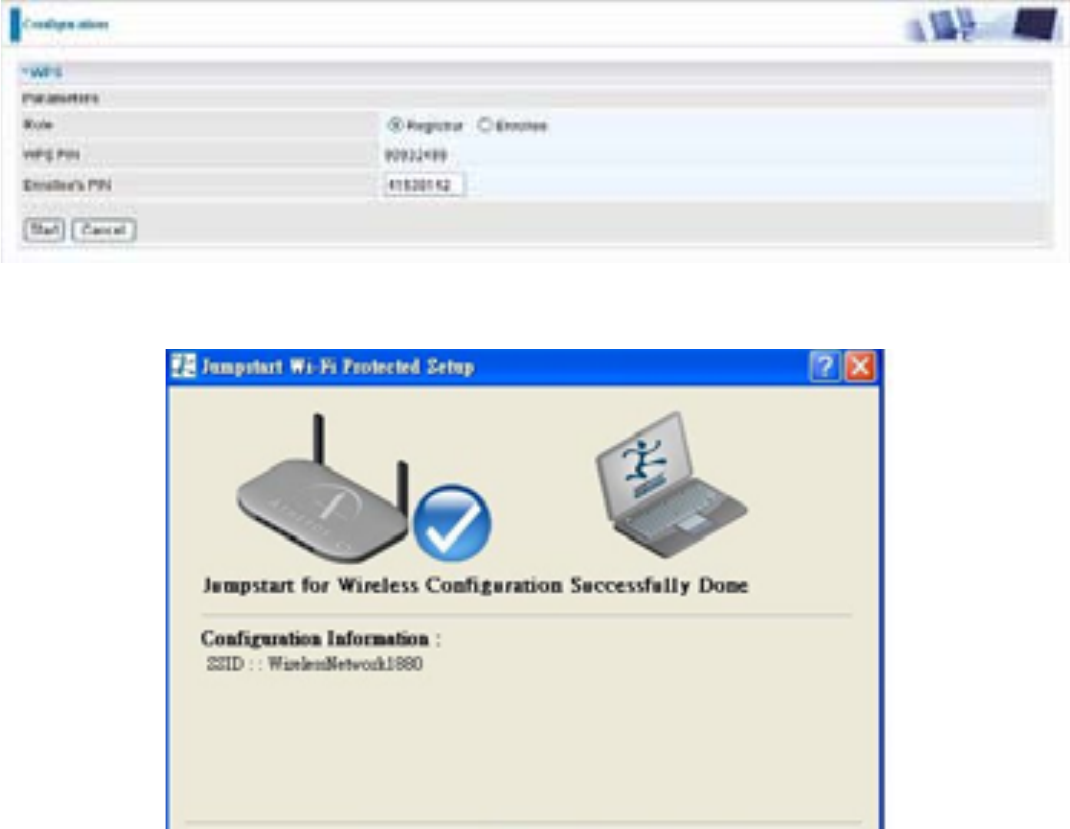
59
Step 3: Enter wireless client’s PIN into “Enrollee’s PIN” of Web and apply “Start” button.
Step 4: New WPS device have join into the wireless network.
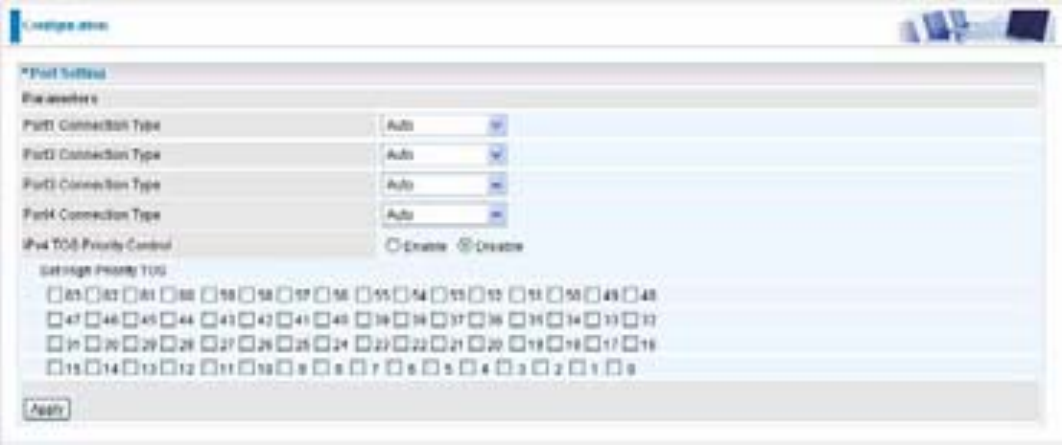
60
Port Setting
This section allows you to configure the settings for the router’s Ethernet ports to solve some
of the compatibility problems that may be encountered while connecting to the Internet, as well
allowing users to tweak the performance of their network.
Port # Connection Type: There are Six options to choose from: Auto, disable, 10M half-duplex,
10M full-duplex, 100M half-duplex, 100M full-duplex and Disable. Sometimes, there are Ethernet
compatibility problems with legacy Ethernet devices, and you can configure different types to
solve compatibility issues. The default is Auto, which users should keep unless there are specific
problems with PCs not being able to access your LAN.
IPv4 TOS priority Control (Advanced users): TOS, Type of Services, is the 2nd octet of an IP
packet. Bits 6-7 of this octet are reserved and bit 0-5 are used to specify the priority of the packet.
This feature uses bits 0-5 to classify the packet’s priority. If the packet is high priority, it will flow
first and will not be constrained by the Rate Limit. Therefore, when this feature is enabled, the
router’s Ethernet switch will check the 2nd octet of each IP packet. If the value in the TOS field
matches the checked values in the table (0 to 63), this packet will be treated as high priority.
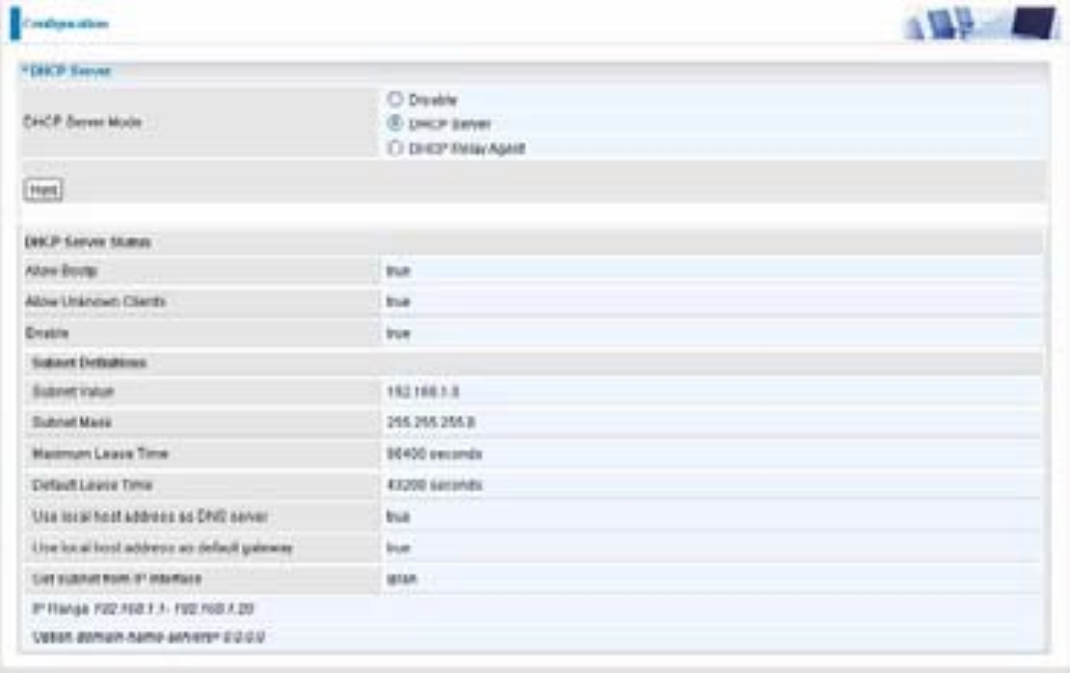
61
DHCP Server
You can disable or enable the DHCP (Dynamic Host Configuration Protocol) server or enable the
router’s DHCP relay functions. The DHCP protocol allows your router to dynamically assign IP
addresses to PCs on your network if they are configured to obtain IP addresses automatically.
To disable the router’s DHCP Server, check Disabled and click Next, then click Apply. When the
DHCP Server is disabled you will need to manually assign a fixed IP address to each PCs on your
network, and set the default gateway for each PCs to the IP address of the router (by default this is
192.168.1.254).
To configure the router’s DHCP Server, check DHCP Server and click Next. You can then configure
parameters of the DHCP Server including the IP pool (starting IP address and ending IP address to
be allocated to PCs on your network), lease time for each assigned IP address (the period of time
the IP address assigned will be valid), DNS IP address and the gateway IP address. These details
are sent to the DHCP client (i.e. your PC) when it requests an IP address from the DHCP server.
Click Apply to enable this function. If you check “Use Router as a DNS Server”, the ADSL Router will
perform the domain name lookup, find the IP address from the outside network automatically and
forward it back to the requesting PC in the LAN (your Local Area Network).
If you check DHCP Relay Agent and click Next, then you will have to enter the IP address of the
DHCP server which will assign an IP address back to the DHCP client in the LAN. Use this function
only if advised to do so by your network administrator or ISP.
Click Apply to enable this function.
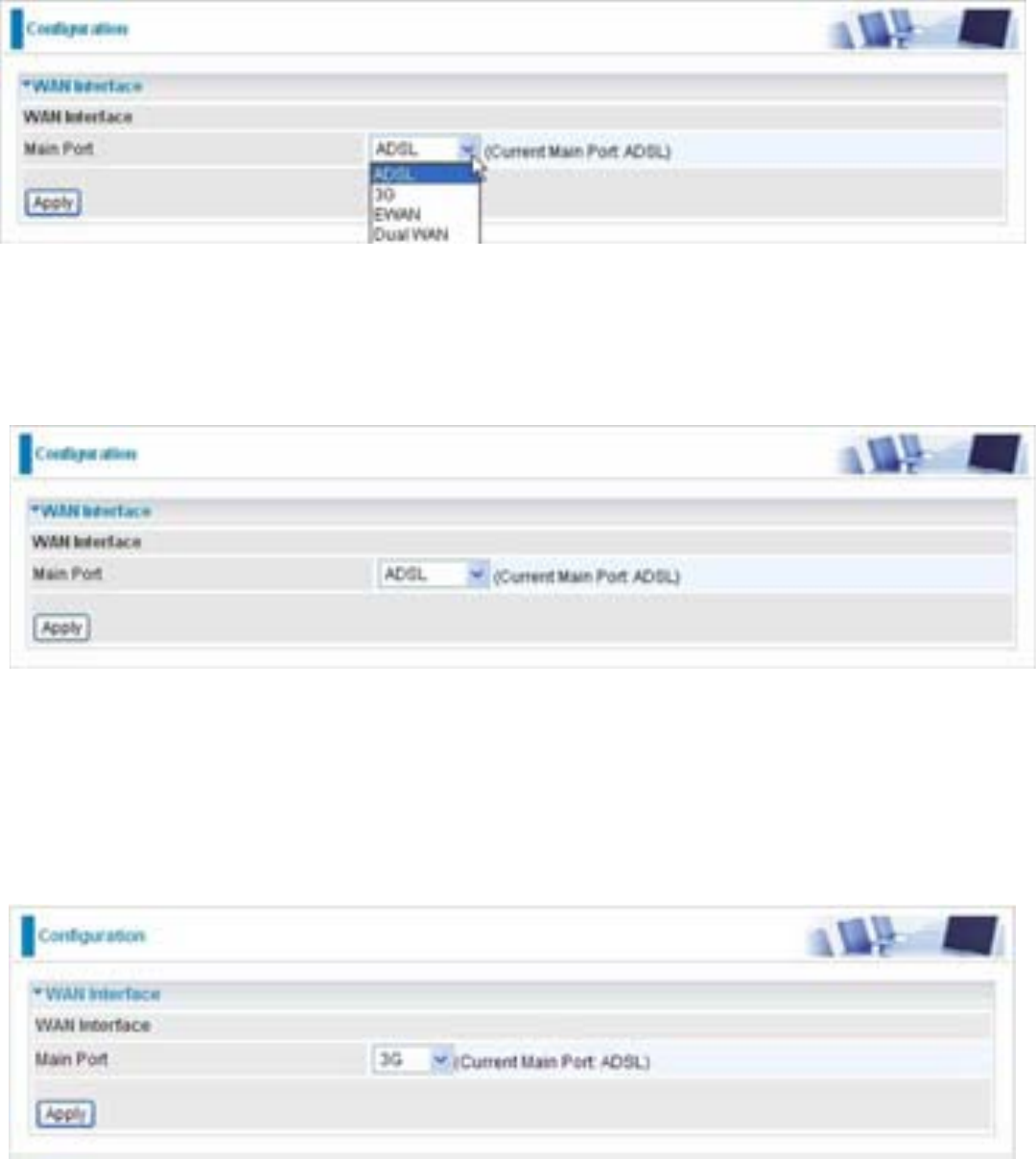
62
WAN - Wide Area Network
WAN refers to your Wide Area Network connection, i.e. your router’s connection to your ISP and
the Internet. Here are the items within the WAN section: WAN Interface, WAN Profile and ADSL
Mode.
WAN Interface
ADSL Mode
The default setting for Connection Mode is ADSL and for Protocol is PPPoE.
3G Mode
In ADSL mode, as the ADSL is not available (failover/failback), it will switch to 3G mode for WAN
Connection support. However, in 3G Mode ADSL cannot support WAN Connection when 3G
Mode is unavailable.
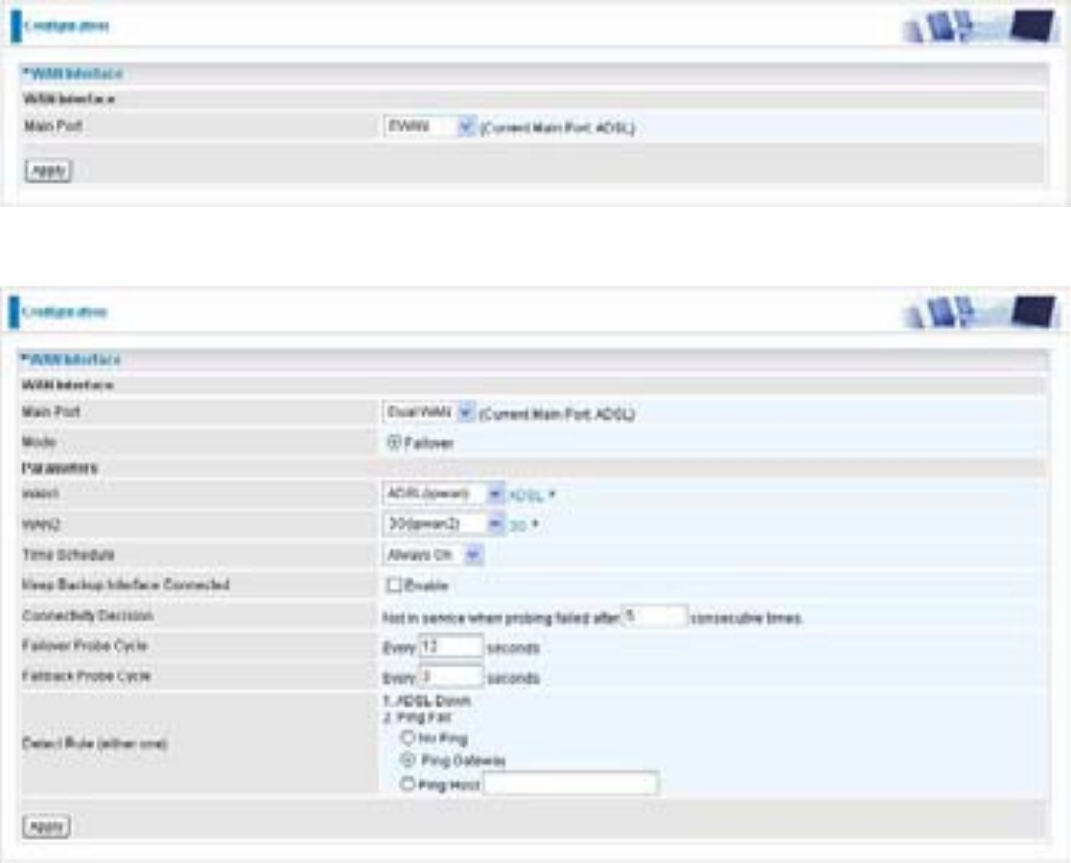
63
EWAN
EWAN is another way of getting connected to the Internet, the router offers its Ethernet port 1 as a
WAN port to be used to connect to Cable Modems and fiber optic lines. This alternative, yet faster
method to connect to the internet will provide users more flexibility to get online. When the above
two mode is not valid,the way can be adopted.
Dual WAN
Main Port: Select Dual WAN.
Mode Failover: Set to trigger ADSL / 3G failover function ready.
WAN1: Select “ADSL” “EWAN” or “3G” mode for WAN1.
WAN2: Select the left WAN mode for WAN2 as backup port. eg.If 3G is set for main port, then there
can be no option for failover/failback.
Time Schedule: A self defined time period. You may specify a time schedule for your prioritization
66 policy. For setup and detail, refer to Time Schedule section.
Keep Backup Interface Connected: Select Enable this function, the backup WAN port will connect
always.
Connectivity Decision: Set how many times of probing failed to switch backup port.
Failover Probe Cycle: Set the time duration for the Failover Probe Cycle to determine when the

64
router will switch to the backup connection (backup port) once the main connection (main port) fails.
Note:The time set is for each probe cycle, but the decision to change to the backup port is
determined by Probe Cycle duration multiplied by connection Decision amount (e.g. From the
image above it will be 60 seconds multiplied by 5 consecutive fails).
Failback Probe Cycle: Set the time duration for the Failback Probe Cycle to determine when the
router will switch back to the main connection (main port) from the backup connection (backup port)
once the main connection is communicating again.
Note:The time set is for each probe cycle, but the decision to change to the backup port is
determined by Probe Cycle duration multiplied by Connection Decision amount (e.g. From the
image above it will be 60 seconds multiplied by 5 consecutive fails).
Detect Rule:
Rule 1. ADSL Down
Rule 2. Ping Fail
No Ping: It will not send any ping packet to determine the connection. It means to disable
the ping fail detection.
Ping Gateway: It will send ping packet to gateway and wait response from gateway in every
“Probe Cycle”.
Ping Host: It will send ping packet to specific host and wait response in every “Probe Cycle”.
The host must be an IP address.
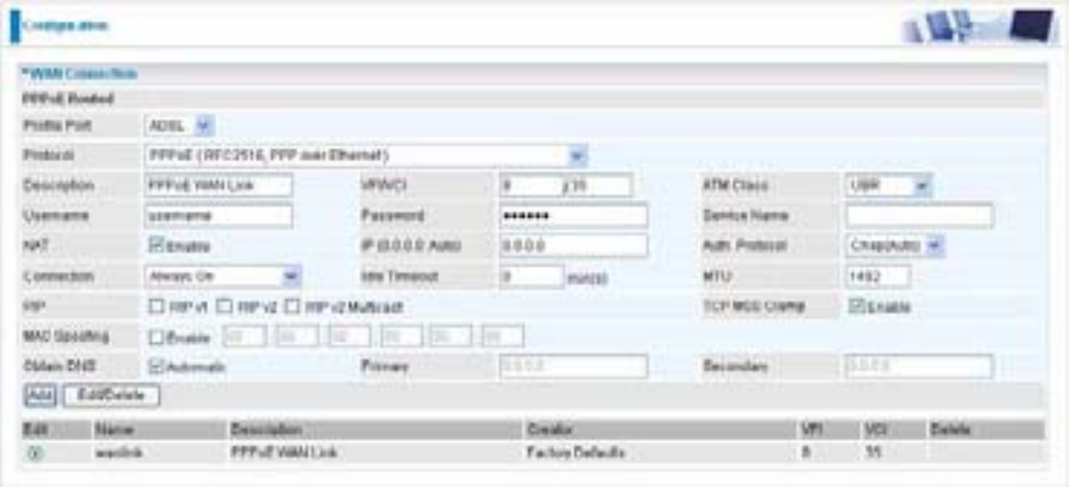
65
WAN Profile
ADSL
PPPoE Connection
PPPoE (PPP over Ethernet) provides access control in a manner which is similar to dial-up services
using PPP.
Profile Port: Select the profile port as ADSL.
Protocol: The ATM protocol will be used in the device.
Description: A given name for the connection.
VPI/VCI: Enter the information provided by your ISP.
ATM Class: The Quality of Service for ATM layer.
Username: Enter the username provided by your ISP. You can input up to 128 alphanumeric
characters (case sensitive). This is in the format of “username@ispname” instead of simply
“username”.
Password: Enter the password provided by your ISP. You can input up to 128 alphanumeric
characters (case sensitive).
Service Name: This item is for identification purposes. If it is required, your ISP provides you the
information. Maximum input is 15 alphanumeric characters.
NAT: The NAT (Network Address Translation) feature allows multiple users to access the Internet
through a single IP account, sharing the single IP address. If users on your LAN have public IP
addresses and can access the Internet directly, the NAT function can be disabled.
IP (0.0.0.0:Auto): Your WAN IP address. Leave this at 0.0.0.0 to obtain automatically an IP
address from your ISP.

66
Auth. Protocol: Default is Auto. Your ISP should advise you on whether to use Chap or Pap.
Connection:
Always on: If you want the router to establish a PPPoA session when starting up and to au-
tomatically re-establish the PPPoA session when disconnected by the ISP.
Connect on Demand: If you want to establish a PPPoA session only when there is a packet
requesting access to the Internet (i.e. when a program on your computer attempts to access
the Internet).
Idle Timeout: Auto-disconnect the broadband firewall gateway when there is no activity on the line
for a predetermined period of time.
Detail: You can define the destination port and packet type (TCP/UDP) without checking by
timer. It allows you to set which outgoing traffic will not trigger and reset the idle timer.
MTU: Maximum Transmission Unit. The size of the largest datagram (excluding media-specific
headers) that IP will attempt to send through the interface.
RIP: RIP v1, RIP v2, and RIP v2 Multicast. Check to enable RIP function.
TCP MSS Clamp: This option helps to discover the optimal MTU size automatically. Default is
enabled.
MAC Spoofing: Some service providers require the configuring of this option. You must fill in the
MAC address that specify by service provider when it is required. Default is disabled.
Obtain DNS: A Domain Name System (DNS) contains a mapping table for domain name and IP
addresses. DNS helps to find the IP address for the specific domain name. Check the checkbox
to obtain DNS automatically.
Primary DNS: Enter the primary DNS.
Secondary DNS: Enter the secondary DNS
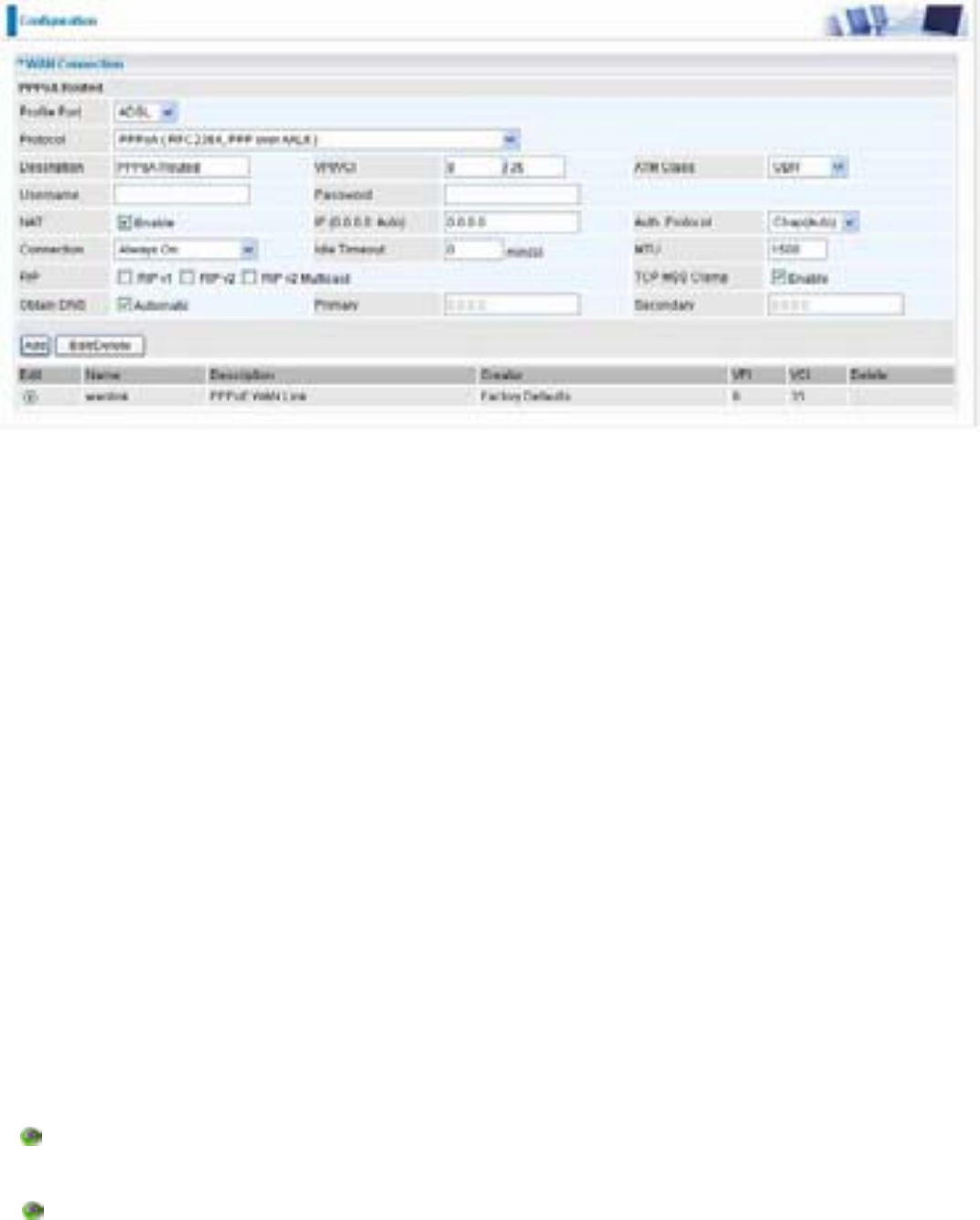
67
PPPoA Connection
Profile Port: Select the profile port as ADSL.
Protocol: The ATM protocol will be used in the device..
Description: A given name for the connection.
VPI/VCI: Enter the information provided by your ISP.
ATM Class: The Quality of Service for ATM layer.
Username: Enter the username provided by your ISP. You can input up to 128 alphanumeric
characters (case sensitive). This is in the format of “username@ispname” instead of simply
“username”.
Password: Enter the password provided by your ISP. You can input up to 128 alphanumeric
characters (case sensitive).
NAT: The NAT (Network Address Translation) feature allows multiple users to access the Internet
through a single IP account, sharing the single IP address. If users on your LAN have public IP
addresses and can access the Internet directly, the NAT function can be disabled.
IP (0.0.0.0:Auto): Your WAN IP address. Leave this at 0.0.0.0 to obtain automatically an IP
address from your ISP.
Auth. Protocol: Default is Auto. Your ISP should advises you on whether to use Chap or Pap.
Connection:
Always on: If you want the router to establish a PPPoA session when starting up and to au-
tomatically re-establish the PPPoA session when disconnected by the ISP.
Connect on Demand: If you want to establish a PPPoA session only when there is a packet
requesting access to the Internet (i.e. when a program on your computer attempts to access
the Internet).
Idle Timeout: Auto-disconnect the broadband firewall gateway when there is no activity on the line
for a predetermined period of time.

68
Detail: You can define the destination port and packet type (TCP/UDP) without checking by
timer. It allows you to set which outgoing traffic will not trigger and reset the idle timer.
MTU: Maximum Transmission Unit. The size of the largest datagram (excluding media-specific
headers) that IP will attempt to send through the interface.
RIP: RIP v1, RIP v2, and RIP v2 Multicast. Check to enable RIP function.
TCP MSS Clamp: This option helps to discover the optimal MTU size automatically. Default is
enabled.
Obtain DNS: A Domain Name System (DNS) contains a mapping table for domain name and IP
addresses. DNS helps to find the IP address for the specific domain name. Check the checkbox
to obtain DNS automatically.
Primary DNS: Enter the primary DNS.
Secondary DNS: Enter the secondary DNS.
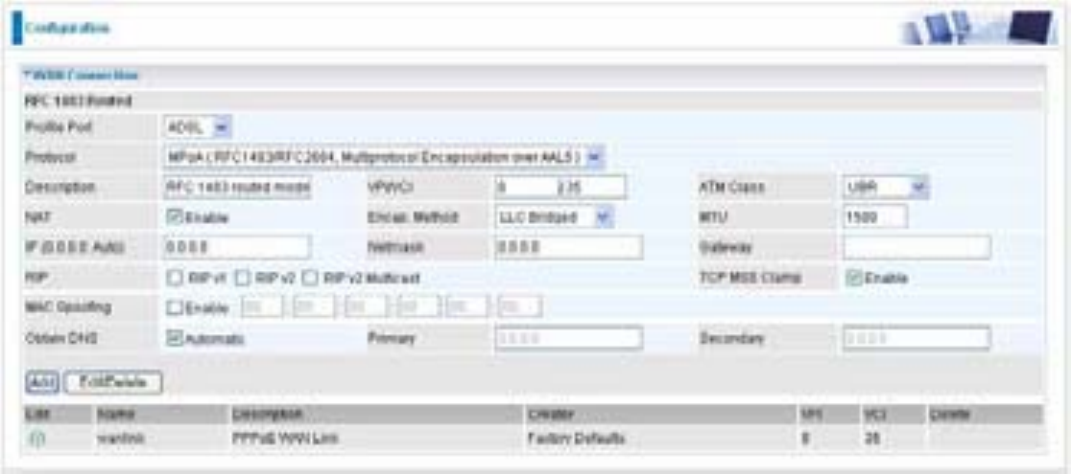
69
MPoA Connection
Profile Port: Select the profile port as ADSL.
Protocol: The ATM protocol will be used in the device.
Description: A given name for the connection.
VPI/VCI: Enter the information provided by your ISP.
ATM Class: The Quality of Service for ATM layer.
NAT: The NAT (Network Address Translation) feature allows multiple users to access the Internet
through a single IP account, sharing a single IP address. If users on your LAN have public IP
addresses and can access the Internet directly, the NAT function can be disabled.
Encap. mode: Choose whether you want the packets in WAN interface as bridged packet or
routed packet.
MTU: Maximum Transmission Unit. The size of the largest datagram (excluding media-specific
headers) that IP will attempt to send through the interface.
IP (0.0.0.0:Auto): Specify an IP address allowed to logon and access the router’s web server.
Note: IP 0.0.0.0 indicates all users who are connected to this router are allowed to logon the
device and modify data.
Netmask: The default is 255.255.255.0. User can change it to other such as 255.255.255.128.
Type the subnet mask assigned to you by your ISP (if given).
Gateway: Enter the IP address of the default gateway (if given).
RIP: RIP v1, RIP v2, and RIP v2 Multicast. Check to enable RIP function.
TCP MSS Clamp: This option helps to discover the optimal MTU size automatically. Default is
enabled.
70
MAC Spoofing: Some service providers require the configuring of this option. You must fill in the
MAC address that specify by service provider when it is required. Default is disabled.
Obtain DNS: A Domain Name System (DNS) contains a mapping table for domain name and IP
addresses. DNS helps to find the IP address for the specific domain name. Check the checkbox
to obtain DNS automatically.
Primary DNS: Enter the primary DNS.
Secondary DNS: Enter the secondary DNS.
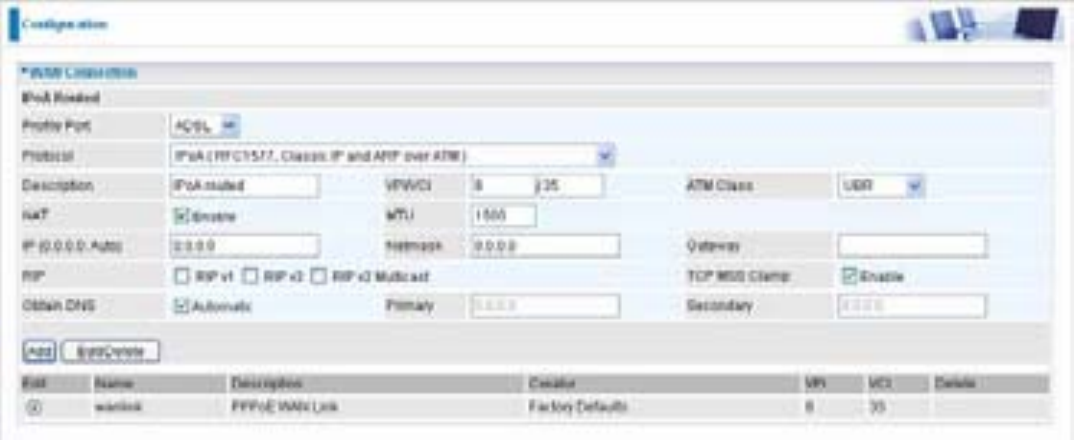
71
IPoA Connection
Profile Port: Select the profile port as ADSL.
Protocol: The ATM protocol will be used in the device.
Description: A given name for the connection.
VPI/VCI: Enter the information provided by your ISP.
ATM Class: The Quality of Service for ATM layer.
NAT: The NAT (Network Address Translation) feature allows multiple users to access the Internet
through a single IP account, sharing a single IP address. If users on your LAN have public IP
addresses and can access the Internet directly, the NAT function can be disabled.
MTU: Maximum Transmission Unit. The size of the largest datagram (excluding media-specific
headers) that IP will attempt to send through the interface.
IP (0.0.0.0:Auto): Specify an IP address allowed to logon and access the router’s web server.
Note: IP 0.0.0.0 indicates all users who are connected to this router are allowed to logon the
device and modify data.
Netmask: The default is 255.255.255.0. User can change it to other such as 255.255.255.128. Type
the subnet mask assigned to you by your ISP (if given).
Gateway: Enter the IP address of the default gateway (if given).
RIP: RIP v1, RIP v2, and RIP v2 Multicast. Check to enable RIP function.
TCP MSS Clamp: This option helps to discover the optimal MTU size automatically. Default is
enabled.
Obtain DNS: A Domain Name System (DNS) contains a mapping table for domain name and IP
addresses. DNS helps to find the IP address for the specific domain name. Check the checkbox
to obtain DNS automatically.
Primary DNS: Enter the primary DNS.
Secondary DNS: Enter the secondary DNS.
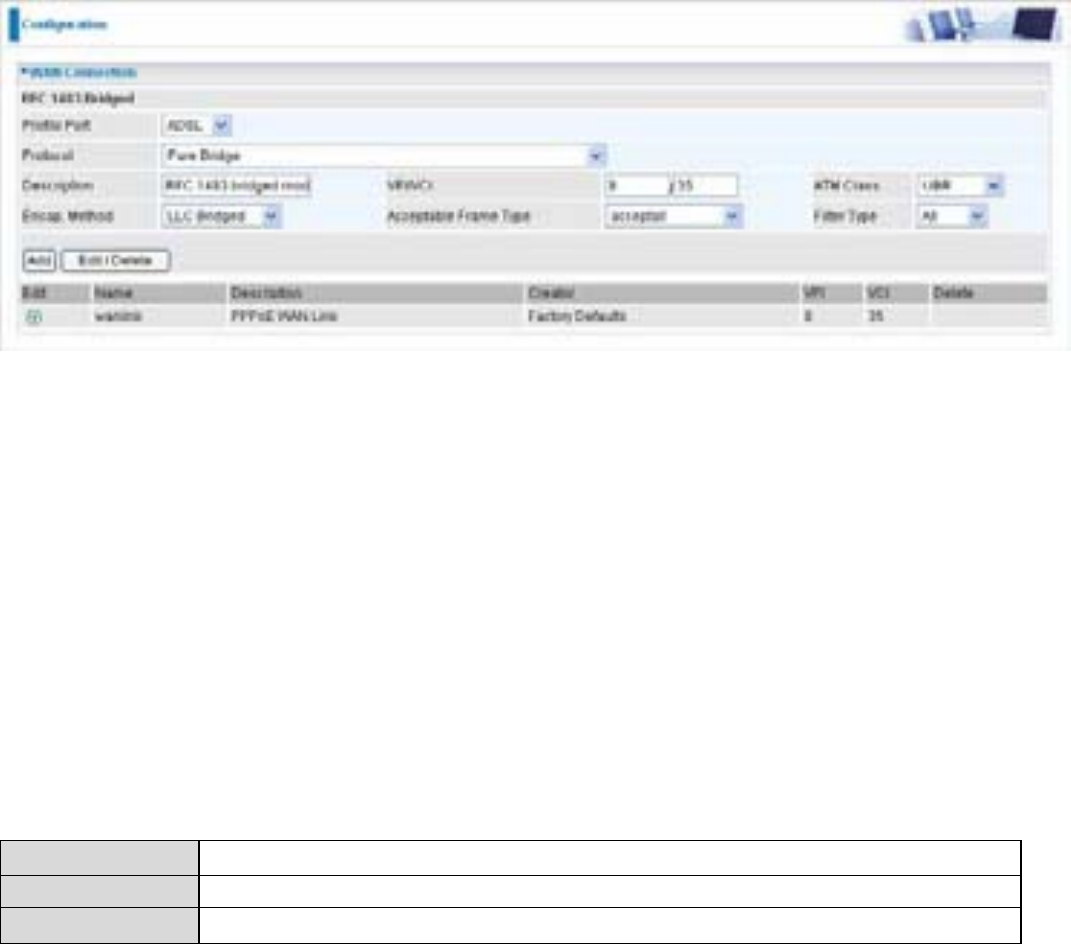
72
Pure Bridge
Profile Port: Select the profile port as ADSL.
Protocol: The ATM protocol will be used in the device.
Description: A given name for this connection.
VPI/VCI: Enter the information provided by your ISP.
ATM Class: The Quality of Service for ATM layer.
Encap. mode: Choose whether you want the packets in WAN interface as bridged packet or
routed packet.
Acceptable Frame Type: Specify which kind of traffic goes through this connection, all traffic or
only VLAN tagged.
Filter Type: Specify the type of ethernet filtering performed by the named bridge interface.
All Allows all types of ethernet packets through the port.
Ip Allows only IP/ARP types of ethernet packets through the port.
Pppoe Allows only PPPoE types of ethernet packets through the port.
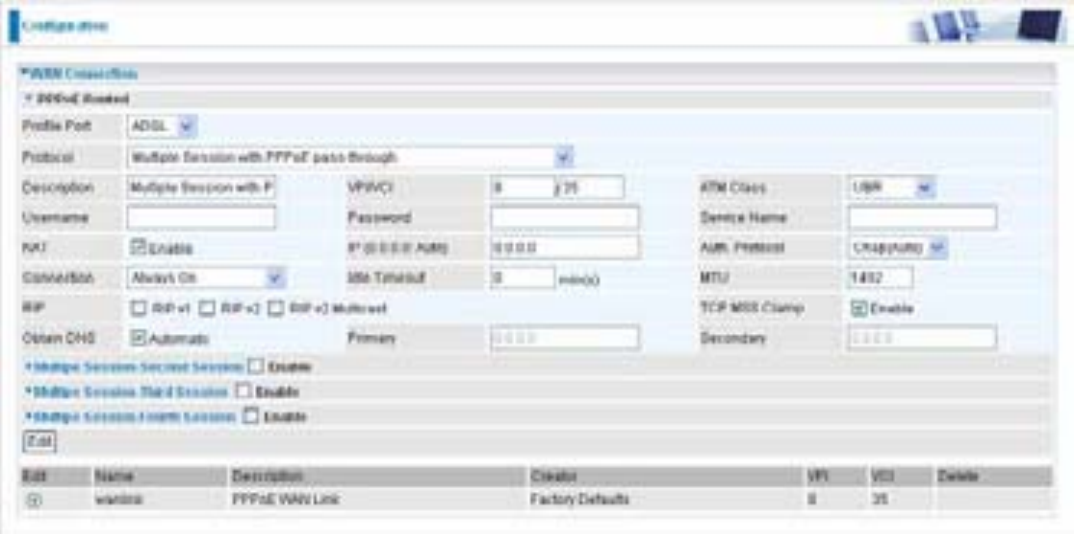
73
Multiple Seesion with PPPoE pass-through
Profile Port: Select the profile port as ADSL.
Protocol: The Multiple Session protocol will be used in the device.
Description: A given name for this connection.
VPI/VCI: Enter the information provided by your ISP.
ATM Class: The Quality of Service for ATM layer.
Username: Enter the username provided by your ISP. You can input up to 128 alpha-numeric
characters (case sensitive).
Password: Enter the password provided by your ISP. You can input up to 128 alpha-numeric
characters (case sensitive).
NAT: The NAT (Network Address Translation) feature allows multiple users to access the Internet
through a single IP account, sharing the single IP address. If users on your LAN have public IP
addresses and can access the Internet directly, the NAT function can be disabled.
IP (0.0.0.0:Auto): Your WAN IP address. Leave this at 0.0.0.0 to obtain automatically an IP
address from your ISP.
Auth. Protocol: Default is Auto. Your ISP should advise you on whether to use Chap or Pap.
Connection:
Always on: If you want the router to establish a PPPoA session when starting up and to
Automatically re-establish the PPPoA session when disconnected by the ISP.
Connect on Demand: If you want to establish a PPPoA session only when there is a packet
requesting access to the Internet (i.e. when a program on your computer attempts to access
the Internet).
Idle Timeout: Auto-disconnect the router when there is no activity on the line for a predetermined
76 period of time.
74
MTU: Maximum Transmission Unit. The size of the largest datagram (excluding media-specific
headers) that IP will attempt to send through the interface.
RIP: RIP v1, RIP v2, and RIP v2 Multicast. Check to enable RIP function.
TCP MSS Clamp: This option helps to discover the optimal MTU size automatically. Default is
enabled.
Obtain DNS: A Domain Name System (DNS) contains a mapping table for domain name and IP
addresses. DNS helps to find the IP address for the specific domain name. Check the checkbox to
obtain DNS automatically.
Primary DNS: Enter the primary DNS.
Secondary DNS: Enter the secondary DNS.
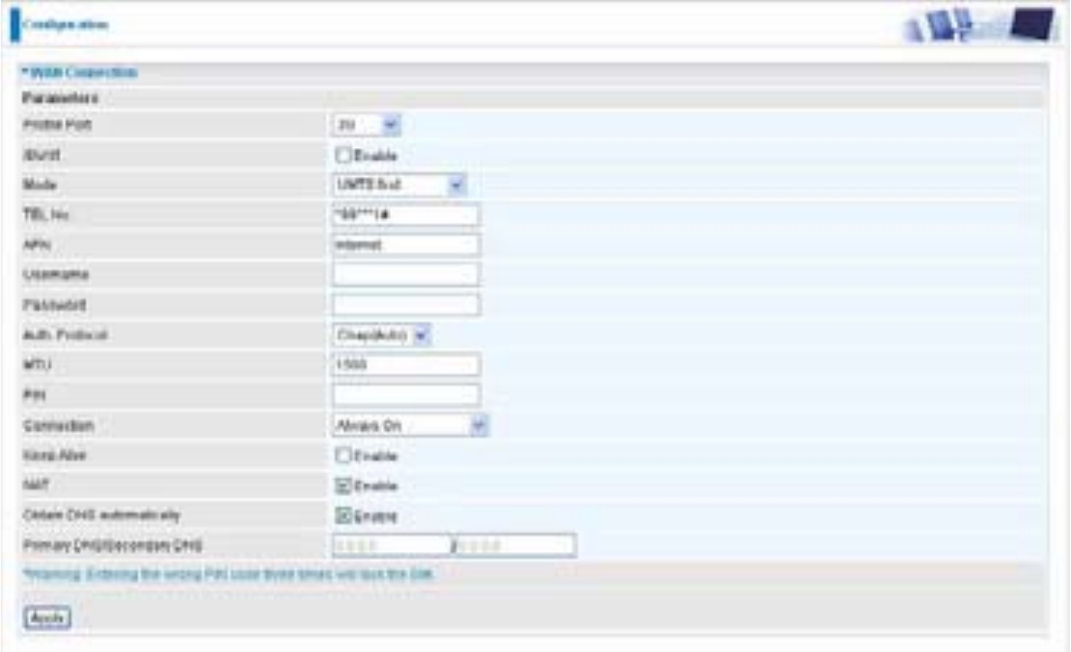
75
3G
Profile mode: select the profile port as 3G
iBurst: check the check box to determine whether to enable the iBurst function.
Mode: select your wanted mode of 3G operation from the drop-down menu.
TEL No.: The dial string to make a GPRS / 3G user internetworking call. It may provide by your
mobile service provider.
APN: An APN is similar to a URL on the WWW, it is what the unit makes a GPRS / UMTS call. The
service provider is able to attach anything to an APN to create a data connection, requirements for
APN’s to be assigned varies between different service providers. Most service providers have an
internet portal which they connect a DHCP Server to, giving you access to the internet i.e. Some
3G operators use the APN ‘internet’ for their portal. The default value of APN is “internet”.
Username: Enter the username provided by your service provider.
Password: Enter the password provided by your service provider.
Authentication Type: Default is None. Manually specify CHAP (Challenge Handshake
Authentication Protocol) or PAP (Password Authentication Protocol) if you know which type
the server is using (when acting as a client), or else the authentication type you want clients
connecting to you to use (when acting as a server). When using PAP, the password is sent
unencrypted, whilst CHAP encrypts the password before sending, and also allows for challenges
at different periods to ensure that an intruder has not replaced the client.
MTU: Maximum Transmission Unit. The size of the largest datagram (excluding media-specific
headers) that IP will attempt to send through the interface.
PIN: PIN stands for Personal Identification Number. A PIN code is a numeric value used in certain
systems as a password to gain access, and authenticate. In mobile phones a PIN code locks the
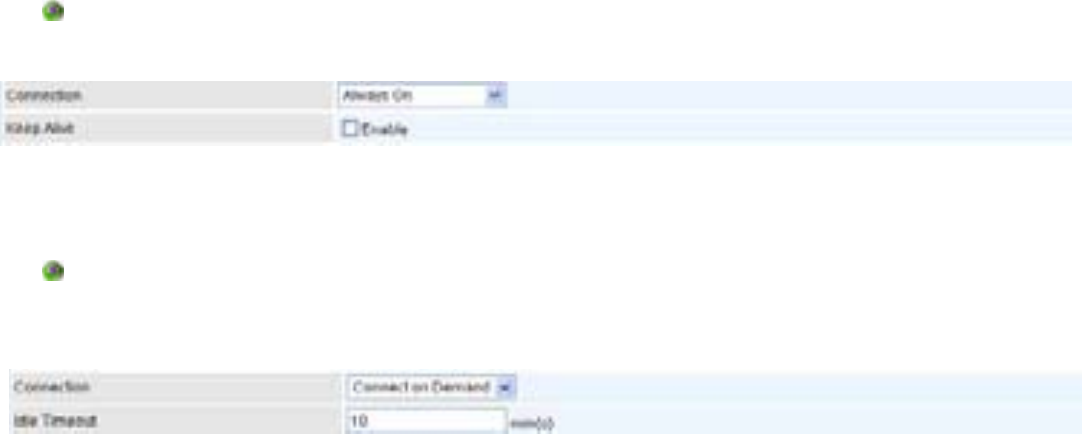
76
SIM card until you enter the correct code. If you enter the PIN code incorrectly into the phone
3 times in a row, then the SIM card will be blocked and you will require a PUK code from your
network/service provider.
Connection: select the connection method you want.
Always On: The router will make UMTS/GPRS call when starting up. Enabling Always On,
will give you an option of Keep Alive.
Keep Alive: Set Enable to allow the router automatically reconnects the connection when
ISP disconnects it.
Connect to Demand: If you want to make UMTS/GPRS call only when there is a packet
requesting access to the Internet (i.e. when a program on your computer attempts to access the
Internet). In this mode, you must set Idle Timeout value at same time. Enabling Connect on
Demand will give you an option of Idle Timeout.
Idle Timeout: Auto-disconnect the connection when there is no activity on this call for a
predetermined period of time. The default value is 10 seconds.
NAT: The NAT (Network Address Translation) feature allows multiple users to access the
Internet through a single IP account, sharing the single IP address. If users on your LAN have
public IP addresses and can access the Internet directly, the NAT function can be disabled.
Obtain DNS: Select Automatic to use DNS.
Primary DNS/ Secondary DNS: Enter the IP addresses of the DNS servers. The DNS servers
are passed to the DHCP clients along with the IP address and the subnet mask.
Note: If you don’t know how to set these values and please keep them untouched.
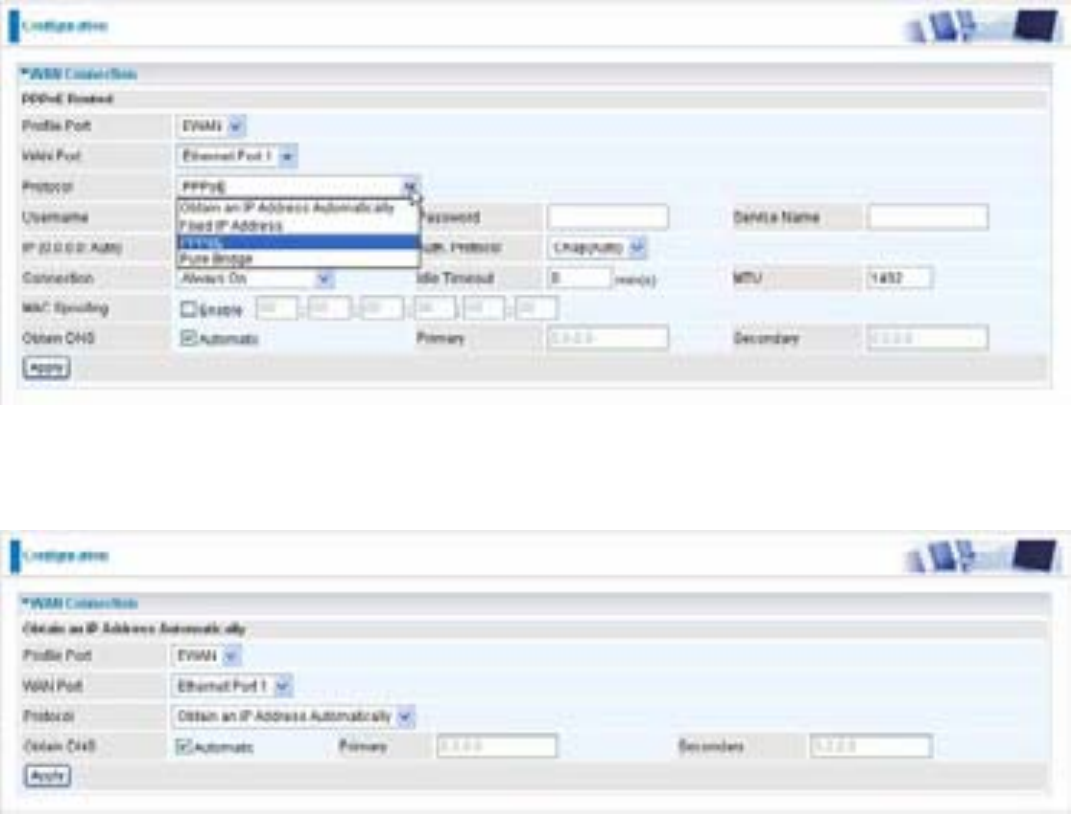
77
EWAN
Obtain an IP Address Automatically
Profile Port: Select the profile port as EWAN.
WAN Port: the router offers its Ethernet port 1 as a WAN port to be used to connect to Cable
Modems and fiber optic lines.
Protocol: Select Obtain an IP Address Automatically.
Obtain DNS: Select Automatic to use DNS.
Primary DNS/ Secondary DNS: Enter the IP addresses of the DNS servers. The DNS servers
are passed to the DHCP clients along with the IP address and the subnet mask.

78
Fixed IP Address
Select this option to set static IP information. You will need to enter the Connection type, IP
address, netmask, and gateway address, provided to you by your ISP. Each IP address entered
in the fields must be in the appropriate IP form, which is four IP octets separated by a dot
(x.x.x.x). The Router will not accept the IP address if it is not in this format.
Profile Port: Select the profile port as EWAN.
WAN Port: the router offers its Ethernet port 1 as a WAN port to be used to connect to Cable
Modems and fiber optic lines.
Protocol: Select Fixed IP Address.
IP: Your WAN IP address. Leave this at 0.0.0.0 to automatically obtain an IP address from your
ISP.
Netmask: The default is 0.0.0.0. User can change it to other such as 255.255.255.0.Type the
netmask assigned to you by your ISP (if given).
Gateway: You must specify a gateway IP address (supplied by your ISP).
Obtain DNS: Select Automatic to use DNS.
Primary DNS/ Secondary DNS: Enter the IP addresses of the DNS servers. The DNS servers
are passed to the DHCP clients along with the IP address and the subnet mask.
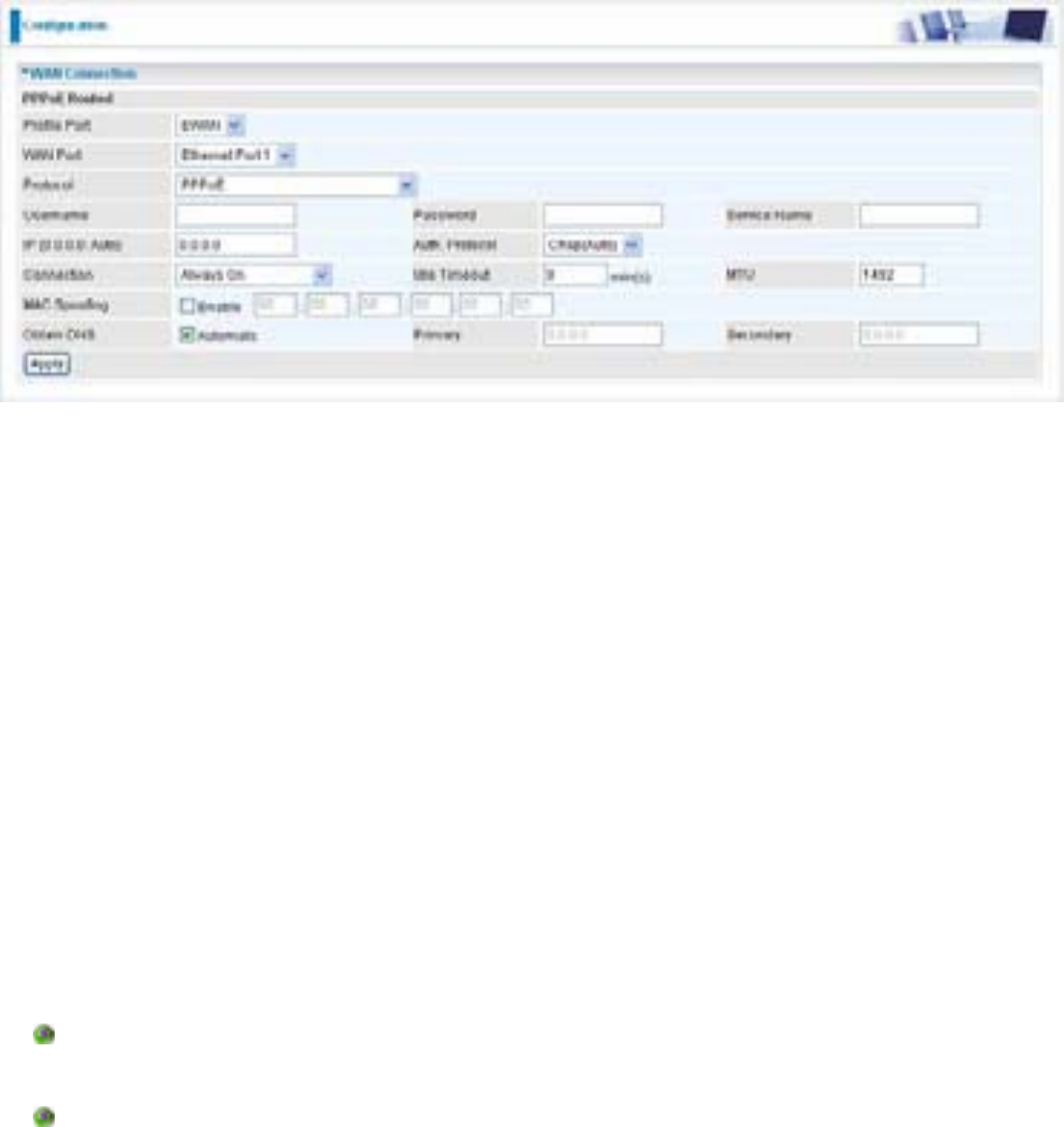
79
PPPoE
PPPoE (PPP over Ethernet) provides access control in a manner which is similar to dial-up
services using PPP.
Profile Port: Select the profile port as EWAN.
WAN Port: the router offers its Ethernet port 1 as a WAN port to be used to connect to Cable
Modems and fiber optic lines.
Protocol: Select PPPoE.
Username: Enter the username provided by your ISP. You can input up to 128 alphanumeric
characters (case sensitive). This is in the format of “username@ispname” instead of simply
“username”.
Password: Enter the password provided by your ISP. You can input up to 128 alphanumeric
characters (case sensitive).
Service Name: Enter a name for this connection.
IP: Your WAN IP address. Leave this at 0.0.0.0 to automatically obtain an IP address from your
ISP.
Auth. Protocol: Default is Auto. Your ISP advises on using Chap or Pap.
Connection:
Always on: If you want the router to establish a PPPoE session when starting up and to
automatically re-establish the PPPoE session when disconnected by the ISP.
Connect on Demand: If you want to establish a PPPoE session only when there is a
packet requesting access to the Internet (i.e. when a program on your computer attempts to
access the Internet).
Idle Timeout: Auto-disconnect the router when there is no activity on the line for a
predetermined period of time.
MTU: Maximum Transmission Unit. The size of the largest datagram (excluding media-specific
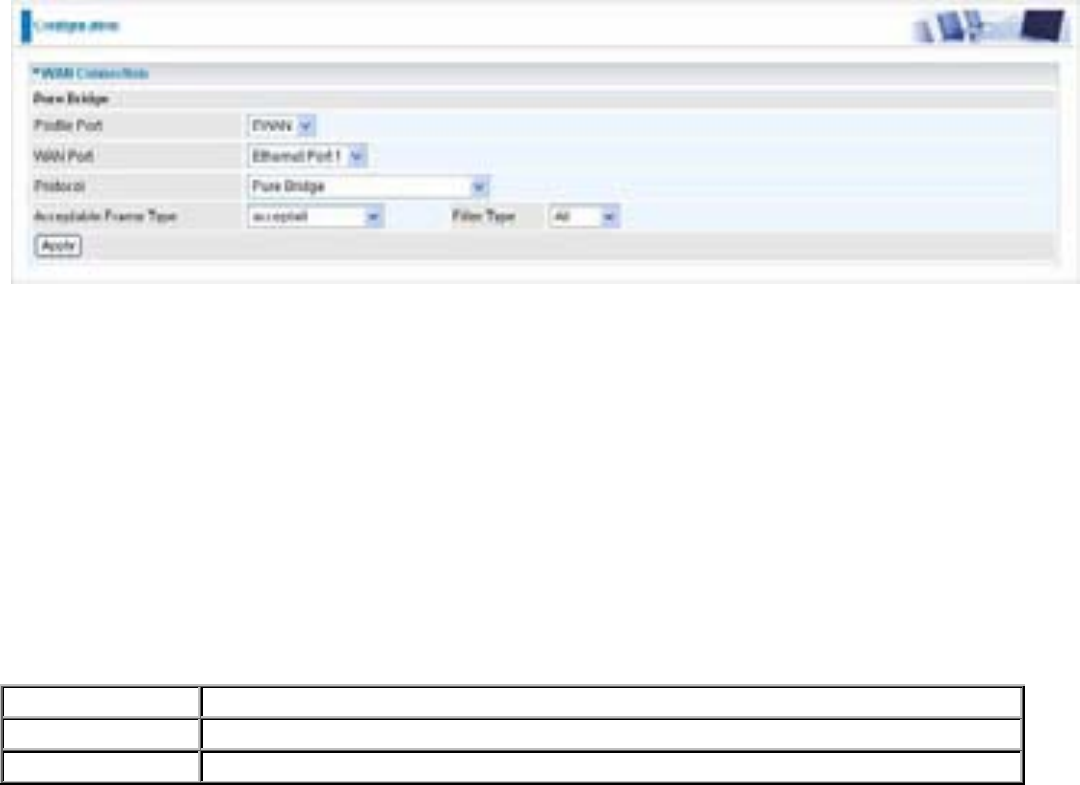
80
headers) that IP will attempt to send through the interface.
MAC Spoofing: Select Enable and enter a MAC address that will temporarily change your
router’s MAC address to the one you have specified in this field. Leave it as Disabled if you do
not wish to change the MAC address of your router.
Obtain DNS: Select Automatic to use DNS.
Primary DNS/ Secondary DNS: Enter the IP addresses of the DNS servers. The DNS servers
are passed to the DHCP clients along with the IP address and the subnet mask
Pure Bridge
Profile Port: Select the profile port as EWAN.
WAN Port: the router offers its Ethernet port 1 as a WAN port to be used to connect to Cable
Modems and fiber optic lines.
Protocol: Select Pure Bridge.
Acceptable Frame Type: Specify which kind of traffic goes through this connection, all traffic or
only VLAN tagged.
Filter Type: Specify the type of Ethernet filtering performed by the named bridge interface.
All Allows all types of ethernet packets through the port.
Ip Allows only IP/ARP types of ethernet packets through the port.
PPPoE Allows only PPPoE types of ethernet packets through the port.
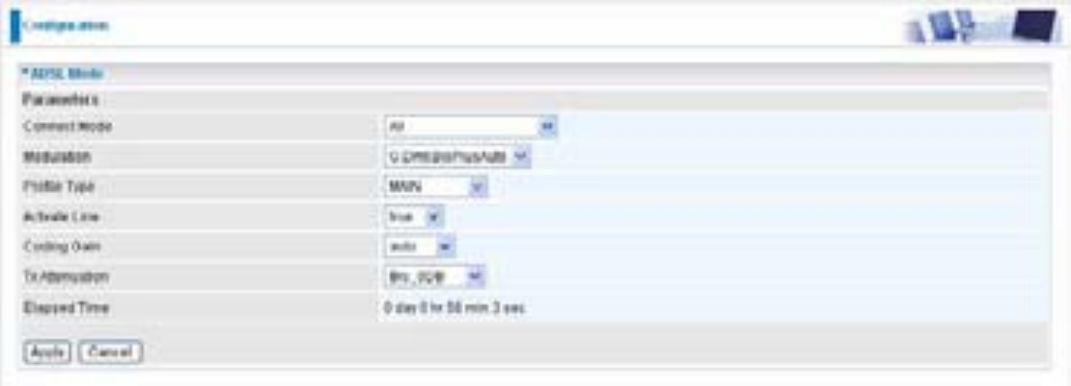
81
ADSL Mode
Connect Mode: This mode will automatically detect your ADSL line code, ADSL2+, ADSL2,
AnnexM2 and AnnexM2+, ADSL, All. Please keep the factory setting unless ADSL is detected as
the symptom of synchronization problem.
Modulation: It will automatically detect capability of your ADSL line mode. Please keep the
factory setting unless ADSL is detected as the symptom of synchronization problem.
Profile Type: Please keep the factory settings unless ADSL is detected as the symptom of low link
rate or unstable problems. You may need to change the profile setting to reach the best ADSL line
rate, it depends on the different DSLAM and location.
Activate Line: Aborting (false) your ADSL line and making it active (true) again for taking effect
with setting of Connect Mode.
Coding Gain: It reduces router’s transmit power which will effect to router’s downstream
performance. Higher the gain will increase the downstream rate but it sometimes causes unstable
ADSL line. The configurable ADSL coding gain is from 0 dB to 7dB, or automatic.
Tx Attenuation: It is the ADSL transmission power that the modem is using. The lower the power
the better performance in router’s upstream. Configurable value is between 0~12.
Elapsed Time: the time since ADSL connection is established.
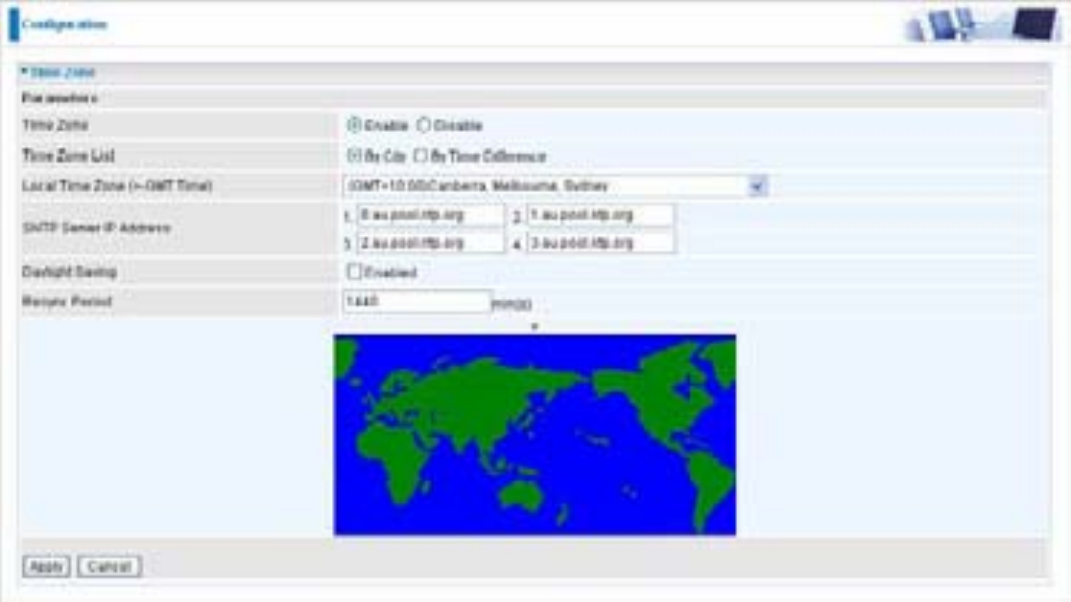
82
System
Here are the items within the System section: Time Zone, Remote Access, Firmware Upgrade,
Backup/Restore, Restart ,User Management and Mail Alert.
Time Zone
The router does not have a real time clock on board; instead, it uses the Simple Network Time
Protocol (SNTP) to get the current time from an SNTP server outside your network. Choose your
local time zone, click Enable and click the Apply button. After a successful connection to the Internet,
the router will retrieve the correct local time from the SNTP server you have specified. If you prefer
to specify an SNTP server other than those in the list, simply enter its IP address as shown above.
Your ISP may provide an SNTP server for you to use.
Daylight Saving is also known as Summer Time Period. Many places in the world adapt it during
summer time to move one hour of daylight from morning to the evening in local standard time. Check
Enable box to set your local time.
Resync Period (in minutes) is the periodic interval the router will wait before it re-synchronizes the
router’s time with that of the specified SNTP server. In order to avoid unnecessarily increasing the
load on your specified SNTP server you should keep the poll interval as high as possible – at the
absolute minimum every few hours or even days.
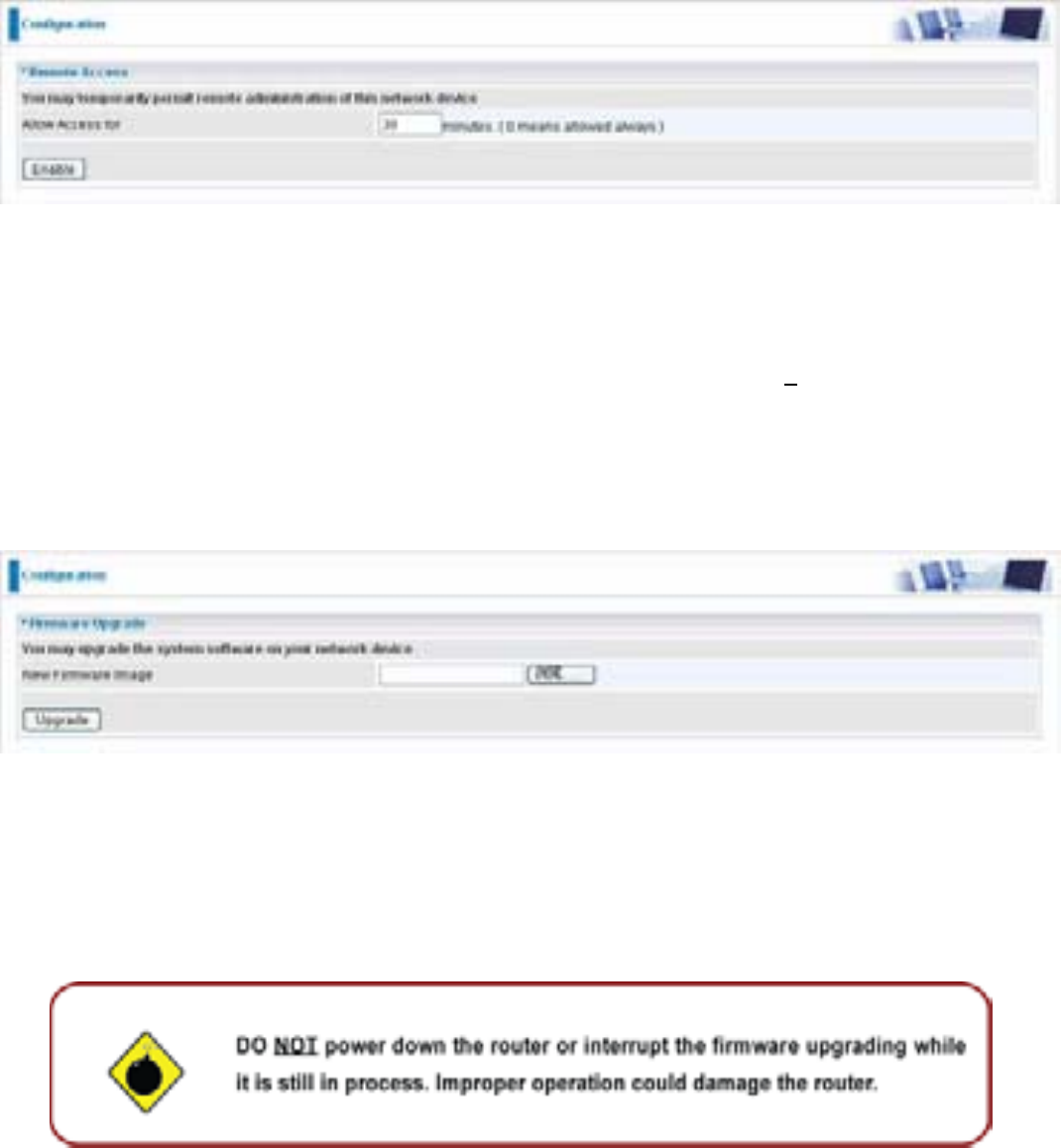
83
Remote Access
To temporarily permit remote administration of the router (i.e. from outside your LAN), select a time
period the router will permit remote access for and click Enable. You may change other configuration
options for the web administration interface using Device Management options in the Advanced
section of the GUI.
If you wish to permanently enable remote access, choose a time period of 0 minute.
Firmware Upgrade
Your router’s “firmware” is the software that allows it to operate and provides all its functionality.
Think of your router as a dedicated computer, and the firmware as the software it runs. Over time
this software may be improved and revised, and your router allows you to upgrade the software it
runs to take advantage of these changes.
Clicking on Browse will allow you to select the new firmware image file you have downloaded to
your PC. Once the correct file is selected, click Upgrade to update the firmware in your router.
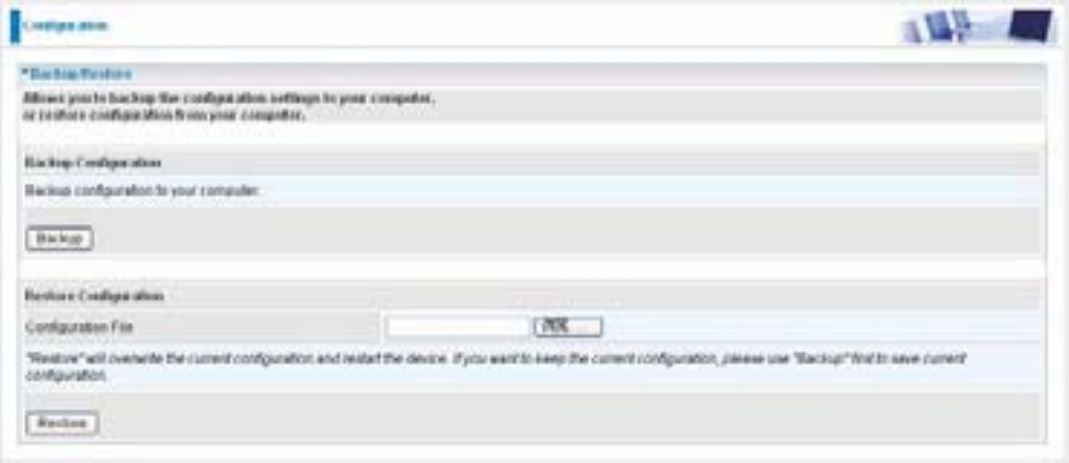
84
Backup / Restore
These functions allow you to save and backup your router’s current settings to a file on your PC, or
to restore a previously saved backup. This is useful if you wish to experiment with different settings,
knowing that you have a backup handy in the case of any mistakes. It is advisable to backup your
router’s settings before making any significant changes to your router’s configuration.
Press Backup to select where on your local PC to save the settings file. You may also change the
name of the file when saving if you wish to keep multiple backups.
Press Browse to select a file from your PC to restore. You should only restore settings files that have
been generated by the Backup function, and that were created when using the current version of the
router’s firmware. Settings files saved to your PC should not be manually edited in any way.
After selecting the settings file you wish to use, pressing Restore will load those settings into the
router.

85
Restart Router
Click Restart with option Current Settings to reboot your router (and restore your last saved
configuration).
If you wish to restart the router using the factory default settings (for example, after a firmware
upgrade or if you have saved an incorrect configuration), select Factory Default Settings to reset to
factory default settings.
You may also reset your router to factory settings by holding the small Reset pinhole button more
than 6 seconds on the back of your router.
Caution: After pressing the RESET button for more than 6 seconds, to be sure you power
cycle the device again.
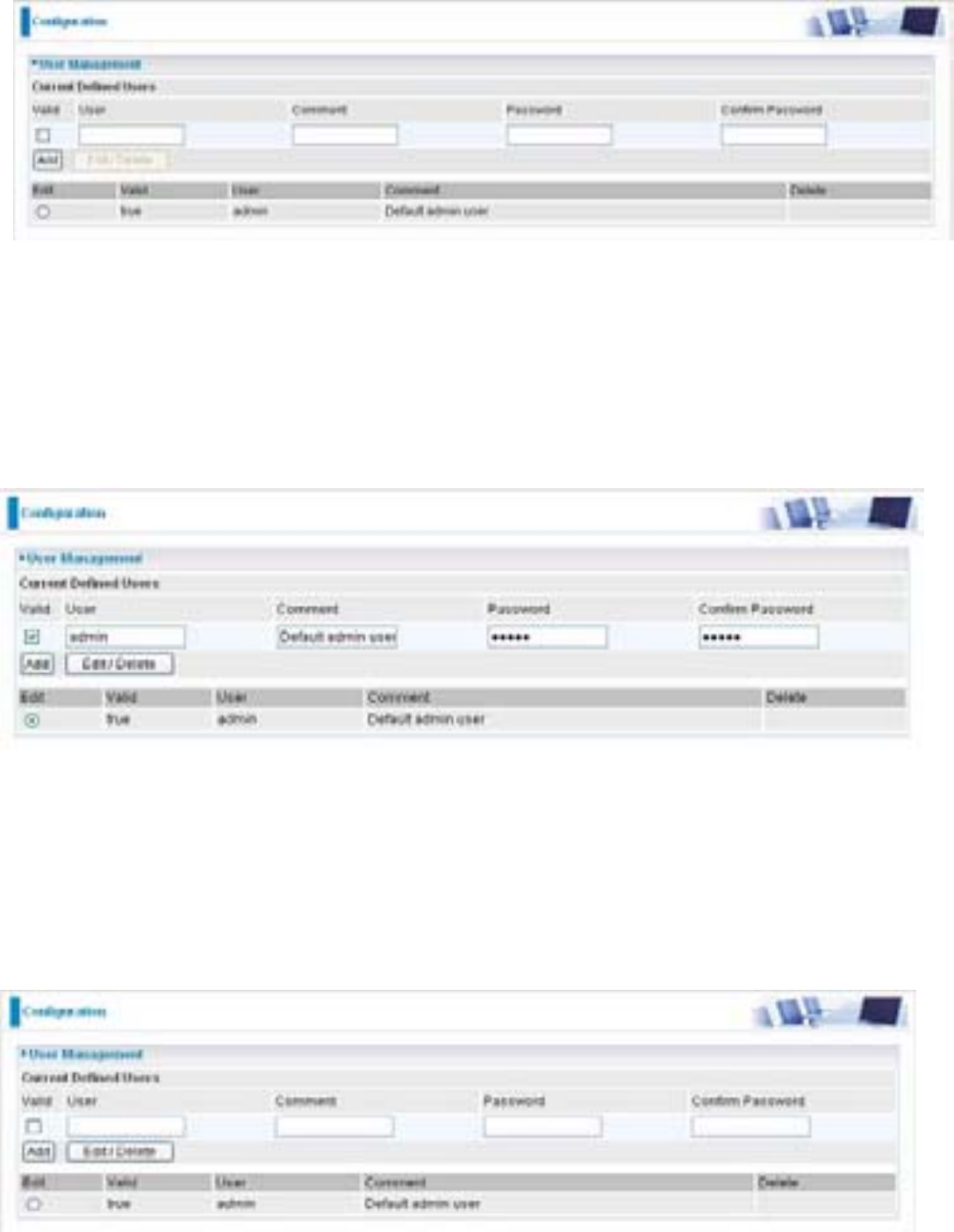
86
User Management
In order to prevent unauthorized access to your router’s configuration interface, it requires all users
to login with a password. You can set up multiple user accounts, each with their own password.
You are able to Edit existing users and Add new users who are able to access the device’s configuration
interface. Once you have clicked on Edit, you are shown the following options:
You can change the user’s password, whether their account is active and valid, as well as add a
comment to each user account. Click Edit/Delete button to save your revise. You cannot delete
the default admin account, if you do you will be log out. However, you can delete any other created
accounts by clicking Delete when editing the user. You are strongly advised to change the password
on the default “admin” account when you receive your router, and any time you reset your configuration
to Factory Defaults.
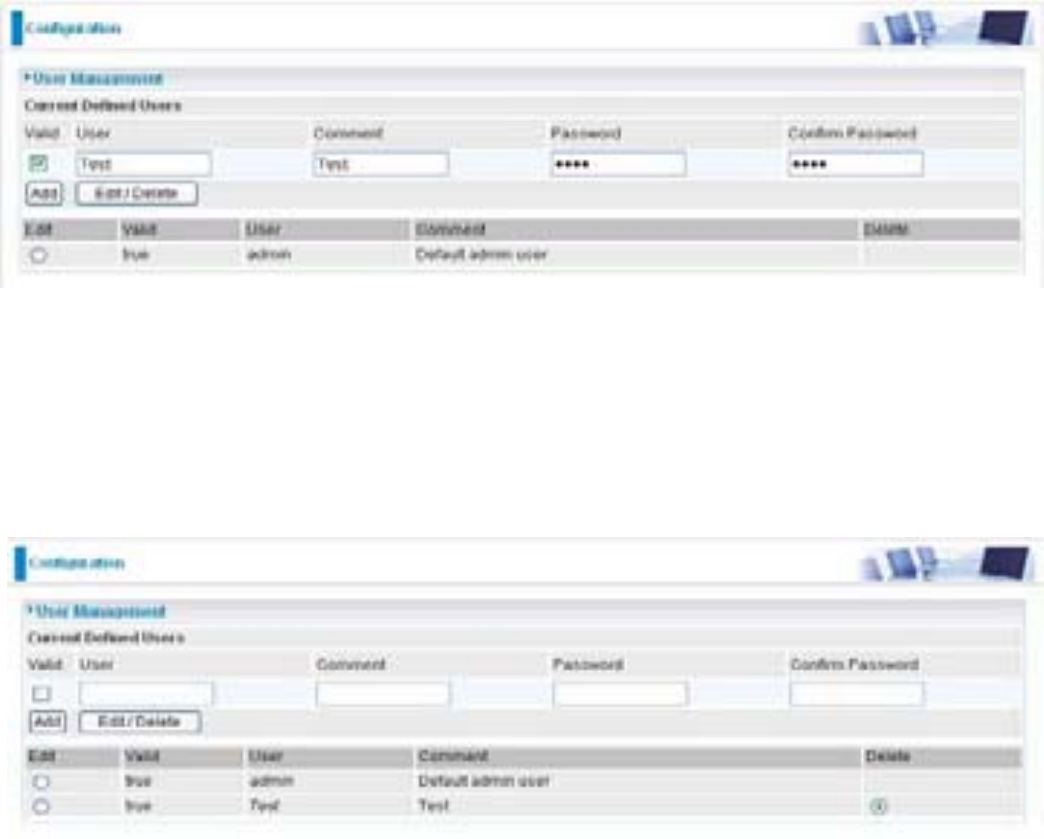
87
When you create a user account, check Valid box and fill in the respective information for User,
Comment, Password and Confirm Password in the blanks provided. Then click the Add button to
add your new user account.
To delete a user account, click on the Delete radio button on the right column of the account you
wish to delete and then click the Edit/Delete button on the top to confirm your deletion.
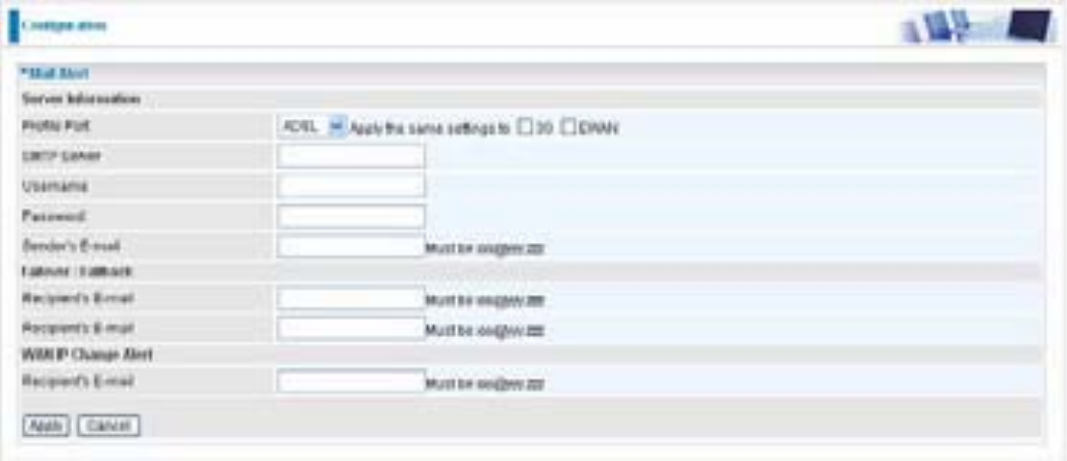
88
Mail Alert
Mail alert is designed to keep system administrator or other relevant personnels alerted of any
unexpected events that might have occured to the network computers or server for monitoring
efficiency. With this alert system, appropriate solutions may be tackled to fix problems that may have
arisen so that the server can be properly maintained.
SMTP Server: Enter the SMTP server that you would like to use for sending emails.
Username: Enter the username of your email account to be used by the SMTP server.
Password: Enter the password of your email account.
Sender’s Email: Enter your email address.
Recipient’s Email (Failover / Failback): Enter the email address that will receive the alert message
once a computer / network server failover occurs.
Recipient’s Email (WAN IP Change Alert): Enter the email address that will receive the alert
message once an WAN IP change has been detected.
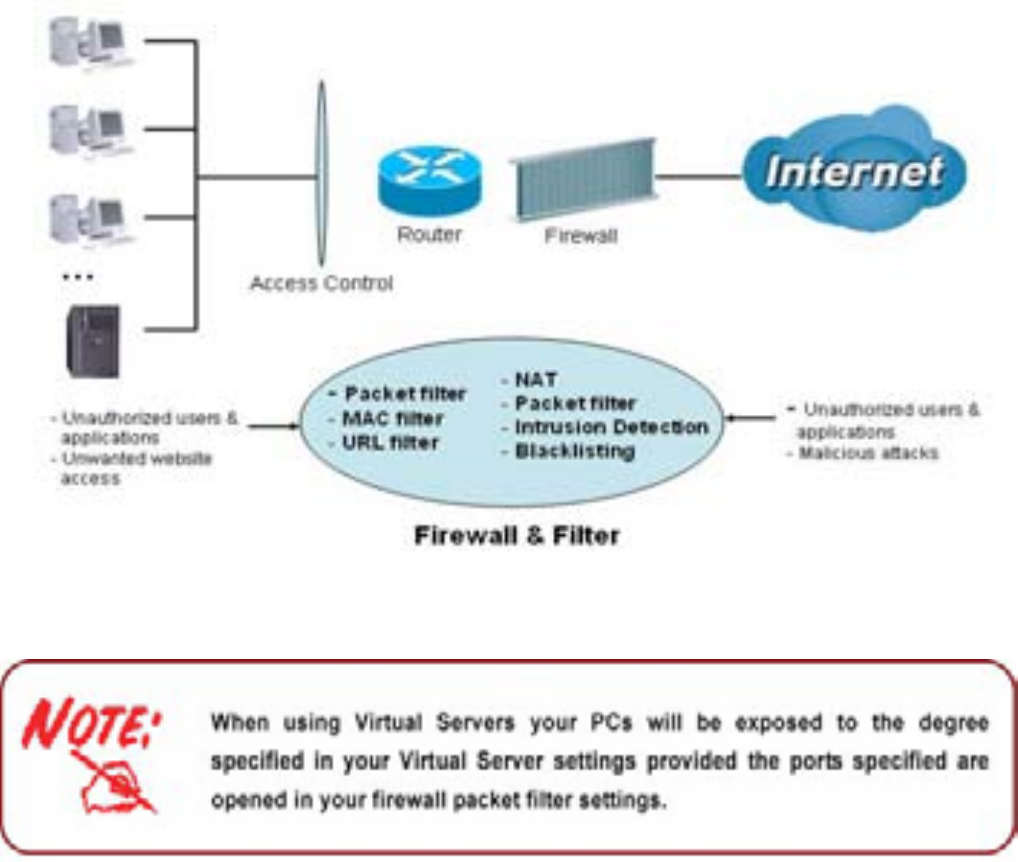
90
Firewall and Access Control
Your router includes a full SPI (Stateful Packet Inspection) firewall for controlling Internet access
from your LAN, as well as helping to prevent attacks from hackers. Besides, when using NAT, the
router acts as a “natural” Internet firewall, as all PCs on your LAN will use private IP addresses
that cannot be directly accessed from the Internet.
Firewall: Prevent outsiders from accessing your local network. The router provides three levels of
security support:
NAT natural firewall: This masks LAN users’ IP addresses which are invisible to users on the
Internet, thus making it more difficult for a hacker to target a machine on your network. This natural
firewall is turned on when NAT function is enabled.
Firewall Security and Policy (General Settings): Inbound direction of Packet Filter rules to
prevent unauthorized computers or applications to access your local network from the Internet.
Intrusion Detection: Enable Intrusion Detection to detect, prevent and log malicious attacks.
Access Control: Prevent access from PCs on your local network:
Firewall Security and Policy (General Settings): Outbound direction of Packet Filter rules to
prevent unauthorized computers or applications from accessing the Internet.
URL Filter: To block PCs on your local network from unwanted websites.
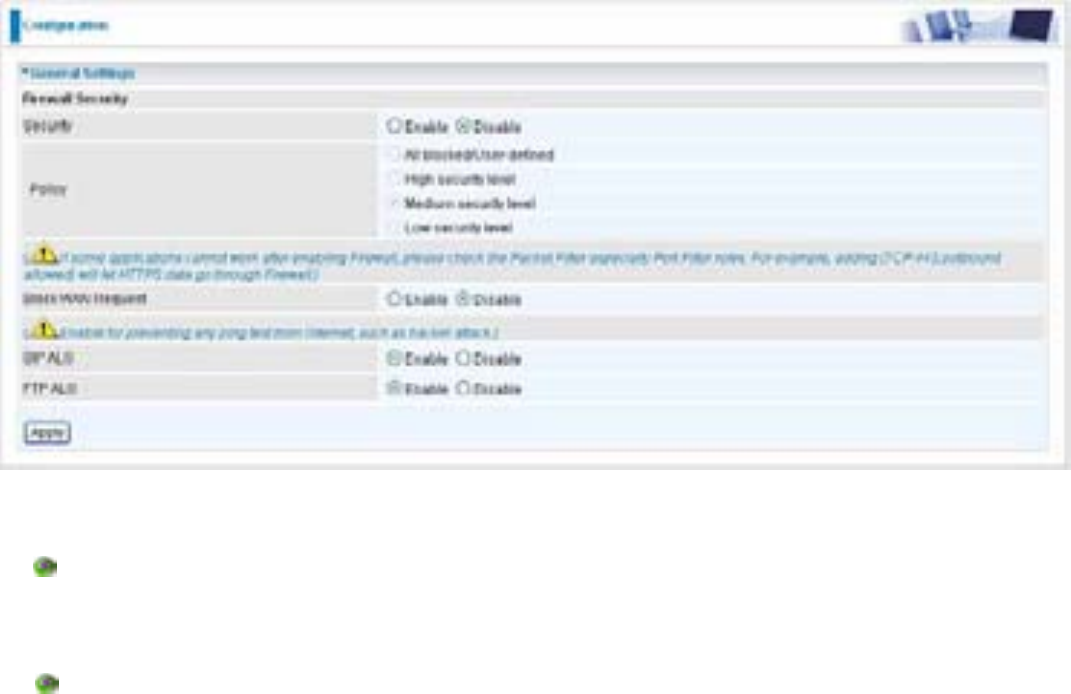
91
Listed are the items under the Firewall section: General Settings, Packet Filter, Intrusion Detection,
URL Filter, IM/P2P Blocking and Firewall Log.
General Settings
You can choose not to enable Firewall and still able to access to URL Filter and IM/P2P Blocking or
enable the Firewall using preset filter rules and modify the port filter rules as required. The Packet
Filter is used to filter packets based-on Applications (Port) or IP addresses.
There are four options when you enable the Firewall, they are:
All blocked/User-defined: no pre-defined port or address filter rules by default, meaning that
all inbound (Internet to LAN) and outbound (LAN to Internet) packets will be blocked. Users
have to add their own filter rules for further access to the Internet.
High/Medium/Low security level: the predefined port filter rules for High, Medium and Low
security are displayed in Port Filters of Packet Filter.
Select either High, Medium or Low security level to enable the Firewall. The only difference between
these three security levels is the preset port filter rules in the Packet Filter. Firewall functionality is
the same for all levels; it is only the list of preset port filters that changes between each setting. For
more detailed on level of preset port filter information, refer to Table 1: Predefined Port Filter.
If you choose of the preset security levels and add custom filters, this level of filter rules will be saved
even and do not need to re-configure the rules again if you disable or switch to other firewall level.
The “Block WAN Request” is a stand-alone function and not relate to whether security enable or
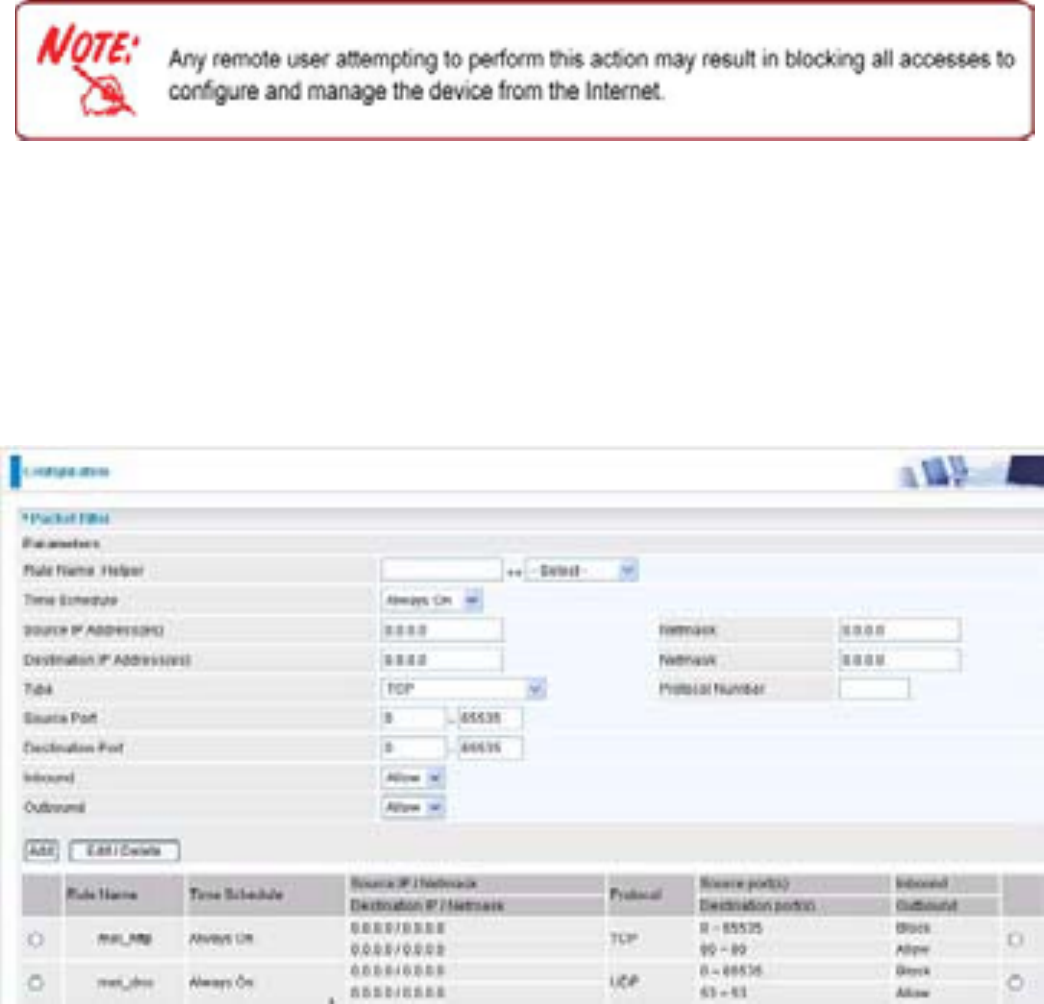
92
disable. Mostly it is for preventing any scan tools from WAN site by hacker.
Packet Filter
This function is only available when the Firewall is enabled and one of these four security levels is
chosen (All blocked, High, Medium and Low). The preset port filter rules in the Packet Filter must
modify accordingly to the level of Firewall, which is selected. See Table1: Predefined Port Filter for
more detail information.

93
Example: Predefined Port Filters Rules
The predefined port filter rules for High, Medium and Low security levels are listed. See Table 1.
Note: Firewall – All Blocked/User-defined, you must define and create the port filter rules
yourself. No predefined rule is being preconfigured.
Port
Number Firewall - Low Firewall - Medium Firewall – High
Table 1:
Predefined
Port Filter
Application
Protocol
Start End Inbound Outbound Inbound Outbound Inbound Outbound
HTTP(80) TCP(6) 80 80 NO YES NO YES NO YES
DNS (53) UDP(17) 53 53 NO YES NO YES NO YES
DNS (53) TCP(6) 53 53 NO YES NO YES NO YES
FTP(21) TCP(6) 21 21 NO YES NO YES NO NO
Telnet(23) TCP(6) 23 23 NO YES NO YES NO NO
SMTP(25) TCP(6) 25 25 NO YES NO YES NO YES
POP3(110) TCP(6) 110 110 NO YES NO YES NO YES
NEWS(NNTP)
(Network
News Transfer
Protocol)
TCP(6) 119 119 NO YES NO YES NO NO
RealAudio/
RealVideo
(7070)
UDP(17) 7070 7070 YES YES YES YES NO NO
PING ICMP(1) N/A N/A NO YES NO YES NO YES
H.323(1720) TCP(6) 1720 1720 YES YES NO YES NO NO
T.120(1503) TCP(6) 1503 1503 YES YES NO YES NO NO
SSH(22) TCP(6) 22 22 NO YES NO YES NO NO
NTP /SNTP UDP(17) 123 123 NO YES NO YES NO YES
HTTP/HTTP
Proxy (8080) TCP(6) 8080 8080 NO YES NO NO NO NO
HTTPS(443) TCP(6) 443 443 NO YES NO YES N/A N/A
ICQ (5190) TCP(6) 5190 5190 YES YES N/A N/A N/A N/A
MSN (1863) TCP(6) 1863 1863 YES YES N/A N/A N/A N/A
MSN (7001) UDP(17) 7001 7001 YES YES N/A N/A N/A N/A
MSN VEDIO
(9000) TCP(6) 9000 9000 NO YES N/A N/A N/A N/A
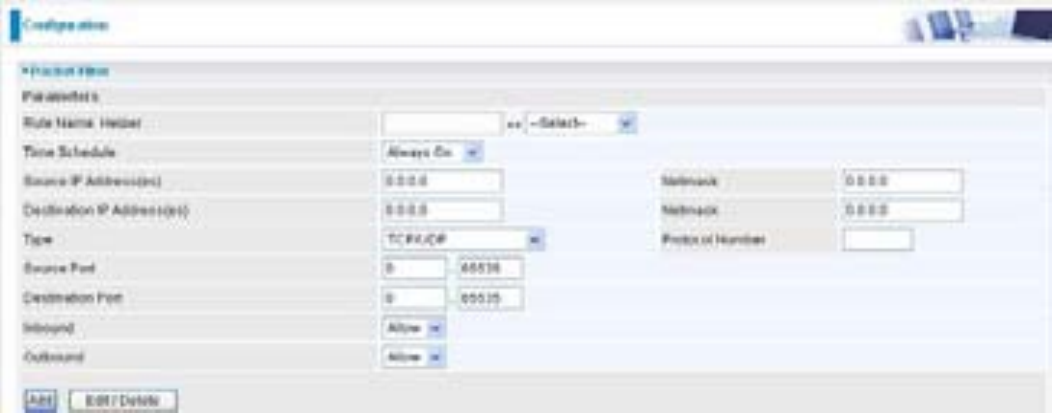
94
Inbound: Internet to LAN
Outbound: LAN to Internet
YES: Allowed
NO: Blocked
N/A: Not Applicable
Packet Filter – Add TCP/UDP Filter
Rule Name Helper: Users-define description to identify this entry or click “Select” drop-down
menu to select existing predefined rules. The maximum name length is 32 characters.
Time Schedule: It is self-defined time period. You may specify a time schedule for your
prioritization policy. For setup and detail, refer to Time Schedule section
Source IP Address(es) / Destination IP Address(es): This is the Address-Filter used to allow or
block traffic to/from particular IP address(es). Selecting the Subnet Mask of the IP address range
you wish to allow/block the traffic to or form; set IP address and Subnet Mask to 0.0.0.0 to inactive
the Address-Filter rule.
Tip: To block access, to/from a single IP address, enter that IP address as the Host IP Address
and use a Host Subnet Mask of “255.255.255.255”.
Type: It is the packet protocol type used by the application, select TCP, UDP or both TCP/UDP.
Protocol Number: Insert the port number.
Source Port: This Port or Port Ranges defines the port allowed to be used by the Remote/WAN to
connect to the application. Default is set from range 0 ~ 65535. It is recommended that this option
be configured by an advanced user.
Destination Port: This is the Port or Port Ranges that defines the application.
Inbound / Outbound: Select Allow or Block the access to the Internet (“Outbound”) or from the
Internet (“Inbound”).
Click Add button to apply your changes.
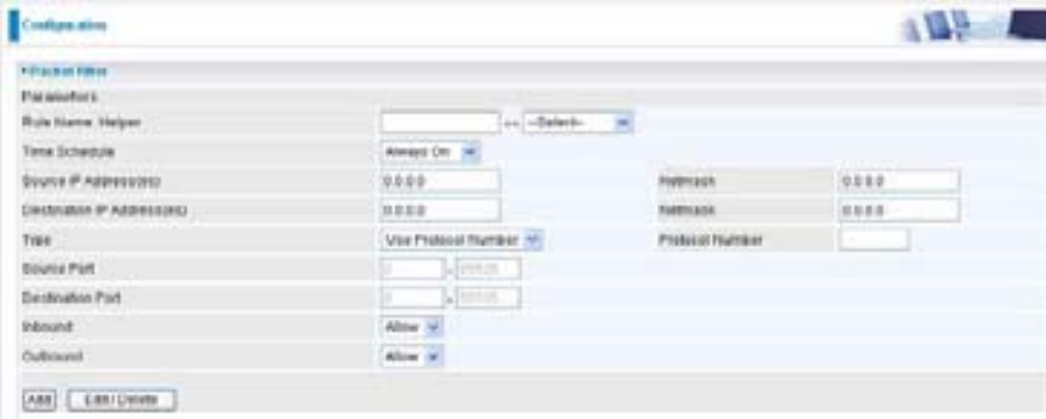
95
Packet Filter – Add Raw IP Filter
Go to “Type” drop-down menu, select “Use Protocol Number”.
Rule Name Helper: Users-define description to identify this entry or choosing “Select” drop-down
menu to select existing predefined rules.
Time Schedule: It is self-defined time period. You may specify a time schedule for your
prioritization policy. For setup and detail, refer to Time Schedule section
Source IP Address(es) / Destination IP Address(es): This is the Address-Filter used to allow or
block traffic to/from particular IP address(es). Selecting the Subnet Mask of the IP address range
you wish to allow/block the traffic to or form; set IP address and Subnet Mask to 0.0.0.0 to inactive
the Address-Filter rule.
Tip: To block access, to/from a single IP address, enter that IP address as the Host IP
Address and use a Host Subnet Mask of “255.255.255.255”.
Type: It is the packet protocol type used by the application, select TCP, UDP or both TCP/UDP.
Protocol Number: Insert the port number, i.e. GRE 47.
Source Port: This Port or Port Ranges defines the port allowed to be used by the Remote/WAN to
connect to the application. Default is set from range 0 ~ 65535. It is recommended that this option
be configured by an advanced user.
Destination Port: This is the Port or Port Ranges that defines the application.
Inbound / Outbound: Select Allow or Block the access to the Internet (“Outbound”) or from the
Internet (“Inbound”).
Click the Add button to apply your changes.
Example: Configuring your firewall to allow a publicly accessible web server on your LAN
The predefined port filter rule for HTTP (TCP port 80) is the same no matter whether the firewall is
set to a high, medium or low security level. To setup a web server located on the local network when
the firewall is enabled, you have to configure the Port Filters setting for HTTP.
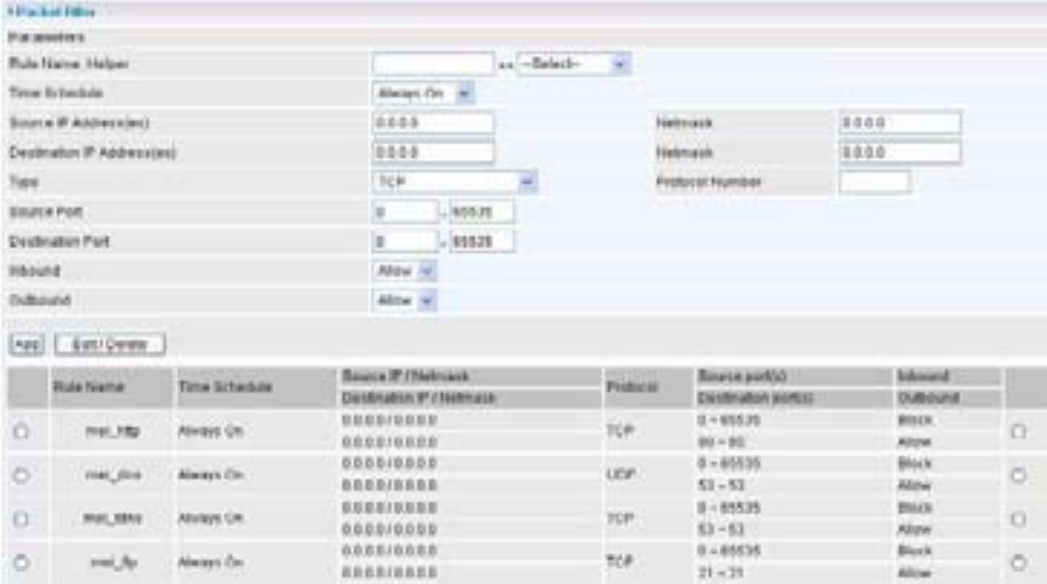
96
As you can see from the diagram below, when the firewall is enabled with one of the three presets
(Low/Medium/High), inbound HTTP access is not allowed which means remote access through
HTTP to your router is not allowed.
Note: Inbound indicates accessing from Internet to LAN and Outbound is from LAN to the
Internet.
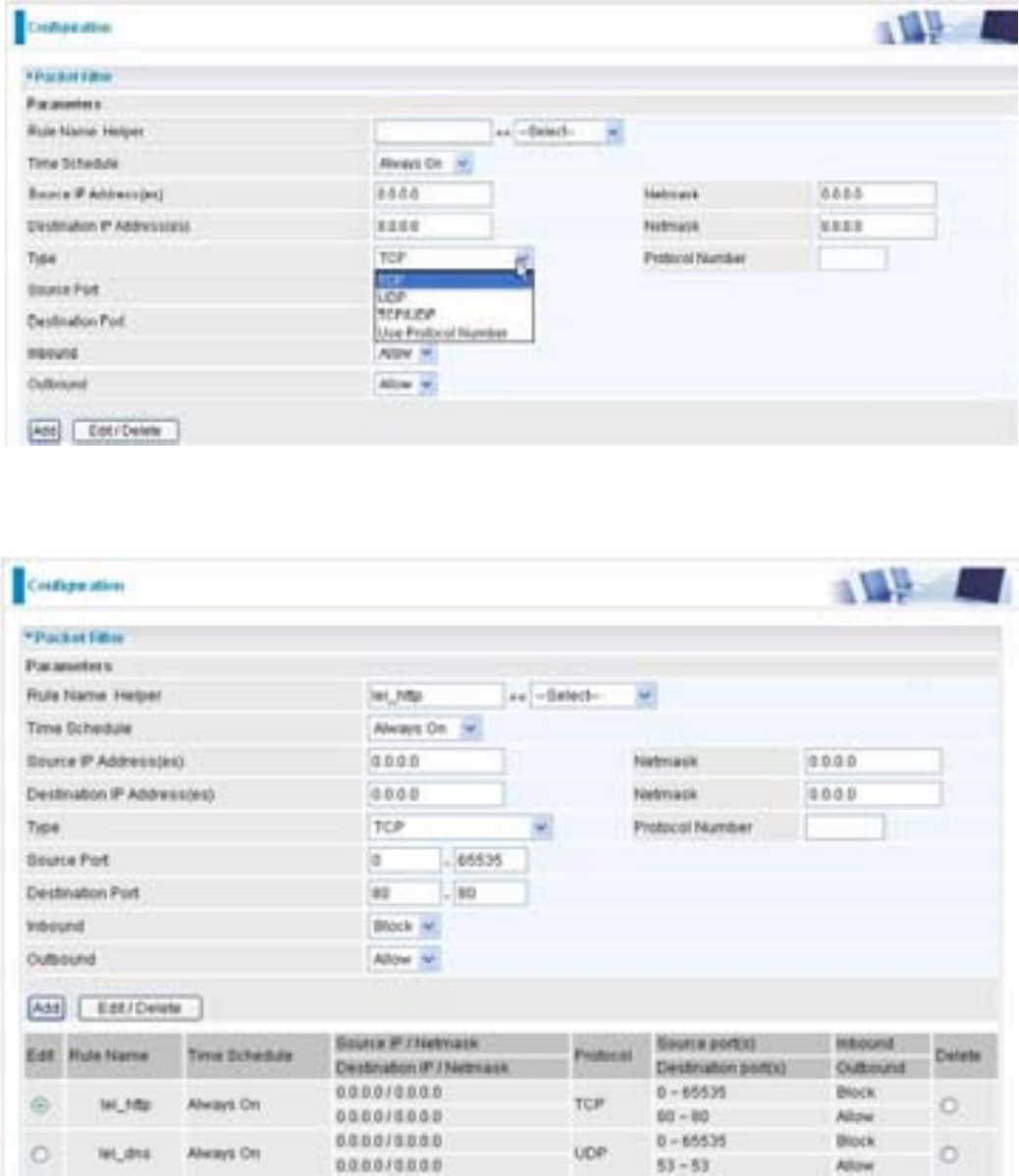
97
Configuring Packet Filter:
1. Click Packet Filters. You will then be presented with the predefined port filter rules screen (in
this case for the low security level), shown below:
Note: You may click Edit the predefined rule instead of Delete it. This is an example to show
to how you add a filter on your own.
2. Choose the radio button you want to delete the existing HTTP rule. Click Edit/Delete button to
delete the existing HTTP rule.
3. Input the Rule Name, Time Schedule, Source/Destination IP, Type, Source/Destination Port,
Inbound and Outbound.
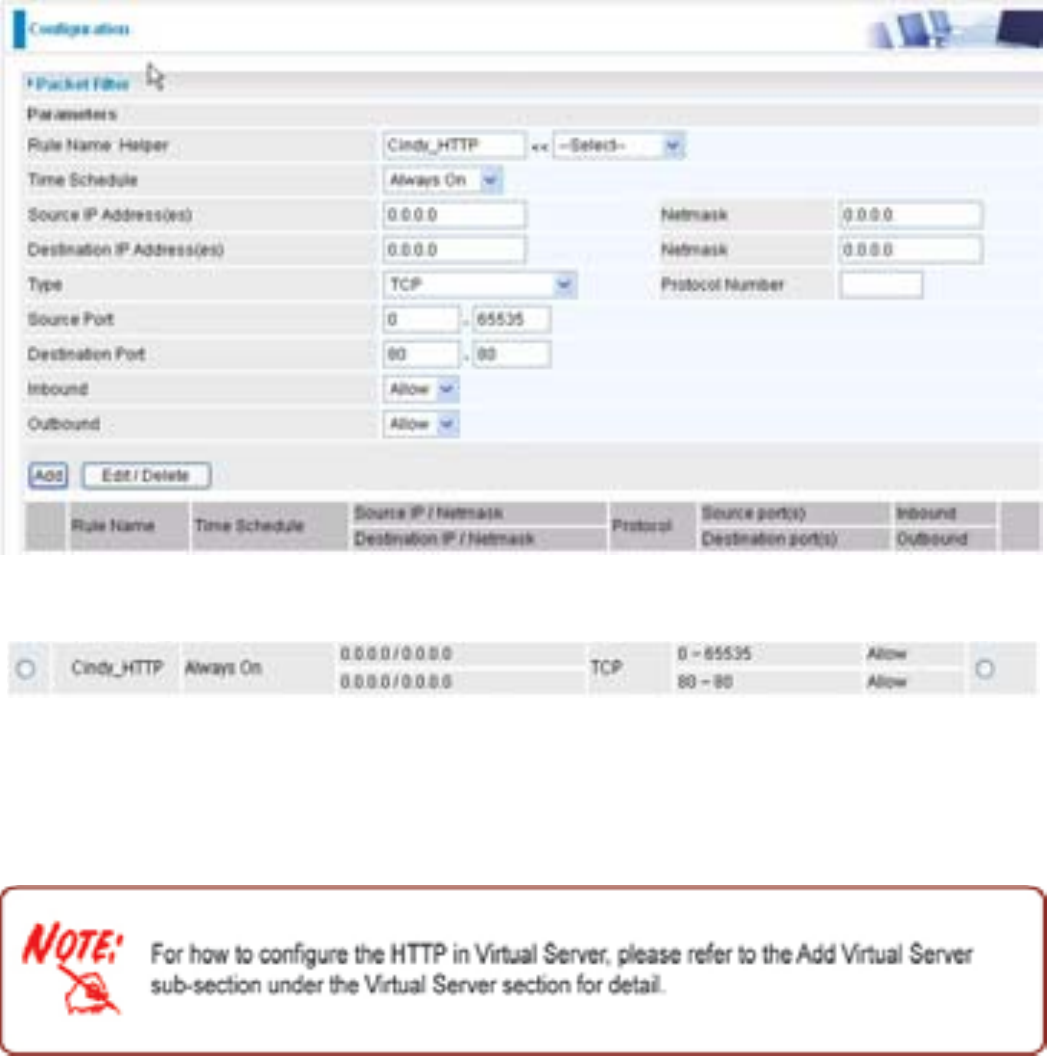
98
Example:
Application: Cindy_HTTP
Time Schedule: Always
On
Source / Destination IP Address(es): 0.0.0.0 (I do not wish to active the address-filter, instead
I
use the port-filter)
Type: TCP (Please refer to Table1: Predefined Port Filter)
Source Port: 0-65535 (I allow all ports to connect with the application))
Redirect Port: 80-80 (This is Port defined for HTTP)
Inbound / Outbound: Allow
1. The new port filter rule for HTTP is shown below:
2. Configure your Virtual Server (“port forwarding”) settings so that incoming HTTP requests
on
port 80 will be forwarded to the PC running your web server:
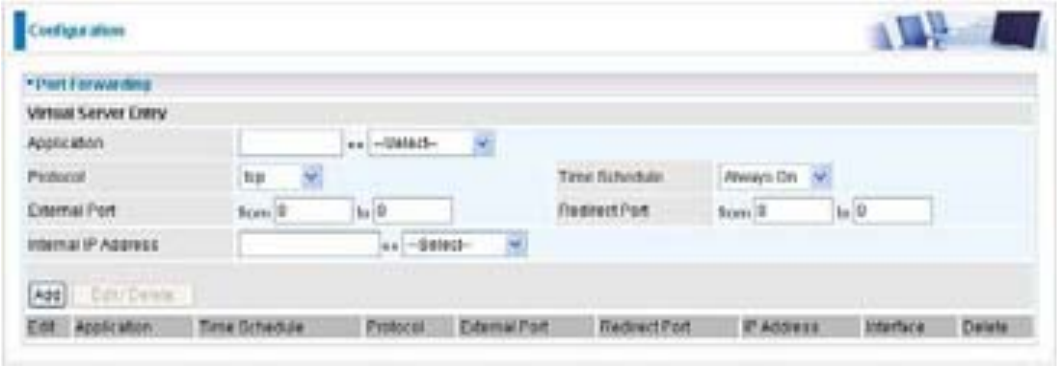
99
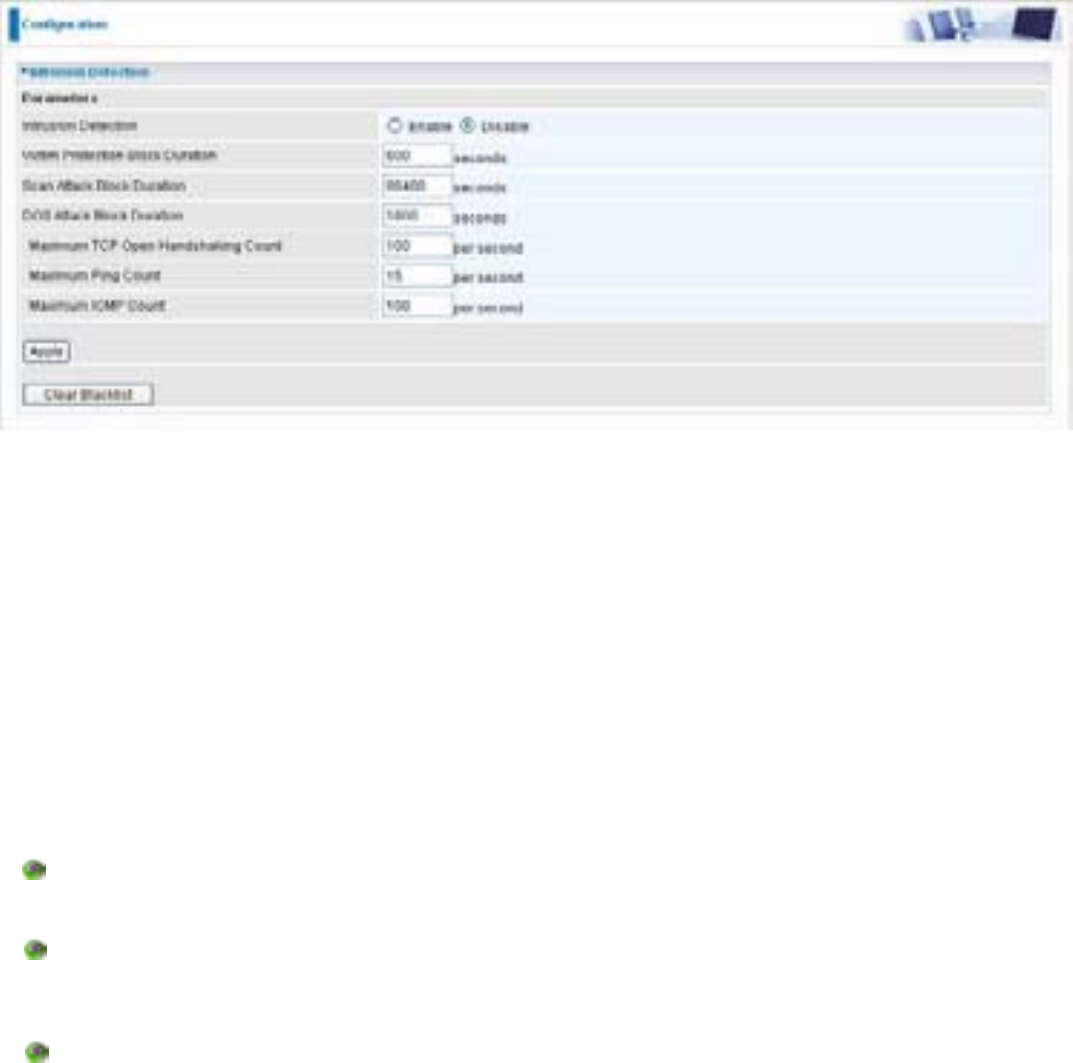
100
Intrusion Detection
The router’s Intrusion Detection System (IDS) is used to detect hacker attacks and intrusion
attempts from the Internet. If the IDS function of the firewall is enabled, inbound packets are
filtered and blocked depending on whether they are detected as possible hacker attacks,
intrusion attempts or other connections that the router determines to be suspicious.
Blacklist: If the router detects a possible attack, the source IP or destination IP address will
be added to the Blacklist. Any further attempts using this IP address will be blocked for the
time period specified as the Block Duration. The default setting for this function is false
(disabled). Some attack types are denied immediately without using the Blacklist function,
such as Land attack and Echo/CharGen scan.
Intrusion Detection: If enabled, IDS will block Smurf attack attempts. Default is false.
Block Duration:
Victim Protection Block Duration: This is the duration for blocking Smurf attacks.
Default value is 600 seconds.
Scan Attack Block Duration: This is the duration for blocking hosts that attempt a
possible Scan attack. Scan attack types include X’mas scan, IMAP SYN/FIN scan and
similar attempts. Default value is 86400 seconds.
DoS Attack Block Duration: This is the duration for blocking hosts that attempt a
possible Denial of Service (DoS) attack. Possible DoS attacks this attempts to block
include Ascend Kill and WinNuke. Default value is 1800 seconds.
Max TCP Open Handshaking Count: This is a threshold value to decide whether a SYN Flood
attempt is occurring or not. Default value is 100 TCP SYN per seconds.
Max PING Count: This is a threshold value to decide whether an ICMP Echo Storm is
occurring or not. Default value is 15 ICMP Echo Requests (PING) per second.
Max ICMP Count: This is a threshold to decide whether an ICMP flood is occurring or not.
Default
value is 100 ICMP packets per seconds except ICMP Echo Requests (PING).
For SYN Flood, ICMP Echo Storm and ICMP flood, IDS will just warn the user in the Event Log.
It cannot protect against such attacks.

101
Table 2: Hacker attack types recognized by the IDS
Intrusion Name Detect Parameter Blacklis
t
T
ype of Bloc
k
Duration
Drop
Packet Show Log
Ascend Kill Ascend Kill data Src IP DoS Yes Yes
WinNuke
TCP Port
135,
137~139, Flag:
URG
Src IP DoS Yes Yes
Smurf
ICMP type 8
Des IP is
broadcast
Dst IP Victim
Protection Yes Yes
Land attack SrcIP = DstIP Yes Yes
Echo/CharGen
Scan
UDP Echo Port and
CharGen Port Yes Yes
Echo Scan UDP Dst Port =
Echo(7) Src IP Scan Yes Yes
CharGen Scan UDP Dst Port =
CharGen(19) Src IP Scan Yes Yes
X’mas Tree Scan TCP Flag: X’mas Src IP Scan Yes Yes
IMAP
SYN/FIN Scan
TCP Flag: SYN/
FIN DstPort:
IMAP(143)
SrcPort: 0 or
65535
Src IP Scan Yes Yes
SYN/FIN/RST/ACK
Scan
TCP,
No Existing session
A
nd Scan Hosts more
than five.
Src IP Scan Yes Yes
Net Bus Scan
TCP
No Existing
session
DstPort = Net Bus
12345,12346,
3456
SrcIP Scan Yes Yes
Back Orifice Scan
UDP, DstPort
= Orifice Port
(31337)
SrcIP Scan Yes Yes
SYN Flood
Max TCP Open
Handshaking
Count (Default
100 c/sec)
Yes
ICMP Flood
Max ICMP
Count (Default
100 c/ sec)
Yes
ICMP Echo
Max PING Count
(Default 15 c/sec)
Yes

102
ICMP Flood
Max ICMP Count
(Default 100 c/
sec)
Yes
ICMP Echo Max PING Count
(Default 15 c/sec)
Yes
Src IP: Source IP
Src Port: Source Port
Dst Port: Destination Port
Dst IP: Destination IP
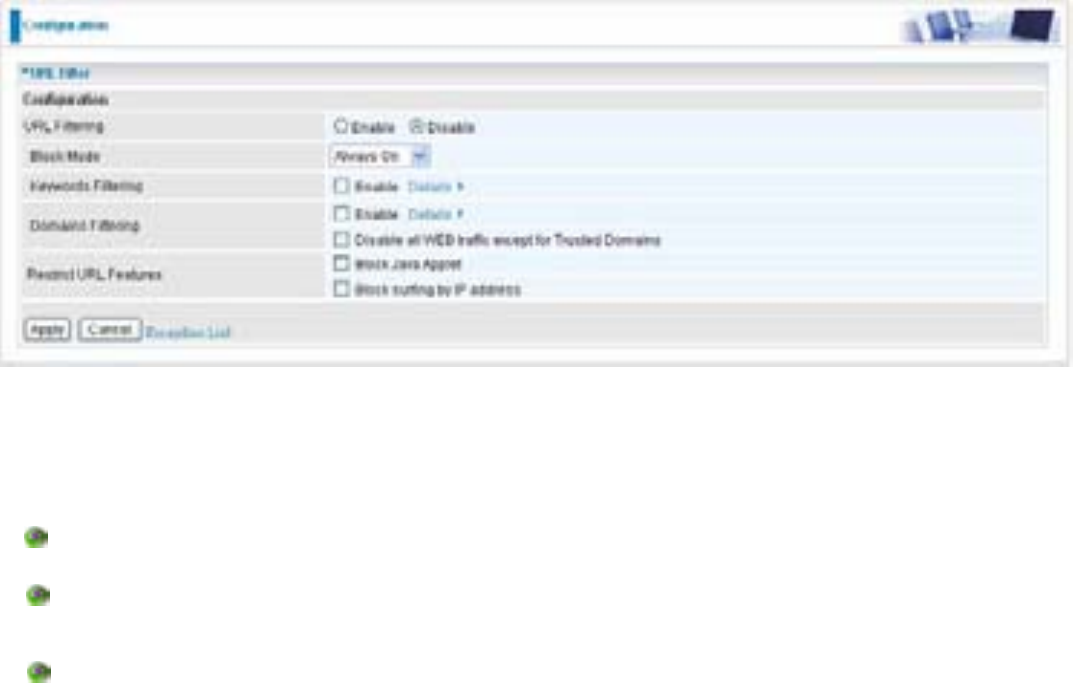
103
URL Filter
URL (Uniform Resource Locator – e.g. an address in the form of http://www.abcde.com or http://
www.example.com) filter rules allow you to prevent users on your network from accessing particular
websites by their URL. There are no pre-defined URL filter rules; you can add filter rules to meet
your requirements.
Enable/Disable: To enable or disable URL Filter feature.
Block Mode: A list of the modes that you can choose to check the URL filter rules. The default is
set to Always On.
Disabled: No action will be performed by the Block Mode.
Always On: Action is enabled. URL filter rules will be monitoring and checking at all hours of
the day.
TimeSlot1 ~ TimeSlot16: It is self-defined time period. You may specify the time period
to check the URL filter rules, i.e. during working hours. For setup and detail, refer to Time
Schedule section.
Keywords Filtering: Allows blocking by specific keywords within a particular URL rather than having
to specify a complete URL (e.g. to block any image called “advertisement.gif”). When enabled, your
specified keywords list will be checked to see if any keywords are present in URLs accessed to
determine if the connection attempt should be blocked. Please note that the URL filter blocks web
browser (HTTP) connection attempts using port 80 only.
For example, if the URL is http://www.abc.com/abcde.html, it will be dropped as the keyword
“abcde” occurs in the URL.
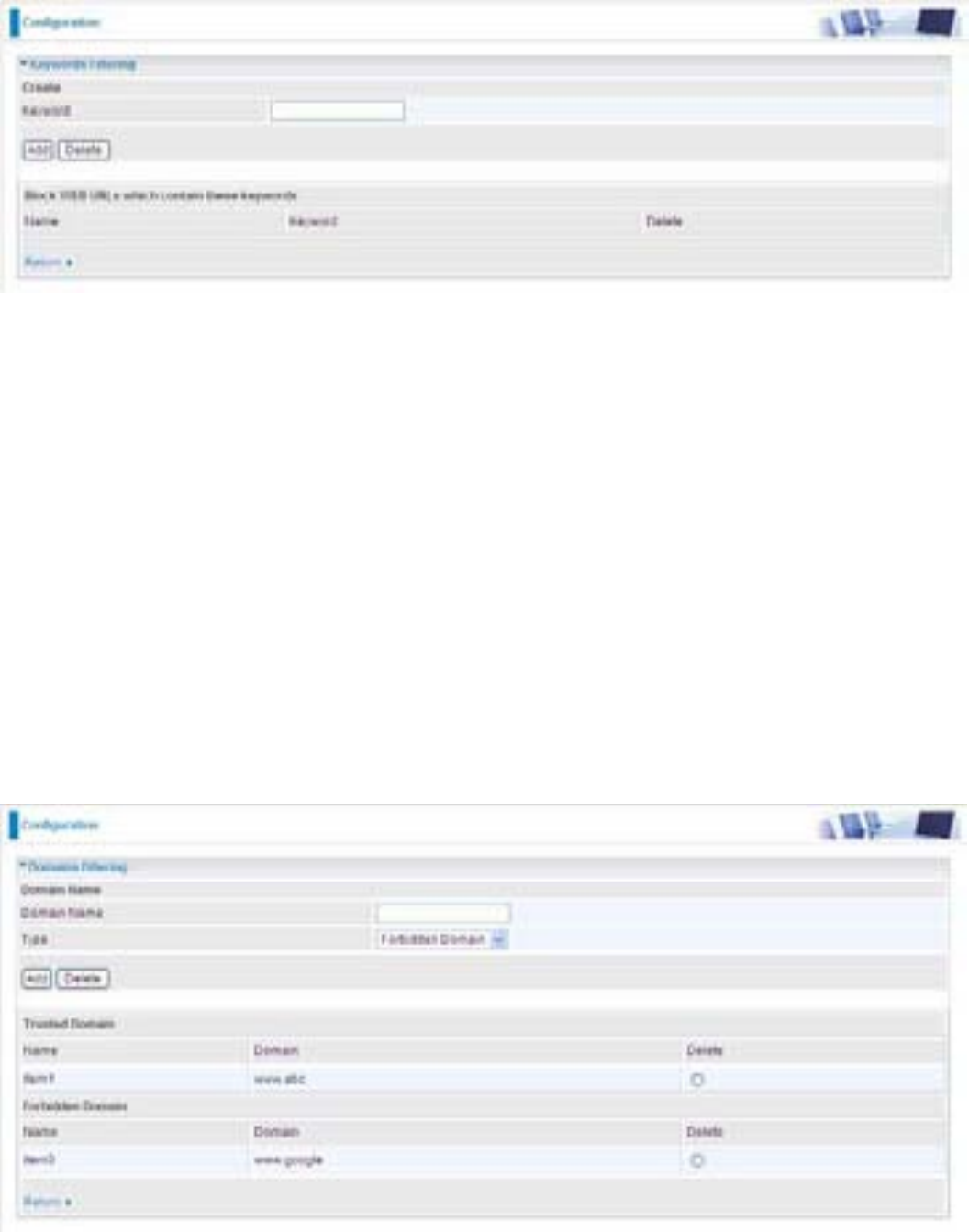
104
Domains Filtering: This function checks the whole URL not the IP address, in URLs accessed
against your list of domains to block or allow. If it is matched, the URL request will be sent (Trusted)
or dropped (Forbidden). For this function to be activated, both check-boxes must be checked. Here
is the checking procedure:
1. Check the domain in the URL to determine if it is in the trusted list. If yes, the connection attempt
is sent to the remote web server.
2. If not, check if it is listed in the forbidden list. If yes, then the connection attempt will be
dropped.
3. If the packet does not match either of the above two items, it is sent to the remote web server.
4. Please be note that the completed URL, “www” + domain name shall be specified. For example
to block traffic to www.google.com.au, enter “www.google” or “www.google.com”
In the example below, the URL request for www.abc.com will be sent to the remote web server
because it is listed in the trusted list, whilst the URL request for www.google or www.google.com
will be dropped, because www.google is in the forbidden list.

105
Example:
Andy wishes to disable all WEB traffic except for ones listed in the trusted domain, which would
prevent Bobby from accessing other web sites. Andy selects both functions in the Domain Filtering
and thinks that it will stop Bobby. But Bobby knows this function, Domain Filtering, ONLY disables
all WEB traffic except for Trusted Domain, BUT not its IP address. If this is the situation, Block
surfing by IP address function can be handy and helpful to Andy. Now, Andy can prevent Bobby
from accessing other sites.
Restrict URL Features: This function enhances the restriction to your URL rules.
Block Java Applet: This function can block Web content that includes the Java Applet. It is
to prevent someone who wants to damage your system via standard HTTP protocol.
Block surfing by IP address: Preventing someone who uses the IP address as URL for skip-
ping Domains Filtering function. Activates only and if Domain Filtering enabled.
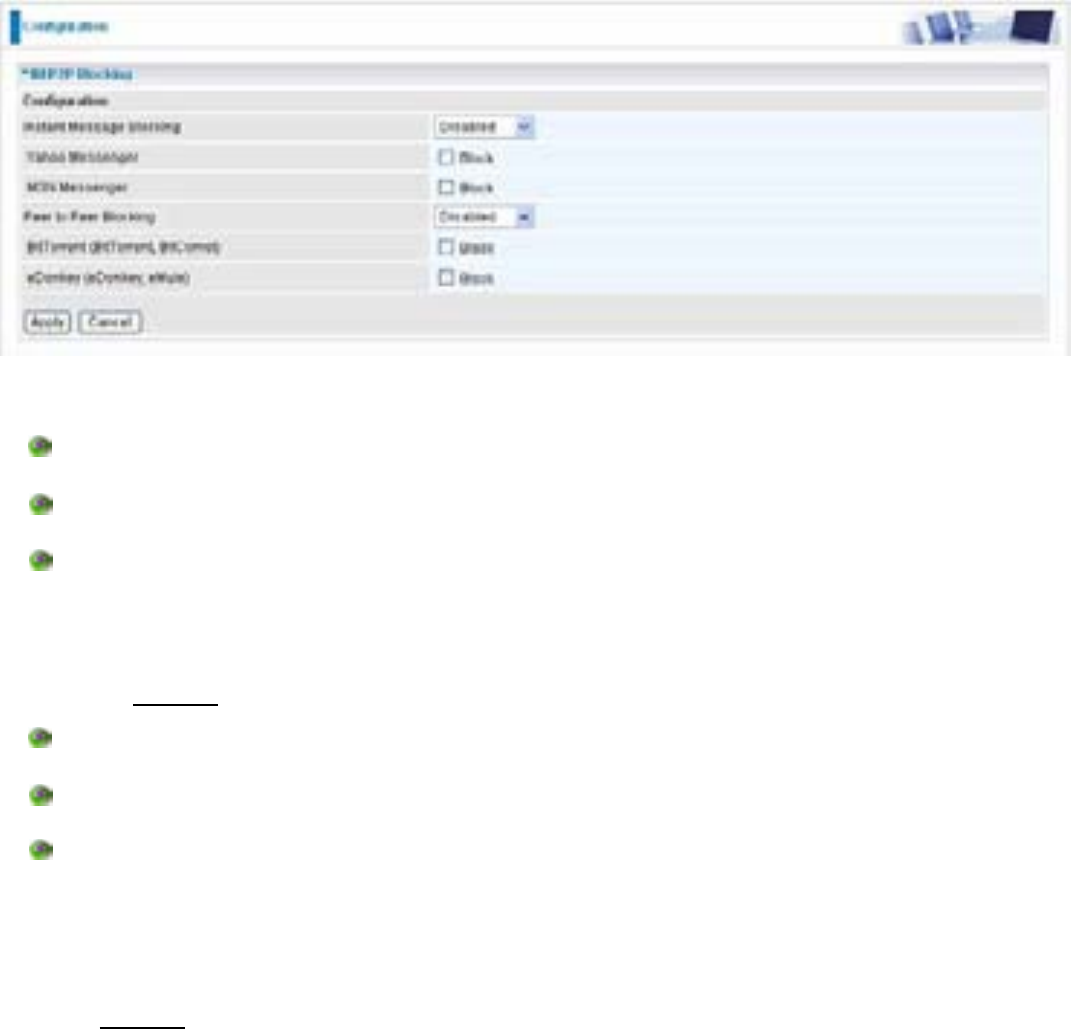
106
IM / P2P Blocking
IM, short for Instant Message, is required to use client program software that allows users to
communicate, in exchanging text message, with other IM users in real time over the Internet. A
P2P application, known as Peer-to-peer, is group of computer users who share file to specific
groups of people across the Internet. Both Instant Message and Peer-to-peer applications make
communication faster and easier but your network can become increasingly insecure at the same
time. Billion’s IM and P2P blocking helps users to restrict LAN PCs to access to the commonly used
IM, Yahoo and MSN, and P2P, BitTorrent and eDonkey, applications over the Internet.
Instant Message Blocking: The default is set to Disabled.
Disabled: Instant Message blocking is not triggered. No action will be performed.
Always On: Action is enabled.
TimeSlot1 ~ TimeSlot16: This is the self-defined time period. You may specify the time
period to trigger the blocking, i.e. during working hours. For setup and detail, refer to Time
Schedule section.
Yahoo/MSN Messenger: Check the box to block either or both Yahoo or/and MSN Messenger. To
be sure you enabled the Instant Message Blocking first.
Peer to Peer Blocking: The default is set to Disabled.
Disabled: Instant Message blocking is not triggered. No action will be performed.
Always On: Action is enabled.
TimeSlot1 ~ TimeSlot16: This is the self-defined time period. You may specify the time period to
trigger the blocking, i.e. during working hours. For setup and detail, refer to Time Schedule section.
BitTorrent / eDonkey: Check the box to block either or both Bit Torrent or/and eDonkey. To be
sure you enabled the Peer to Peer Blocking first.

107
Firewall Log
Firewall Log display log information of any unexpected action with your firewall settings.
Check the Enable box to activate the logs.
Log information can be seen in the Status – Event Log after enabling.
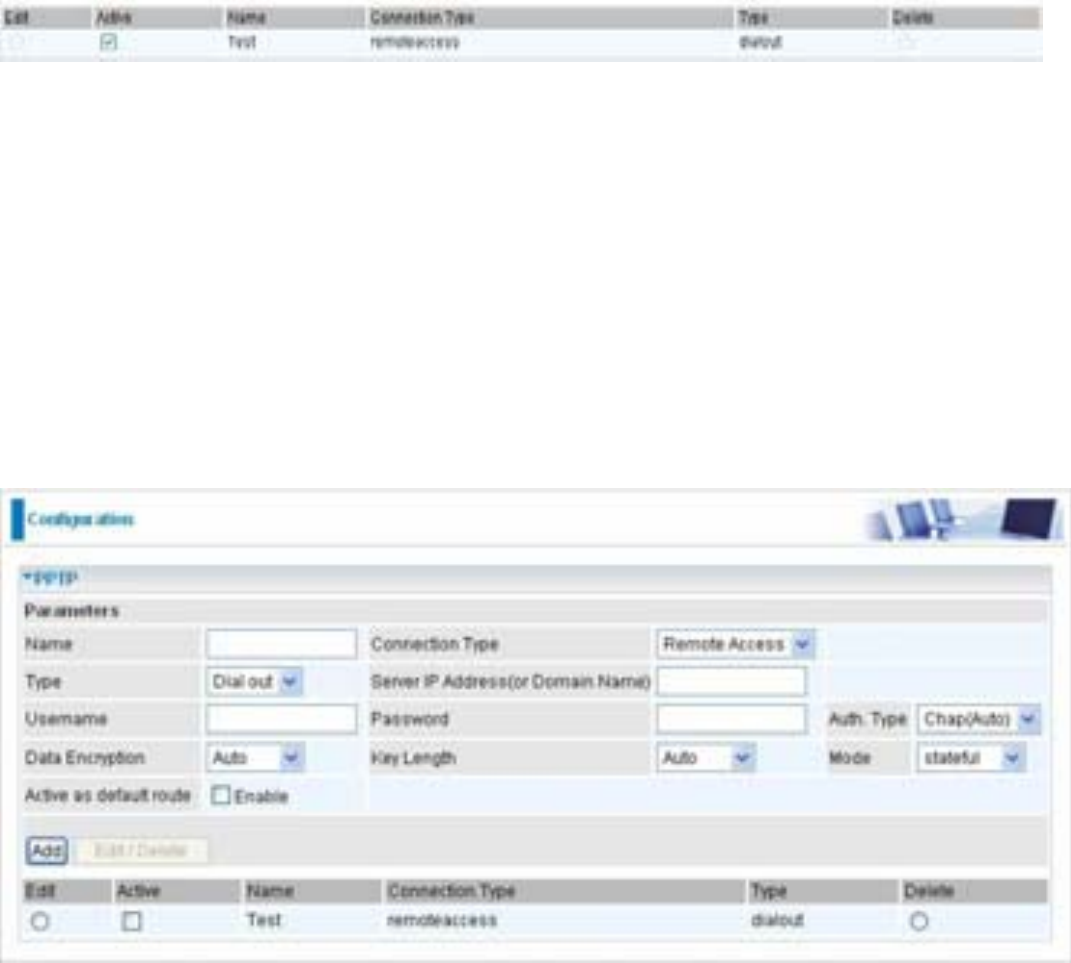
108
VPN - Virtual Private Networks
Virtual Private Networks is ways to establish secured communication tunnels to an organization’s
network via the Internet. Your router supports three main types of VPN (Virtual Private Network):
PPTP, IPSec and L2TP.
PPTP (Point-to-Point Tunneling Protocol)
There are two types of PPTP VPN supported; Remote Access and LAN-to-LAN (please refer
below for more information). Click Configuration/VPN/PPTP.
Name: A given name for the connection.
Active: This function activates or deactivates the PPTP connection. Check Active checkbox if you
want the protocol of tunnel to be activated and vice versa.
Note: When the Active checkbox is checked, the function of Edit and Delete will not be
available.
Connection Type: It informs your PPTP tunnel connection condition.
Type: This refers to your router operates as a client or a server, Dialout or Dialin respectively.
PPTP Connection - Remote Access
Name: A given name for the connection (e.g. “connection to office”).
Connection Type: Remote Access or LAN to LAN.
Type: Check Dial Out if you want your router to operate as a client (connecting to a remote
VPNserver, e.g. your office server), check Dial In operates as a VPN server.
When configuring your router as a Client, enter the remote Server IP Address (or Domain Name)
you wish to connect to.
When configuring your router as a server, enter the Private IP Address assigned to the Dial in
109
User.
Sever IP Address(or Domain Name):Enter the Server IP Adress or Domain Name.
Username: If you are a Dial-Out user (client), enter the username provided by your Host. If you
are a Dial-In user (server), enter your own username.
Password: If you are a Dial-Out user (client), enter the password provided by your Host. If you are
a Dial-In user (server), enter your own password.
Authentication Type: Default is Auto if you want the router to determine the authentication type
to use, or else manually specify CHAP (Challenge Handshake Authentication Protocol) or PAP
(Password Authentication Protocol) if you know which type the server is using (when acting as a
client), or else the authentication type you want clients connecting to you to use (when acting as a
server). When using PAP, the password is sent unencrypted, whilst CHAP encrypts the password
before sending, and also allows for challenges at different periods to ensure that an intruder has
not replaced the client.
Data Encryption: Data sent over the VPN connection can be encrypted by an MPPE algorithm.
Default is Auto, so that this setting is negotiated when establishing a connection, or else you can
manually Enable or Disable encryption.
Key Length: The data can be encrypted by MPPE algorithm with 40 bits or 128 bits. Default is
Auto, it is negotiated when establishing a connection. 128 bit keys provide stronger encryption
than 40 bit keys.
Mode: You may select Stateful or Stateless mode. The key will be changed every 256 packets
when you select Stateful mode. If you select Stateless mode, the key will be changed in each
packet.
Active as default route: Commonly used by the Dial-out connection which all packets will route
through the VPN tunnel to the Internet; therefore, active the function may degrade the Internet
performance.
Active: This function activates or deactivates the PPTP connection. Check Active checkbox if you
want the protocol of tunnel to be activated and vice versa.
Note: When the Active checkbox is checked, the function of Edit and Delete will not be
available.
Click Edit/Delete button to save your changes.
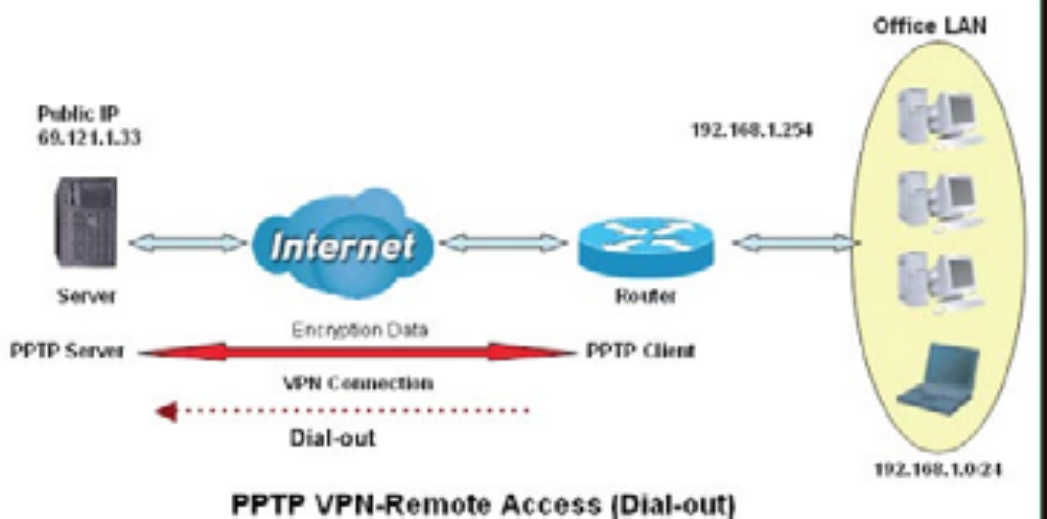
110
Example: Configuring a Remote Access PPTP VPN Dial-out Connection
A company’s office establishes a PPTP VPN connection with a file server located at a separate
location. The router is installed in the office, connected to a couple of PCs and Servers.
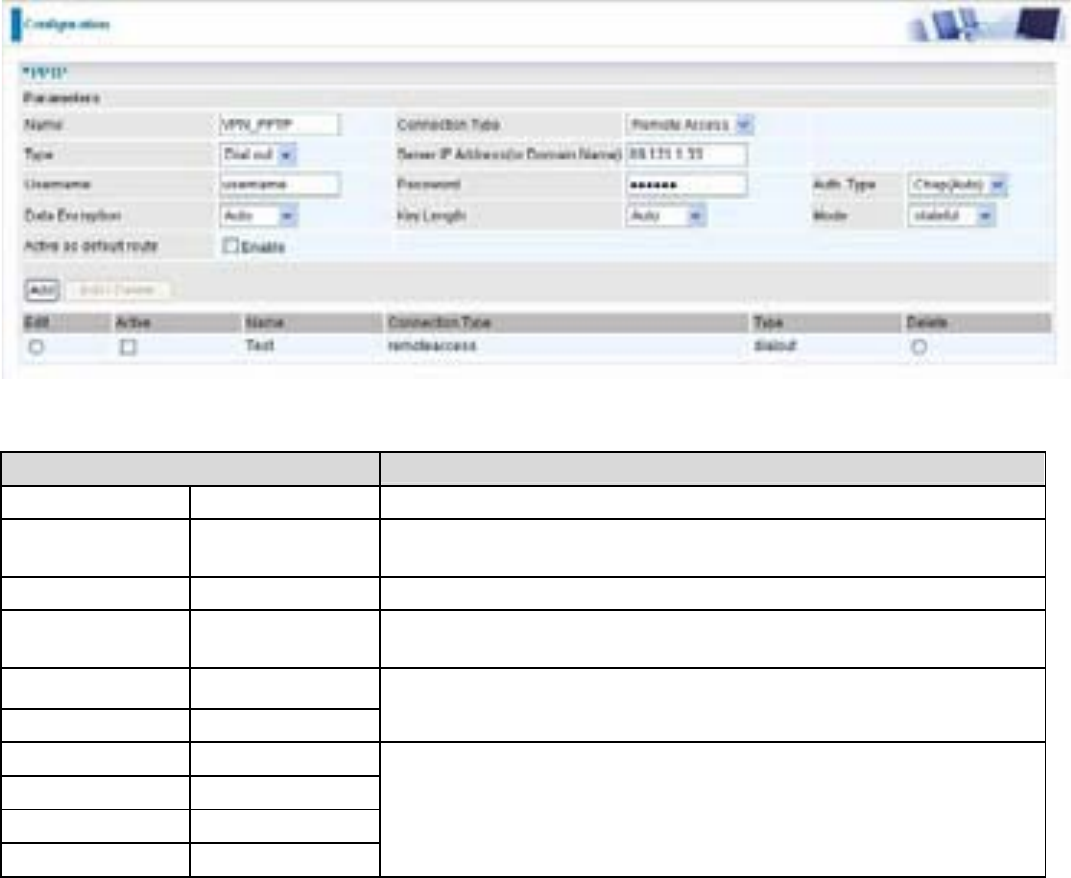
111
Configuring the PPTP VPN in the Office
Click Configuration/VPN/PPTP. Choose Remote Access from Connect Type drop-down menu. You
can either input the IP address (69.1.121.33 in this case) or hostname to reach the server.
Function Description
Name VPN_PPTP Given name of PPTP connection
Connection
Type
Remote Access Select Remote Access from the Connection Type drop-down
menu
Type Dial out Select Dial out from the Type drop-down menu
IP Address (or
Domain name)
69.121.1.33 An Dialed server IP
Username Username
Password 123456
A given username & password
Auth.Type Chap(Auto)
Data Encryption Auto
Key Length Auto
Mode stateful
Keep as default value in most of the cases, PPTP server &
client will determine the value automatically. Refer to manual
for details if you want to change the setting.
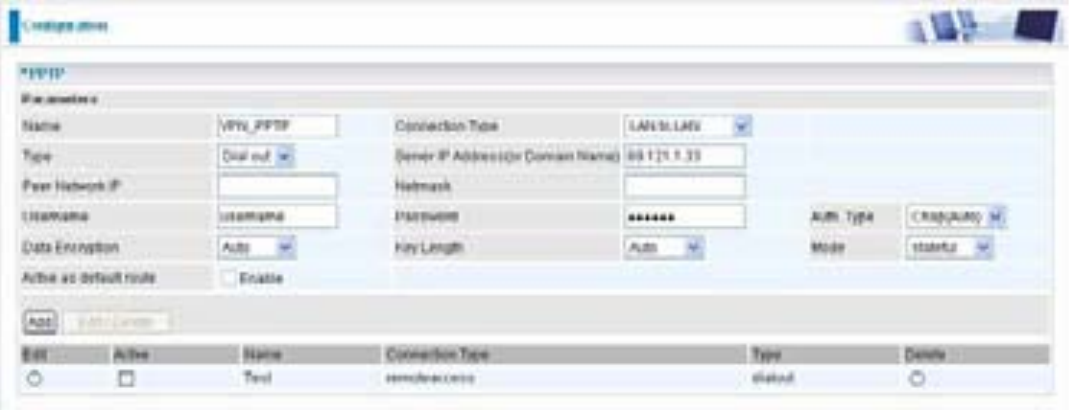
112
PPTP Connection - LAN to LAN
Click Configuration/VPN/PPTP. Choose LAN to LAN from Connect Type drop-down menu.
Name: A given name for the connection (e.g. “connection to office”).
Connection Type: Remote Access or LAN to LAN.
Type: Check Dial Out if you want your router to operate as a client (connecting to a remote
VPNserver, e.g. your office server), check Dial In operates as a VPN server.
When configuring your router as a Client, enter the remote Server IP Address (or Domain Name)
you wish to connect to.
When configuring your router as a server, enter the Private IP Address assigned to the Dial in
User.
Sever IP Address(or Domain Name):Enter the Server IP Adress or Domain Name.
Peer Network IP: Enter Peer network IP address.
Netmask: Enter the subnet mask of peer network based on the Peer Network IP setting.
Username: If you are a Dial-Out user (client), enter the username provided by your Host. If
you are a Dial-In user (server), enter your own username.
Password: If you are a Dial-Out user (client), enter the password provided by your Host. If you
are a Dial-In user (server), enter your own password.
Authentication Type: Default is Auto if you want the router to determine the authentication type
to use, or else manually specify CHAP (Challenge Handshake Authentication Protocol) or PAP
(Password Authentication Protocol) if you know which type the server is using (when acting as a
client), or else the authentication type you want clients connecting to you to use (when acting as
a server). When using PAP, the password is sent unencrypted, whilst CHAP encrypts the
password before sending, and also allows for challenges at different periods to ensure that an
intruder has not replaced the client.
Data Encryption: Data sent over the VPN connection can be encrypted by an MPPE algorithm.
Default is Auto, so that this setting is negotiated when establishing a connection, or else you
can manually Enable or Disable encryption.
Key Length: The data can be encrypted by MPPE algorithm with 40 bits or 128 bits. Default is
113
Auto, it is negotiated when establishing a connection. 128 bit keys provide stronger encryption
than 40 bit keys.
Mode: You may select Stateful or Stateless mode. The key will be changed every 256 packets
when you select Stateful mode. If you select Stateless mode, the key will be changed in each
packet.
Active as default route: Commonly used by the Dial-out connection which all packets will route
through the VPN tunnel to the Internet; therefore, active the function may degrade the Internet
performance.
Active: This function activates or deactivates the PPTP connection. Check Active checkbox if you
want the protocol of tunnel to be activated and vice versa.
Note: When the Active checkbox is checked, the function of Edit and Delete will not be
available.
Click Edit/Delete button to save your changes.
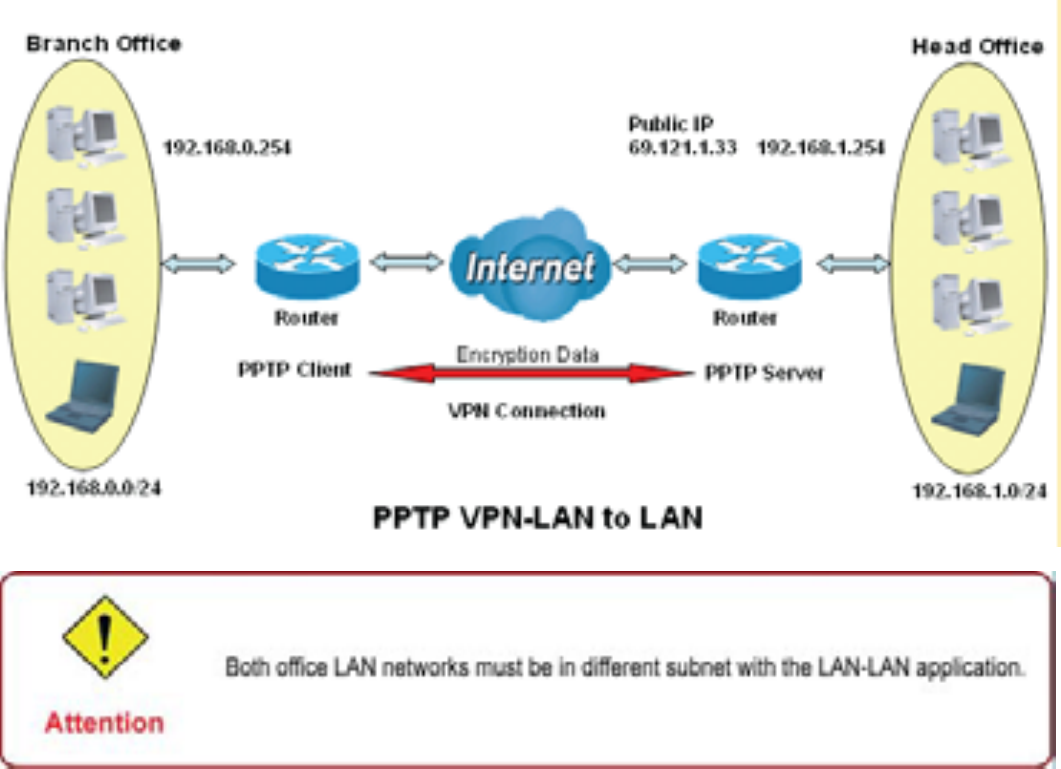
114
Example: Configuring a Remote Access PPTP VPN Dial-out Connection
The branch office establishes a PPTP VPN tunnel with head office to connect two private networks
over the Internet. The routers are installed in the head office and branch offices accordingly.
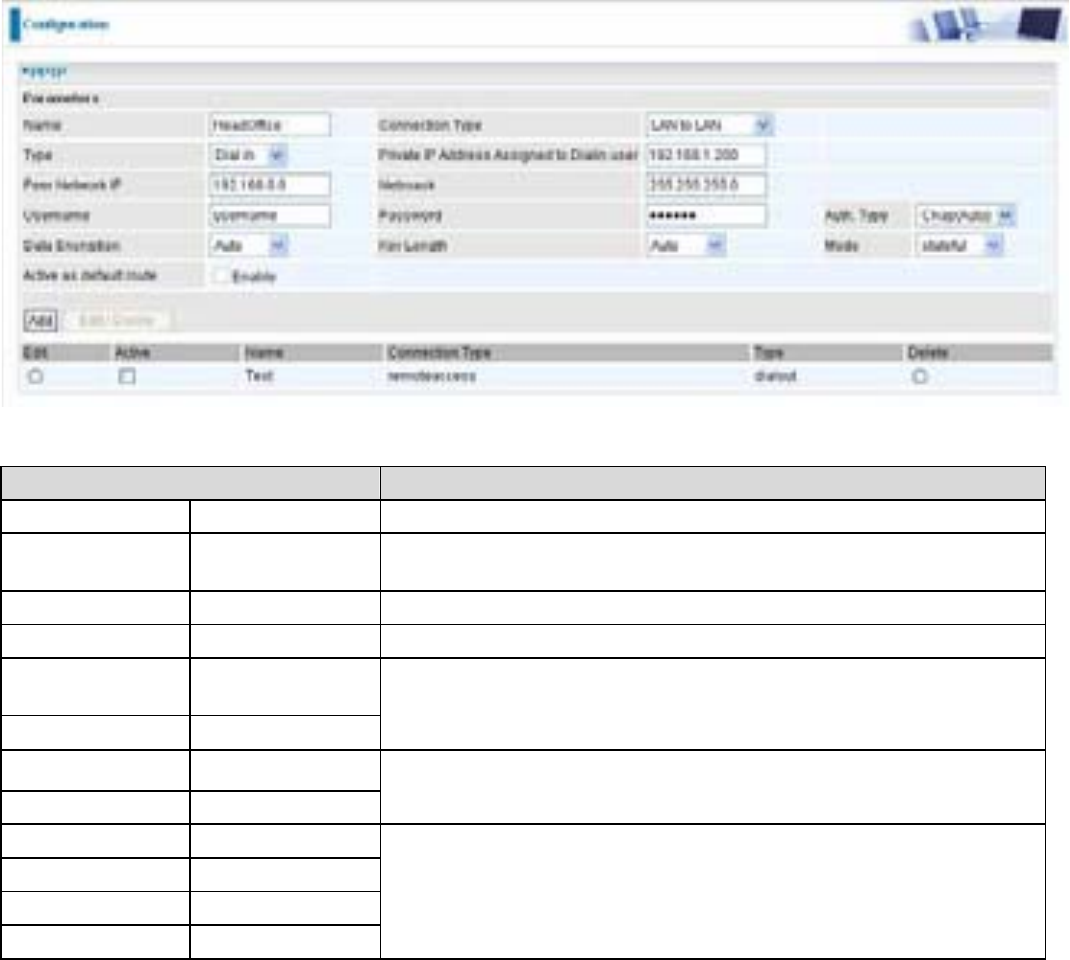
115
Configuring the PPTP VPN in the Head Office
The IP address 192.168.1.201 will be assigned to the router located in the branch office. Please
make sure this IP is not used in the head office LAN.
Function Description
Name HeadOffice Given name of PPTP connection
Connection
Type
LAN to LAN Select LAN to LAN from the Connection Type drop-down
menu
Type Dial in Select Dial in from the Type drop-down menu
IP Address 192.168.1.200 IP address assigned to branch office network.
Peer Network
IP
192.168.0.0
Netmask 255.255.255.0
Branch office network
Username Username
Password 123456
A given username & password to authenticate branch office
network.
Auth.Type Chap(Auto)
Data Encryption Auto
Key Length Auto
Mode stateful
Keep as default value in most of the cases, PPTP server &
client will determine the value automatically. Refer to manual
for details if you want to change the setting.
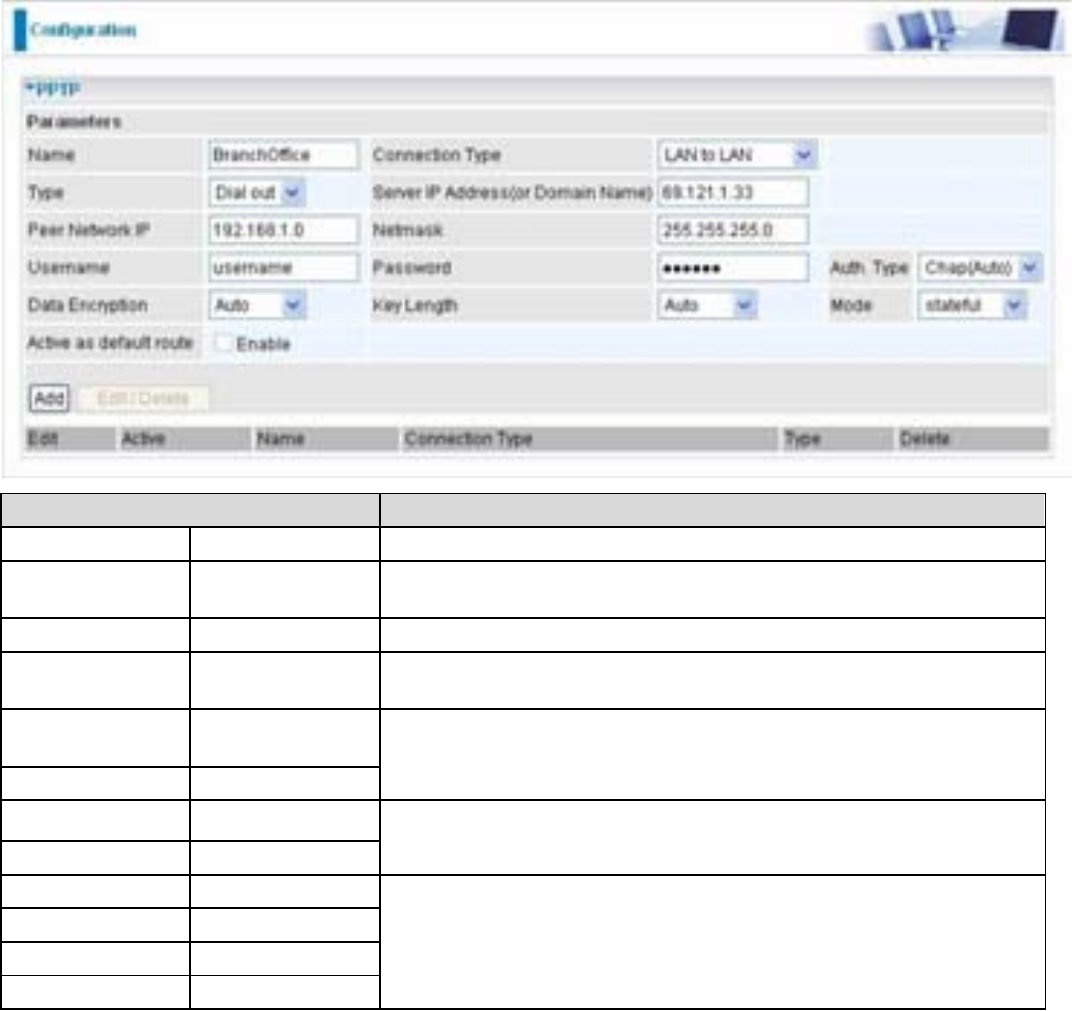
116
Configuring the PPTP VPN in the Head Office
The IP address 69.1.121.30 is the Public IP address of the router located in head office. If you
registered the DDNS (please refer to the DDNS section of this manual), you can also use the
domain name instead of the IP address to reach the router.
Function Description
Name HeadOffice Given name of PPTP connection
Connection
Type
LAN to LAN Select LAN to LAN from the Connection Type drop-down
menu
Type Dial out Select Dial out from the Type drop-down menu
IP Address (or
Domain Name)
69.121.1.33 IP address assigned to branch office network.
Peer Network
IP
192.168.1.0
Netmask 255.255.255.0
Head office network
Username Username
Password 123456
A given username & password to authenticate branch office
network.
Auth.Type Chap(Auto)
Data Encryption Auto
Key Length Auto
Mode stateful
Keep as default value in most of the cases, PPTP server &
client will determine the value automatically. Refer to manual
for details if you want to change the setting.
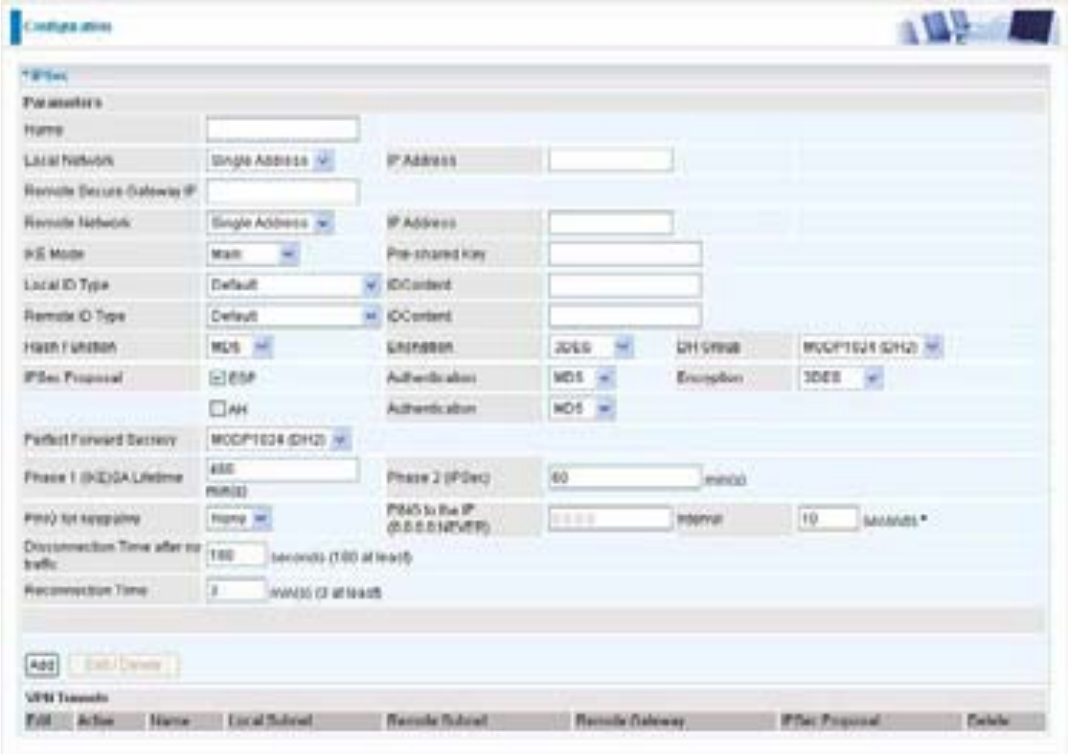
117
IPSec (IP Security Protocol)
Active: This function activates or deactivates the IPSec connection. Check Active checkbox if you
want the protocol of tunnel to be activated and vice versa.
Note: When the Active checkbox is checked, the function of Edit and Delete will not be
available.
Name: This is a given name of the connection.
Local Subnet: Displays IP address and subnet of the local network.
Remote Subnet: Displays IP address and subnet of the remote network.
Remote Gateway: This is the IP address or Domain Name of the remote VPN device that is
connected and established a VPN tunnel.
IPSec Proposal: This is selected IPSec security method.
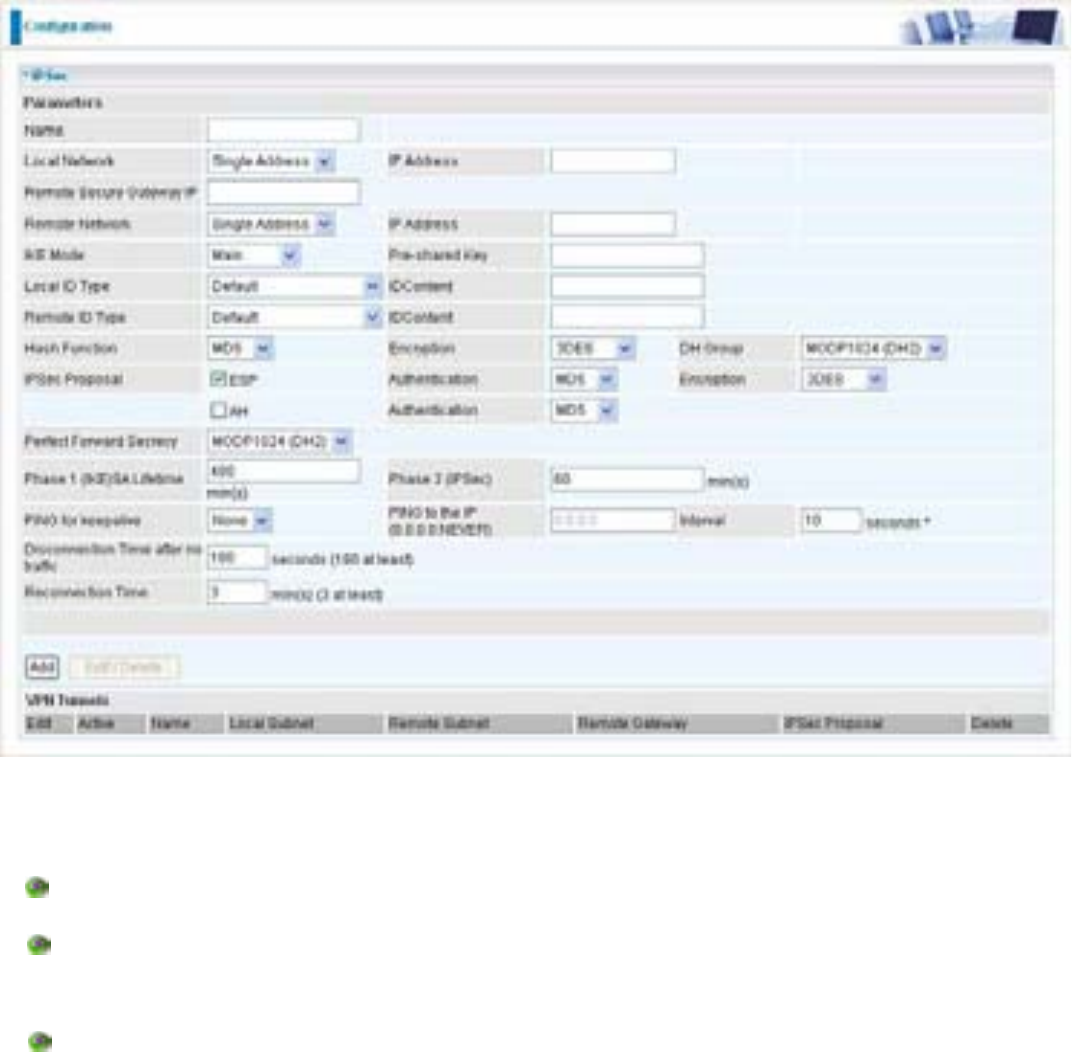
118
IPSec VPN Connection
Name: A given name for the connection (e.g. “connection to office”).
Local Network: Set the IP address, subnet or address range of the local network.
Single Address: The IP address of the local host.
Subnet: The subnet of the local network. For example, IP: 192.168.1.0 with netmask
255.255.255.0 specifies one class C subnet starting from 192.168.1.1 (i.e. 192.168.1.1 through
to 192.168.1.254).
IP Range: The IP address range of the local network. For example, IP: 192.168.1.1, end IP:
192.168.1.10.
Remote Secure Gateway Address (or Domain Name): The IP address or hostname of the
remote VPN device that is connected and establishes a VPN tunnel.
Remote Network: Set the IP address, subnet or address range of the remote network.
IKE (Internet key Exchange) Mode: Select IKE mode to Main mode or Aggressive mode. This
IKE provides secured key generation and key management.
Pre-shared Key: This is for the Internet Key Exchange (IKE) protocol, a string from 4 to 128
characters. Both sides should use the same key. IKE is used to establish a shared security policy
and authenticated keys for services (such as IPSec) that require a key. Before any IPSec traffic
can be passed, each router must be able to verify the identity of its peer. This can be done by
manually entering the pre-shared key into both sides (router or hosts).

119
Local ID:
Content: Input ID’s information, like domain name www.ipsectest.com.
Remote ID:
Identifier: Input remote ID’s information, like domain name www.ipsectest.com
Hash Function: It is a Message Digest algorithm which coverts any length of a message into a
unique set of bits. It is widely used MD5 (Message Digest) and SHA-1 (Secure Hash Algorithm)
algorithms. SHA1 is more resistant to brute-force attacks than MD5, however it is slower.
MD5: A one-way hashing algorithm that produces a 128íbit hash.
SHA1: A one-way hashing algorithm that produces a 160íbit hash
Encryption: Select the encryption method from the pull-down menu. There are several options,
DES, 3DES and AES (128, 192 and 256). 3DES and AES are more powerful but increase latency.
DES: Stands for Data Encryption Standard, it uses 56 bits as an encryption method.
3DES: Stands for Triple Data Encryption Standard, it uses 168 (56*3) bits as an encryption
method.
AES: Stands for Advanced Encryption Standards, you can use 128, 192 or 256 bits as en-
cryption method.
Diffie-Hellman Group: It is a public-key cryptography protocol that allows two parties to establish
a shared secret over an unsecured communication channel (i.e. over the Internet). There are
three modes, MODP 768-bit, MODP 1024-bit and MODP 1536-bit. MODP stands for Modular
Exponentiation Groups.
IPSec Proposal: Select the IPSec security method. There are two methods of checking the
authentication information, AH (authentication header) and ESP (Encapsulating Security Payload).
Use ESP for greater security so that data will be encrypted and authenticated. Using AH data will
be authenticated but not encrypted.
Authentication: Authentication establishes the integrity of the datagram and ensures it is not
tampered with in transmit. There are three options, Message Digest 5 (MD5), Secure Hash
Algorithm (SHA1) or NONE. SHA1 is more resistant to brute-force attacks than MD5, however it is
slower.
MD5: A one-way hashing algorithm that produces a 128íbit hash.
SHA1: A one-way hashing algorithm that produces a 160íbit hash
Encryption: Select the encryption method from the pull-down menu. There are several options,
DES, 3DES, AES (128, 192 and 256) and NULL. NULL means it is a tunnel only with no
encryption. 3DES and AES are more powerful but increase latency.
DES: Stands for Data Encryption Standard, it uses 56 bits as an encryption method.
3DES: Stands for Triple Data Encryption Standard, it uses 168 (56*3) bits as an encryption
method.
AES: Stands for Advanced Encryption Standards, you can use 128, 192 or 256 bits as en-
cryption method.

120
Perfect Forward Secrecy: Choose whether to enable PFS using Diffie-Hellman public-key
cryptography to change encryption keys during the second phase of VPN negotiation. This
function cryptography protocol that allows two parties to establish a shared secret over an
unsecured communication channel (i.e. over the Internet). There are three modes, MODP
768-bit, MODP 1024-bit and MODP 1536-bit. MODP stands for Modular Exponentiation
Groups.
SA Lifetime: Specify the number of minutes that a Security Association (SA) will stay active
before new encryption and authentication key will be exchanged. There are two kinds of SAs, IKE
and IPSec. IKE negotiates and establishes SA on behalf of IPSec, an IKE SA is used by IKE.
Phase 1 (IKE): To issue an initial connection request for a new VPN tunnel. The range can
be from 5 to 15,000 minutes, and the default is 480 minutes.
Phase 2 (IPSec): To negotiate and establish secure authentication. The range can be from 5
to 15,000 minutes, and the default is 60 minutes.
A short SA time increases security by forcing the two parties to update the keys. However, every
time the VPN tunnel re-negotiates, access through the tunnel will be temporarily disconnected.
PING for Keep Alive:
None: The default setting is None. To this mode, it will not detect the remote IPSec peer has
been lost or not. It only follows the policy of Disconnection time after no traffic, which the re-
mote IPSec will be disconnected afther the time you set in this function.
PING: This mode will detect the remote IPSec peer has lost or not by pinging specify IP ad-
dress.
DPD: Dead peer detection (DPD) is a keeping alive mechanism that enables the router to be
detected lively when the connection between the router and a remote IPSec peer has lost.
Please be noted, it must be enabled on the both sites.
PING to the IP: It is able to IP Ping the remote PC with the specified IP address and alert when
the connection fails. Once alter message is received, Router will drop this tunnel connection.
Reestablish of this connection is required. Default setting is 0.0.0.0 which disables the function.
Interval: This sets the time interval between Pings to the IP function to monitor the connection
status. Default interval setting is 10 seconds. Time interval can be set from 0 to 3600 second, 0
second disables the function.
Ping to the IP Interval (sec) Ping to the IP Action
0.0.0.0 0 No
0.0.0.0 2000 No
xxx.xxx.xxx.xxx (A valid IP Address) 0 No
xxx.xxx.xxx.xxx(A valid IP Address) 2000 Yes, activate it in every 2000
second.
Disconnection Time after no traffic: It is the NO Response time clock. When no traffic stage
time is beyond the Disconnection time set, Router will automatically halt the tunnel connection and
re-establish it base on the Reconnection Time set. 180 seconds is minimum time interval for this
function.
Reconnection Time: It is the reconnecting time interval after NO TRAFFIC is initiated. 3 minutes
121
is minimum time interval for this function.
Click Edit/Delete to save your changes.
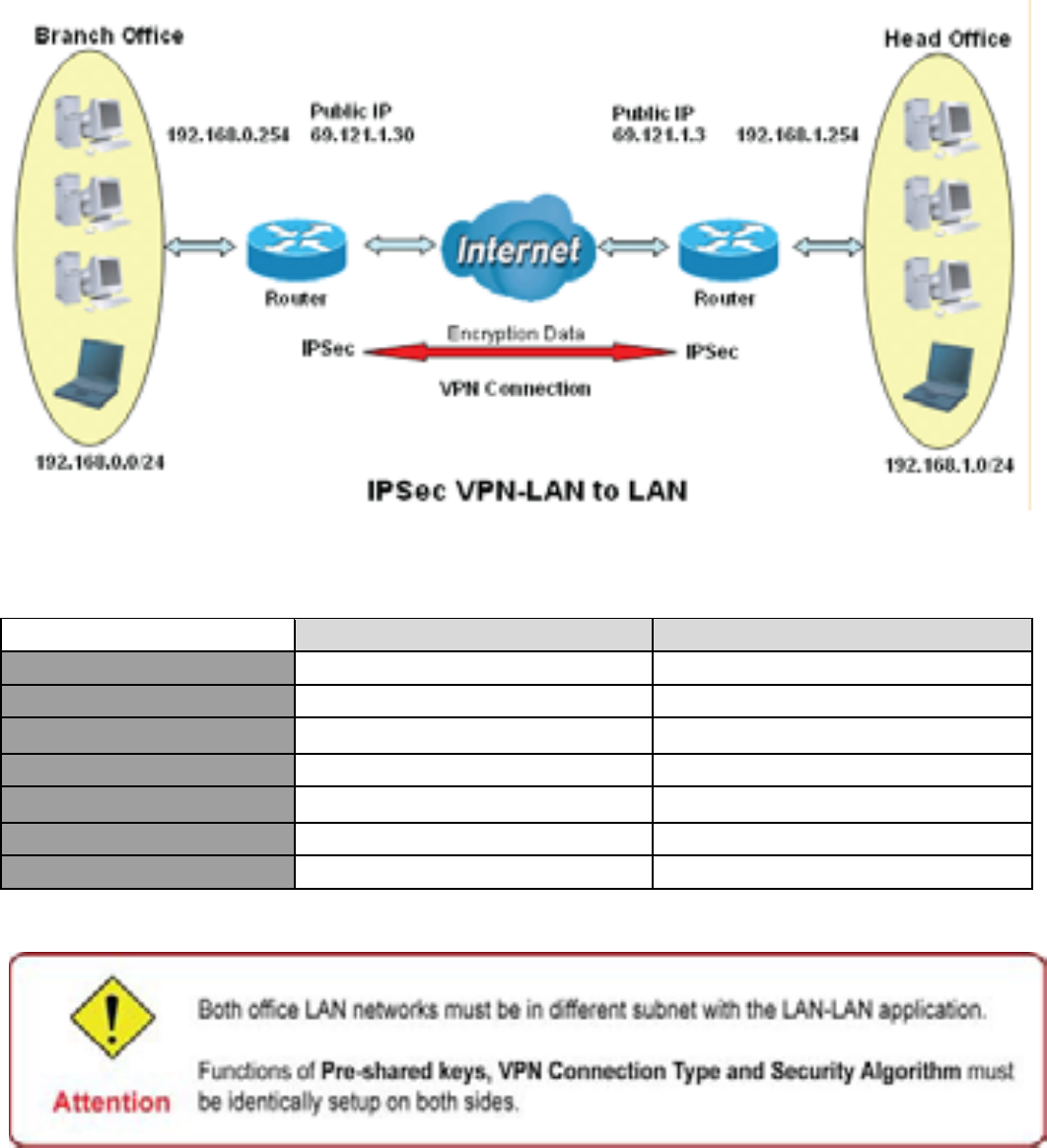
122
Example: Configuring an IPSec LAN to LAN VPN Connection
Table 3: Network Configuration and Security Plan
Branch Office Head Office
Local Network ID 192.168.0.0/24 192.168.1.0/24
Local Router IP 69.1.121.30 69.1.121.3
Remote Network ID 192.168.1.0/24 192.168.0.0/24
Remote Router IP 69.1.121.3 69.1.121.30
IKE Pre-shared Key 12345678 12345678
VPN Connection Type Tunnel mode Tunnel mode
Security Algorithm ESP:MD5 with AES ESP:MD5 with AES
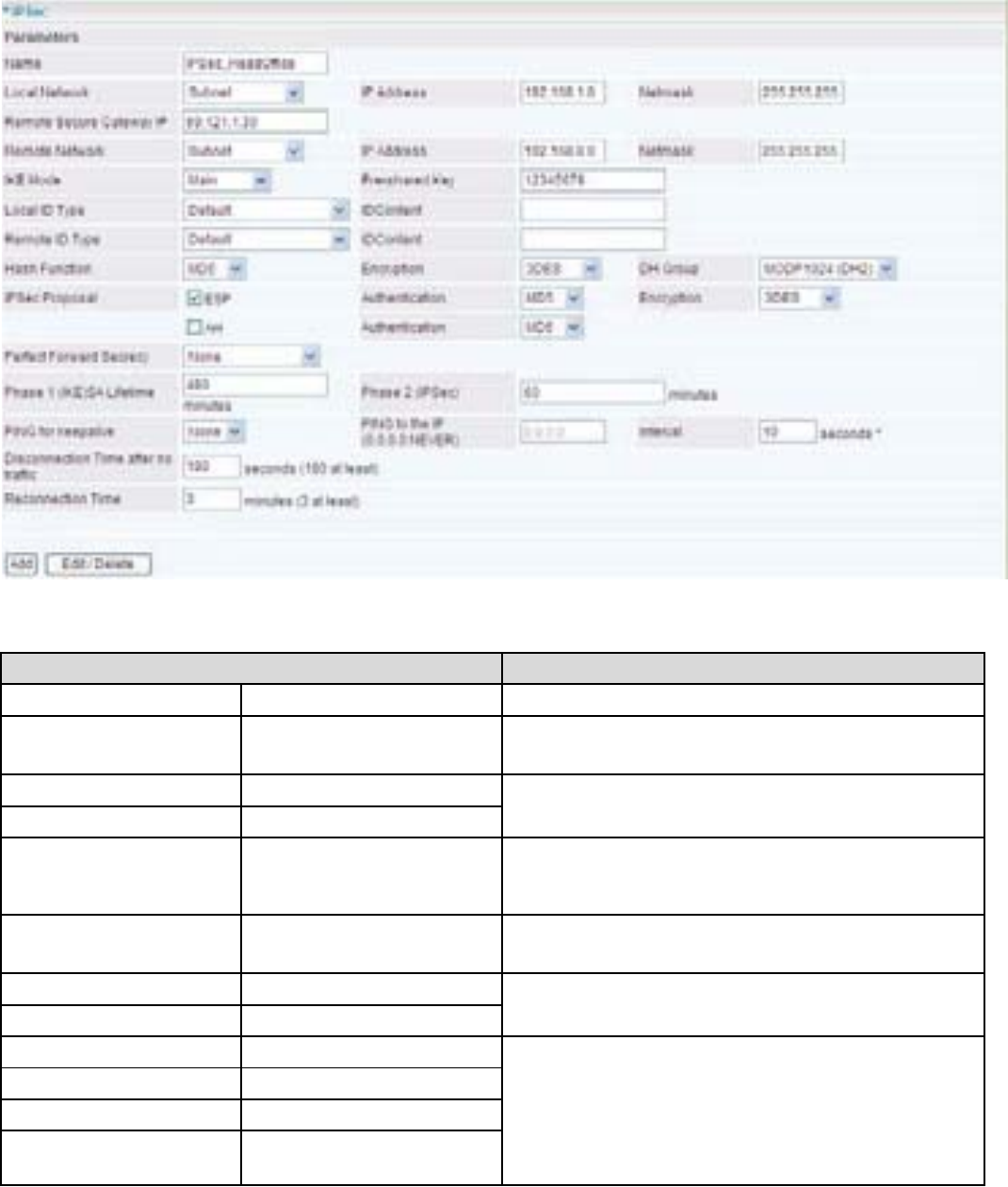
123
Configuring IPSec VPN in the Head Office
Function Description
Name IPSec_HeadOffice Give a name of IPSec Connection
Local Network Subnet Select Subnet from Local Network drop-down
menu.
IP Address 192.168.1.0
Netmask 255.255.255.0
Head office network
Remote Secure
Gateway IP (or
Hostname)
69.121.1.30 IP address of the head office router (in WAN
side)
Remote Network Subnet Select Subnet from Remote Network drop-
down menu
IP Address 192.168.0.0
Netmask 255.255.255.0
Branch office network
Pre-shared Key 12345678
Authentication MD5
Encryption 3DES
Prefer Forward
Security
None
Security plan
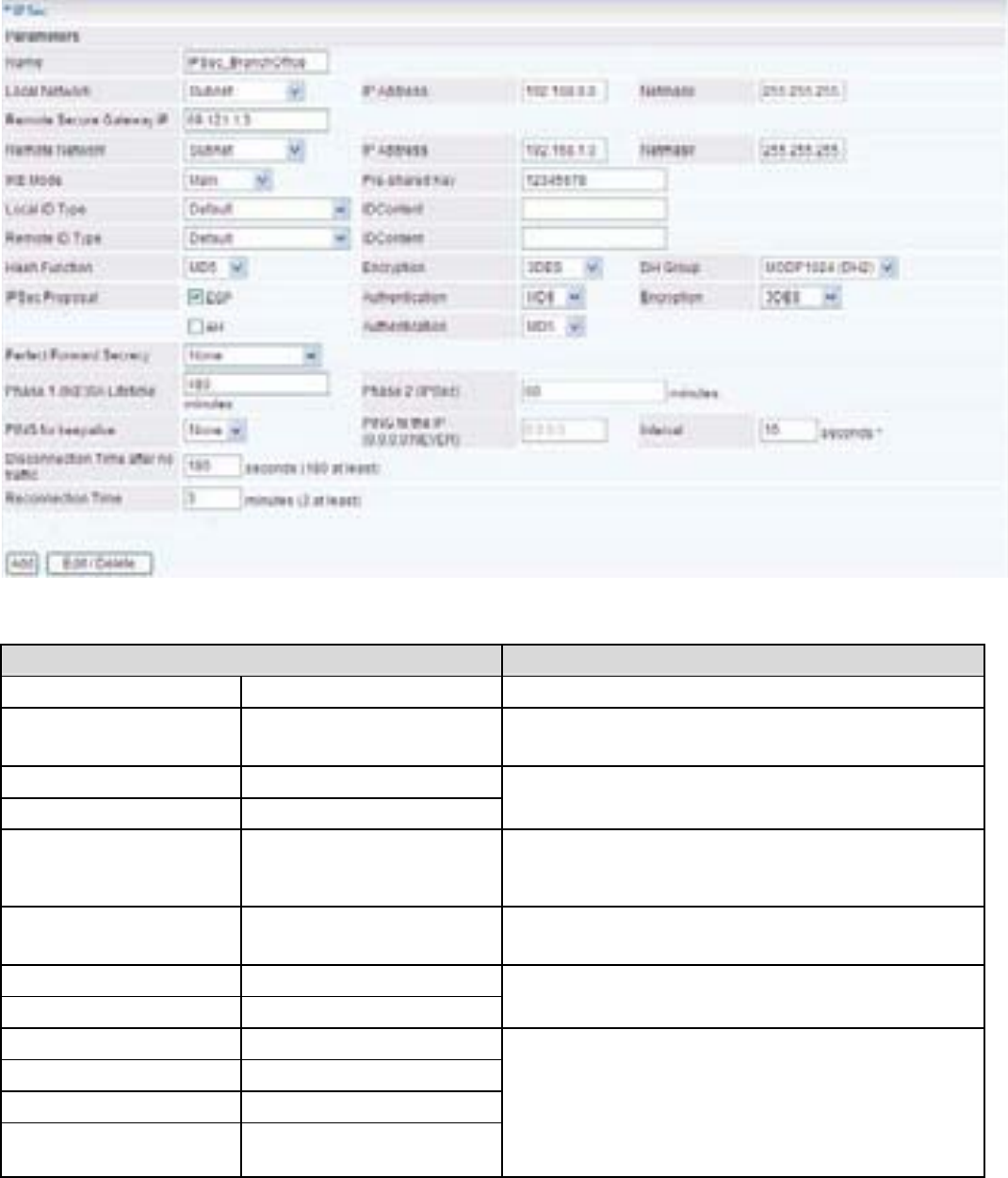
124
Configuring IPSec VPN in the Branch Office
Function Description
Name IPSec_BranchOffice Give a name of IPSec Connection
Local Network Subnet Select Subnet from Local Network drop-down
menu.
IP Address 192.168.0.0
Netmask 255.255.255.0
Branch office network
Remote Secure
Gateway IP (or
Hostname)
69.121.1.3 IP address of the head office router (in WAN
side)
Remote Network Subnet Select Subnet from Remote Network drop-
down menu
IP Address 192.168.1.0
Netmask 255.255.255.0
Head office network
Pre-shared Key 12345678
Authentication MD5
Encryption 3DES
Prefer Forward
Security
None
Security plan
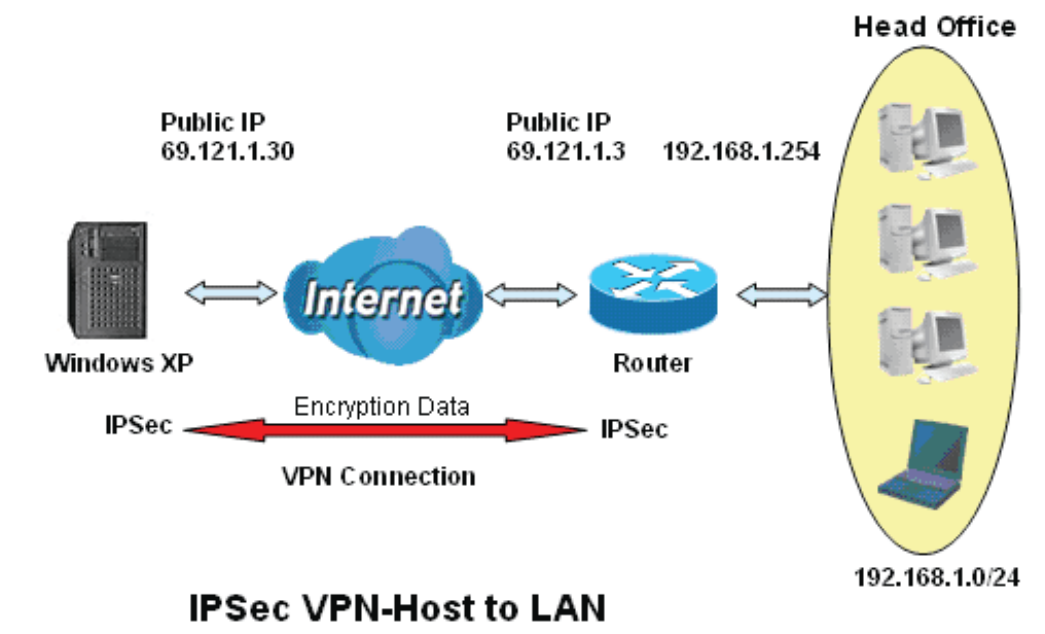
125
Example: Configuring an IPSec Host to LAN VPN Connection
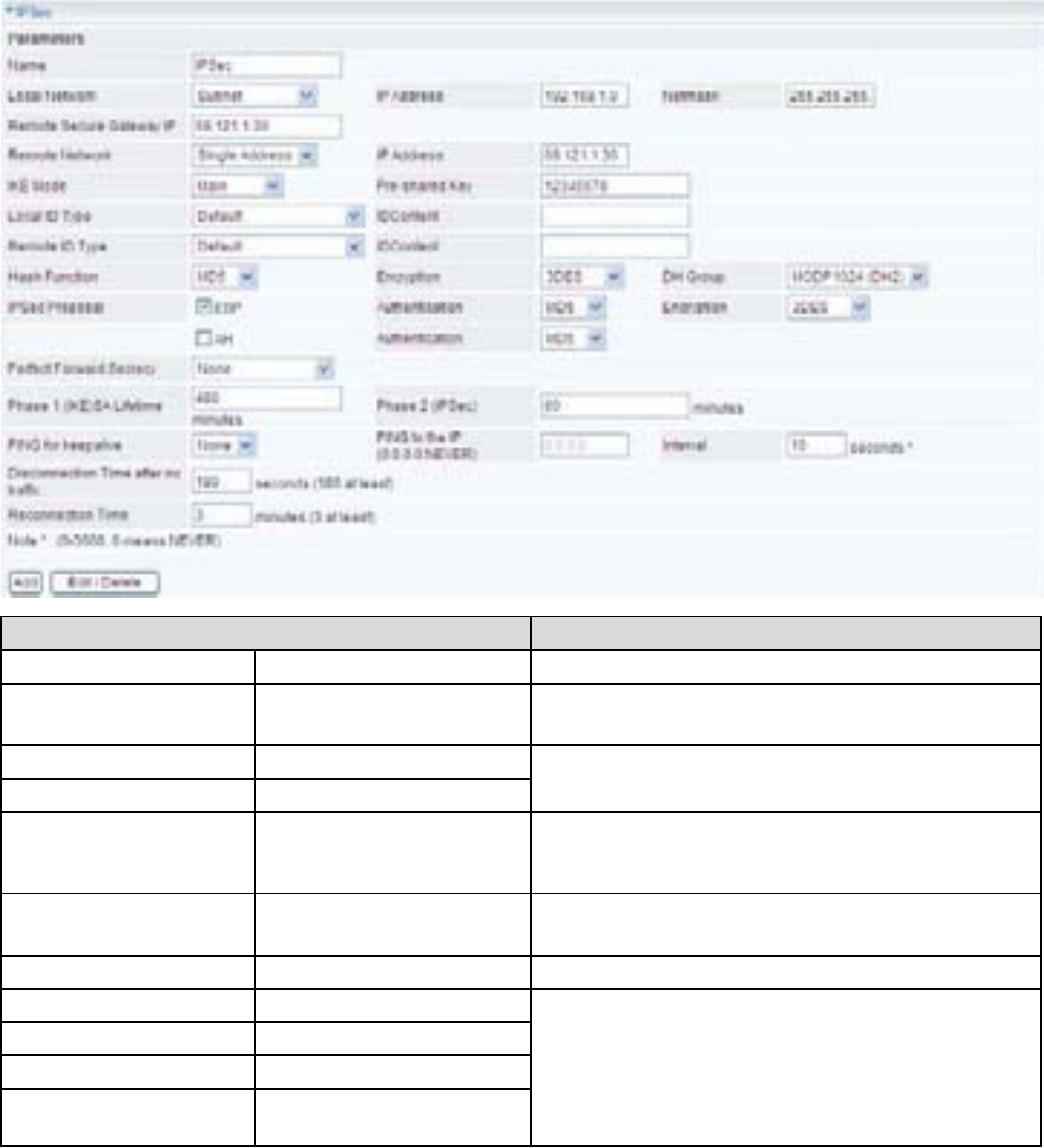
126
Configuring IPSec VPN in the Office
Function Description
Name IPSec Give a name of IPSec Connection
Local Network Subnet Select Subnet from Local Network drop-down
menu.
IP Address 192.168.1.0
Netmask 255.255.255.0
Head office network
Remote Secure
Gateway IP (or
Hostname)
69.121.1.30 IP address of the head office router (in WAN
side)
Remote Network Single Address Select Single Address from Remote Network
drop-down menu
IP Address 69.121.1.30 Remote worker's IP address
Pre-shared Key 12345678
Authentication MD5
Encryption 3DES
Prefer Forward
Security
None
Security plan
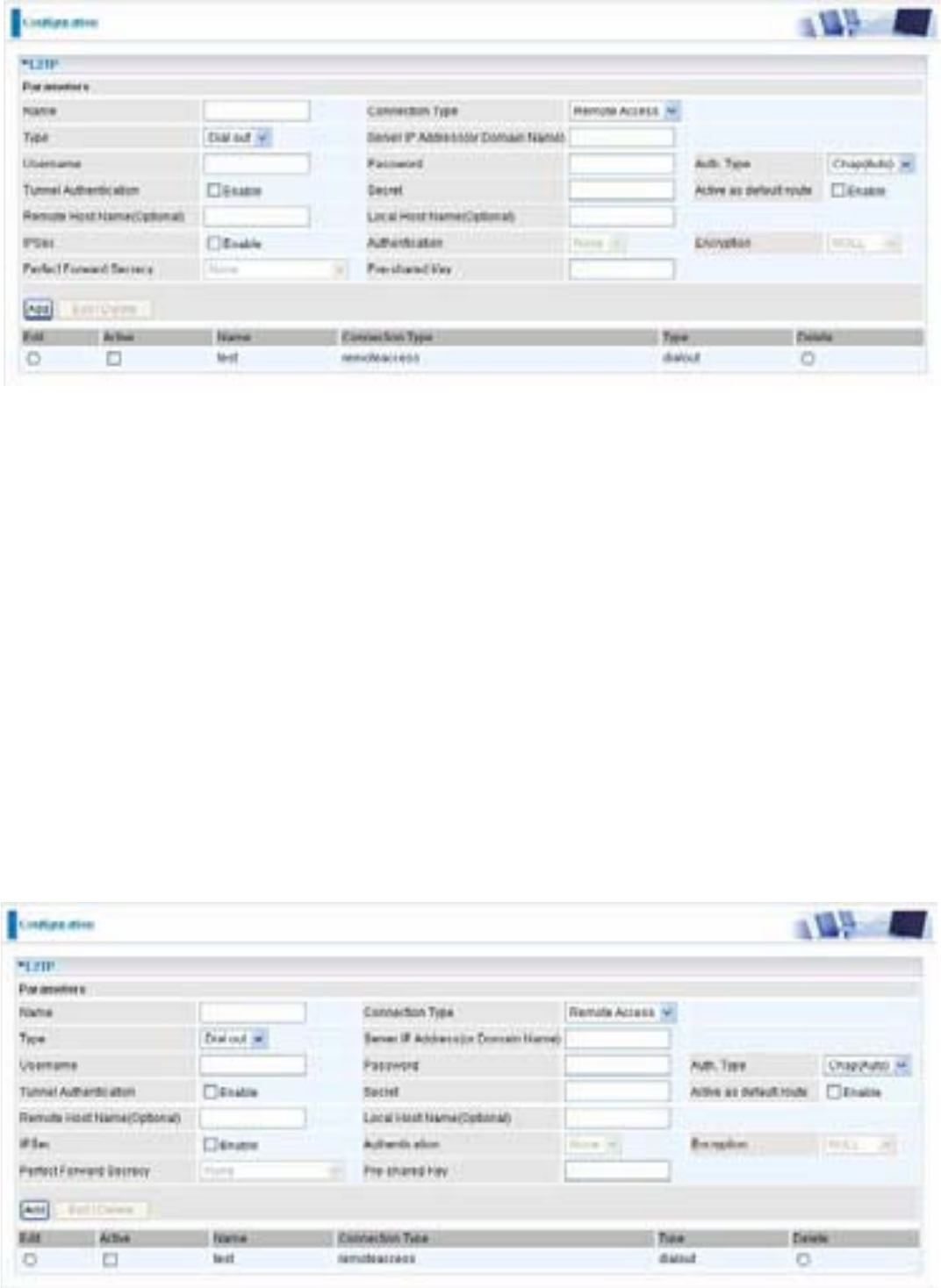
127
L2TP (Layer Two Tunneling Protocol)
Two types of L2TP VPN are supported Remote Access and LAN-to-LAN (please refer below for
more information.). Fill in the blank with information you need and click Add to create a new VPN
connection account.
Active: This function activates or deactivates the PPTP connection. Check Active checkbox if you
want the protocol of tunnel to be activated and vice versa.
Note: When the Active checkbox is checked, the function of Edit and Delete will not be
available.
Name: This is a given name of the connection.
Connection Type: Displays the condition of your L2TP tunneling connection.
Type: This refers to your router whether it operates as a client or a server, Dial-out or Dial-in
respectively.
L2TP Connection-Remote Access

128
Connection Type: Remote Access or LAN to LAN
Name: A given name for the connection (e.g. “connection to office”).
Connection Type: Remote Access or LAN to LAN.
Type: Check Dial Out if you want your router to operate as a client (connecting to a remote VPN
server, e.g. your office server), check Dial In operates as a VPN server.
When configuring your router as a Client, enter the remote Server IP Address (or Hostname) you
wish to connect to.
When configuring your router as a server, enter the Private IP Address Assigned to the Dial in
User.
Username: If you are a Dial-Out user (client), enter the username provided by your Host. If you
are a Dial-In user (server), enter your own username.
Password: If you are a Dial-Out user (client), enter the password provided by your Host. If you are
a Dial-In user (server), enter your own password.
Authentication Type: Default is Auto if you want the router to determine the authentication type
to use, or else manually specify CHAP (Challenge Handshake Authentication Protocol) or PAP
(Password Authentication Protocol) if you know which type the server is using (when acting as a
client), or else the authentication type you want clients connecting to you to use (when acting as a
server). When using PAP, the password is sent unencrypted, whilst CHAP encrypts the password
before sending, and also allows for challenges at different periods to ensure that an intruder has
not replaced the client.
Tunnel Authentication: This enables router to authenticate both the L2TP remote and L2TP host.
This is only valid when L2TP remote supports this feature.
Secret: The secure password length should be 16 characters which may include numbers and
characters.
Active as default route: Commonly used by the Dial-out connection which all packets will route
through the VPN tunnel to the Internet; therefore, active the function may degrade the Internet
performance.
Remote Host Name (Optional): Enter hostname of remote VPN device. It is a tunnel identifier
from the Remote VPN device matches with the Remote hostname provided. If remote hostname
matches, tunnel will be connected; otherwise, it will be dropped.
Cautious: This is only when the router performs as a VPN server. This option should be
used by advanced users only.
Local Host Name (Optional): Enter hostname of Local VPN device that is connected / establishes
a VPN tunnel. As default, Router’s default Hostname is home.gateway.
IPSec: Enable for enhancing your L2TP VPN security.
Authentication: Authentication establishes the integrity of the datagram and ensures it is not
tampered with in transmit. There are three options, Message Digest 5 (MD5), Secure Hash
Algorithm (SHA1) or NONE. SHA1 is more resistant to brute-force attacks than MD5, however it is
slower.
MD5: A one-way hashing algorithm that produces a 128íbit hash.

129
SHA1: A one-way hashing algorithm that produces a 160íbit hash.
Encryption: Select the encryption method from the pull-down menu. There are four options, DES,
3DES, AES and NULL. NULL means it is a tunnel only with no encryption. 3DES and AES are
more powerful but increase latency.
DES: Stands for Data Encryption Standard, it uses 56 bits as an encryption method.
3DES: Stands for Triple Data Encryption Standard, it uses 168 (56*3) bits as an encryption
method.
AES: Stands for Advanced Encryption Standards, it uses 128 bits as an encryption method.
Perfect Forward Secrecy: Choose whether to enable PFS using Diffie-Hellman public-key
cryptography to change encryption keys during the second phase of VPN negotiation. This
function will provide better security, but extends the VPN negotiation time. Diffie-Hellman is a
public-key cryptography protocol that allows two parties to establish a shared secret over an
unsecured communication channel (i.e. over the Internet). There are three modes, MODP 768-bit,
MODP 1024-bit and MODP 1536-bit. MODP stands for Modular Exponentiation Groups.
Pre-shared Key: This is for the Internet Key Exchange (IKE) protocol, a string from 4 to 128
characters. Both sides should use the same key. IKE is used to establish a shared security policy
and authenticated keys for services (such as IPSec) that require a key. Before any IPSec traffic
can be passed, each router must be able to verify the identity of its peer. This can be done by
manually entering the pre-shared key into both sides (router or hosts).
Click Edit/Delete to save your changes.
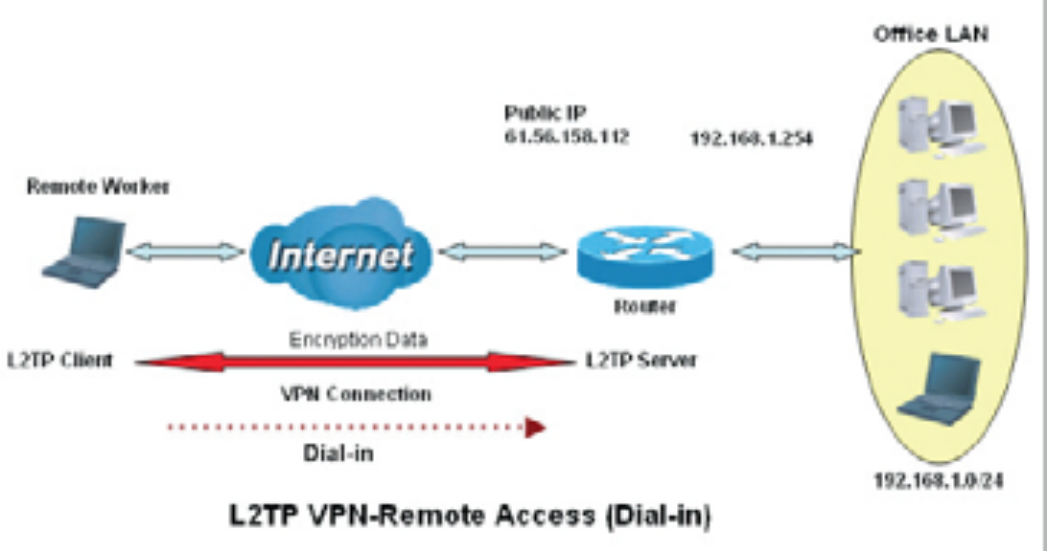
130
Example: Configuring a L2TP VPN - Remote Access Dial-in Connection
A remote worker establishes a L2TP VPN connection with the head office using Microsoft's VPN
Adapter (included with Windows XP/2000/ME, etc.). The router is installed in the head office,
connected to a couple of PCs and Servers.
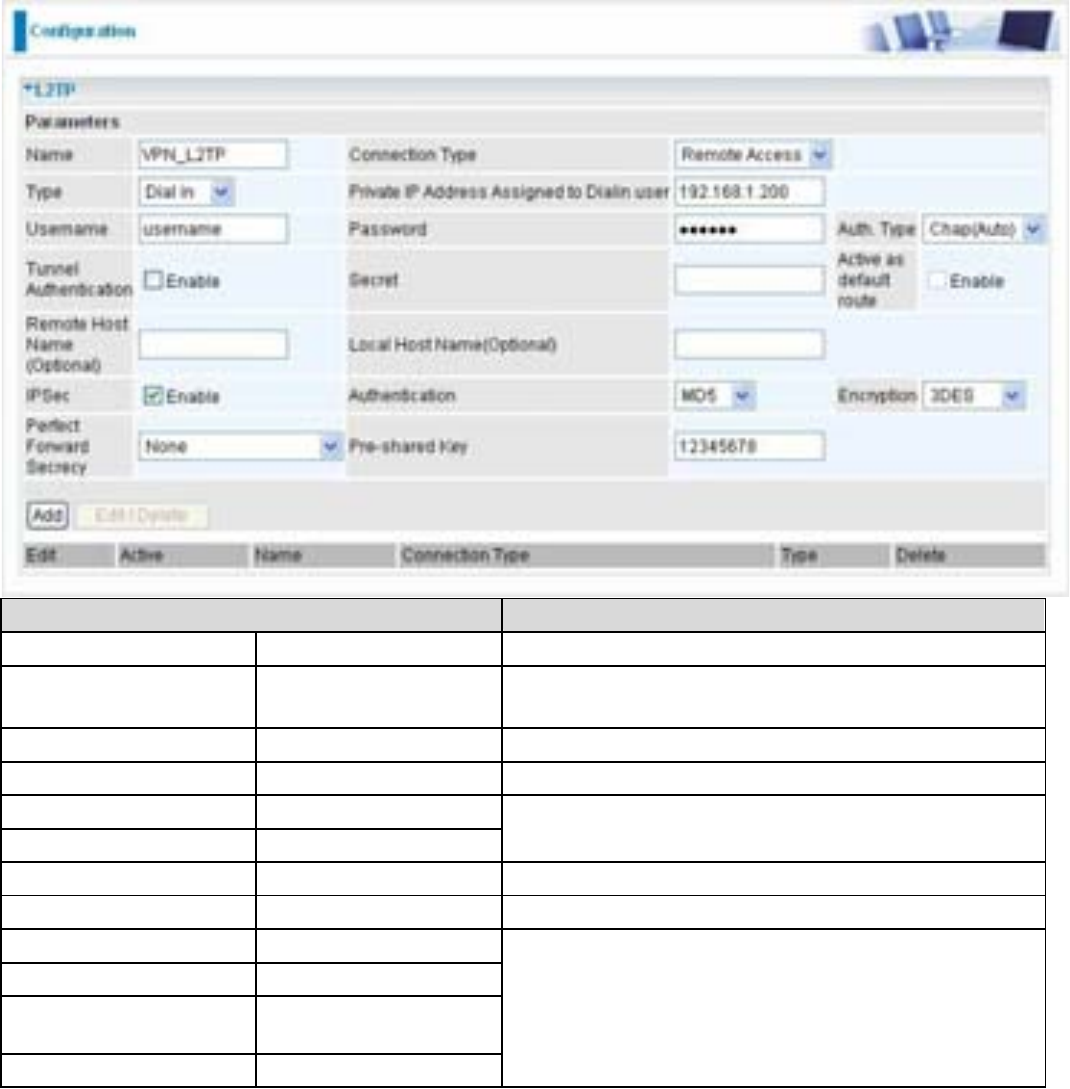
131
Configuring L2TP VPN in the Office
The input IP address 192.168.1.200 will be assigned to the remote worker. Please make sure this
IP is not used in the Office LAN.
Function Description
Name VPN_L2TP Give a name of L2TP Connection
Connection Type Remote Access Select Remote Access from the Connection Type
drop-down menu
Type Dial in Select Dial in from the Type drop down menu
IP Address 192.168.1.200 An IP assigned to the remote client
Username username
Password 123456
Enter the username and password to
authenticate a remote client
Auth. Type Chap (Auto) Keep this as the default value for most cases
IPSec Enable Enable this to enhance your L2TP VPN security
Authentication MD5
Encryption 3DES
Perfect Forward
Secrecy
None
Pre-Shared Key 12345678
Both sides should use the same value
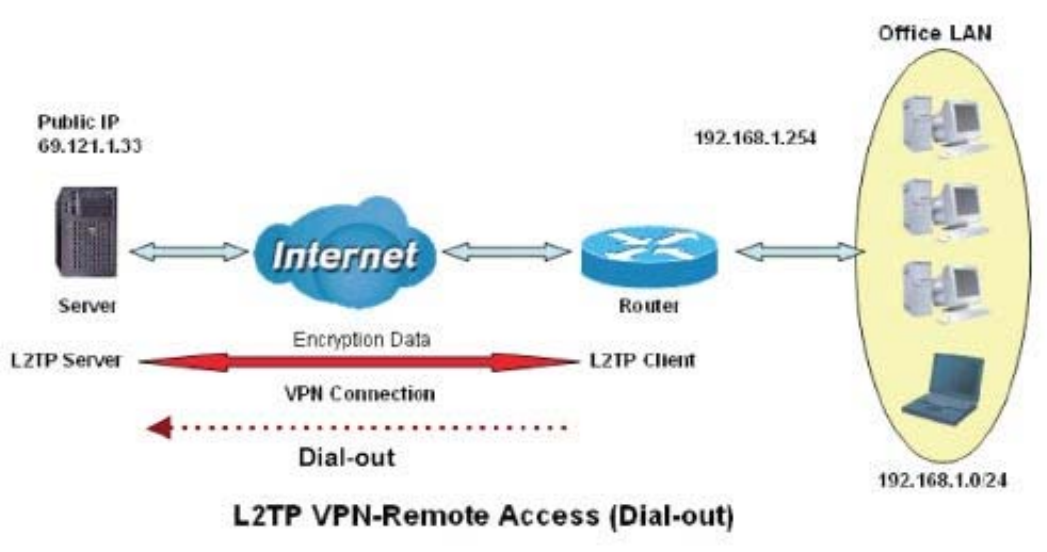
132
Example: Configuring a Remote Access L2TP VPN Dial-out Connection
A company’s office establishes a L2TP VPN connection with a file server located at a separate
location. The router is installed in the office, connected to a couple of PCs and Servers.
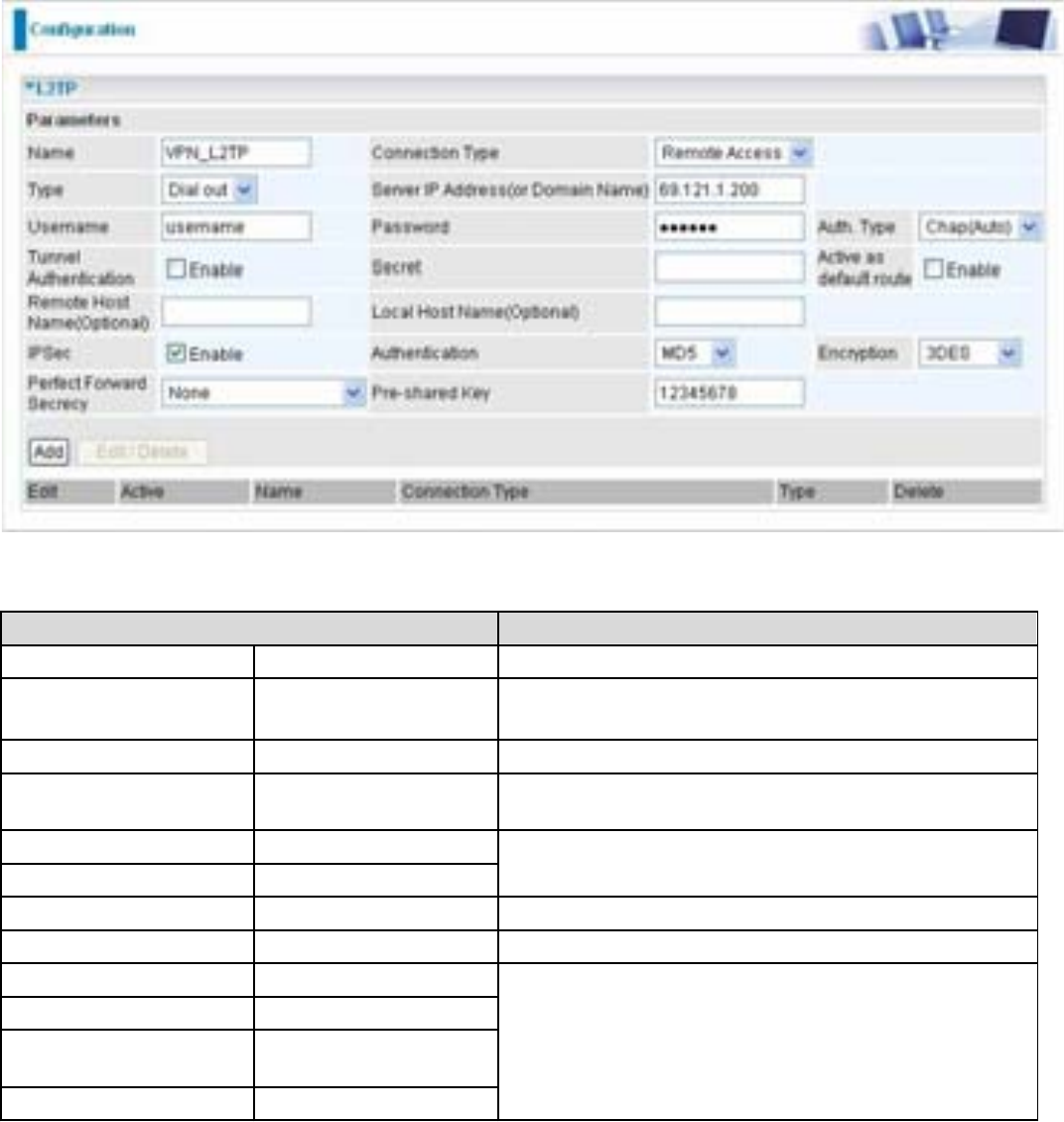
133
Configuring L2TP VPN in the Office
The input IP address 192.168.1.200 will be assigned to the remote worker. Please make sure this
IP is not used in the Office LAN.
Function Description
Name VPN_L2TP Give a name of L2TP Connection
Connection Type Remote Access Select Remote Access from the Connection Type
drop-down menu
Type Dial out Select Dial out from the Type drop down menu
IP Address (or
Hostname)
69.121.1.33 A Dialed Server IP
Username username
Password 123456
An assigned username and password
Auth. Type Chap (Auto) Keep this as the default value for most cases
IPSec Enable Enable this to enhance your L2TP VPN security
Authentication MD5
Encryption 3DES
Perfect Forward
Secrecy
None
Pre-Shared Key 12345678
Both sides should use the same value
Example: Configuring your Router to Dial-in to the Server
Currently, Microsoft Windows operation system does not support L2TP incoming service.
Additional software may be required to set up your L2TP incoming service.
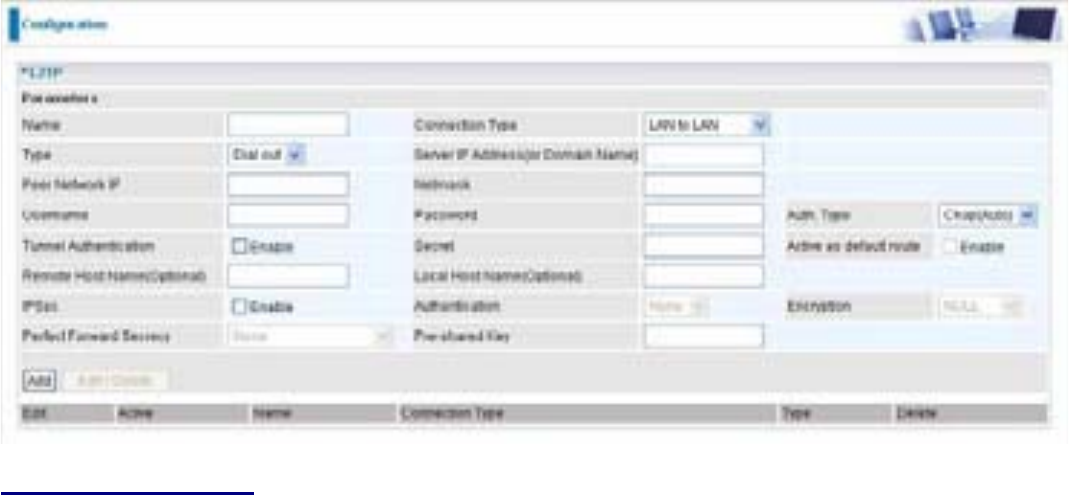
134
L2TP Connection - LAN to LAN
L2TP VPN Connection
Name: A given name for the connection
Connection Type: Remote Access or LAN to LAN.
Type: Check Dial Out if you want your router to operate as a client (connecting to a remote VPN
server, e.g. your office server), check Dial In to have it operate as a VPN server.
When configuring your router to establish a connection to a remote LAN, enter the remote Server
IP Address (or Hostname) you wish to connect to.
When configuring your router as a server to accept incoming connections, enter the Private IP
Address assigned to the Dial in User.
Peer Network IP: Enter Peer network IP address.
Netmask: Enter the subnet mask of peer network based on the Peer Network IP setting.
Username: If you are a Dial-Out user (client), enter the username provided by your Host. If you
are a Dial-In user (server), enter your own username.
Password: If you are a Dial-Out user (client), enter the password provided by your Host. If you are
a Dial-In user (server), enter your own password.
Authentication Type: Default is Auto if you want the router to determine the authentication type to
use, or else manually specify CHAP (Challenge Handshake Authentication Protocol) or PAP
(Password Authentication Protocol) if you know which type the server is using (when acting as a
client), or else the authentication type you want clients connecting to you to use (when acting as a
server). When using PAP, the password is sent unencrypted, whilst CHAP encrypts the password
before sending, and also allows for challenges at different periods to ensure that the client has not
been replaced by an intruder.
Tunnel Authentication: This enables router to authenticate both the L2TP remote and L2TP host.
This is only valid when L2TP remote supports this feature.
Secret: The secure password length should be 16 characters which may include numbers and
characters.

135
Active as default route: Commonly used by the Dial-out connection which all packets will route
through the VPN tunnel to the Internet; therefore, active the function may degrade the Internet
performance.
Remote Host Name (Optional): Enter hostname of remote VPN device. It is a tunnel identifier
from the Remote VPN device matches with the Remote hostname provided. If remote hostname
matches, tunnel will be connected; otherwise, it will be dropped.
Cautious: This is only when the router performs as a VPN server. This option should be
used by advanced users only.
Local Host Name (Optional): Enter hostname of Local VPN device that is connected / establishes
a VPN tunnel. As default, Router’s default Hostname is home.gateway.
IPSec: Enable for enhancing your L2TP VPN security.
Authentication: Authentication establishes the integrity of the datagram and ensures it is not
tampered with in transmit. There are three options, Message Digest 5 (MD5), Secure Hash
Algorithm (SHA1) or NONE. SHA1 is more resistant to brute-force attacks than MD5, however it is
slower.
MD5: A one-way hashing algorithm that produces a 128íbit hash.
SHA1: A one-way hashing algorithm that produces a 160íbit hash.
Encryption: Select the encryption method from the pull-down menu. There are four options, DES,
3DES, AES and NULL. NULL means it is a tunnel only with no encryption. 3DES and AES are
more powerful but increase latency.
DES: Stands for Data Encryption Standard, it uses 56 bits as an encryption method.
3DES: Stands for Triple Data Encryption Standard, it uses 168 (56*3) bits as an encryption
method.
AES: Stands for Advanced Encryption Standards, it uses 128 bits as an encryption method.
Perfect Forward Secrecy: Choose whether to enable PFS using Diffie-Hellman public-key
cryptography to change encryption keys during the second phase of VPN negotiation. This
function will provide better security, but extends the VPN negotiation time. Diffie-Hellman is a
public-key cryptography protocol that allows two parties to establish a shared secret over an
unsecured communication channel (i.e. over the Internet). There are three modes, MODP 768-bit,
MODP 1024-bit and MODP 1536-bit. MODP stands for Modular Exponentiation Groups.
Pre-shared Key: This is for the Internet Key Exchange (IKE) protocol, a string from 4 to 128
characters. Both sides should use the same key. IKE is used to establish a shared security policy
and authenticated keys for services (such as IPSec) that require a key. Before any IPSec traffic
can be passed, each router must be able to verify the identity of its peer. This can be done by
manually entering the pre-shared key into both sides (router or hosts).
Click Edit/Delete to save your changes.
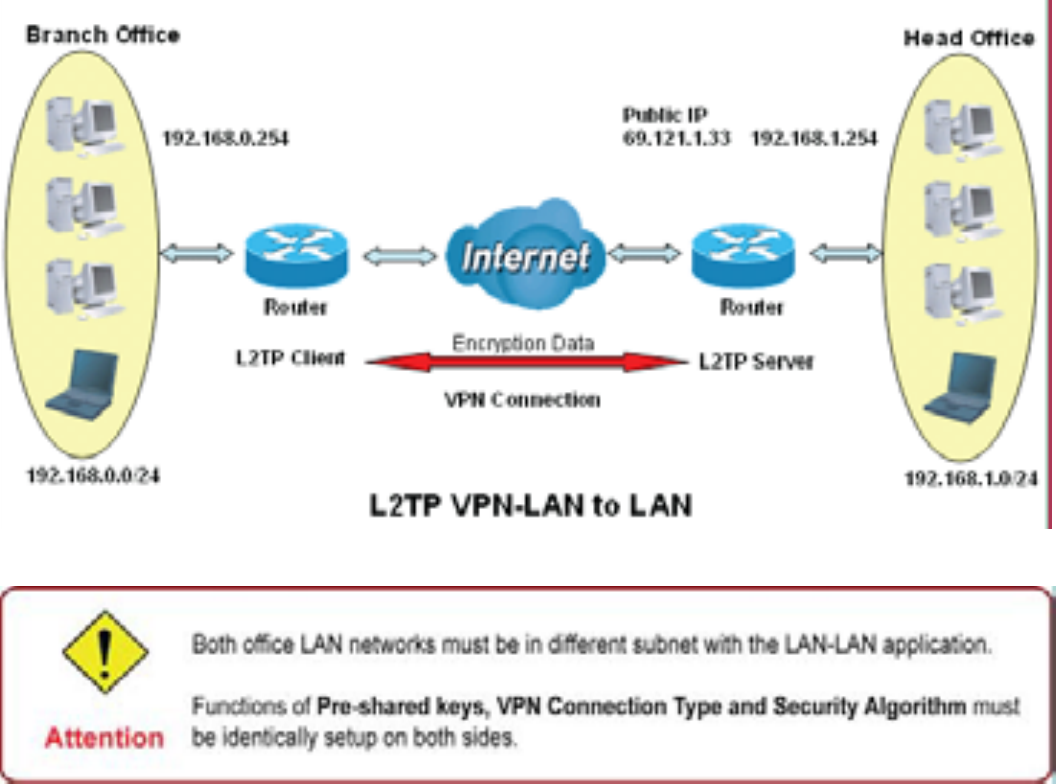
136
Example: Configuring L2TP LAN-to-LAN VPN Connection
The branch office establishes a L2TP VPN tunnel with head office to connect two private networks
over the Internet. The routers are installed in the head office and branch office accordingly.
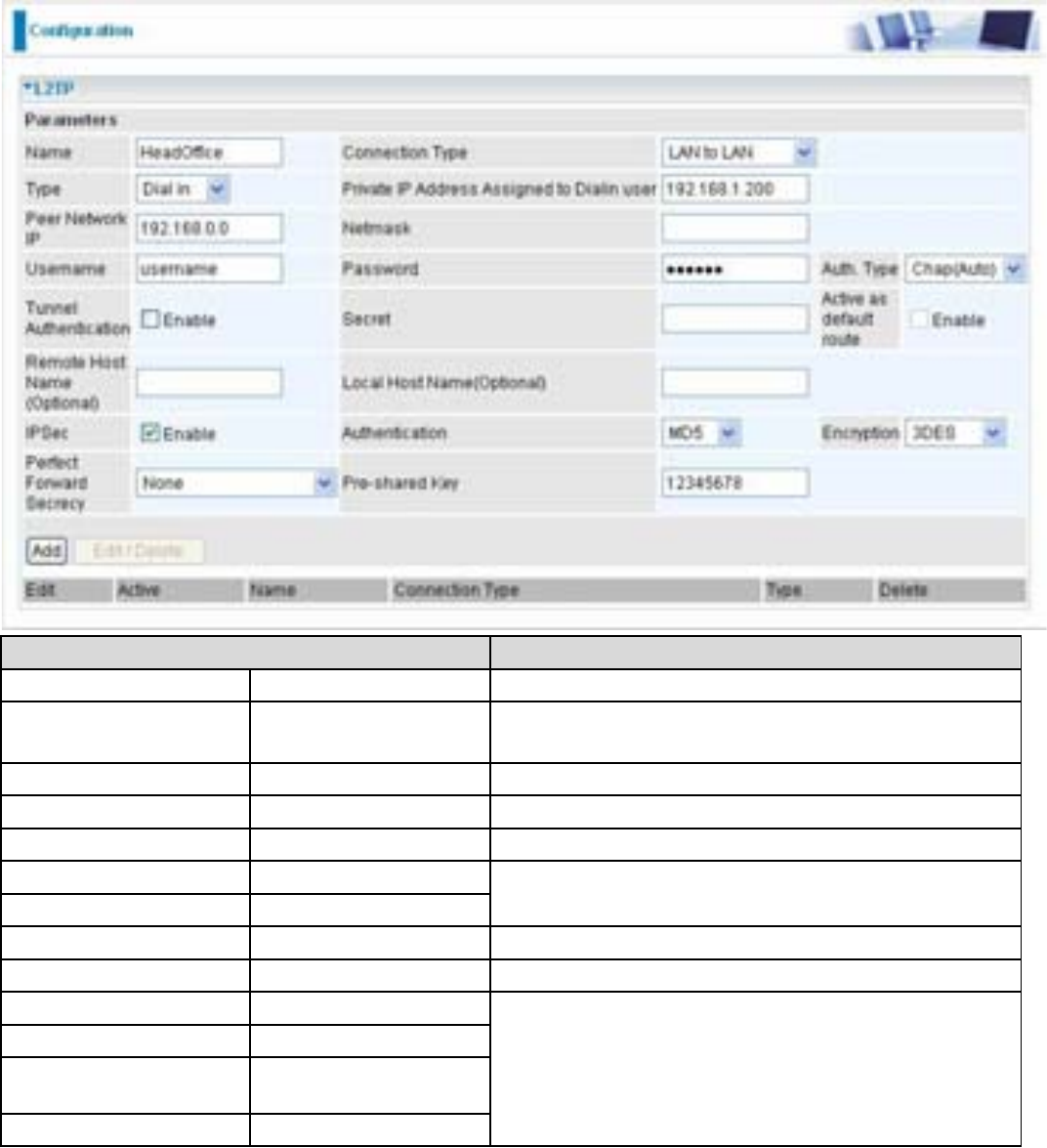
137
Configuring L2TP VPN in the Head Office
The IP address 192.168.1.200 will be assigned to the router located in the branch office. Please
make sure this IP is not used in the head office LAN.
Function Description
Name HeadOffice Give a name of L2TP Connection
Connection Type LAN to LAN Select LAN to LAN from the Connection Type
drop-down menu
Type Dial in Select Dial in from the Type drop down menu
IP Address 192.168.1.200 IP address assigned to branch office network
Peer Network IP 192.168.0.0 Branch office network
Username username
Password 123456
An assigned username and password to
authenticate branch office network
Auth. Type Chap (Auto) Keep this as the default value for most cases
IPSec Enable Enable this to enhance your L2TP VPN security
Authentication MD5
Encryption 3DES
Perfect Forward
Secrecy
None
Pre-Shared Key 12345678
Both sides should use the same value
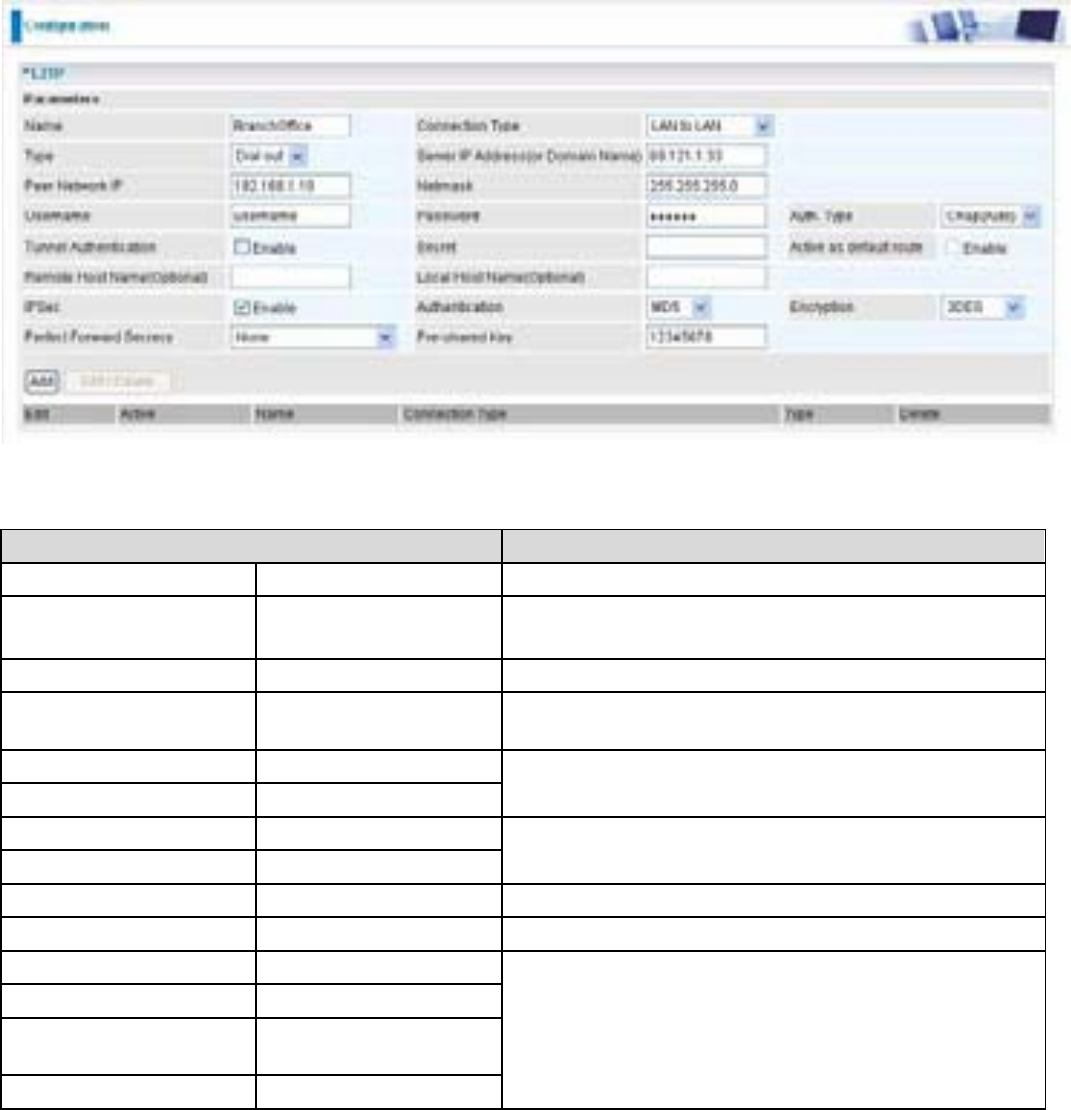
138
Configuring L2TP VPN in the Branch Office
The IP address 69.1.121.30 is the Public IP address of the router located in head office. If you
registered the DDNS (please refer to the DDNS section of this manual), you can also use the
domain name instead of the IP address to reach the router.
Function Description
Name BranchOffice Give a name of L2TP Connection
Connection Type LAN to LAN Select LAN to LAN from the Connection Type
drop-down menu
Type Dial out Select Dial out from the Type drop down menu
IP Address (or
Hostname)
69.121.1.33 IP address assigned to branch office network
Peer Network IP 192.168.1.0
Netmask 255.255.255.0
Head office network
Username username
Password 123456
An assigned username and password to
authenticate branch office network
Auth. Type Chap (Auto) Keep this as the default value for most cases
IPSec Enable Enable this to enhance your L2TP VPN security
Authentication MD5
Encryption 3DES
Perfect Forward
Secrecy
None
Pre-Shared Key 12345678
Both sides should use the same value

139
VoIP - Voice over Internet Protocol
VoIP enables telephone calls through existing Internet connection instead of going through the
PSTN (Public Switched Telephone Network). It is not only cost-effective, especially for a long
distance telephone charges, but also toll-quality voice calls over the Internet.
Here are the items within the VoIP section: SIP Device Parameters, SIP Accounts, Phone Port,
PSTN Dial Plan, VoIP Dial Plan, Call Features, Speed Dial and Ring &Tone.
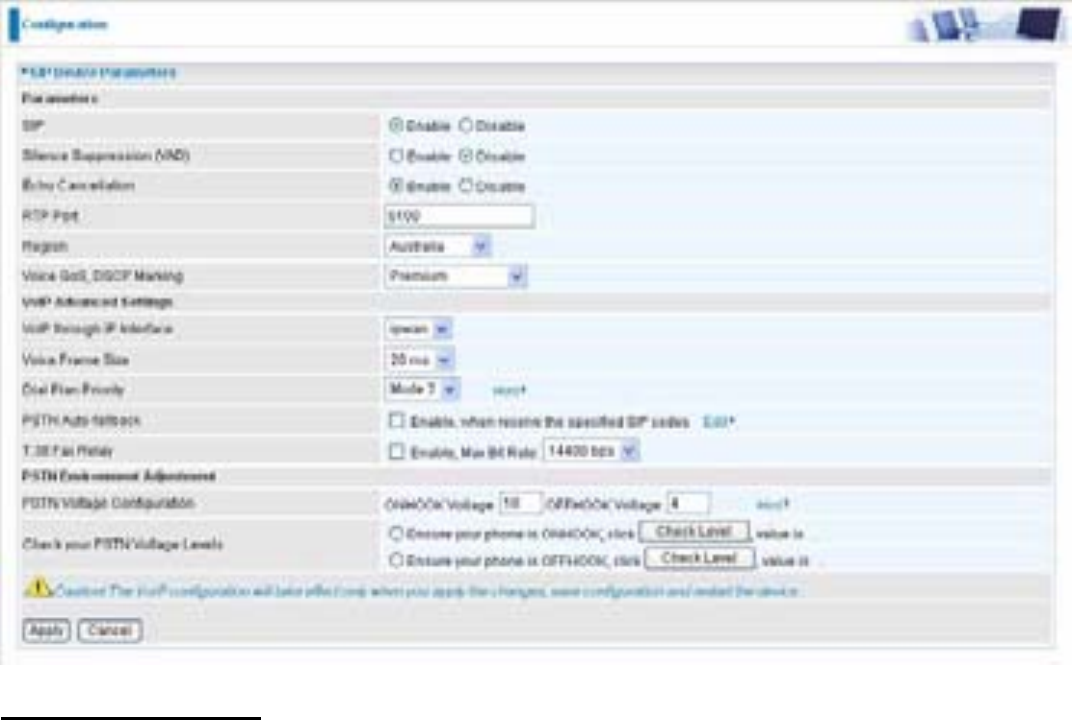
140
SIP Device Parameters
This section provides easy setup for your VoIP service. Phone port 1 and 2 can be registered to
different SIP Service Provider.
SIP Device Parameters
SIP: To use VoIP SIP as VoIP call signaling protocol. Default is set to Disable.
Silence Suppression (VAD): Voice Activation Detection (VAD) prevents transmitting the nature
silence to consume the bandwidth. It is also known as Silence Suppression which is a software
application that ensures the bandwidth is reserved only when voice activity is activated. Default is
set to Enable.
Echo Cancellation: G.168 echo canceller is an ITU-T standard. It is used for isolating the echo
while you are on the phone. This helps you not to hear much of your own voice reflecting on the
phone while you talk. Default is set to Enable.
RTP Port: Provide the based value from the media (RTP) ports that are assigned for various
endpoints and the different call sessions that may exist within an end-point. (Range from 5100 to
65535, default value is 5100)
Region: This selection is a drop-down box, which allows user to select the country for which the
VoIP device must work. When a country is selected, the country parameters are automatically
loaded.
Voice QoS, DSCP Marking: Differentiated Services Code Point (DSCP), it is the first 6 bits in
the ToS byte. DSCP Marking allows users to assign specific application traffic to be executed in
priority by the next Router based on the DSCP value. See Table 4. The DSCP Mapping Table:
Note: To be sure the router(s) in the backbones network have the capability in executing and
checking the DSCP through-out the QoS network.
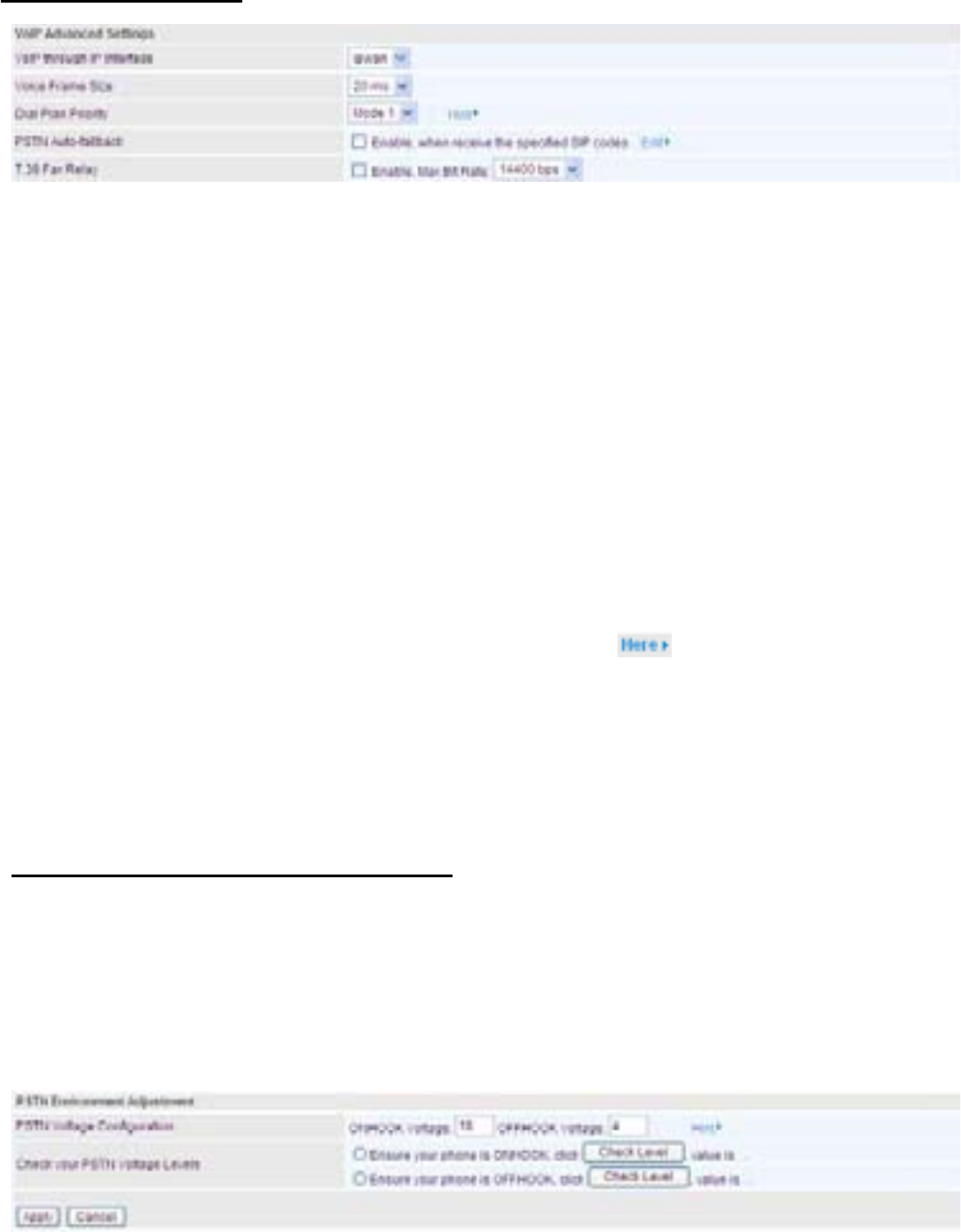
141
Advanced – Parameters
VoIP through IP Interface: IP Interface decides where to send/receive the voip traffic; it includes:
ipwan and iplan. Easy way to select the interface is to check the location of the SIP server. If
it locates some where in the Internet then select ipwan. If the VoIP SIP server is on the local
Network then select iplan.
Voice Frame Size: Frame size is available from 10ms to 60ms. Frame size meaning how many
milliseconds the Voice packets will be queued and sent out. It is ideal to have the same frame
size in both of Caller and Receiver.
Dial Plan Priority: Define the priority between VoIP and PSTN dial plan.
PSTN Auto-fallback: Whenever VoIP SIP responses error and error code matching with the
codes in the Edit section, the VoiP calls will automatically fallback to PSTN. In the other word, the
call will be called via the PSTN when VoIP SIP returns an error code.
Click the Edit to add or remove the responses code. To be sure the code is separated by a
comma (,).
For more information about SIP responses codes, please check to link to http://voip-info.
org/wiki/view/sip+response+codes where you can get to know the meaning of each error code.
T.38 Fax Relay: It allows the transfer of facsimile documents in real-time between two standard
Group 3 facsimile terminals over the Internet or other networks using IP protocols. It will only
function when both sites are support this feature and enabled.
Advanced – PSTN Environment Adjustment
PSTN Environment Adjustment options will help you to adjust the onhook and offhook voltage
detection values for your environment. You should use these if the default values are incorrect
and result in PSTN calls not being detected properly, e.g. calls being terminated within 5 seconds
of being answered. The actual levels are determined by your environment including the number
and type of telephones used.
Note: ONHOOK means hung up.
142
To take your phone OFFHOOK, lift the receiver then press Hook/Flash until you hear your normal
PSTN dialtone, not your VoIP dialtone. Wait several seconds and then press Check Level.
You should check the OFFHOOK value for each telephone you have connected to this device.
Set the OFFHOOK voltage to the lowest setting registered for all your telephones, e.g. if your
telephones return values of 4, 5 and 7 then you should set your OFFHOOK voltage to 4.
Note: The detected values will not automatically be set by the Check Level function; you
must enter the lowest level detected after testing all your telephones.
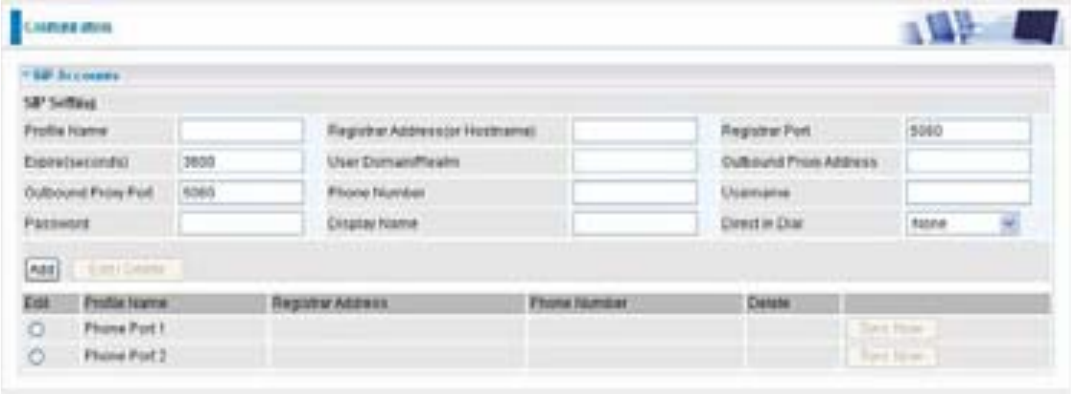
143
SIP Accounts
This section reflects and contains basic settings for the VoIP module from selected provider in the
Wizard section. Fail to provide correct information will halt making calls out to the Internet.
Profile Name: User-defined name is for identifying the Profile.
Registrar Address (or Hostname): Indicate the VoIP SIP registrar IP address.
Registrar Port: Specify the port of the VoIP SIP registrar on which it will listen for register
requests from VoIP device.
Expire: Expire time for the registration message sending.
User Domain/Realm: Set different domain name for the VoIP SIP proxy server.
Outbound Proxy Address: Indicate the VoIP SIP outbound proxy server IP address. This
parameter is very useful when VoIP device is behind a NAT.
Outbound Proxy Port: Specify the port of the VoIP SIP outbound proxy on which it will listen for
messages.
Phone Number: This parameter holds the registration ID of the user within the VoIP SIP registrar.
Username: Same as Phone Number.
Password: This parameter holds the password used for authentication within VoIP SIP registrar.
Display Name: This parameter will be appeared on the Caller ID.
Direct in Dial: Select the ringing port when getting an incoming VoIP call.
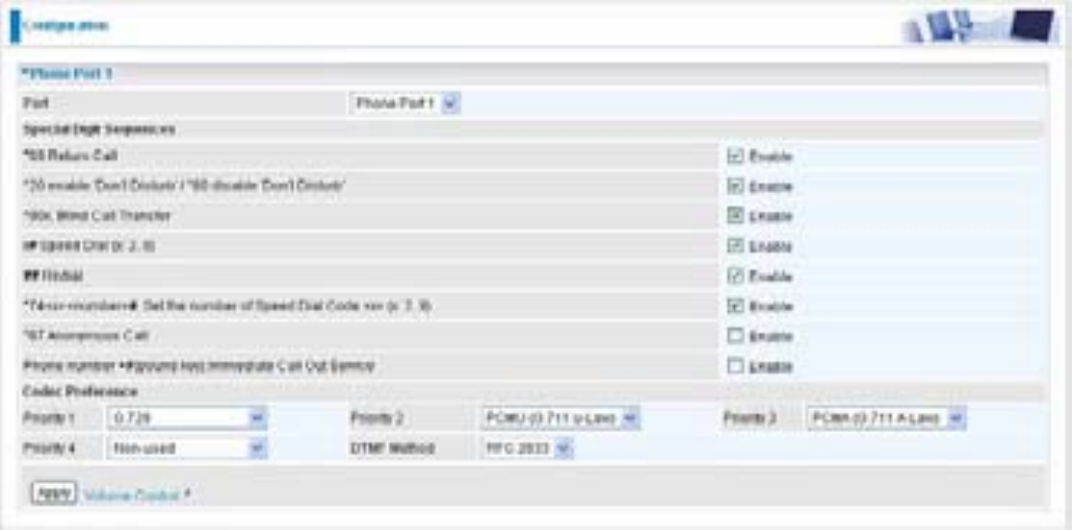
144
Phone Port
This section displays status and allows you to edit the account information of your Phones. Click
Edit to update your phone information.
Port: It allows you to change the phone port setting for specify FXS port.
*69 (Return Call): Dial *69 to return the last missed call. It is only available for VoIP call(s).
*20 (Do not Disturb ON): Dial *20 to set the No Disturb on. Your phone will not ring if someone
calls.
*80 (Do not Disturb OFF): Dial *80 to set the No Disturb off. Your will be able to hear ring tone
when someone calls.
*90x (Blind Call Transfer): Dial *90 + phone-number to translate a call to a third party. This
feature is enabled by default.
x# Speed Dial (x:2..9): Refer to Phone Port section in the Web GUI. Set up your Speed Dial
phone book first before accessing the Speed Dial feature. It is enabled by default.
## Redial: Press ## to redial the latest number you dialed. This feature is enabled by default.
*74<x><number>#: Use your phone key pad to insert a phone number to the Speed Dial phone
book. Or you can update your Speed Dial phone number manually. Refer to the Phone Port
section in the Web GUI for details.
*67 Anonymous Call: Hide the own phone number for each call and it will not be displayed on the
remote site. It is only applied to the next call when you enter this control character. The detailed
operation procedure is “Off Hook -> *67 -> On Hook -> Off Hook -> Dial”. This feature is disabled
by default.
Phone Number + #: This is the fast dial which you can dial out a phone number immediately
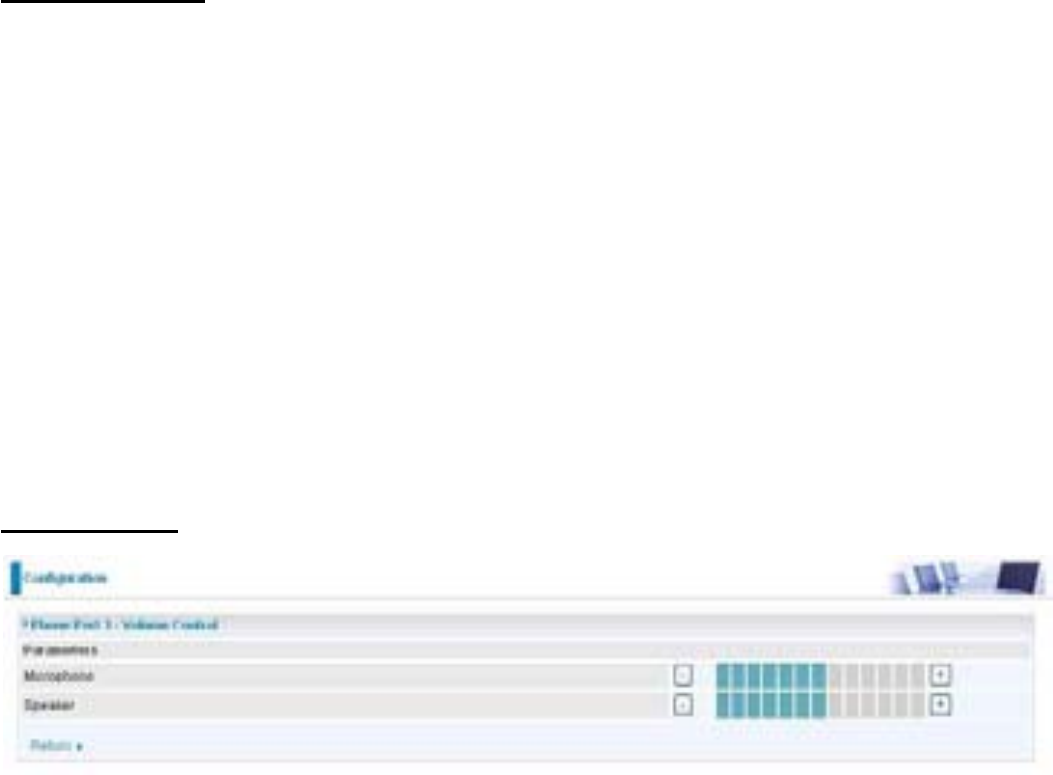
145
without waiting.
Note: Refer to Special Dial Code section in this Manual for more details.
Codec Preference
Codec is known as Coder-Decoder used for data signal conversion. Set the priority of voice
compression; Priority 1 owns the top priority.
G.729: It is used to encoder and decoder voice information into a single packet which reduces the
bandwidth consumption.
G.711ȝ-LAW: It is a basic non-compressed encoder and decoder technique. ȝ-LAW uses pulse
code modulation (PCM) encoder and decoder to convert 14-bit linear sample.
G.711A-LAW: It is a basic non-compressed encoder and decoder technique. A-LAW uses pulse
code modulation (PCM) encoder and decoder to convert 13-bit linear sample.
G.726-32: It is used to encoder and decoder voice information into a single packet which reduces
the bandwidth consumption. Currently only supports bit rate with 32Kbps.
DTMF Method: The Inband, RFC 2833 and SIP INFO (RFC 2976) are supported.
Volume Control
Volume control helps you to adjust the voice quality of telephone to the best comfortable listening
level.
Press “-“, the minus sign, to reduce either microphone or/both speaker’s level of your telephone.
Press “+“, the plus sign, to increase either microphone or/both speaker’s level of your telephone.
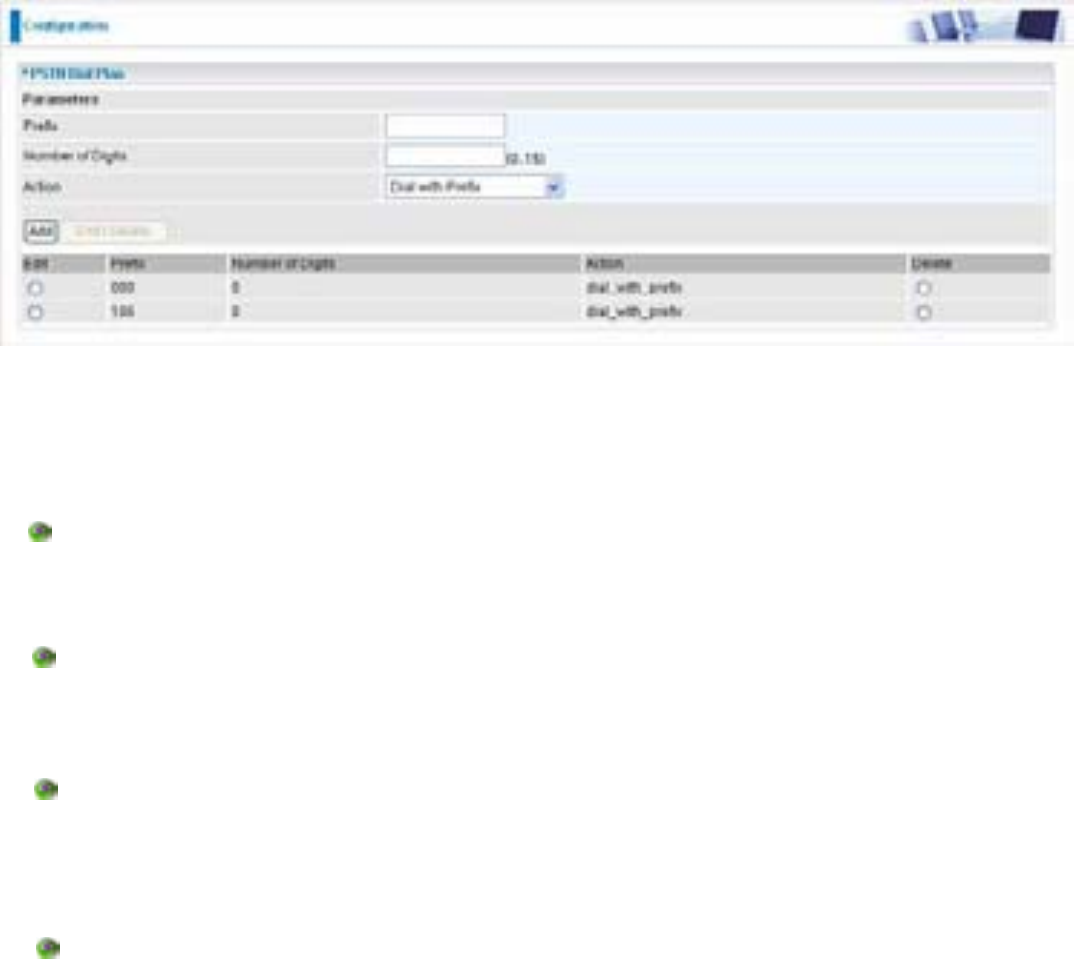
146
PSTN Dial Plan (Router with LINE port only)
This section enables you to configure “VoIP with PSTN switching” on your system. You can define
a range of dial plans to make regular call from VoIP switching to PSTN line. Prefix numbers is
essential key to make a distinguishing between VoIP and Regular phone call. If actual numbers
dialed matches with prefix number defined in this dial plan, the dialed number will be routed to the
PSTN to make a regular call. Otherwise, the number will be routed to the VoIP networks.
Reminder! In order to utilize this feature, you must have registered and connected to your
SIP Server first.
Prefix: Specify number(s) for switching to a PSTN call.
Number of Digits: Specify the total number of digits wish to dial out. Maximum digit number is 15.
Action: Specify a dialing method you wish to make PSTN call(s).
Dial with Prefix: The dialed number with prefix will be sent call through the PSTN.
Note: The actual dialed number of valid digits length requires matching in the Number of
Digits filed.
Dial without Prefix: The dialed number will be sent call through the PSTN without prefix.
Note: The actual dialed number of valid digits length requires matching in the Number of
Digits filed.
Dial at Timeout: The dialed number will be sent call through the PSTN with the prefix when
timeout starts. This timeout activates when no more digits are dialed in a specific duration.
Note: The actual dialed number of valid digits length MUST NOT exceed in the Number of
Digits filed.
Dial at Timeout no Prefix: The dialed number will be sent call through the PSTN without
prefix when timeout starts. This timeout activates when no more digits are dialed in a specific
duration.
Note: The actual dialed number of valid digits length MUST NOT exceed in the Number of
Digits filed.
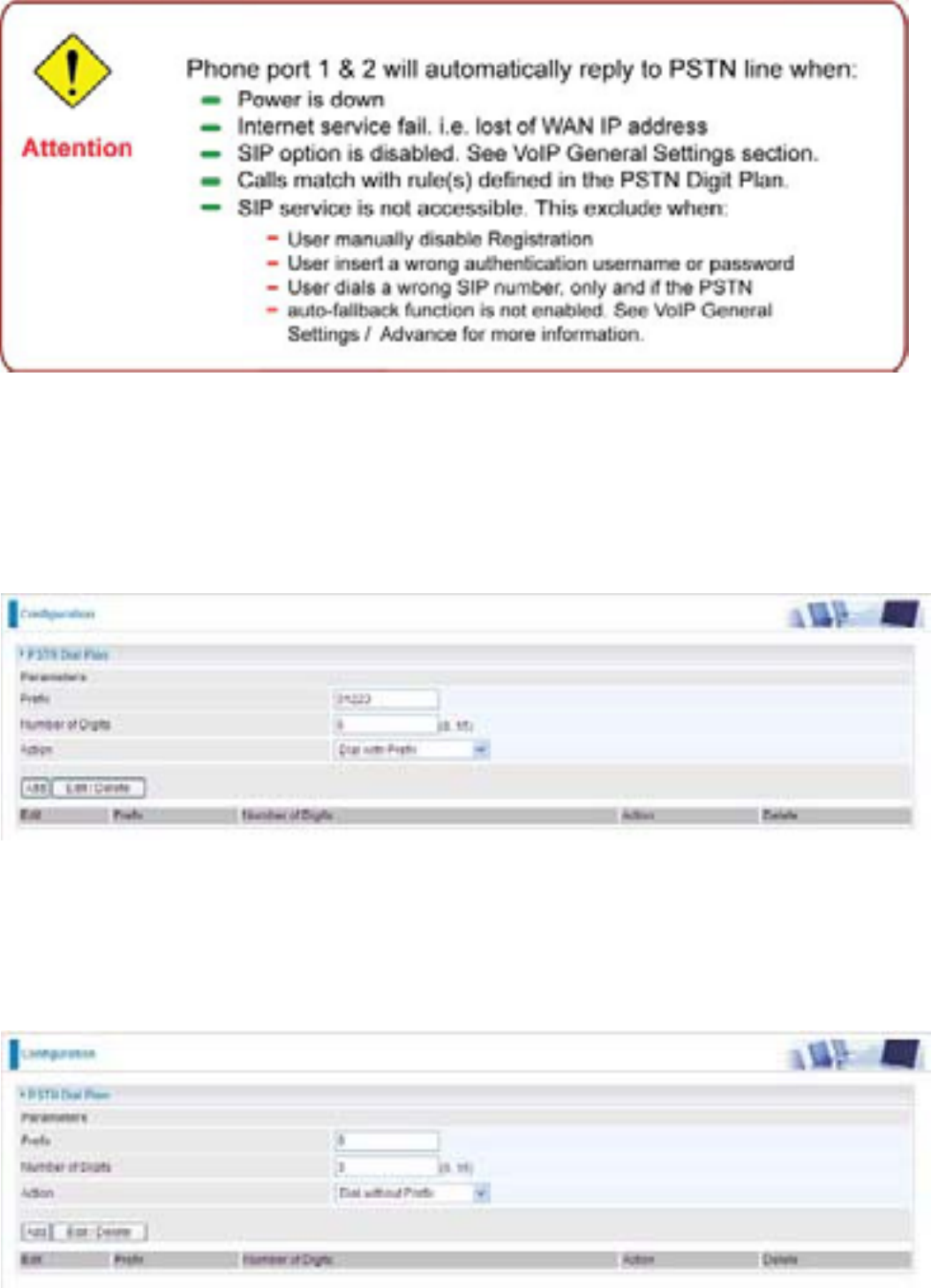
147
PSTN Dial Plan Examples:
˄ˁʳʳʳDial with Prefix
If you dial 01223 707070, number 01223707070 will be dialed out via FXO to make a regular phone
call.
˅ˁʳʳʳDial without Prefix
If you dial 9102, the number 102 will only be dialed out via FXO port to make a regular phone call.

148
ˆˁʳʳʳDial at Timeout
If you only dial 01223 7070 and no more numbers, after the timeout activates, 012237070 will be
dialed to make a regular call via FXO port.

149
Even though 7070 (only 4 digits) does not match with number of digits 6 defined in the filed, 7070
is still a valid phone number since it has not exceeded 6 digits.
ˇˁʳʳʳDial at Timeout no Prefix
If you only dial 97070 and no more numbers, after the timeout activates, 7070 will be dialed
without prefix to make a regular call via FXO port.
Even though 7070 (only 4 digits) does not match with number of digits 6 defined in the filed, 7070
is still a valid phone number since it has not exceed 6 digits.
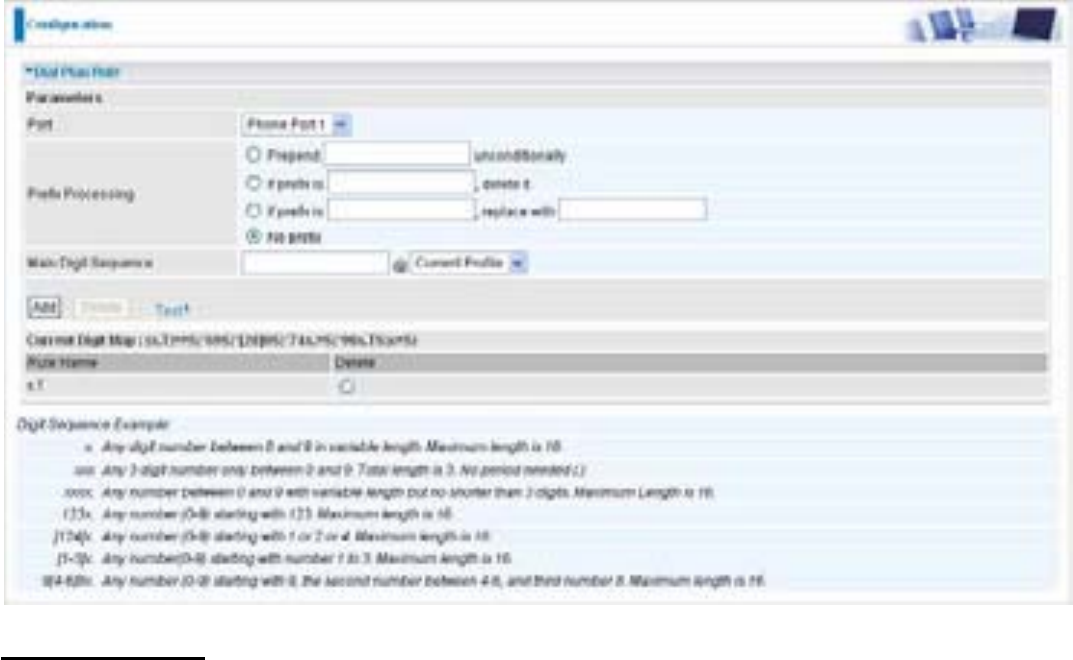
150
VoIP Dial Plan
This section helps you to make a telephony number dialed as making a regular call via VoIP.
You no longer need to memorize a long dial string of number for making a VoIP call. Go to
Configuration > VoIP > VoIP Dial Plan.
Dial Plan Rules
Click the Add button to create and define a VoIP dial-plan rule(s).
PrefixProcessing:
Prepend xxx unconditionally: xxx number is appended unconditionally to the front of the dialing
number when making a call. Prefix can also be included with any number and/or character such as
+,*, #.
Note: For special service with +, *, #, you may need to check with your VoIP or Local Telephone
Service Provider for information.
If Prefix is xxx, delete it: Prefix xxx is removed from the dialing numbers before making a call.
If Prefix is xxx, replace with: Prefix xxx is appended to the front of the dialing numbers when
making a call.
No prefix: No prefix is appended to the front of the dialing numbers. It is set as in default settings.

151
Main Digit Sequence: The call(s) can be called out via SIP or PSTN or ENUM.
x: Any numeric number between 0 and 9.
. ( period ): Repeat numeric number(s) between 0 and 9.
* (asterisk sign): It is normal character ‘*’ on phone key pad. Please check if special service(s) is
provided by your VoIP Service Provider or your Local Telephone Service Provider.
# (pound sign): It is normal character ‘#’ on phone key pad. Please check if it is provided by your
VoIP Service Provider or Local Telephone Service Provider for special service(s).
<@ Current Profile>: Referring to the VoIP account registered on the VoIP Wizard for Port 1 / 2.
<@ PSTN>: Meaning making call(s) via the PSTN line.
<@ENUM>: Meaning making a VoIP SIP direct call via E.164 number (“ENUM”) to an ENUM
callee.
Electronic Number (ENUM) uses the DNS (Domain Network System) based technology to map
between a traditional phone number (PSTN) to an Internet addresses/ SIP URL. The ENUM
number must be registered via a public ENUM site or your VoIP Service Provider.
<@ SIPgateway>: It is used for the Intelligent Call Routing feature where you need to set up
your SIP account on the VoIP User-defined Profiles link on the VoIP Wizard page. Go to the VoIP
Wizard in this manual for more information.
Dial-Plan Examples: Description
x. Any digit number between 0 and 9 in variable length. Maximum
length is 16.
xxx Any 3 digit number only between 0 and 9. Total length is 3.
Note: No period is needed (.)
xxxx. Any number between 0 and 9 with variable length but no shorter
than 3 digits. Maximum length is 16.
123x. Any number (0-9) starting with 123. Maximum length is 16.
[x…x]x.
For example: [124]x.
Any number (0-9) starting with 1 or 2 or 4. Maximum length is
16.
[x-x]x.
For example: [1-3]x.
Any number (0-9) starting with number 1 to 3. Maximum length is
16.
x[x-x]x.
For example: 9[4-6]8x.
Any number (0-9) starting with 9, the second number between
4-6, and third number 8. Maximum length is 16.
Special Dial Plan
Examples: Description
*xx*x. Starting with ‘* sign’ + any two digit numbers + any number (0-9)
in variable length. Maximum length is 16.
*xx
Starting with ‘* sign’ + any 2 digit numbers between 0 and 9. Total
length including the * is 3.
Note: No period is needed (.)

152
**xx*x. Starting with ‘** sign’ + any two digit numbers between 0 + any
number (0-9) in variable length. Maximum length is 16.
#xx. Starting with ‘# sign’ + any digit number (0-9) in variable length
but no shorter than 1 digits. Maximum length is 16.
##xx*x. Starting with ‘## sign’ + any two digit numbers + ‘* sign’ + any
number (0-9) in variable length. Maximum length is 16.
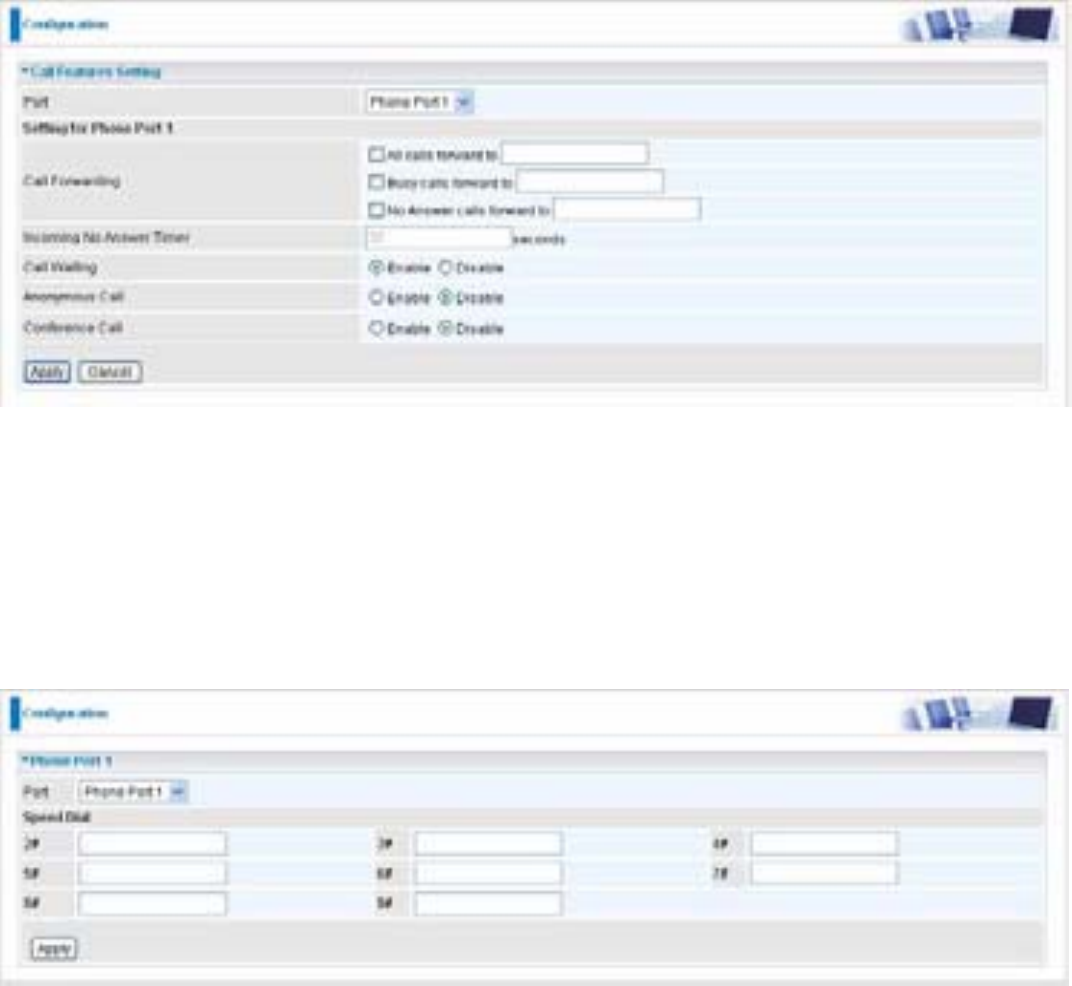
153
Call Feature
VoIP has all the basic features of a traditional phone. Besides the provided basic features, VoIP
also comes with several enhanced features that allows you to further customize their settings to
suit your personal needs such as call forwarding setting, call waiting time length, conference call
feature, anonymous call feature and incoming no answer timer.
Speed Dial
Speed Dial comes in handy to store frequently used telephone numbers which you can press
number from 0 to 9 and the pound sign (#) on the phone keypad to activate the function. For
example, speed dial to phone number lists on 9, just press keypad 9 then #. Your router will
automatically call out to number listed on entry 9.
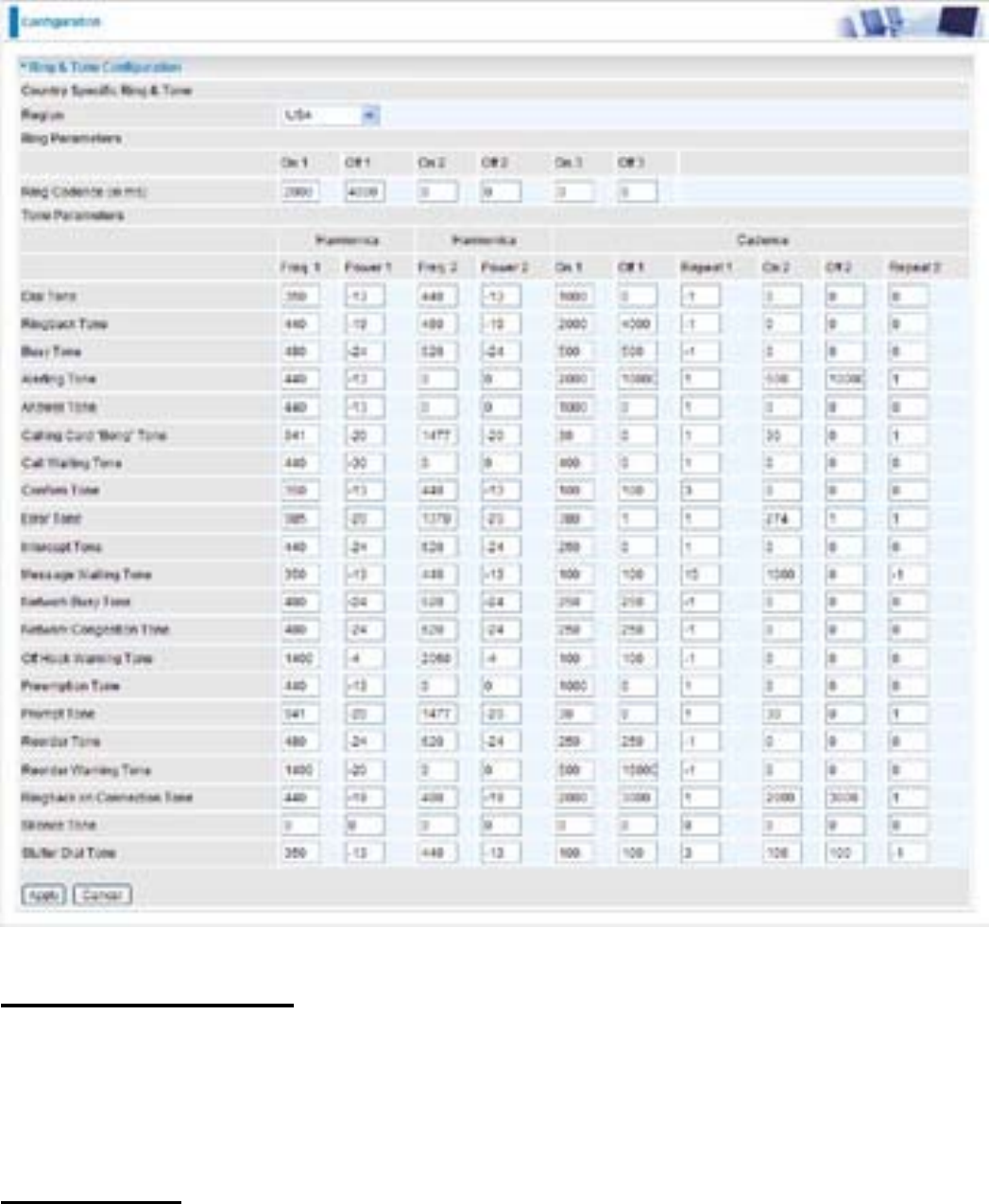
154
Ring & Tone
This section allows advanced user to change the existing or newly defined parameters for the
various ring tones (dial tone, busy tone, answer tone and etc.)
Country Specific Ring&Tone
Region: Select a country ring-tone, from the drop-down list, where you are located. This VoIP
router provides default parameter of ring tones according to different countries. The ring-tone
parameters are automatically displayed after entering a specific country. If your country is not in
the list, you may manually create ring-tone parameters.
Ring Parameters
Ring Cadence (in ms): Ring cadence is defined by three fields, Frequency: On Time1, Off Time1,
On Time2, Off Time2 and On Time3, Off Time3. Frequency is specified in Hertz. Time is given in
milliseconds.

155
Tone Parameters
You may need to check with your local telephone service provider for such information. Also, it is
recommended that this option be configured by advanced user unless you are instructed to do so.
Click Apply to apply the settings.
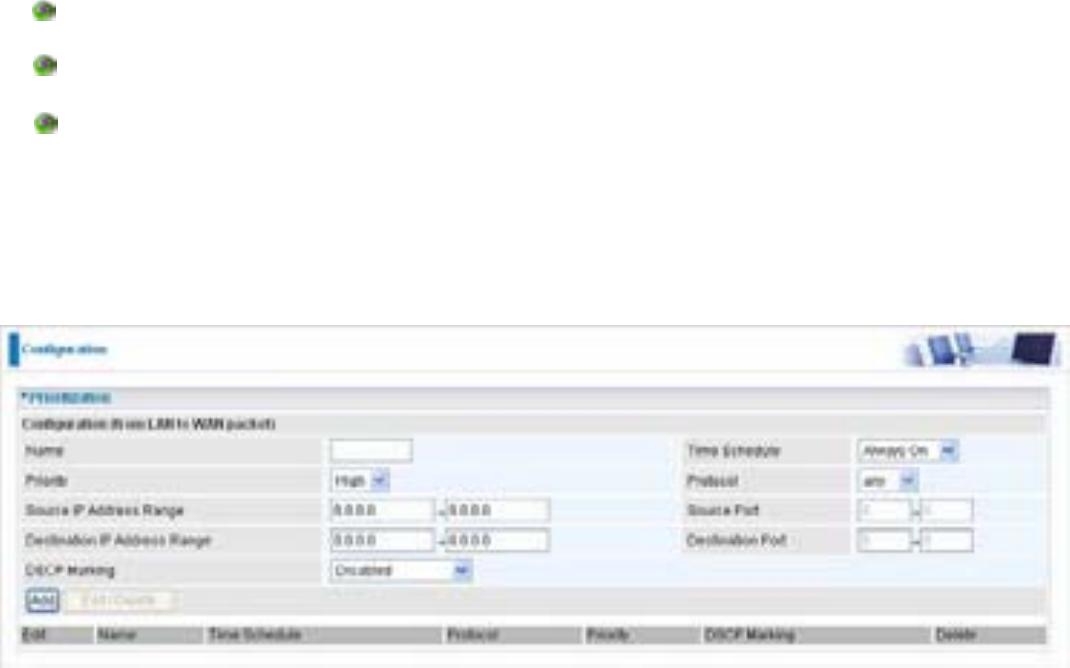
156
QoS - Quality of Service
QoS function helps you to control your network traffic for each application from LAN (Ethernet
and/or Wireless) to WAN (Internet). It facilitates you to control the different quality and speed of
through put for each application when the system is running with full loading of upstream.
Here are the items within the QoS section: Prioritization, Outbound IP Throttling & Inbound IP
Throttling (bandwidth management).
Prioritization
There are three priority settings to be provided in the Router:
High
Normal (The default is normal priority for all of traffic without setting)
Low
And the balances of utilization for each priority are High (60%), Normal (30%) and Low (10%).
To delete the application, you can choose Delete option and then click Edit/Delete.
Name: User-define description to identify this new policy/application.
Time Schedule: Scheduling your prioritization policy.
Priority: The priority given to each policy/application. Its default setting is set to High; you may
adjust this setting to fit your policy/application.
Protocol: The name of supported protocol.
Source IP Address Range: The source IP address or range of packets to be monitored.
Source Port: The source port of packets to be monitored.
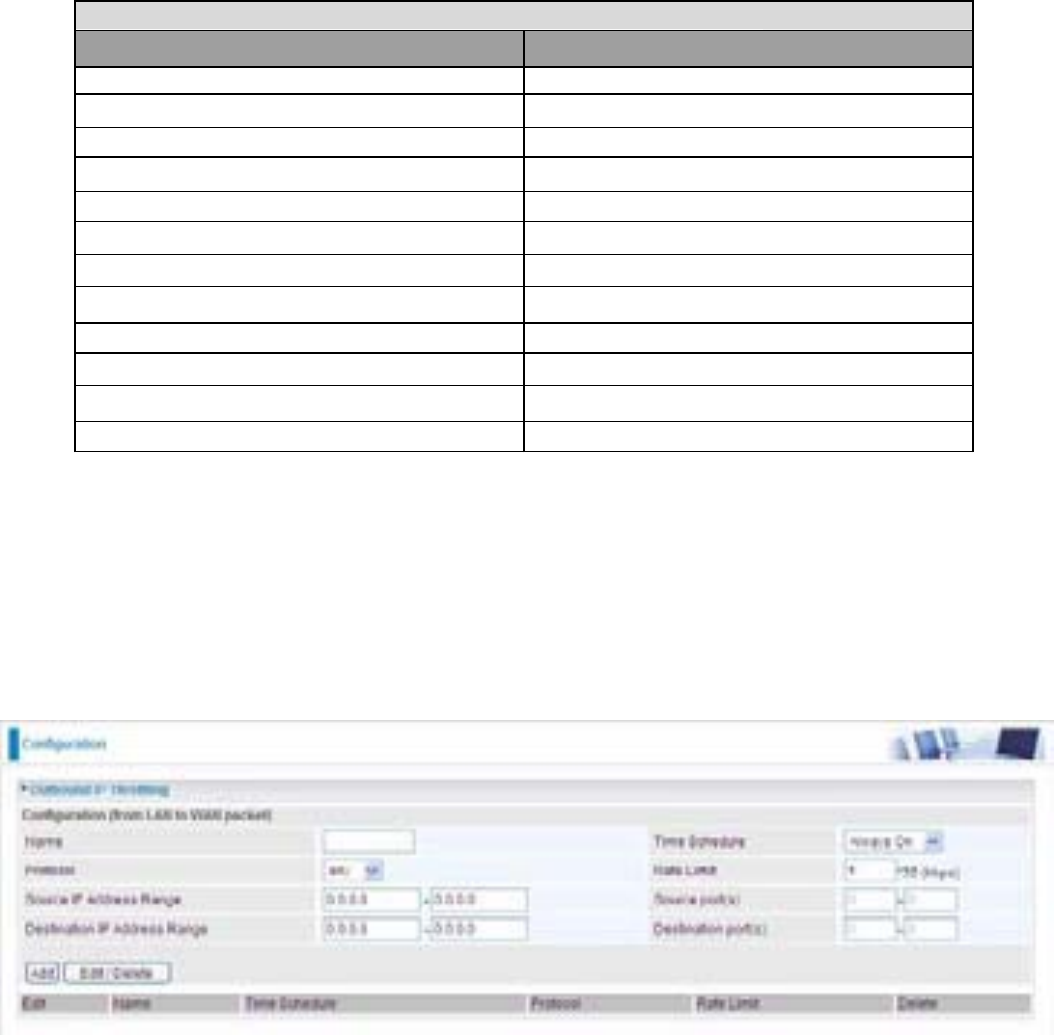
157
Destination IP address Range: The destination IP address or range of packets to be monitored.
Destination Port: The destination port of packets to be monitored.
DSCP Marking: Differentiated Services Code Point (DSCP), it is the first 6 bits in the ToS byte.
DSCP Marking allows users to assign specific application traffic to be executed in priority by the
next Router based on the DSCP value. See Table 4 for DSCP Mapping Table.
Note: To be sure the router(s) in the backbones network have the capability in executing and
checking the DSCP through-out the QoS network.
Table 4: DSCP Mapping Table
DSCP Mapping Table
(Wireless) ADSL Router Standard DSCP
Disabled None
Best Effort Best Effort (000000)
Premium Express Forwarding (101110)
Gold service (L) Class 1, Gold (001010)
Gold service (M) Class 1, Silver (001100)
Gold service (H) Class 1, Bronze (001110)
Silver service (L) Class 2, Gold (010010)
Silver service (M) Class 2, Silver (010100)
Silver service (H) Class 2, Bronze (010110)
Bronze service (L) Class 3, Gold (011010)
Bronze service (M) Class 3, Silver (011100)
Bronze service (H) Class 3, Bronze (011110)
Outbound IP Throttling (LAN to WAN)
IP Throttling allows you to limit the speed of IP traffic. The value entered will limit the speed of the
application that you set to the specified value’s multiple of 32kbps.
Name: User-define description to identify this new policy/name.
Time Schedule: Scheduling your prioritization policy. Refer to Time Schedule for more
158
information.
Protocol: The name of supported protocol.
Rate Limit: To limit the speed of outbound traffic
Source IP Address Range: The source IP address or range of packets to be monitored.
Source Port(s): The source port of packets to be monitored.
Destination IP Address Range: The destination IP address or range of packets to be monitored.
Destination Port(s): The destination port of packets to be monitored.

159
Inbound IP Throttling (WAN to LAN)
IP Throttling allows you to limit the speed of IP traffic. The value entered will limit the speed of the
application that you set to the specified value’s multiple of 32kbps.
Name: User-define description to identify this new policy/application.
Time Schedule: Scheduling your prioritization policy. Refer to Time Schedule for more
information.
Protocol: The name of supported protocol.
Rate Limit: To limit the speed of for inbound traffic.
Source IP Address Range: The source IP address or range of packets to be monitored.
Source Port(s): The source port of packets to be monitored.
Destination IP Address Range: The destination IP address or range of packets to be monitored.
Destination Port(s): The destination port of packets to be monitored.
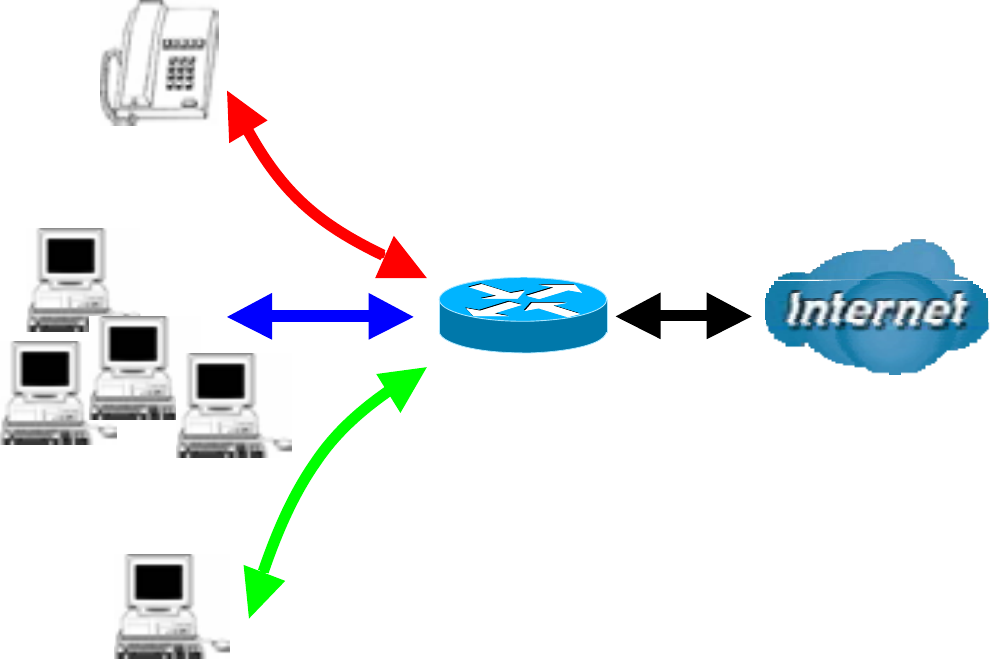
160
Example: QoS for your Network
Connection Diagram
VoIP
Normal PCs
Restricted PC
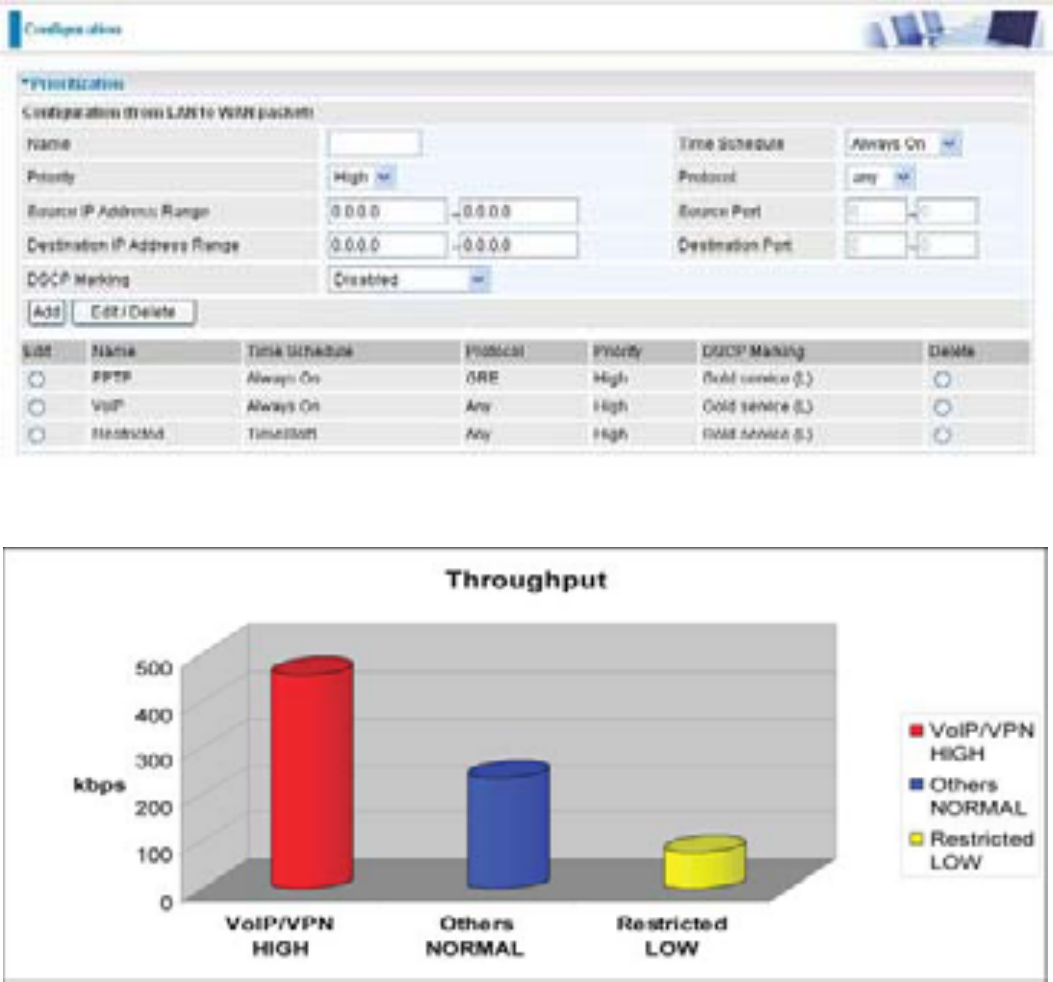
161
Information and Settings
Upstream: 928 kbps
Downstream: 8 Mbps
VoIP User : 192.168.1.1
Normal Users : 192.168.1.2~192.168.1.5
Restricted User: 192.168.1.100
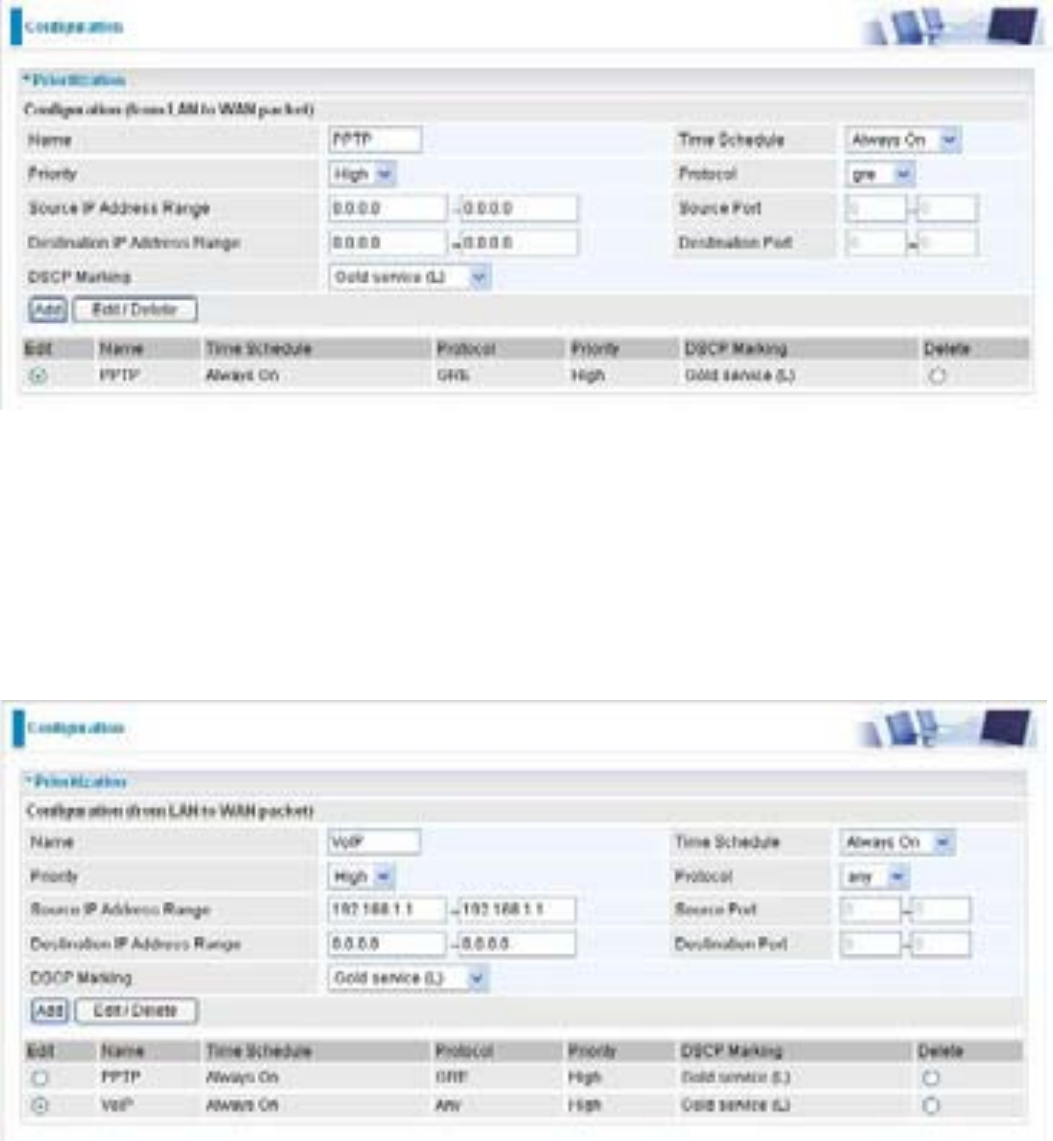
162
Mission-critical application
Mostly the VPN connection is mission-critical application for doing data exchange between head
and branch office.
The mission-critical application must be sent out smoothly without any dropping. Set priority as
high level for preventing any other applications to saturate the bandwidth.
Voice application
Voice is latency-sensitive application. Most VoIP devices are use SIP protocol and the port number
will be assigned by SIP module automatically. Better to use fixed IP address for catching VoIP
packets as high priority.
Above settings will help to improve quality of your VoIP service when traffic is full loading.
Restricted Application
Some of companies will setup FTP server for customer downloading or home user sharing their
files by using FTP.
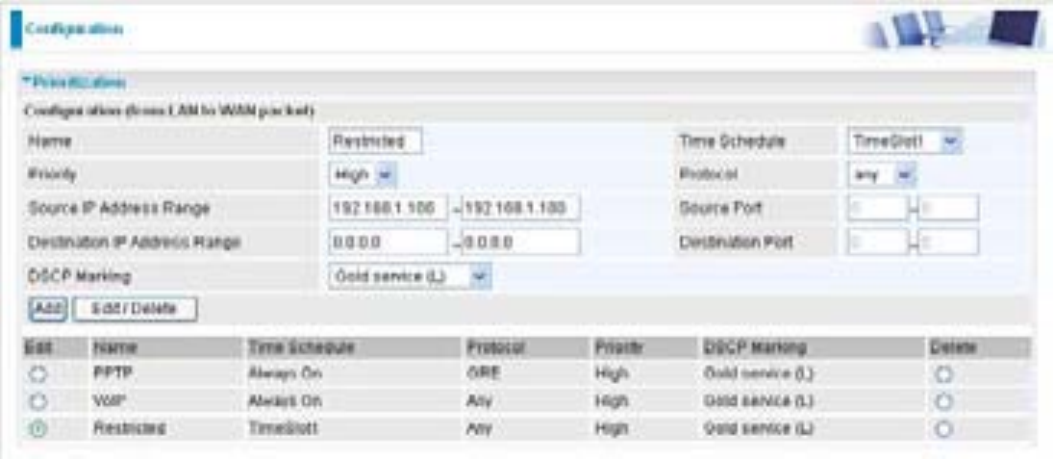
163
With above settings that help to limit utilization of upstream of FTP. Time schedule also help you to
only limit utilization at daytime.
Advanced setting by using IP throttling
With IP throttling you can specify more detail for allocating bandwidth; even the applications are
located in the same level.
Upstream: 928kbps (29*32kbps)
Mission-critical Application: 192kbps (6*32kbps)
Voice Application: 128kbps (4*32kbps)
Restricted Application: 160kbps (5*32kbps)
Other Applications: 448kbps (14*32kbps)
6+4+14+5=29, 29*32kbps=928kbps
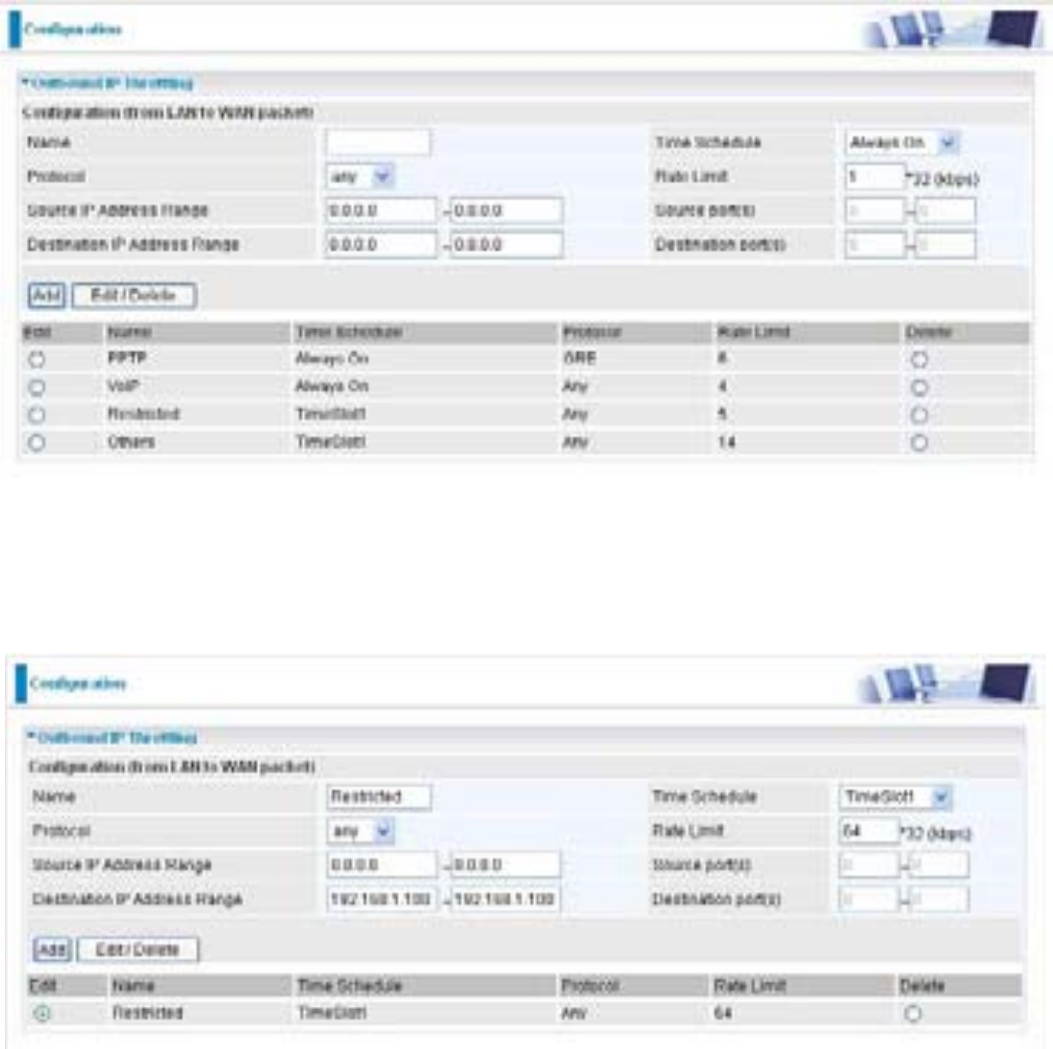
164
Sometime your customers or friends may upload their files to your FTP server and that will
saturate your downstream bandwidth. The settings below help you to limit bandwidth for the
restricted application.

165
Virtual Server (known as Port Forwarding)
In TCP/IP and UDP networks a port is a 16-bit number used to identify which application program
(usually a server) incoming connections should be delivered to. Some ports have numbers that
are pre-assigned to them by the IANA (the Internet Assigned Numbers Authority), and these are
referred to as “well-known ports”. Servers follow the well-known port assignments so clients can
locate them.
If you wish to run a server on your network that can be accessed from the WAN (i.e. from other
machines on the Internet that are outside your local network), or any application that can accept
incoming connections (e.g. Peer-to-peer/P2P software such as instant messaging applications
and P2P file-sharing applications) and are using NAT (Network Address Translation), then you will
usually need to configure your router to forward these incoming connection attempts using specific
ports to the PC on your network running the application. You will also need to use port forwarding
if you want to host an online game server.
The reason for this is that when using NAT, your publicly accessible IP address will be used by and
point to your router, which then needs to deliver all traffic to the private IP addresses used by your
PCs. Please see the WAN configuration section of this manual for more information on NAT.
The device can be configured as a virtual server so that remote users accessing services such
as Web or FTP services via the public (WAN) IP address can be automatically redirected to local
servers in the LAN network. Depending on the requested service (TCP/UDP port number), the
device redirects the external service request to the appropriate server within the LAN network
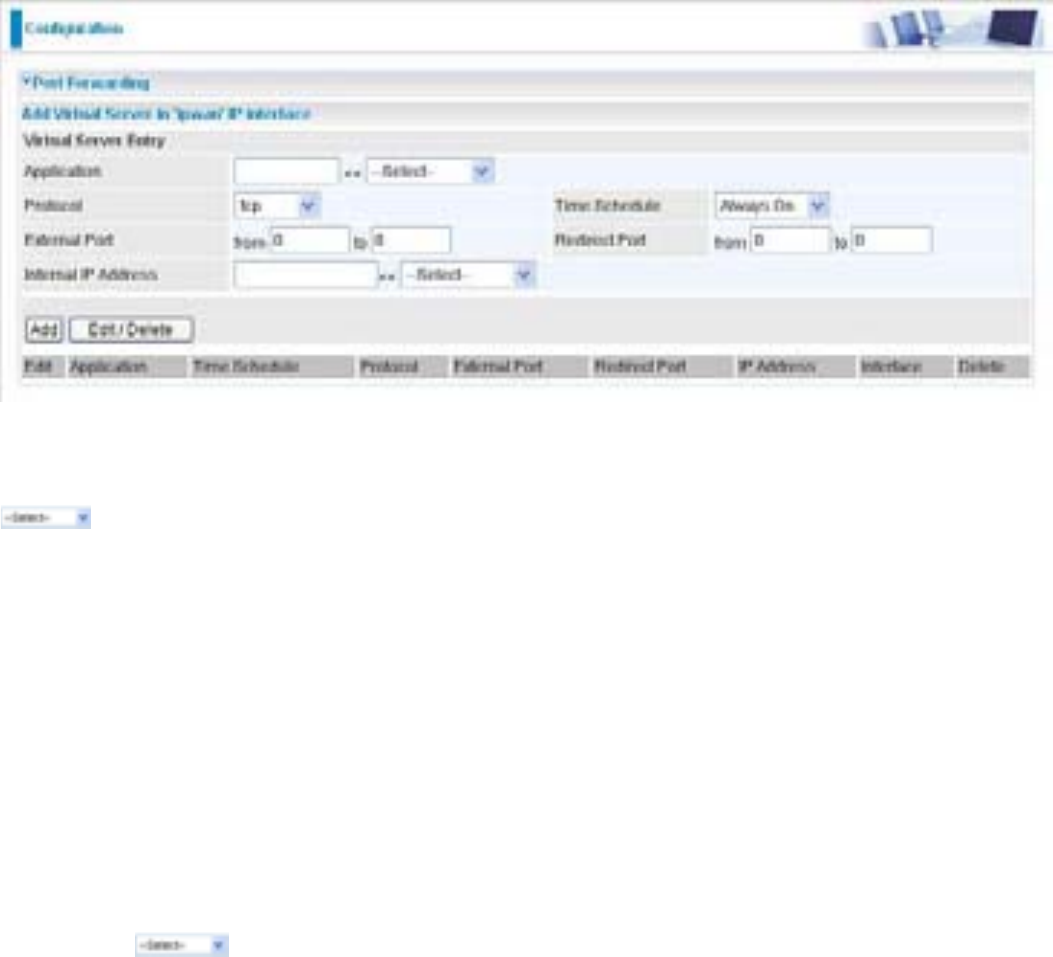
166
Porting Forwarding
Because NAT can act as a “natural” Internet firewall, your router protects your network from being
accessed by outside users when using NAT, as all incoming connection attempts will point to your
router unless you specifically create Virtual Server entries to forward those ports to a PC on your
network.
When your router needs to allow outside users to access internal servers, e.g. a web server, FTP
server, Email server or game server, the router can act as a “virtual server”. You can set up a local
server with a specific port number for the service to use, e.g. web/HTTP (port 80), FTP (port 21),
Telnet (port 23), SMTP (port 25), or POP3 (port 110), When an incoming access request to the
router for a specified port is received, it will be forwarded to the corresponding internal server.
Application: Users-define description to identify this entry or click the Application drop-down menu
to select an existing predefined rules.
:20 predefined rules are available. Application, Protocol and External/Redirect Ports will
be filled after the selection.
Protocol: It is the supported protocol for the virtual server. In addition to specifying the port
number to be used, you will also need to specify the protocol used. The protocol used is
determined by the particular application. Most applications will use TCP or UDP.
Time Schedule: User-defined time period to enable your virtual server. You may specify a time
schedule or Always on for the usage of this Virtual Server Entry. For setup and detail, refer to
Time Schedule section
External Port: The Port number on the Remote/WAN side used when accessing the virtual server.
Redirect Port: The Port number used by the Local server in the LAN network.
Internal IP Address: The private IP in the LAN network, which will be providing the virtual server
application. List all existing PCs connecting to the network. You may assign a PC with IP
address and MAC from this list.
Example:
If you like to remote accessing your Router through the Web/HTTP at all time, you would need to
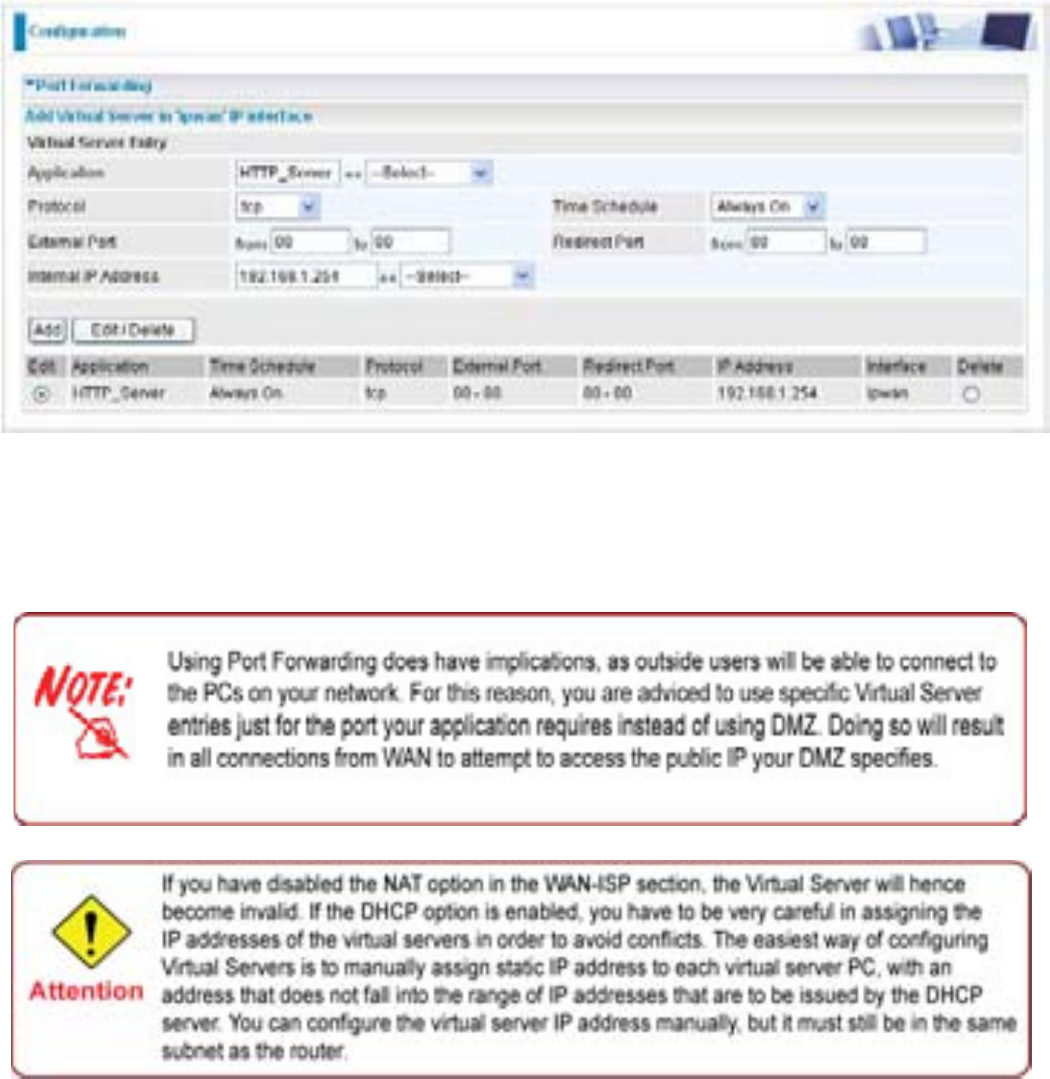
167
enable port number 80 (Web/HTTP) and map to Router’s IP Address. Then all incoming HTTP
requests from you (Remote side) will be forwarded to the Router with IP address of 192.168.1.254.
Since port number 80 has already been predefined, next to the Application click Helper. A list of
predefined rules window will pop and select HTTP_Sever.
Application: HTTP_Sever
Time Schedule: Always On
Protocol: tcp
External Port: 80-80
Redirect Port: 80-80
IP Address: 192.168.1.254
Add: Click it to apply your settings.
Edit/Delete: Click it to edit or delete this virtual server application.
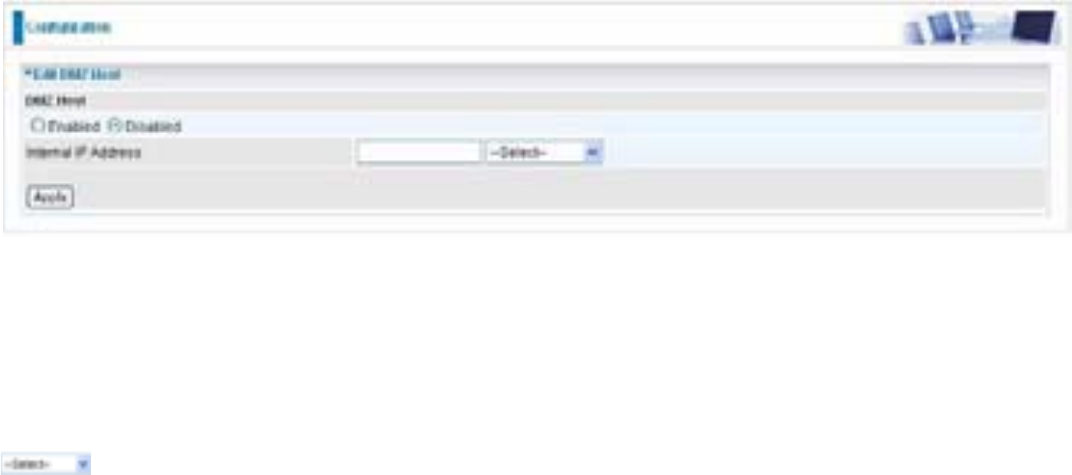
168
Edit DMZ Host
The DMZ Host is a local computer exposed to the Internet. When setting a particular internal
IP address as the DMZ Host, all incoming packets will be checked by the Firewall and NAT
algorithms then passed to the DMZ host, when a packet received does not use a port number
used by any other Virtual Server entries.
Cautious: This Local computer exposing to the Internet may face varies of security risks.
Go to Configuration > Virtual Server > Edit DMZ Host
Enabled: It activates your DMZ function.
Disabled: As set in default setting, it disables the DMZ function.
Internal IP Address: Give a static IP address to the DMZ Host when Enabled radio button is
checked. Be aware that this IP will be exposed to the WAN/Internet.
this list.
List all existing PCs connecting to the network. You may assign a PC with IP address from
Select the Apply button to apply your changes.
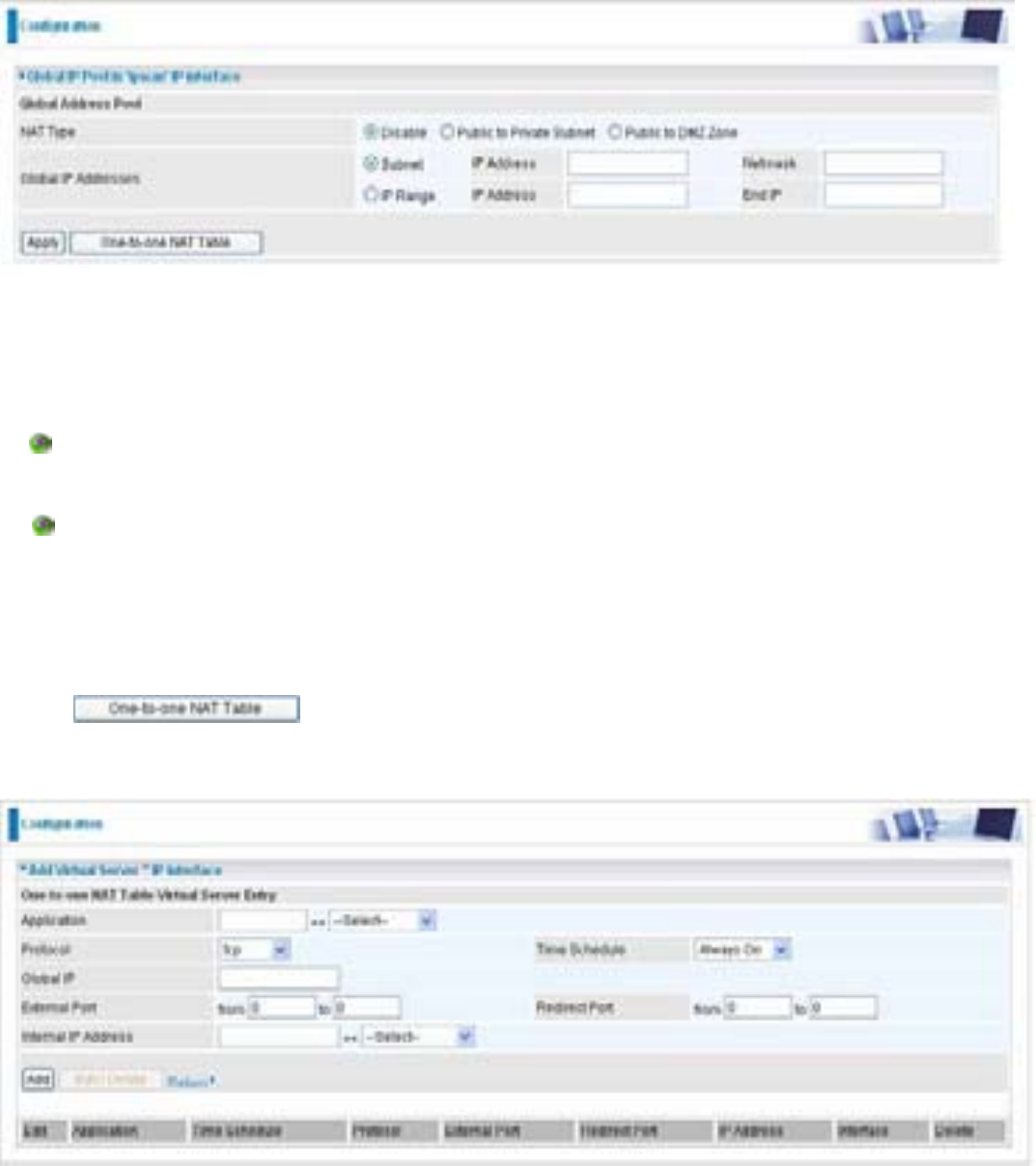
169
Edit One-to-One NAT (Network Address Translation)
One-to-One NAT maps a specific private/local IP address to a global/public IP address.
If you have multiple public/WAN IP addresses from you ISP, you are eligible for One-to-One NAT
to utilize these IP addresses.
Go to Configuration > Virtual Server > Edit One-to-one NAT
NAT Type: Select desired NAT type. As set in default setting, it disables the One-to-One NAT
function.
Global IP Address:
Subnet: The subnet of the public/WAN IP address given by your ISP. If your ISP has pro-
vided this information, you may insert it here. Otherwise, use IP Range method.
IP Range: The IP address range of your public/WAN IP addresses. For example, IP:
192.168.1.1, end IP: 192.168.1.10
Select the Apply button to apply your changes.
Check to create a new One-to-One NAT rule:

170
Application: Users-defined description to identify this entry or click drop-down menu to
select existing predefined rules.
:20 predefined rules are available. Application, Protocol and External/Redirect Ports will
be filled after the selection.
Protocol: It is the supported protocol for the virtual server. In addition to specifying the port
number to be used, you will also need to specify the protocol used. The protocol used is
determined by the particular application. Most applications will use TCP or UDP;
Time Schedule: User-defined time period to enable your virtual server. You may specify a time
schedule or Always on for the usage of this Virtual Server Entry. For setup and detail, refer to
Time Schedule section
Global IP: Define a public/ WAN IP address for this Application to use. This Global IP address
must be defined in the Global IP Address.
External Port: The Port number on the Remote/WAN side used when accessing the virtual server.
Redirect Port: The Port number used by the Local server in the LAN network.
Internal IP Address: The private IP in the LAN network, which will be providing the virtual server
application. List all existing PCs connecting to the network. You may assign a PC with IP
address from this list.
Select the Add button to apply your changes.

171
Example: List of some well-known and registered port numbers.
The Internet Assigned Numbers Authority (IANA) is the central coordinator for the assignment
of unique parameter values for Internet protocols. Port numbers range from 0 to 65535, but only
ports numbers 0 to 1023 are reserved for privileged services and are designated as “well-known
ports” (Please refer to Table 5). The registered ports are numbered from 1024 through 49151.
The remaining ports, referred to as dynamic or private ports, are numbered from 49152 through
65535.
For further information, please see IANA’s website at http://www.iana.org/assignments/port-
numbers
For help on determining which private port numbers are used by common applications on this list,
please see the FAQs (Frequently Asked Questions) at http://www.billion.com
Table 5: Well-known and registered Ports
Port Number Protocol Description
20 TCP FTP Data
21 TCP FTP Control
22 TCP & UDP SSH Remote Login Protocol
23 TCP Telnet
25 TCP SMTP (Simple Mail Transfer Protocol)
53 TCP & UDP DNS (Domain Name Server)
69 UDP TFTP (Trivial File Transfer Protocol)
80 TCP World Wide Web HTTP
110 TCP POP3 (Post Office Protocol Version 3)
119 TCP NEWS (Network News Transfer Protocol)
123 UDP NTP (Network Time Protocol) / SNTP (Simple Network
Time Protocol)
161 TCP SNMP
443 TCP & UDP HTTPS
1503 TCP T.120
1720 TCP H.323
4000 TCP ICQ
7070 UDP RealAudio

172
Wake on LAN
Wake on LAN (WOL, sometimes WoL) is an Ethernet computer networking standard that allows a
computer to be turned on or woken up remotely by a network message.
Select: Select MAC address of the computer that you want to wake up or turn on remotely.
Add: After selecting, click Add then you can perform the Wake-up action.
Edit/Delete: Click to edit or delete the selected MAC address.
Ready:
“Yes” indicating the remote computer is ready for your waking up.
“No” indicating the machine is not ready for your waking up.
Delete: Delete the selected MAC address.
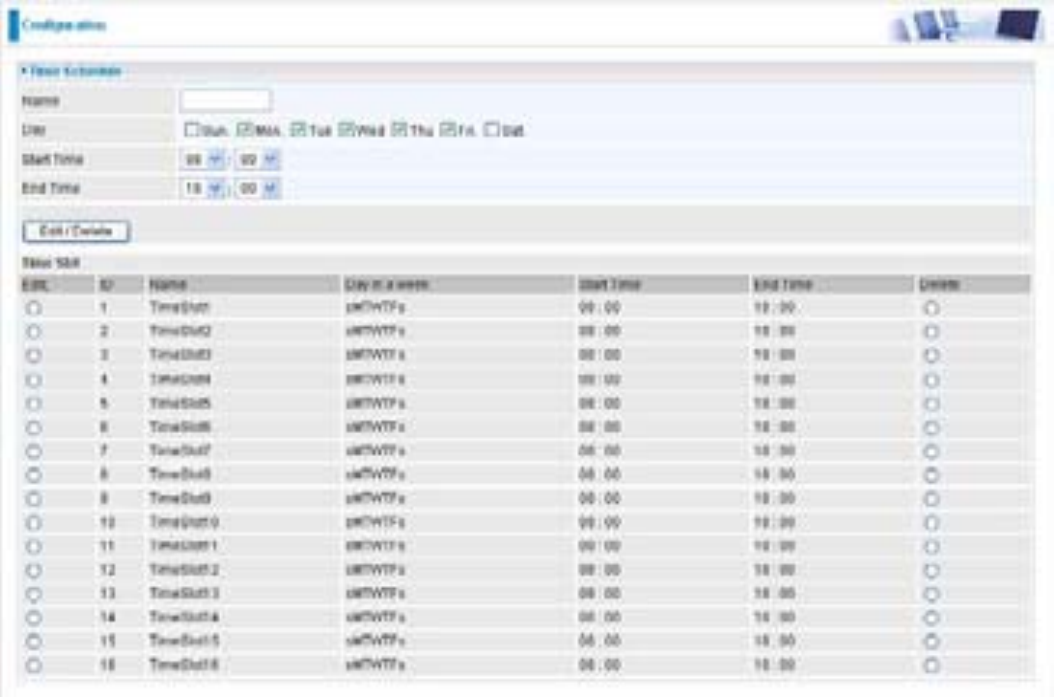
173
Time Schedule
The Time Schedule supports up to 16 time slots which helps you to manage your Internet
connection. In each time profile, you may schedule specific day(s) i.e. Monday through Sunday to
restrict or allowing the usage of the Internet by users or applications.
This Time Schedule correlates closely with router’s time, since router does not have a real time
clock on board; it uses the Simple Network Time Protocol (SNTP) to get the current time from an
SNTP server from the Internet. Refer to Time Zone for details. You router time should correspond
with your local time. If the time is not set correctly, your Time Schedule will not function properly.
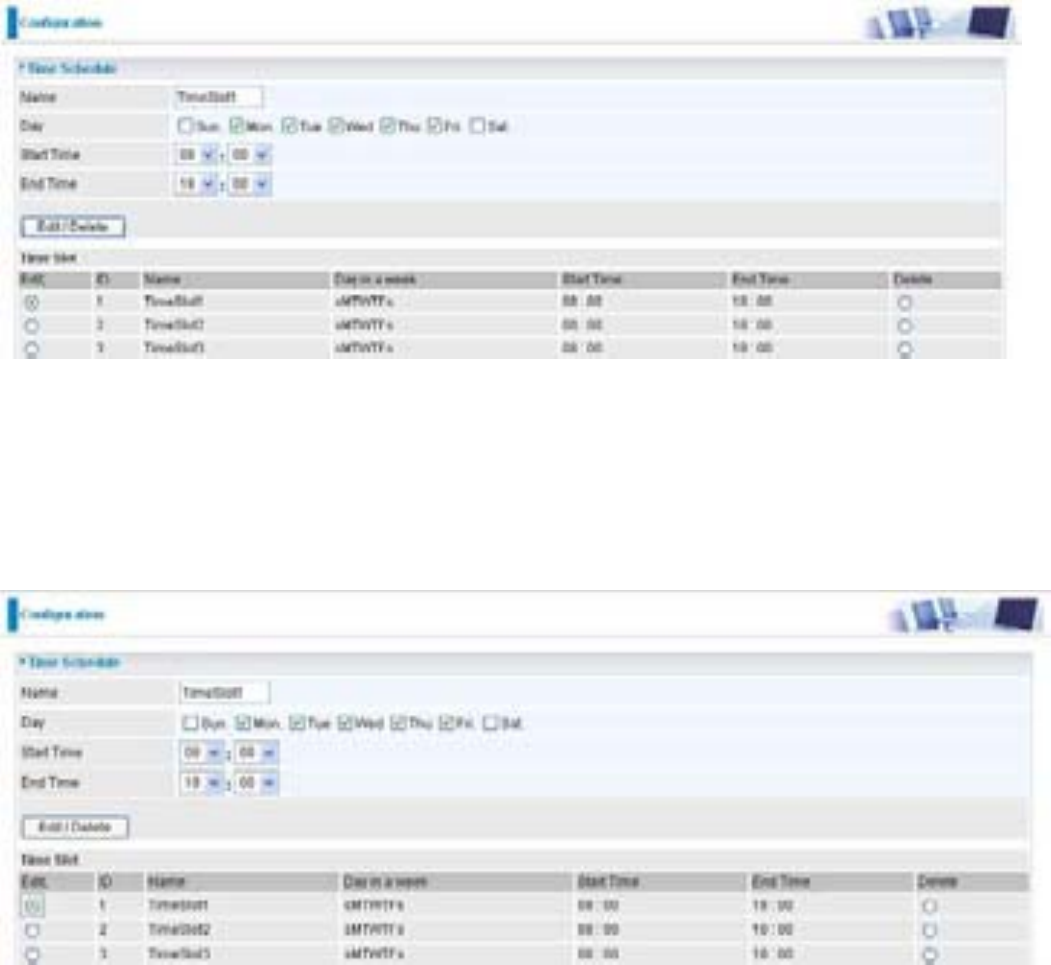
174
Configuration of Time Schedule
Edit a Time Slot
˄ˁʳʳʳChoose any Time Slot (ID 1 to ID 16) to edit, click Edit radio button.
Note: Watch it carefully, the days you have selected will present in capital letter. Lower case
letter shows the day(s) is not selected, and no rule will apply on this day(s).
2. A detailed setting of this Time Slot will be shown.
ID: This is the index of the time slot.
Name: A user-define description to identify this time portfolio.
Day in a week: The default is set from Monday through Friday. You may specify the days for the
schedule to be applied.
Start Time: The default is set at 8:00 AM. You may specify the start time of the schedule.
End Time: The default is set at 18:00 (6:00PM). You may specify the end time of the schedule.
Choose Edit radio button and click Edit/Delete button to apply your changes.
175
Delete a Time Slot
Select the Delete radio button of the selected Time Slot under the Time Slot section, and click the
Edit/Delete button to confirm the deletion of the selected Time profile, i.e. erase the Day and back to
default setting of Start Time / End Time.

176
Advanced
Configuration options within the Advanced section are for users who wish to take advantage of
the more advanced features of the router. Users who do not understand the features should not
attempt to reconfigure their router, unless advised to do so by support staff.
Here are the items within the Advanced section: Static Route, Static ARP, Dynamic DNS,
Device Management, IGMP and VLAN Bridge.
Static Route
Go to Configuration > Advanced > Static Route.
Destination: This is the destination subnet IP address.
Netmask: Subnet mask of the destination IP addresses based on above destination subnet IP.
Gateway: This is the gateway IP address to which packets are to be forwarded.
Interface: Select the interface through which packets are to be forwarded.
Cost: This is the same meaning as Hop. This should usually be left at 1.

177
Static ARP
Go to Configuration > Advanced > Static ARP.
IP Address: Fill in the IP address of the host computer that is sending the data packet.
MAC Address: Fill in the MAC address of the computer that the incoming data packets are to be
forwarded.
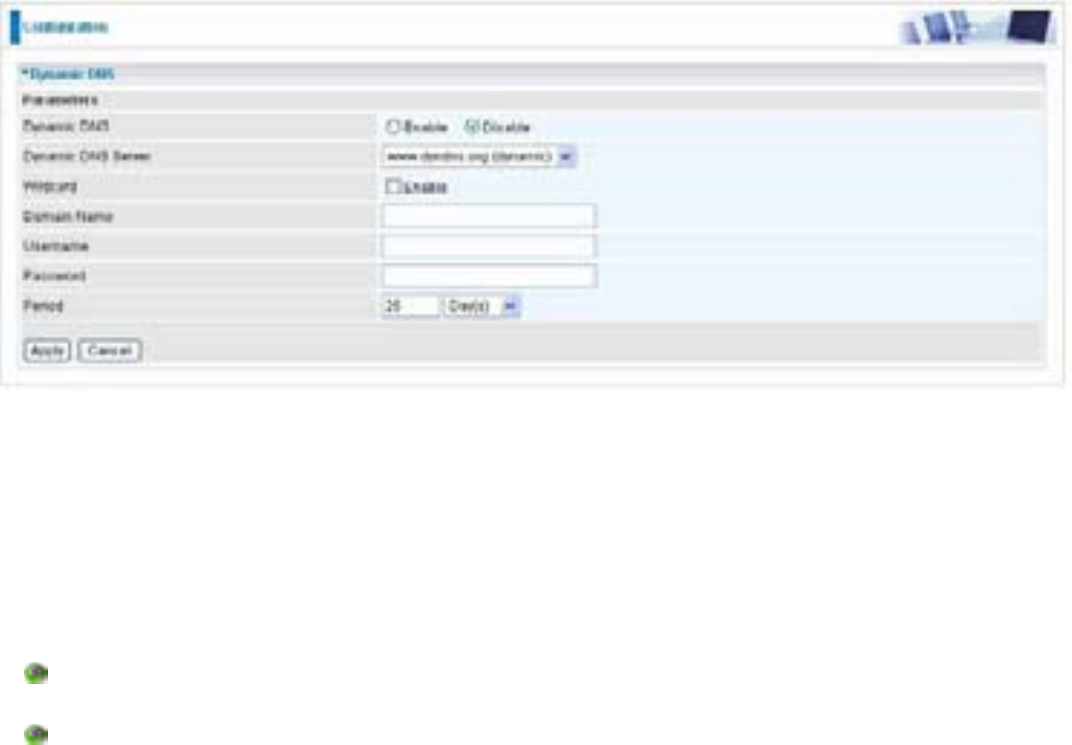
178
Dynamic DNS
The Dynamic DNS function allows you to alias a dynamic IP address to a static hostname,
allowing users whose ISP does not assign them a static IP address to use a domain name. This is
especially useful for hosting servers via your ADSL connection, so that anyone wishing to connect
to you may use your domain name, rather than having to use your dynamic IP address, which
changes from time to time. This dynamic IP address is the WAN IP address of the router, which is
assigned to you by your ISP.
You will first need to register and establish an account with the Dynamic DNS provider using their
website, for example http://www.dyndns.org/
There are more than 5 DDNS services supported.
Dynamic DNS:
Disable: Check to disable the Dynamic DNS function.
Enable: Check to enable the Dynamic DNS function. The following fields will be activated and
required.
Dynamic DNS Server: Select the DDNS service you have established an account with.
Domain Name, Username and Password: Enter your registered domain name and your username
and password for this service.
Period: Set the time period between updates, for the Router to exchange information with the DDNS
server. In addition to updating periodically as per your settings, the router will perform an update
when your dynamic IP address changes.
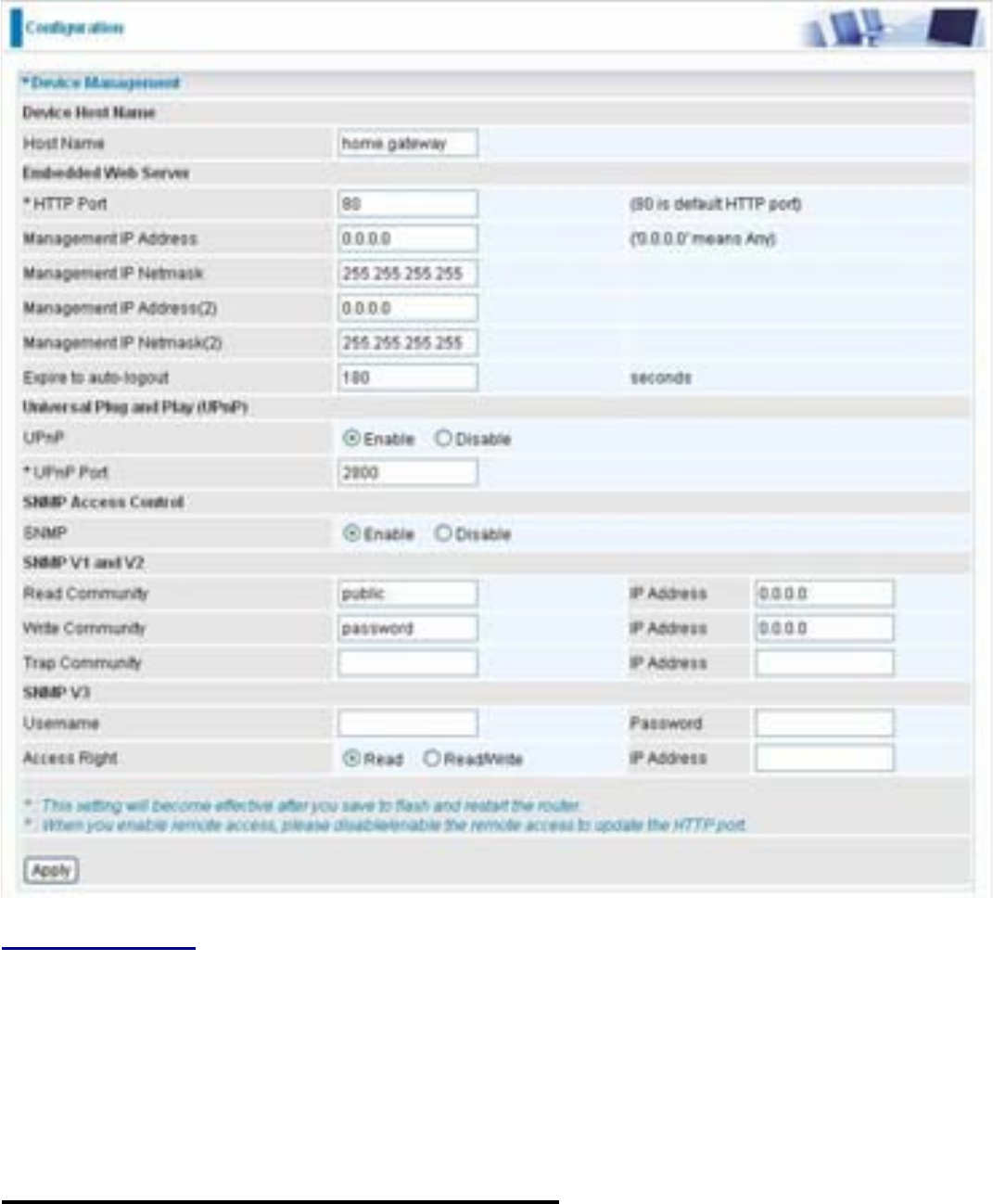
179
Device Management
The Device Management advanced configuration settings allow you to control your router’s
security options and device monitoring features.
Device Host Name
Host Name: Assign it a name.
(The Host Name cannot be used with one word only. There are two words should be
connected with a ‘.’ at least.
Example:
Host Name: homegateway ==> Incorrect
Host Name: home.gateway or my.home.gateway ==> Correct)
Embedded Web Server ( 2 Management IP Accounts)
HTTP Port: This is the port number the router’s embedded web server (for web-based
configuration) will use. The default value is the standard HTTP port, 80. Users may specify an
alternative if, for example, they are running a web server on a PC within their LAN.
180
Management IP Address: You may specify an IP address allowed to logon and access the
router’s web server. Setting the IP address to 0.0.0.0 will disable IP address restrictions, allowing
users to login from any IP address.
Expire to auto-logout: Specify a time frame for the system to auto-logout the user’s configuration
session.

181
For Example: User A changes HTTP port number to 100, specifies their own IP address
of 192.168.1.55, and sets the logout time to be 100 seconds. The router will only allow
User A access from the IP address 192.168.1.55 to logon to the Web GUI by typing:
http://192.168.1.254:100 in their web browser. After 100 seconds, the device will automatically
logout User A.
Universal Plug and Play (UPnP)
UPnP offers peer-to-peer network connectivity for PCs and other network devices, along with
control and data transfer between devices. UPnP offers many advantages for users running
NAT routers through UPnP NAT Traversal, and on supported systems makes tasks such as port
forwarding much easier by letting the application control the required settings, removing the need
for the user to control advanced configuration of their device.
Both the user’s Operating System and the relevant application must support UPnP in addition to
the router. Windows XP and Windows Me natively support UPnP (when the component is
installed), and Windows 98 users may install the Internet Connection Sharing client from Windows
XP in order to support UPnP. Windows 2000 does not support UPnP.
Disable: Check to disable the router’s UPnP functionality.
Enable: Check to enable the router’s UPnP functionality.
UPnP Port: Its default setting is 2800. It is highly recommended for users to use this port value. If
this value conflicts with other ports already being used you may wish to change the port.
SNMP Access Control (Software on a PC within the LAN is required in order to utilize this
function) – Simple Network Management Protocol.
SNMP V1 and V2:
Read Community: Specify a name to be identified as the Read Community, and an IP address.
This community string will be checked against the string entered in the configuration file. Once the
string name is matched, user obtains this IP address will be able to view the data.
Write Community: Specify a name to be identified as the Write Community, and an IP address.
This community string will be checked against the string entered in the configuration file. Once the
string name is matched, users from this IP address will be able to view and modify the data.
Trap Community: Specify a name to be identified as the Trap Community, and an IP address.
This community string will be checked against the string entered in the configuration file. Once the
string name is matched, users from this IP address will be sent SNMP Traps.
SNMP V3:
Specify a name and password for authentication. And define the access right from identified IP
address. Once the authentication has succeeded, users from this IP address will be able to view
and modify the data.
SNMP Version: SNMPv2c and SNMPv3
SNMPv2c is the combination of the enhanced protocol features of SNMPv2 without the SNMPv2
security. The “c” comes from the fact that SNMPv2c uses the SNMPv1 community string paradigm

182
for “security”, but is widely accepted as the SNMPv2 standard.
SNMPv3 is a strong authentication mechanism, authorization with fine granularity for remote
monitoring.
Traps supported: Cold Start, Authentication Failure.
The following MIBs are supported:
From RFC 1213 (MIB-II)System group
System group
Interface group
Address Translation group
IP group
ICMP Group
TCP group
UDP group
EGP (not applicable)
Transmission
SNMP group
From RFC 1650 (EtherLike-MIB)
dot3stats
From RFC 1493 (Bridge MIB)
dot1 dBase group
dot1 dTp group
dot1 dStp group (if configured as span-
ning tree)
From RFC 1471 (PPP/LCP MIB)
pppLink group
pppLgr group (not applicable)
From RFC 1472 (PPP/Security MIB)
PPP security group
From RFC 1473 (PPP/IP MIB)
PPP IP group
From RFC 1474 (PPP/Bridge MIB)
PPP Bridge group
From RFC 1573 (IfMIB)
ifMIBObjects group
From RFC 1695 (atmMIB)
atmMIBObjects
From RFC 1907 (SNMPv2)
only snmpSetSerialNo OID
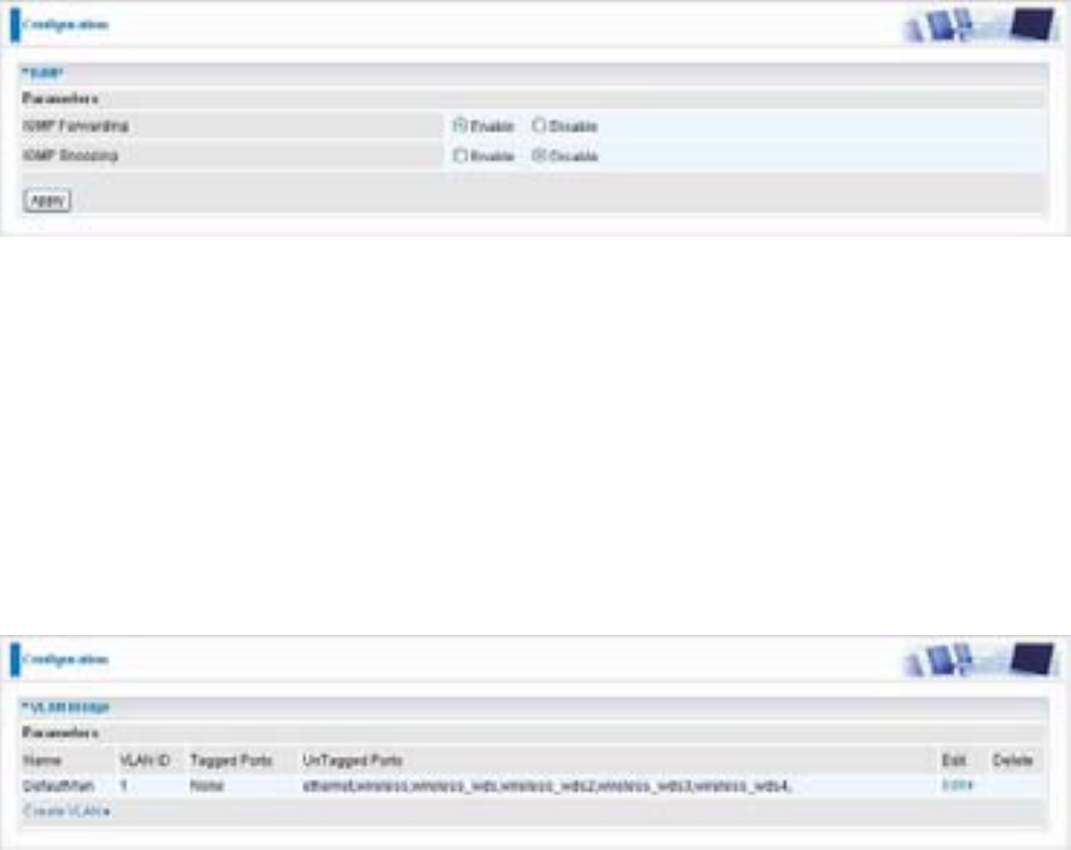
183
IGMP
IGMP, known as Internet Group Management Protocol, is used to management hosts from
multicast group.
IGMP Forwarding: Accepting multicast packet. Default is set to Enable.
IGMP Snooping: Allowing switched Ethernet to check and make correct forwarding decisions.
Default is set to Disable.
VLAN Bridge
This section allows you to create VLAN group and specify the member.
Edit: Edit your member ports in selected VLAN group.
Create VLAN: To create another VLAN group.
184
Logout
To exit the router web interface, choose Logout. Please save your configuration setting before
logging out of the system.
Be aware that the router configuration interface can only be accessed by one PC at a time.
Therefore when a PC has logged into the system interface, the other users cannot access the
system interface until the current user has logged out of the system. If the previous user forgets to
logout, the second PC can only access the router web interface after a user-defined auto logout
period which is by default 3 minutes. You can however modify the value of the auto logout period
using the Advanced > Device Management section of the router web interface. Please see the
Advanced section of this manual for more information.

185
Chapter 5: Troubleshooting
If your router is not functioning properly, please refer to the suggested solutions provided in this
chapter. If your problems persist or the suggested solutions do not meet your needs, please kindly
contact your service provider or Billion for support.
Problems with the router
Problem Suggested Action
None of the LEDs lit when the router is
turned on.
Check the connection between the router and the
adapter. If the problem persists, most likely it is due
to the malfunction of your hardware. Please contact
your service provider or Billion for technical support.
You have forgotten your login username
or password
Try the default username "admin" and password
"admin". If this fails, you can restore your router to its
factory settings by holding the Reset button on the
back of your router more than 6 seconds
Problems with WAN interface
Problem Suggested Action
Initialization of PVC connection (line-
sync)fail
Make sure that the telephone cable is properly con-
nected between the ADSL port and the wall jack. The
ADSL LED on the front panel should lit. Check that
your VPI, VCI, encapsulation type and type of multi-
plexing settings are the same as those provided by
your ISP. Reboot the router GE. If you still have prob-
lem, you may need to verify these settings with your
ISP.
Frequent loss of ADSL linesync
(disconnection)
Make sure that all devices (e.g telephone, fax ma-
chine, analogue modems) that are connected to the
telephone line as your router have a line filter con-
nected between them and the wall outlet (unless your
are using a Central Splitter or Central Filter installed by
a qualified and licensed electrician). Make sure that alll
line filters are correctly installed as missing line filters
or incorrect installation of line filters can cause ADSL
connection problem, including frequent disconnec-
tions.

186
Problem with LAN interface
Problem Suggested Action
Cannot PING any PC on LAN Check the Ethernet LEDs on the front panel. The LED
should be on for the port that has a PC connected. If it does
not lit, check to see if the cable between your router and the
PC is properly connected. Make sure you have first unin-
stalled your firewall program before troubleshooting.
Verify that the IP address and the subnet mask are consis-
tent for both the router and the workstations.

187
Appendix: Product Support & Contact
Following the suggestions listed in the Troubleshooting section of the user manual can help you
solve most of your problems. However if your problems persist or you come across other technical
issues that are not listed in the Troubleshooting section, please contact the dealer from where you
purchased your product.
Contact Billion
Worldwide:
http://www.billion.com
MAC OS is a registered Trademark of Apple Computer, Inc.
Windows 7/ 98, Windows NT, Windows 2000, Windows Me, Windows XP and Windows Vista are registered
Trademarks of Microsoft Corporation.

FCC Caution:
1. This device complies with Part 15 of the FCC rules. Operation is subject to
the following two conditions:
(1) This device may not cause harmful interference, and
(2) This device must accept any interference received, including interference
that may cause undesired operation.
2. This device and its antenna(s) must not be co-located or operating in
conjunction with any other antenna or transmitter.
3. Changes or modifications to this unit not expressly approved by the party
responsible for compliance could void the user authority to operate the
equipment.
IMPORTANT NOTE :
FCC Radiation Exposure Statement:
This equipment complies with FCC radiation exposure limits set forth for an
uncontrolled environment. This equipment should be installed and operated
with minimum distance 20cm between the radiator & your body.
IC Radiation Exposure Statement:
This device complies with the exemption from the routine evaluation limits in
Section 2.5 of RSS 102.
For product available in the USA/Canada market, only channel 1~11 can be
operated. Selection of other channels is not possible.